
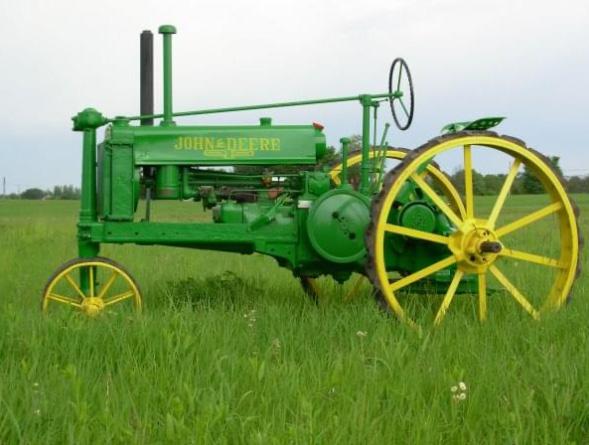
The 840 Fixing Grabbing Clutches Rebuilding Zenith Carburetors May 2024 GREEN Magazine® In this issue...
The Handbook of the John Deere Model A 1934-1938
Fourth Edition
• By Wes Malcolm
Now in its fourth printing with 15 more pages, this is the handbook of the John Deere model “A,” 1934-1938. A book that should be on the “must read” list of any unstyled “A” owner. There is probably no other book on the market that goes into so much detail on a single model of tractor. Shows illustrations of nearly every change made in the parts that make up the unstyled “A.” 95 pages, 11x8-1/2 inches, soft cover.
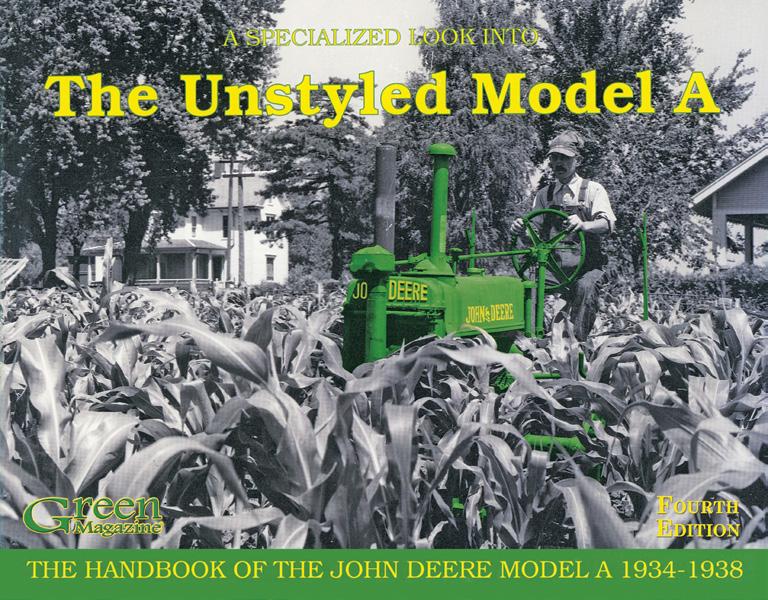
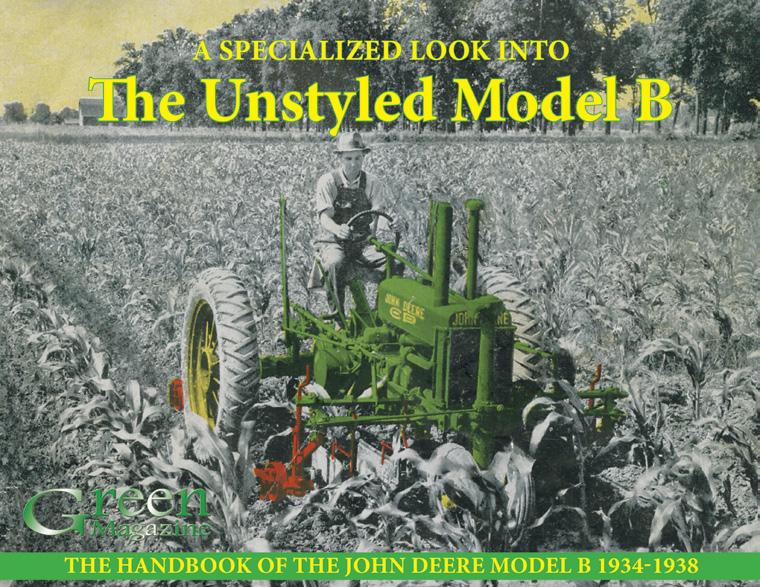
Both books include history, specifications, serial numbers, original prices and much more A Specialized Look Into
The Handbook of the John Deere Model B 1934-1938
The same types of information as available in the book above, except now about the model “B,” written and compiled by a panel of experts who have spent decades collecting and restoring the unstyled version of Deere’s most popular tractor. This book shows nearly every change made in the parts that make up the unstyled “B.” 84 pages, 11”x8 ½”, soft cover, over 200 photos - most in color.






WHAT A DEAL! SPECIAL BUNDLE PRICE on these TWO books published by Green Magazine A
The
A
Specialized Look Into
Unstyled Model
The Unstyled Model B
Order GMAB: $63.95 U.S. (Nebraska residents add 5.5% state tax) $76.95 Canada (US funds) • $89.95 Foreign (US funds) The prices shown here are for BOTH books shown above - the first time for this BUNDLE DEAL. •• Prices in this BUNDLE DEAL are up to 20% OFF the regular price •• Visa, Mastercard, Discover, American Express accepted • Nebraska residents add 5.5% sales tax • Price includes S/H Call 402-643-6269 • Email info@greenmagazine.com Online www.GreenMagazine.com Mail Green Magazine® • PO Box 95, Bee, NE 68314-0095
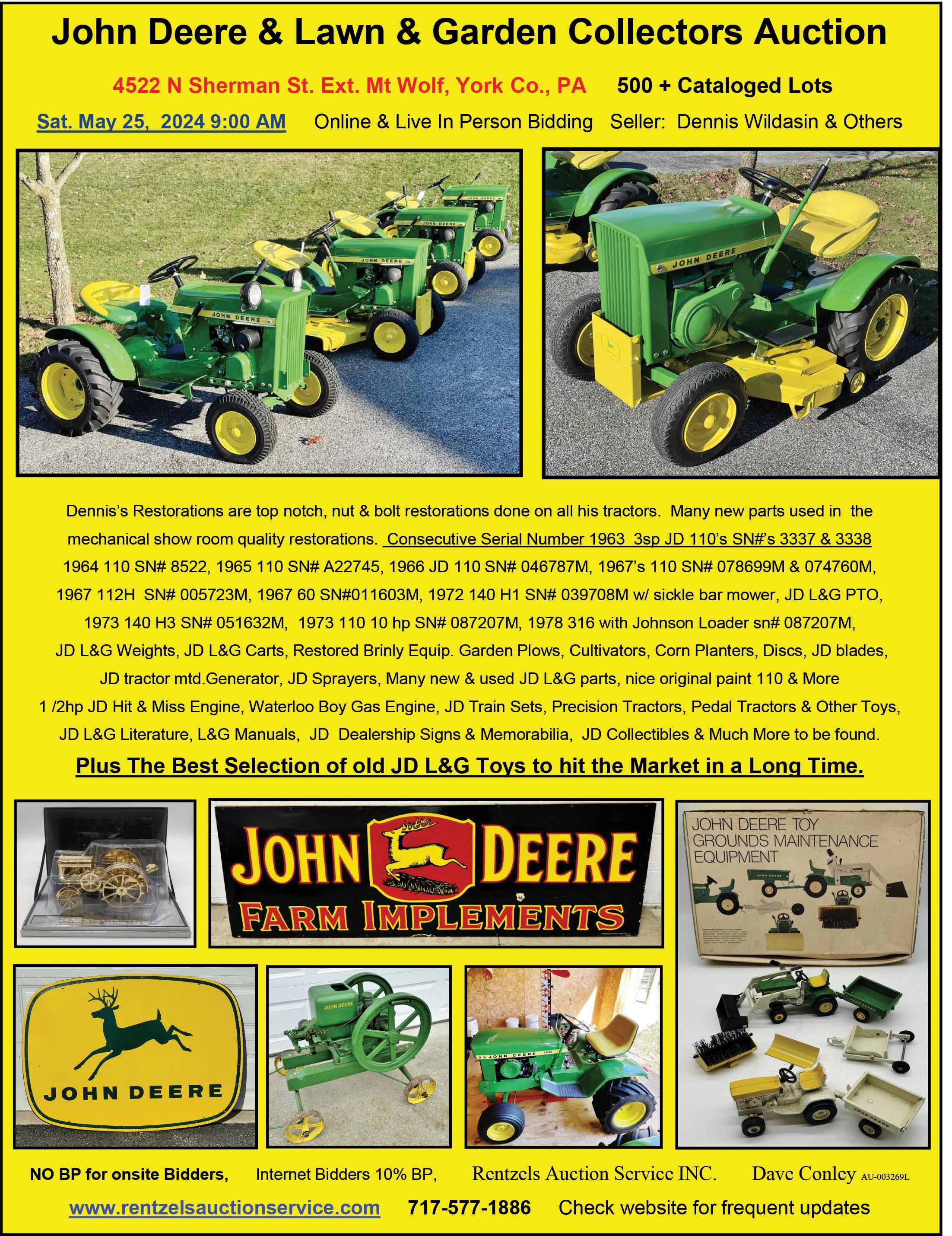

The monthly publication for John Deere enthusiasts
Managing
Layout/Design
Historic Farm Days celebrates model “D” Cindy Ladage
John Deere model 840 Benjamin Hain
The story of a “GP” standard Eric Sherman
The Young Timer The Alaska connection Tyler Buchheit




How our hobby started A new catalog and a new show Richard Hain
Tip of the month Jumpy clutches on two cylinders Dan Brotzman
“GREEN MAGAZINE®” (ISSN 0883-5462) is published monthly and released 12 times a year on or about the first of each month for $39.95 per year (Canada: $59.95 per year; Foreign: $69.95 per year) by Hain Publishing, Inc., 2652 Davey Road, Bee, NE 68314-9132. Periodicals postage paid at Bee, NE and additional mailing offices.
POSTMASTER: Send address changes to “GREEN MAGAZINE®, PO Box 95, NE 68314-0095.”
GREEN MAGAZINE® reserves all rights regarding reprints of this publication. Our phone number is (402) 643-6269.
Copyright © 2024 Hain Publishing, Inc. All rights reserved.
10
18
32
May 2024 • Volume 40 Number 5
5
6 Deere
14
24
30
Each March issue of Green Magazine includes an index of major articles from past issues. The March 2024 issue features the newest index. 38 Deere & There 40 What’s new—and old? JD Lawn and Leisure line, Part 1 Greg Stephen 44 Do you have one? 46 The tractor doctor Headaches
1 Ron O’Neill 49 Scale
70 diesel standard Bill Proft 52 Auction highlight Unique 420s Eric W. Mickelson 54 Aussie Ken Sea container arrives in Australia Ken Nicklas 57 Saw it online Box versus button Adam Smith and Benjamin Hain 69 Advertiser index 72 Mr. Thinker ON THE COVER: John Craig of Mentone, Indiana owns this late style 840. Editor Richard Hain
Departments
Richard’s Column
John
and carbs, Part
models
Editor Carol
Hain
Debbie
Green Magazine® PO Box 95 Bee, NE
8:30 AM to 4 PM M-TH Closed Fridays through Labor Day Phone: 402-643-6269 email: info@greenmagazine.com web: www.greenmagazine.com
out
sample articles, catalog, ads and other features! NOTE: VISITS TO OUR OFFICE
APPOINTMENT ONLY!
Rates:
$39.95
year - 12 issues Nebraska residents, add 5.5% sales tax ($42.15) Canada: $59.95
1 year - 12 issues Foreign:
1 year - 12 issues
accepted Page 4 May 2024 • Green Magazine
Behne
68314-0095 Hours:
Check
the
BY
Please call prior to visiting so we can be here to talk with you. At that time we can also give you our location. Thank you!
U.S.:
/ 1
/
$69.95 /
First Class/Airmail delivery available: See page 5 Visa/Mastercard/Discover/AmExpress

As of this writing, I am still working on prepping my “A” for painting, though I am gaining on it. As is likely not a surprise to any of you, the worst part is trying to clean the fossilized dirt and grease from beneath the transmission and rear axle housings. One day, while lying on my back trying to remove some of this gunk, I began dreaming about how much easier it would be if one could flip the tractor over, or even point its nose toward the sky. I could probably do the latter with my 158 loader and 4440, but it seems like there would be a real possibility of damage to either of the tractors, the loader or myself. Possible advantages would be that it would make cleaning easier and Carol would be able to retire and live off my life insurance money.
Speaking of restorations, Dan Brotzman—who we read in the March issue is now semi-retired from writing articles—suggested that we rerun some of his older articles. Not a bad idea since some of you weren’t yet born when he began writing for us, so in this issue
on page 30, you will see an article that he wrote back in 2002 on a problem that has bothered many of us—jumpy clutches on two cylinders.
In other “what was gone is back” news, we stopped publishing Little Green, the Tractor Magazine for Kids last fall, but it is back, but no longer being published by us. So keep the hobby going by buying a subscription for your kids, grandkids or any other random kids to get them interested in old tractors and the history of agriculture. You will find an ad for the new Little Green on page 12. So give them a call.
One last thing, since it will be May by the time most of you read this, remember that from now until Labor Day, we will be observing our summer hours. That just means that we are closed on Fridays. The phone rings a little less during the summer and it gives us more freedom to take off and head for tractor shows.
See you next month.
Those who want to call to place orders for magazine subscriptions or renewals, gift items or ads, please note this schedule. Our website, www.greenmagazine.com, is always open for orders and ads. Email info@greenmagazine.com with questions, if needed.
Missing an issue? We mail every issue by the first of the month. Please contact your post office if you suspect a problem with delivery. We will not replace missed issues three or more months past original mail date (four or more months for foreign subscribers) free of charge.
U.S. subscribers: If it is on or after the 20th of the month and you haven’t received your issue, call us for a replacement.
Canadian subscribers: Due to postage costs, we are forced to ask for a $2 postage fee (U.S. funds, please) for re-sending issues that do not arrive by the end of the published month OR we can add an issue onto your subscription for the missed issue.
First Class/Airmail delivery: Call for rates for First Class in the U.S. or Airmail to foreign countries.
Foreign subscribers: We will add an issue onto your subscription OR for a $7 airmail postage fee (U.S. funds), we will resend the missed issue two months after publication date.
Notice: If your address label shows an expiration date of “5/24” above your name, this is your last issue. Renew immediately for continuous service. If your address label reads “6/24,” you have one more issue on your subscription.
Renewal notice: We send postcards to let you know your subscription is about to expire (or has expired). We NEVER call to ask if you would like to renew your subscription. If you
receive such a call, it is most likely from another publication—NOT Green Magazine® for John Deere enthusiasts.
Address Changes: Please send or call with notification of an address change as soon as you know what your new address will be. Periodical mail cannot be forwarded. Green Magazine will not replace issues missed due to late notice of address change. Those missed issues will have to be bought at back issue price. See the back issue listing and prices elsewhere in this issue.
Looking for your photos and stories! Accepted material is subject to such revision as to meet the requirements of this publication. Payment will be made at our current rate within 90 days of publication. Submission of manuscript implies that the material is original and in no way an infringement upon the rights of others. Please send good, clear photographs. If you would like these returned, send us a stamped return envelope to help us get them back to you.
Free Issue Offer: It seems you, our subscribers, are our best form of advertising! More people find out about this publication by “word of mouth” than other forms of advertising. So if you're enjoying Green Magazine®, why not spread the word? Telling others about it can pay benefits. When you tell a friend about Green Magazine® and they subscribe, make sure they tell us who let them know about it. When they do, you will get an issue added to your subscription. These must be new subscribers, not renewals.
Green Magazine announces its spring/summer hours, in effect now through Labor Day : Monday through Thursday 8:30 AM - 4 PM • Friday: CLOSED
Green Magazine® • May 2024 Page 5
Thank you!

At right is a portion of my John Deere collection, from right: 730 standard came from Saskatchewan, Canada. I purchased it at Polk’s Auction in 1992.
The 730 diesel/pony start is a local tractor. It was a basket case I purchased in 1987.
The 730 LP was purchased in Marianna, Arkansas in 2008.
The next—a 730 diesel, electric start—was also a basket case I purchased locally in 2017.
The 730 gas came from Louisiana, Missouri and I then purchased it from “High Dollar” Harold of Greencastle, Indiana in 2003.
Phil Doughty, IN
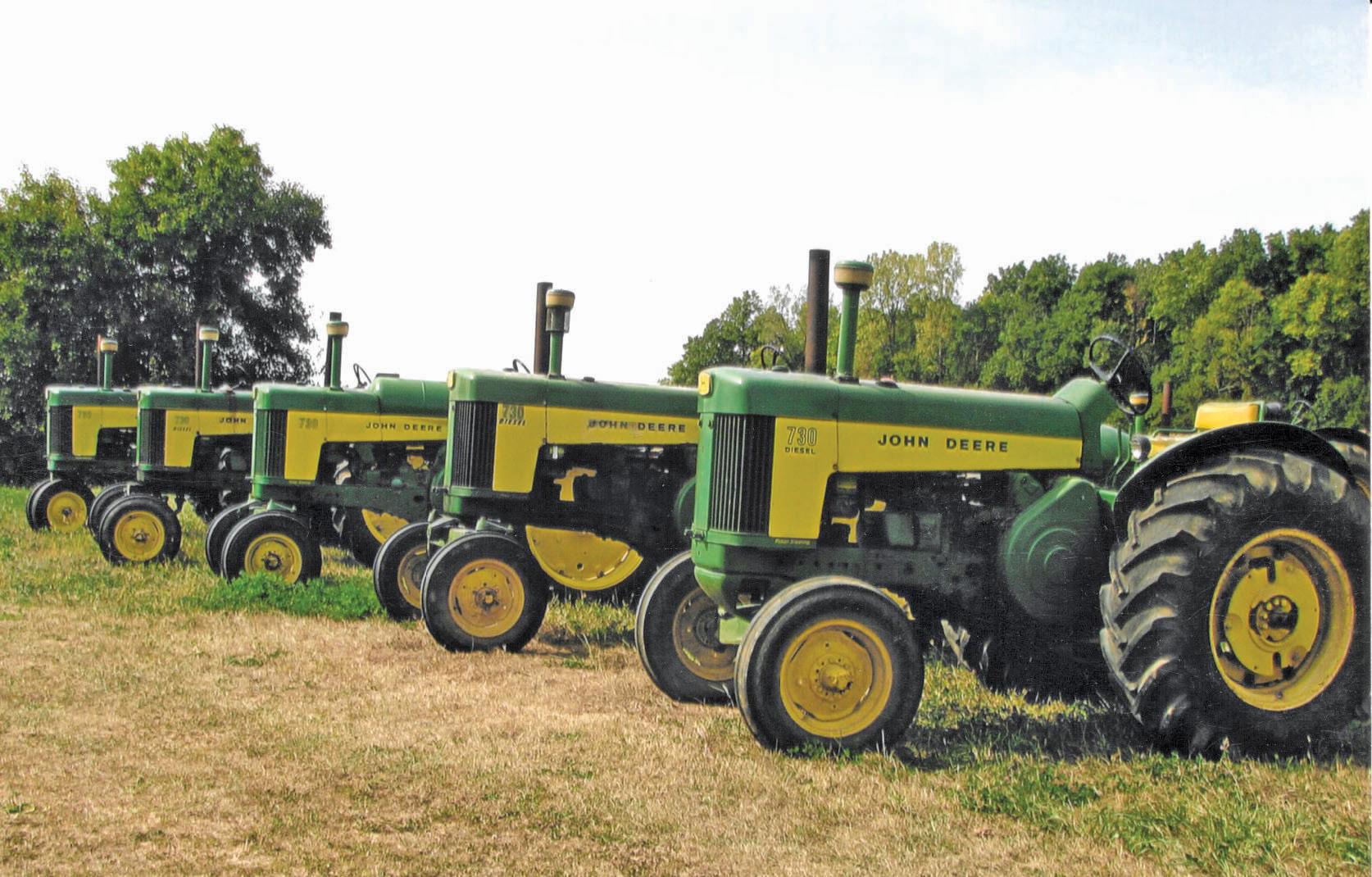
I enjoy Mr. Thinker’s column every month in Green Magazine. In the December 2023 issue, you discussed which baler is better—John Deere or New Holland. You are right saying that the flywheel on a John Deere baler is on the same plane as the crankshaft, but there is still a set of bevel gears in the gear box from the PTO shaft that
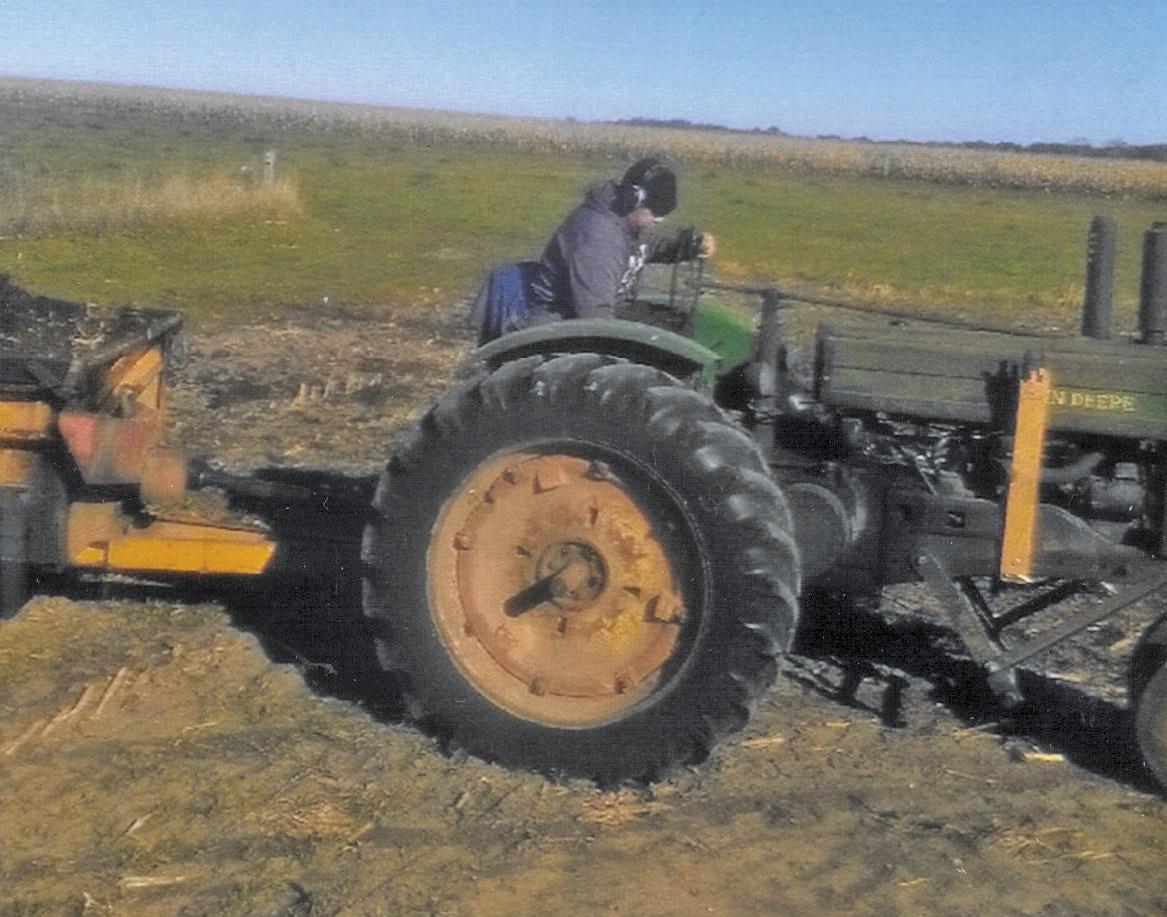
drives the crankshaft. These bevel gears in a John Deere baler have a tendency to fail. Referring to the New Holland baler, the flywheel is driven by a Hypoid gear, not by bevel gears. They are just like a ring gear and pinion shaft in a tractor differential. They are very durable.
Tom Geisler, NE
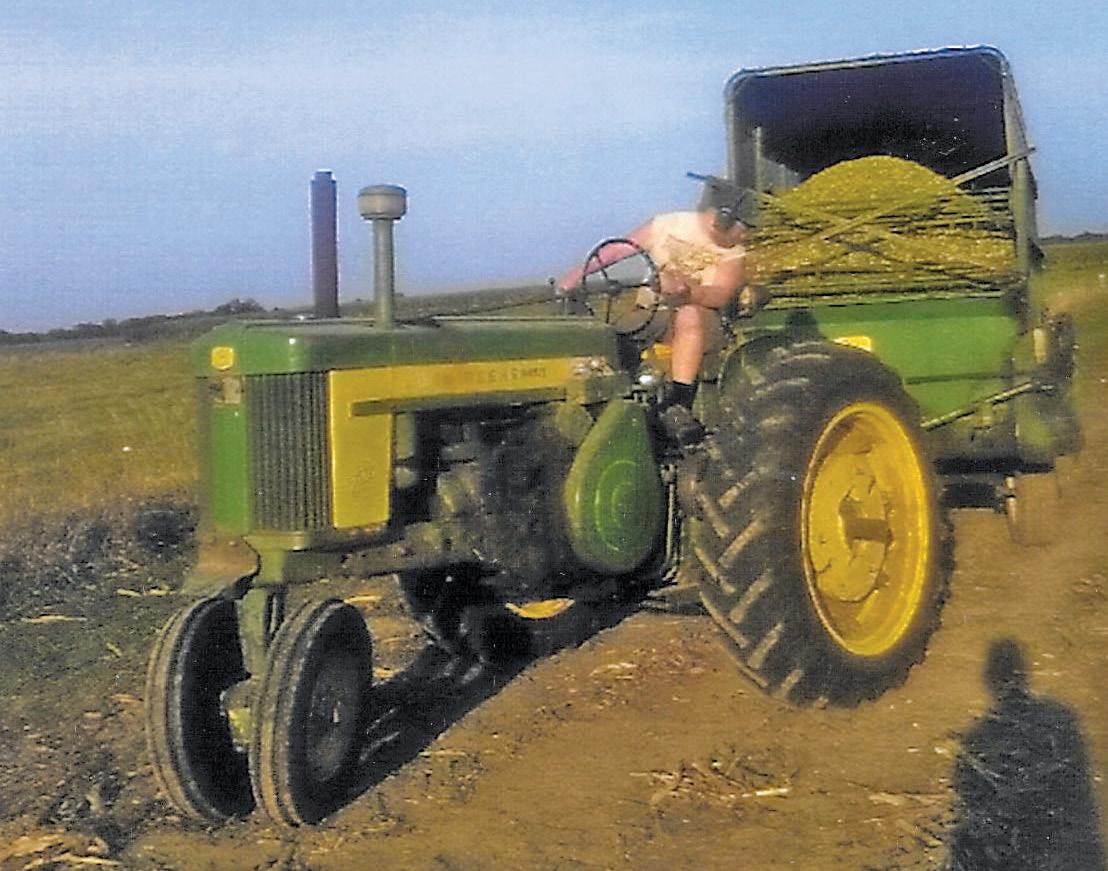
In past issues of Green Magazine, a gentleman wrote a couple of articles about using our old tractors for actual work, which is good for them. My friend, Flash, and I agree and if you have livestock, there are a lot of jobs you can use them for. Here are a couple of pictures of Flash using a couple of his tractors doing what they were built for. Keep up the great work on Green Magazine.
Moose McClure, IL
Page 6 May 2024 • Green Magazine
It is with mixed feelings that we, Travis and Shirley Jorde, write this. We have reached a point in our lives, at 85 years old, that we have decided to pass Jorde’s Decals on to a new owner. We have full confidence that they will continue to provide the same quality product and service that everyone has come to expect.
We would like to thank all of you we have become acquainted with over the past 48-plus years. Your loyalty and encouragement have brought us such joy. Many years of helping with tractors, attending shows, events and sharing information during seminars have brought us limitless new friends and opportunities.
The years have shown us innovative technology, such as cell phones, computers, printers, and shipping options. The growth we have experienced is amazing. We are thankful for all the opportunities that have been made available to us. We have been busy cleaning up our workspace and are finding that some orders have been overlooked, lost, duplicated, or forgotten and we apologize for this. We want you to order again, ask for
what you did not receive and please continue to enjoy your restorations. Please be patient as the transition takes place, procedures are updated, and adjustments are made. Smile and take one day at a time, just like we do. We have great confidence in the new owners, Dan and Jen Peterman, and know they will do an excellent job for all our customers. We have been blessed to spend the better part of a couple of years in discussion with them, and know they are ready to continue this business and help it to grow the way it should. Please continue to show them the support you have bestowed on us for all these years. The business name will not change, only the people who will continue to serve you in the best way possible. We plan to still attend shows and help where needed. We are always ready to sit and visit, share ideas, and make new friends. For the Jordes, it has always been about the people.
Blessings to our friends and family.
Travis and Shirley Jorde

1) Call 402-643-6269 with credit card in hand 2) Go online: www.greenmagazine.com 3) Send a check by mail with the subscriber’s name and address to Green Magazine, PO Box 95, Bee, NE 68314 For more info on subscription rates, see page 4. Questions? Call 402-643-6269 for great customer service! It’s easy! A letter from Travis
Green Magazine® • May 2024 Page 7
and Shirley Jorde

PUBLIC AUCTION
Saturday, May 18 • 10 AM Harrisburg, IL 62946
Location: 25 Veterans Drive at the Wilson Auction Center.
Turn N off Hwy 13 at the NAPA Store onto Veterans Drive and we are on the west side of the street. Signs posted.
• JD 630 gas, SN 6301667, rear hitch
• JD 60 gas, PS, SN 6046336
• JD styled B, SN B284269, new rubber
• JD 50, Roll-O-Matic, SN 500500
• JD model 60, SN 6020160
• JD styled A, SN 577770
• JD MT, SN MT12267, nice
• JD model H, w/Bramlet dealer sticker, SN 59350
• JD model B, SN B14518, w/broke steering unit
• JD model A, SN 451312, round rear spokes
• JD model 1010 w/3-pt. hitch, SN
Auctioneers Note: These are all in running and good condition, and some with new tires and new paint. They are from one person’s collection south of Eddyville, IL. We will move them to our location because the lack of parking on the farm. Terms: Cash, check or credit/debit cards accepted with proper ID; for out of area checks, should bring bank letter of credit. Absentee bids are always accepted.
Photos are on our website at www.wilsonauction.com
8th Annual Antique Tractor and Equipment Show
Show: 8th Annual Antique Tractor and Equipment Show
Reunion of front wheel assist and four wheel drive All makes and models welcome in any condition July 12, 13, 14, 2024 • Cornwell’s Turkeyville USA 18935 15-1/2 Mile Rd., Marshall, MI 49068
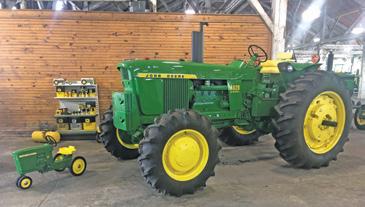

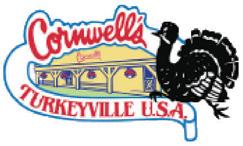
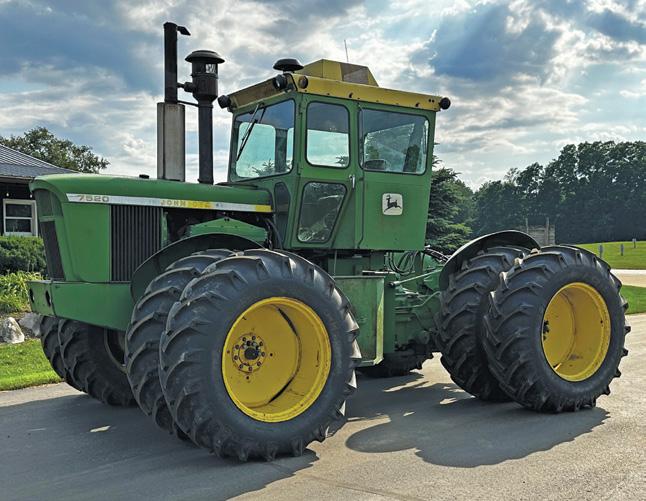
300+ tractors and engines on the grounds, tractor pulls, working exhibits, daily parades, plowing demos, children activities, pedal pulls, miniature train rides, onsite restaurant, dinner theater, ice cream parlor, state of the art campground and much more! Presented by the Calhoun County Yesteryear Association www.CalhounCountyYesteryearAssociation.com Email ccyatractors@gmail.com


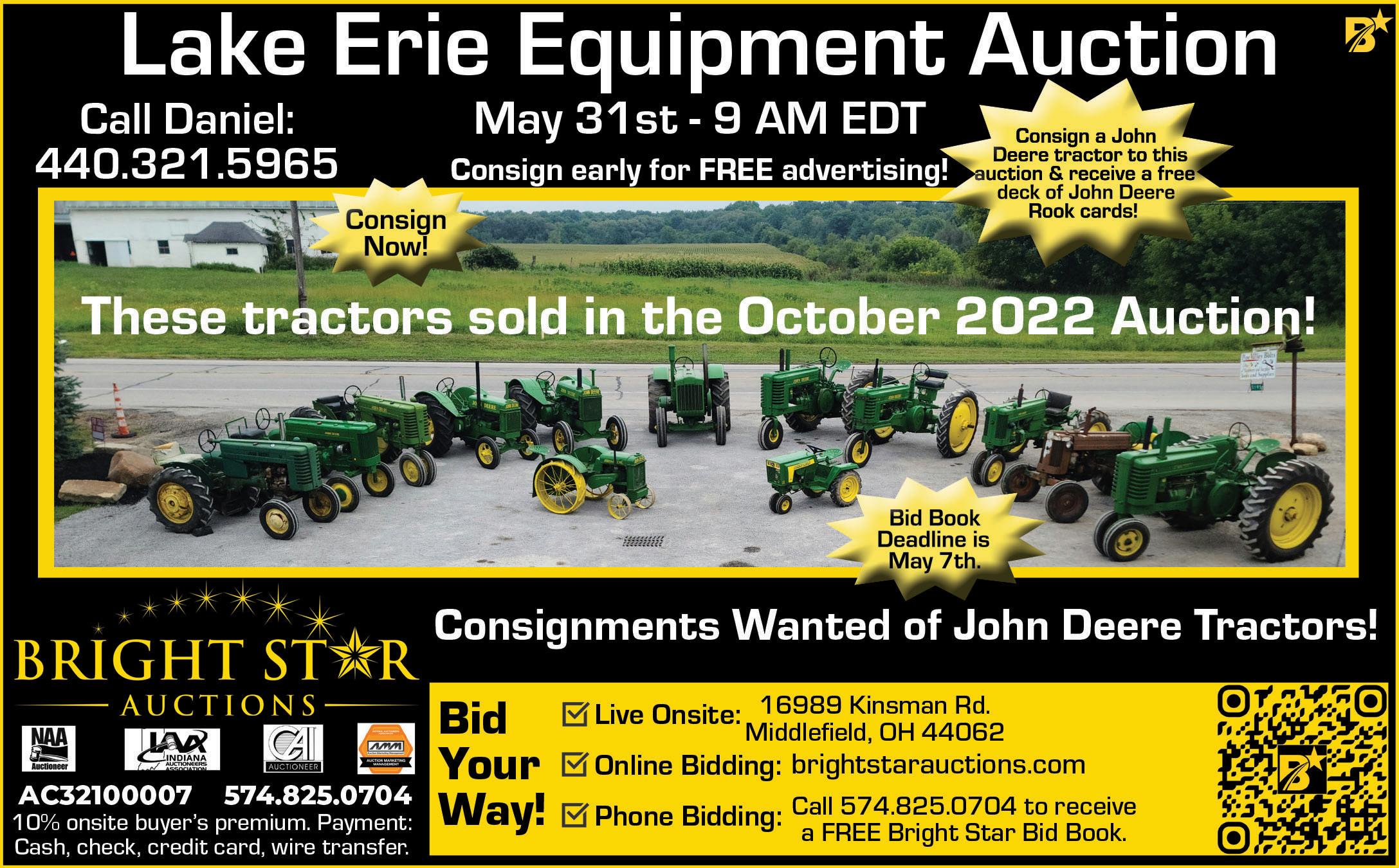
Wilson
Auction Co. • Dennis Wilson, Auctioneer Harrisburg IL 62946 • IL. Lic. #44000030 Phone 618-252-1185
Page 8 May 2024 • Green Magazine
Call/text 517-795-7824

Green Magazine® • May 2024 Page 9


The 2023 Historic Farm Days was held in Penfield, Illinois on July 13-16, 2023. At this show, hosted by the I&I Antique Tractor & Gas Engine Club, John Deere was featured, along with the 100th anniversary celebration of the introduction of the John Deere “D” tractor and “E” engine. With more than 50 “Ds” at the show and an array of activities to profile the celebration, it was what I would call “D Days in Penfield”!
Ed Winkleman, president of the Friends of Green, a branch of the I&I club, along with other members, had been promoting the show all year long. He said that prior to the show, he received calls from collectors in an array of states about the event.
Among featured events at the show were workshops put on by plow book author, David Wolfe. Growing up on a Wisconsin dairy farm and using two -cylinder tractors stuck with David, who is now a collector and restores his own tractors. A family man with 15 grandchildren, David said most everyone in the family has an interest in tractors.
A frequent presenter at Gathering of the Green and Classic Green Reunion, his first workshop at Penfield on Friday was on John Deere model “D” tractors. “Our hobby is a family-oriented hobby that you can enjoy for a lifetime,” he said, opening the workshop.
John Deere “Ds” were manufactured from 1923 to 1953, but they come in a wide variety of styles developed over the years. The “D” was built to replace Waterloo Boy “N.” David Wolfe pointed out the differences through the production timeline. At first, he said, “The John Deere ‘D’ was used a lot on the threshing machine.”
The “D” was longest produced tractor in Deere’s line and David said what made it revolutionary was the oil bath design that kept parts oiled. While sharing workshops and information is great, David said his favorite thing is plowing with this remarkable tractor, “I love to plow with the John Deere ‘D”—there is just nothing like it.”
On Saturday, David took a group of collectors on a walk-through, pointing out the differences in different John Deere tractors. He said that all tractor collectors should be praised for bringing their tractor to an event and that ways that a tractor has been “farmerized” just makes it more special to the owner.
Each day of the show, at noon, there was a John Deere “D” drive held on the grounds. It was fun to see “Ds” of
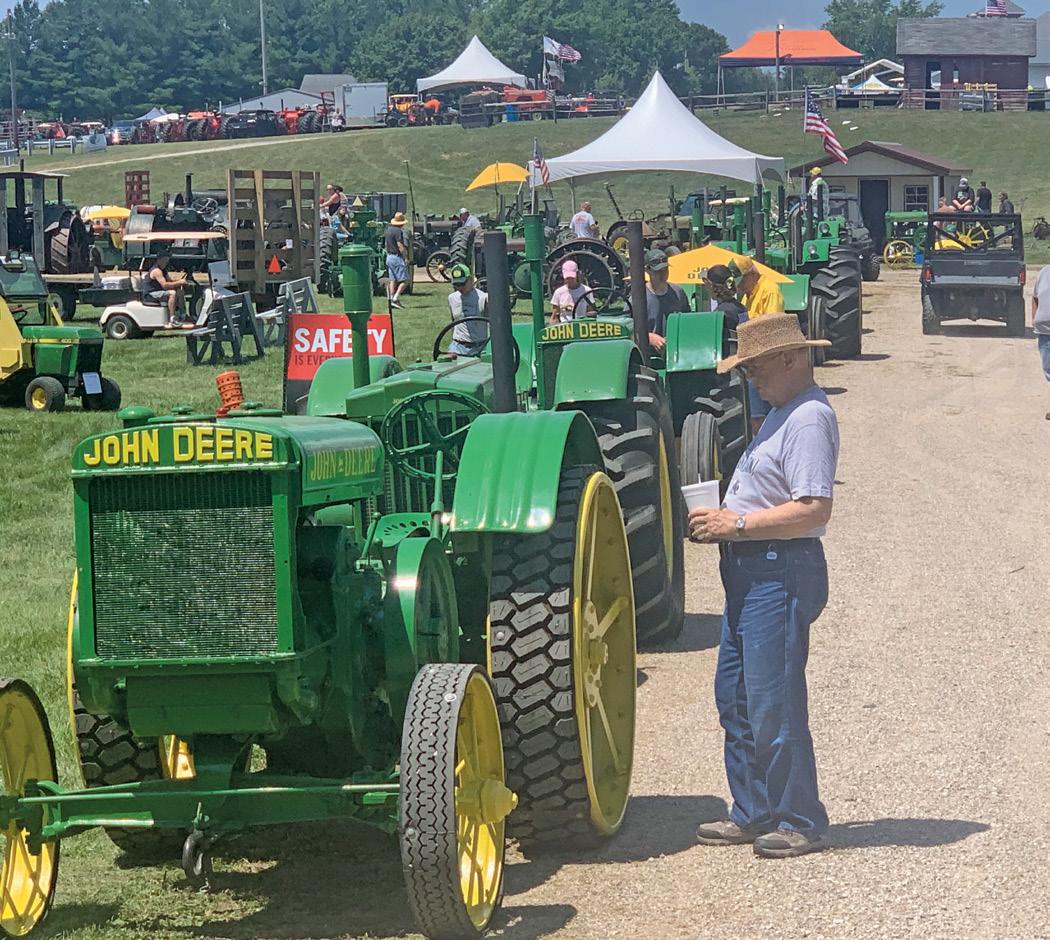
all ages parading by.
In the featured building on the Historic Day grounds, several beautiful John Deere pieces were on display, including Mark and Dana Haven’s 1953 Streeter “D.” The tractor is serial number 191655. The Havens are from Rolla, Missouri and Mark said he looked for years and years for the rare Streeter “D” and finally found this one in Knoxville, Tennessee. “This is one of the last 92 ‘Ds’ made and it is the 15th from the end of production. Deere made the ‘Ds’ until March of 1953, then the dealers kept asking for more since they were popular for rice production. Deere came up with enough parts for 92 more. They set up an assembly line in the street,” Mark said about this unusual production method. “Of the 92 made, 32 stayed in the U.S. and the other 60 were exported. The majority, I think, went to South Africa.”
This Streeter “D” was originally shipped from the New Orleans branch in Louisiana to Jonesboro, Arkansas on March 12, 1954. The tractor was sold new at Melton Brothers John Deere to the Johnson family. Then the tractor was sold in the early 2000s and finally ended up with Willis Freeman of Clinton, Tennessee before being sold to the Havens.
Although duals were put on new by the dealer, Mark
Page 10 May 2024 • Green Magazine
The daily tractor drive.


said they had to fabricate new ones since they were in bad shape. They only had to paint the rear wheels, and they credit Dave Nelson of Agri-Crafts with the effort. Besides Mark’s Streeter “D,” he said they have eight to 10 more tractors at home. “We’ll have the 4030 gas narrow front at the Half Century of Progress in the John Deere tent at Rantoul,” he added.
Another very special tractor in the featured tent was Kenny Read’s 1928 Spoker “D,” serial number 30404. “This could be the oldest John Deere ‘D’ tractor,” Kenny said. “The tractor was built June 3, 1923 and was fourth in the production line. There were 50 of these built, and 17, I believe, that still exist.”
“The tractor was shipped new to Minot, North Dakota, and spent its life there. He shared a few things that make this tractor unique. “The first 50 model ‘D’ tractors have skinny ‘John Deere’ letters on the radiator top, a ‘fabricated’ front axle, four holes in the steering wheel ‘spokes’ and a ‘ladder’ radiator (having four holes cast in the radiator sides).
A gentleman known as “Rumley Bill” owned the tractor along with four or five others and collected, you guessed it, Rumleys. “He sold these at Aumann Auctions along
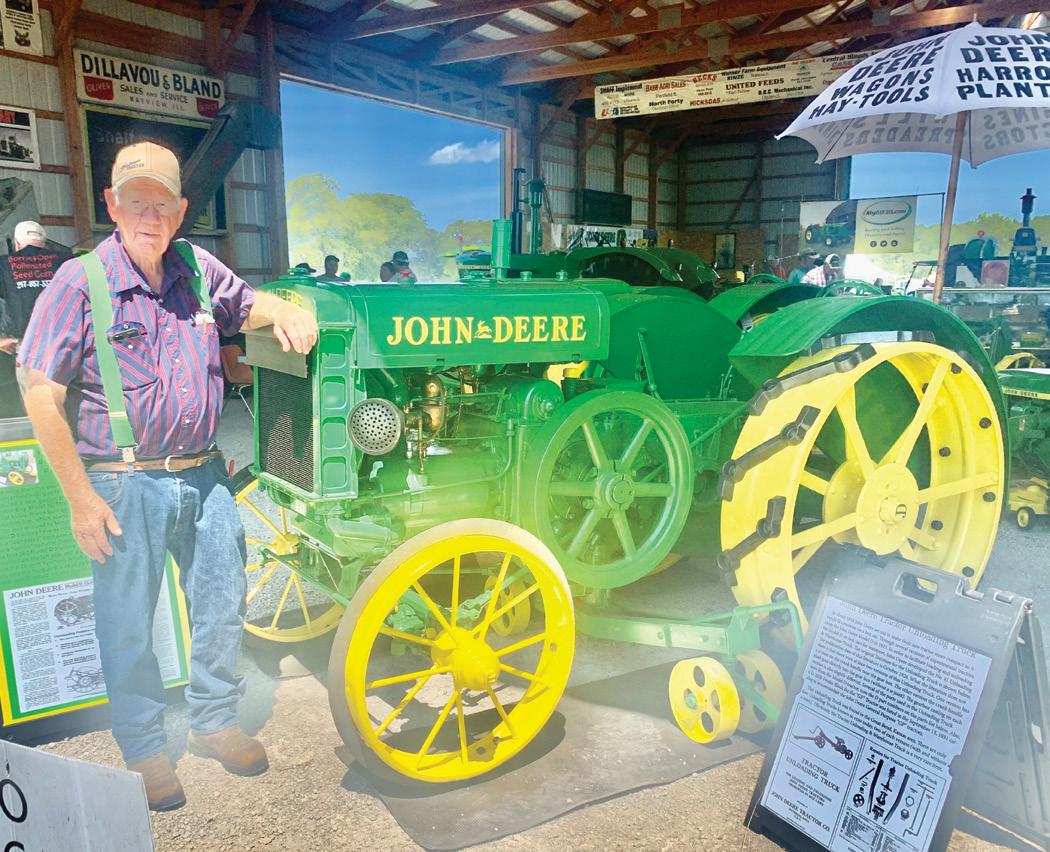
with a ‘GP’ crawler, and this tractor came from that sale; it was bought by Ted Spoelstra, and I bought it from him.”
Since he bought it six or seven years ago, he also added a gear reduction that he found in California.
During the show, they brought out a birthday cake to celebrate Kenny’s 100-year-old tractor. Kenny did the honor of blowing out the candles, and collectors stopped by and enjoyed the celebration!
One other collector who had a rare 1930 John Deere “D” in the feature tent was Kevin McMath, who hails from Clinton, Illinois. “I bought it from Mecum Auctions. It came from California—that is about all I know about it,” Kevin said.
Attached to his 1930 “D” was a cool John Deere subsoiler with an unusual mole that he said would dig a trench. Kevin had four “Ds” at the show. “I didn’t want to be the one with the least number of ‘Ds’,” he joked.
Besides the 1930 “D,” he also had two 1936 “Ds,” one with a No. 15 JD subsoiler attached. “The reason I started with these is Dad had a “D” in the early ’70s. We had it running, but I learned it would be cheaper to buy new than try to fix it.”
The last of his four “Ds” was a 1937 “D” in its clothes that Kevin said, “I play with. I forgot to bring a plow, but my buddy said there’s a plow for sale…”
He will have to explain that to his wife, Barbara. Kevin had also brought an “E” engine for the anniversary celebration as well.
Historic Days was a great show with a “D” celebration for the history books!
Kevin McMath with his JD “D.”
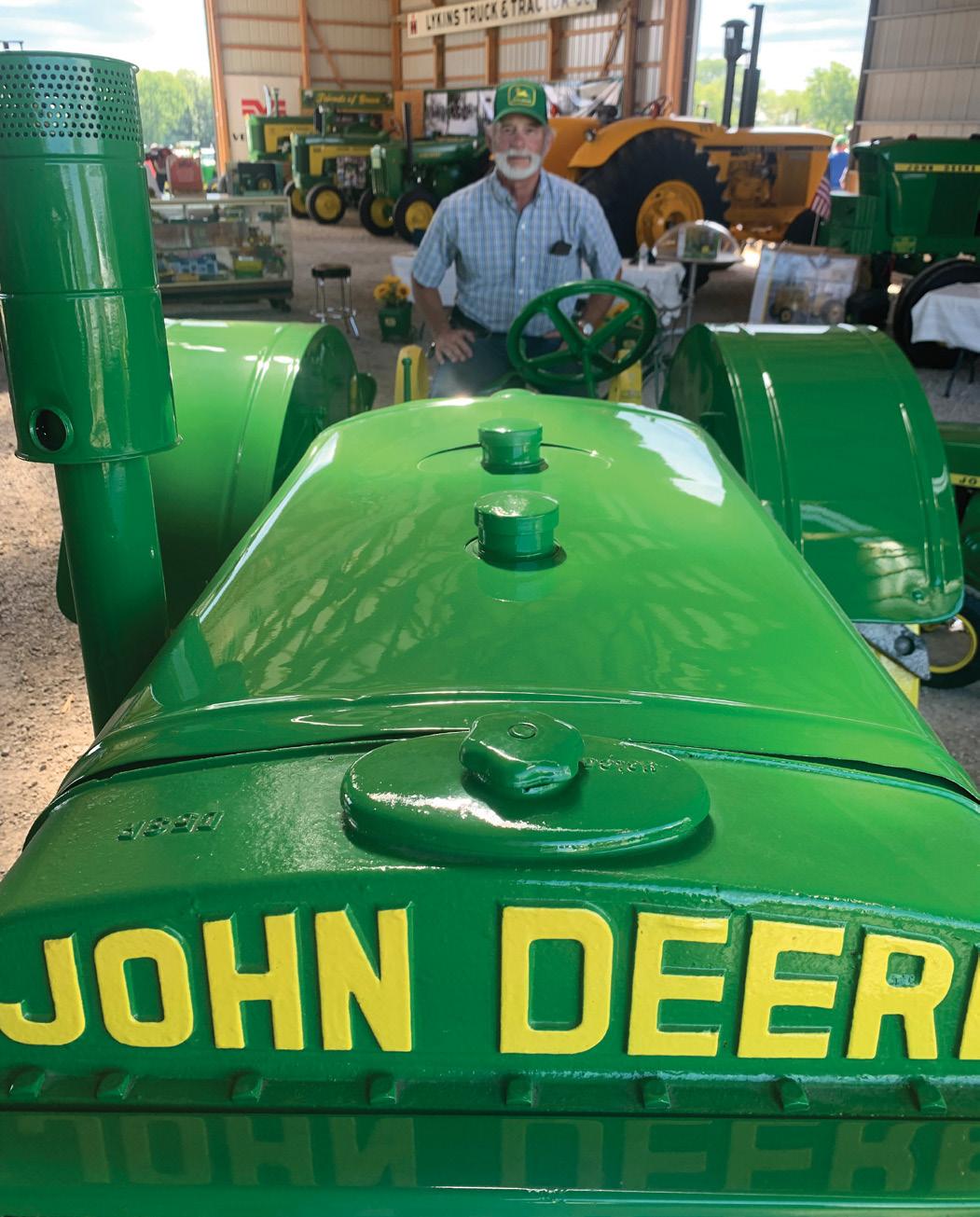 Kenny Read with his 100 year old tractor.
Kenny Read with his 100 year old tractor.
Green Magazine® • May 2024 Page 11
The Havens with their “Streeter D.”
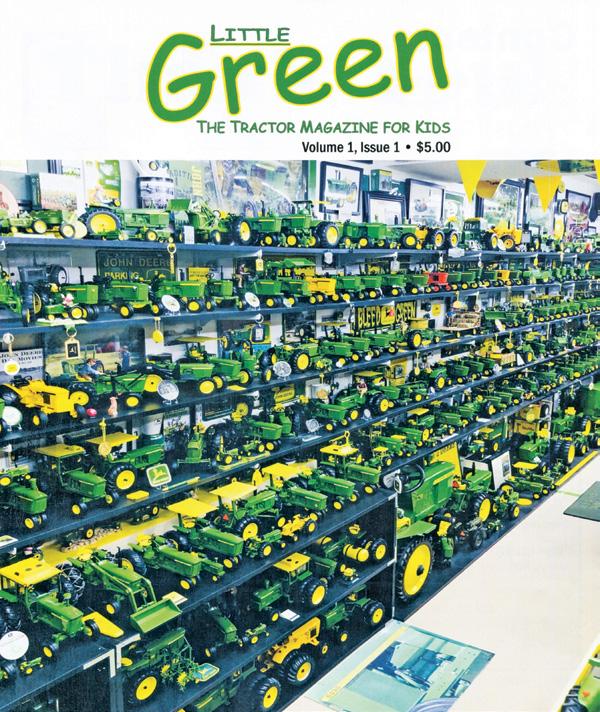
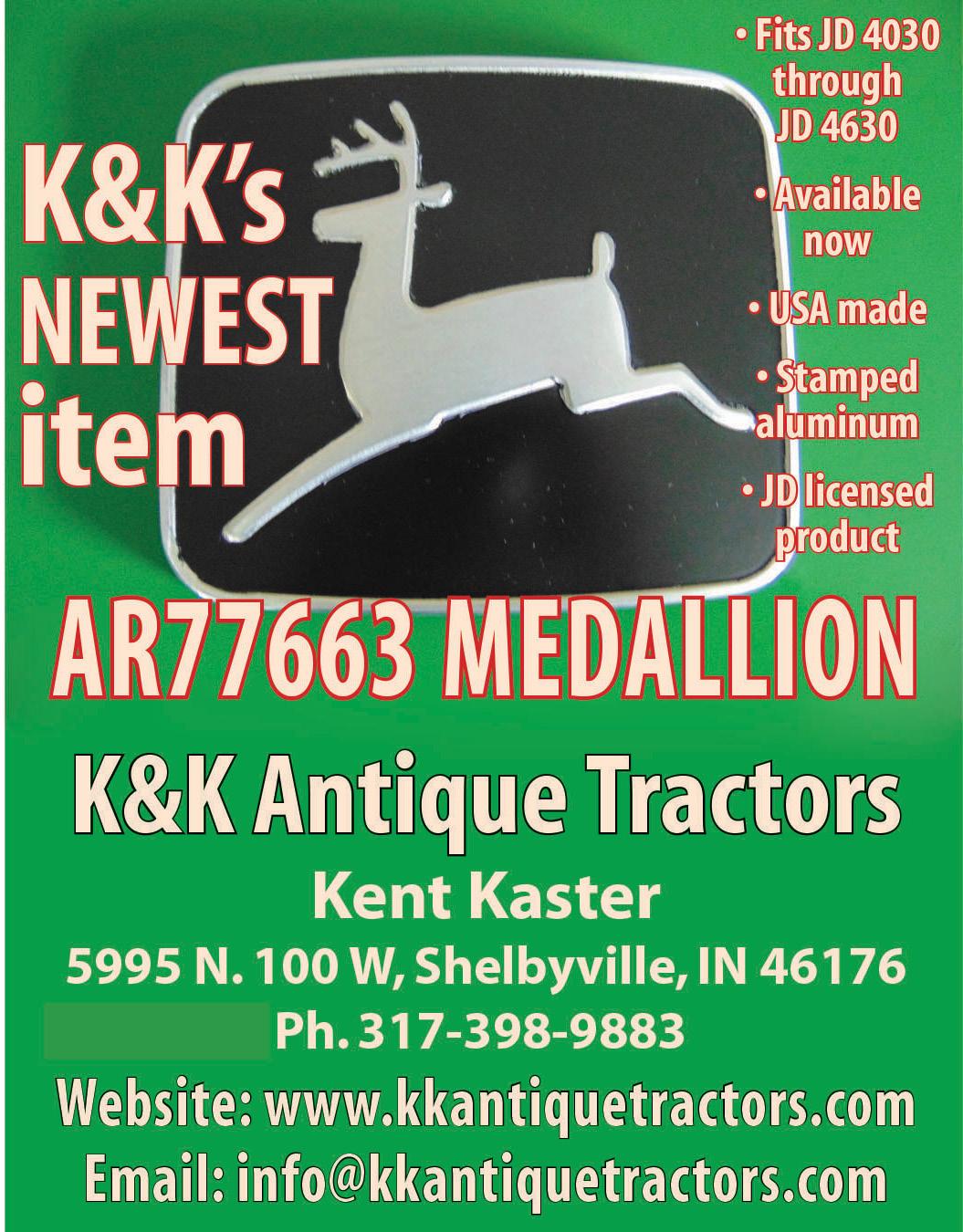
Kit Cleans Up Older Deere Hydraulic Mess
Scott Grove cleaned up leaky hydraulic valves on his older Deere tractors with a simple insert. The long-standing problem is one the company has yet to fix. Grove says it forces him and other owners of Deere tractors to replace O-rings on a regular basis, only to have the mess return. Grove’s fix eliminated the mess and the need to replace parts. With the Grove Conversion kit:
• Convert to ISO with easy push-pull connection
• Couplers connect under residual pressure with breakaway feature
• Kits available for 10 through 70 series JD tractors manufactured from 1961 through 1996
• Inserts are made in the USA. This product is protected under US Patent 10,760,725 B2 and other patents pending.
Installation consists of stripping the OEM outlets down to the block, removing the barrels and O-rings, and replacing them with the inserts. Grove then adds the aftermarket ISO coupler that threads into the insert. Installation instructions can be found on the Wapsi website.
Kits for 10 series are priced at $315, kits for 20-40 series are priced at $329, and kits for 50-70 series are priced at $355. Also watch the website for more additions coming soon. Grove suggests checking with local Deere dealers & local repair shops or Wapsi Innovations directly. DON’T
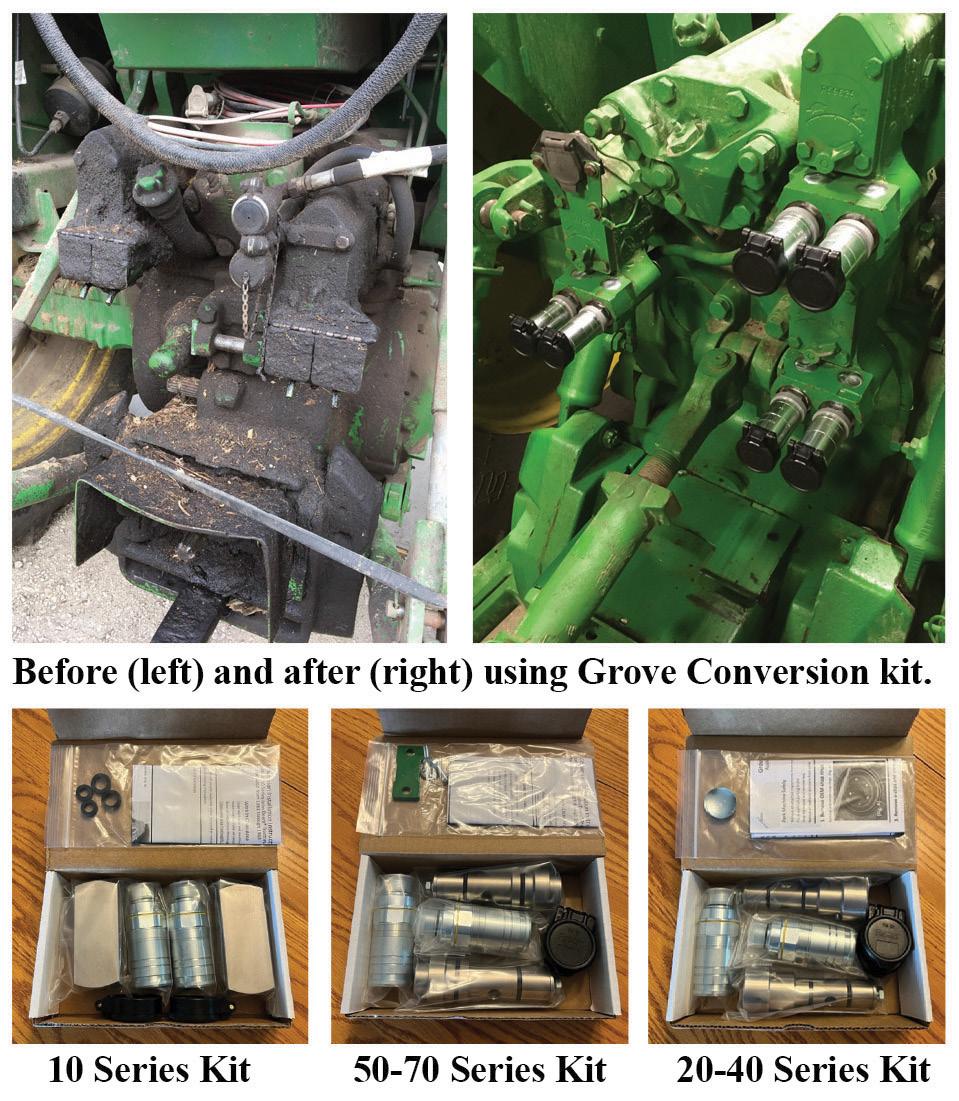
BE FOOLED BY THE “COPYCAT” version! Purchase “THE ORIGINAL” GROVE CONVERSION. We 100% guarantee our product from leaking or your money back! PH: 641-229-7413 • Wapsiinnovations.com Questions? Call or email It’s back! Little Green The Tractor Magazine for Kids US $24.00
6 issues per year Canada $32.00
funds) Foreign $36.00
funds) Plus 7% Indiana state sales tax Send payment with the subscriber’s name
address to: Mail: 1041
Rd, Williamsport
/
(US
(US
and
S Williamsport
IN 47993 Call: 765-585-9555
Subscribe today! Page 12 May 2024 • Green Magazine
Email: littlegreenmag@gmail.com Website: www.littlegreenmag.com
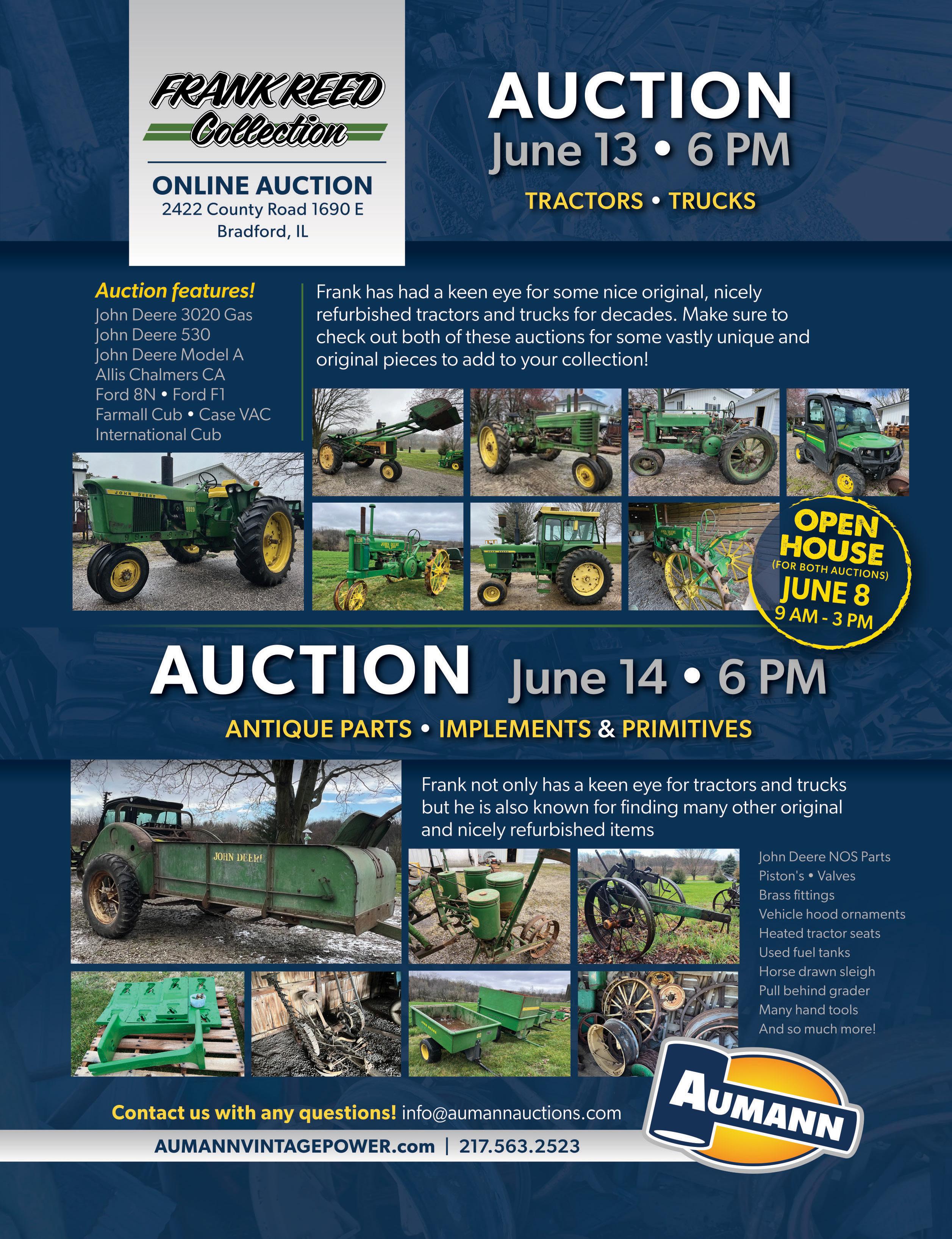


Today, when I reflect on the year 2020, it seems that I might be confusing reality with the memory of watching a late night episode of The Twilight Zone. I have read that it is quite normal for the human brain to block out or slow recall of bad or traumatic memories. With normal life going out the window for some time with fear of passing or catching the COVID-19 virus, memories of those times in my brain were put on the shelf and forgotten. However, from time to time, my mind wanders back into the “twilight zone.”
This month, I recall a fellow (Clyde) from Alaska in the year 2020, who reached out to me to ask my opinion on a plow listed for sale in Iowa. The plow in question was not just any old plow, it was a John Deere 825 two-way rollover plow. He found a for sale listing in the GM classified ads and was looking for information about a few missing coulter parts along with my opinion on the overall condition. We conversed back and forth a few times and, after identifying that the plow was missing several critical parts and that seller was not wanting to deal with the logistics of transport from the midwest to Alaska, he asked me if I knew of such a plow for sale.
Clyde was in luck as I had an 825 3-16 plow that I would sell. He was looking for one to buy and bring up to his farm near Fairbanks to use on his farm where he grows vegetables. He has a John Deere 720 gasoline standard tread tractor and noted that finding good used equipment in his part of the world is particularly difficult. The
tractor was sold new in Fairbanks and spent its life working ground around the area. He wanted to pair a two-way plow with his tractor to help with deep tillage between growing oats and cabbage.
The plow was in good condition but was missing coulters. It was also missing one of the rear bottom coulter
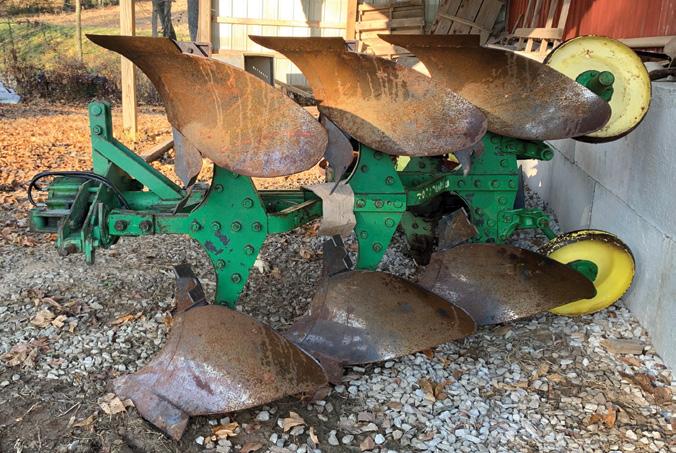
The 825 plow when Clyde first became interested. Notice it has no coulters.
Below: Zach snapped this photo of me right after the hydraulics quit on the 720 while demonstrating the function.
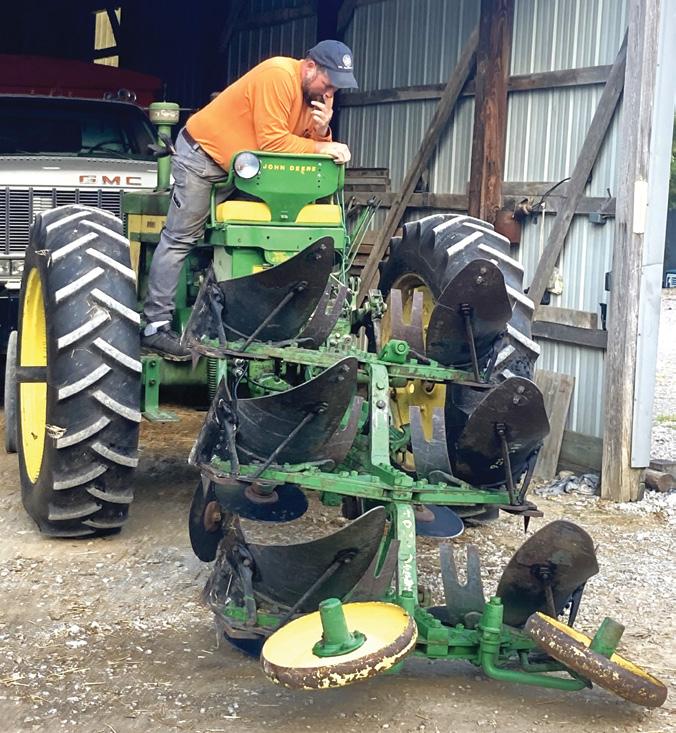
brackets (specific to the 825 plow). Knowing Clyde was planning to use the plow for production agriculture, I agreed to equip the plow with all six coulters so it would be ready to get to work for him. The hydraulic vanetype cylinder was functional and did not have any leaks and the wear parts were in good shape.
As Clyde and I struck a deal on the plow in late 2020, COVID-19 restrictions were still in play. He anticipated that the travel restrictions in Canada to ease, allowing him to drive through on the way to Illinois. His plan was to drive down into the lower 48 U.S., visit his brother in Indiana, and get the plow at my place in Illinois in his one-ton pickup truck; you might consider it a working vacation. As the then new presidential administration changed in early 2021, which canceled the XL oil pipeline project from Canada to the USA. Some have drawn the conclusion that travel restrictions got even more strict as a retaliatory move; motorists were only allowed to get out of their vehicle in Canada to fuel. Technically, bathroom breaks were not even allowed as it was non-approved so leaving the vehicle which could mean jail time! For reference, travel time by car from Fairbanks to Seattle is approximately 39 hours. Did I mention that a vaccine passport was required for travel to document a double COVID-19 vaccination?
Seeing how it was going to be difficult for Clyde to make it down to Illinois with all the travel restrictions, I agreed to store the 825 plow inside my shed until he could make arrange-
Page 14 May 2024 • Green Magazine
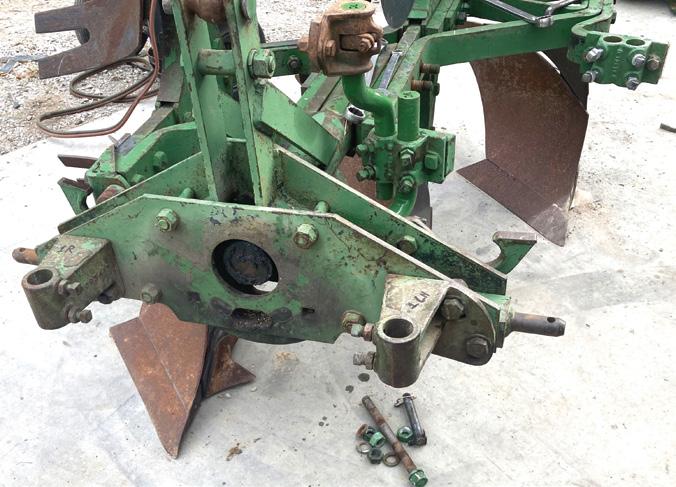
With the cylinder removed, we decided to go further and take off the front coulter brackets to make it more compact.
Below: The goal was to reduce the plow in size with the minimum amount of parts, making it easier to assemble later on.
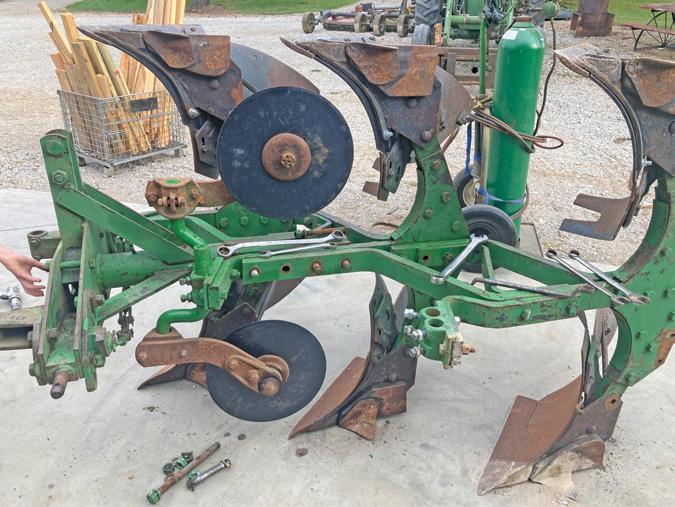
ments to get it. Time passed and I sold my place in Illinois and moved the 825 to our farm in Missouri, where it again was stored inside under roof with a bunch of my other plows in an old shed.
Fast forward to late summer 2023 and Clyde began making plans to get his plow. Driving all the way from Alaska was not an option due to the time it was going to take (7,900 miles round trip) so Clyde explored shipping options. He found a company called Span Alaska, which would handle LTL transport from my farm in Missouri to the west coast and by ship from there to Alaska. To make this work, we would need to put the plow into a crate (to make it affordable). I measured the plow and estimated the size in which we might have to work. Clyde wanted to see about me hauling the plow to his brother’s place in Indiana, where they could disassemble and crate, but after realizing that Karl had no real workshop or front end loader to work
with, I offered to crate the plow myself at my farm in Missouri and just ship it from there. Clyde wanted a reason to visit his brother in Terre Haute, Indiana and he made plans to fly out to Indianapolis, where his brother, Karl, would pick him up and they would head west to Missouri. I had the equipment and tools necessary to get the job done and they would provide help and of course make decisions about how we would accomplish the task.
Clyde and Karl planned to travel out near my location, staying over in a hotel. They arrived early on a Saturday morning, ready to help deconstruct the plow and get it in a crate. I had some extra heavy duty pallet material that we could use to make the base as well as spare building material from my house and shed projects. I hooked up the 825 to my 720 diesel row crop tractor before they arrived as I planned to demonstrate the hydraulic cylinder action. I had rebuilt the rotary vane cylinder for Clyde some weeks earlier as it had begun weeping around the shaft during the three years in storage and wanted him to see that it functioned.
After looking the plow over, I started the 720 and began rolling it over only to find that it would turn just one-quarter of the way around. Upon closer inspection, I realized that the cylinder was timed 180 degrees out from where it was supposed to be. After a few minutes and some tinkering to remove the attaching pin, rotating the cylinder 180 degrees and reinserting the pin, we had it rolling
We tried to save all the bolts but a few of them required the liquid persuasion of the acetylene torch.
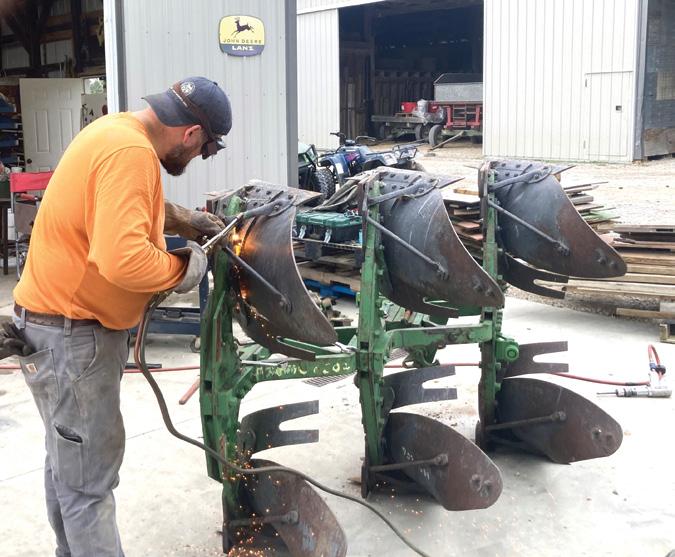
over correctly. I turned it one last time and before completing the rotation of the plow, the tractor hydraulics simply stopped. The engine did not labor nor did I hear any unusual noises—just nothing. The hitch would not lift nor would the remove valve function. Well, I was flustered to put it mildly, but the 720 hydraulics would have to be dealt with after the plow was made to fit inside of the yet to be constructed crate.
With help from my 4020 tractor with its 148 front loader, we lifted the plow up and disconnected it from the 720’s three-point hitch. With the plow sitting on the concrete pad outside of my shop, we sized up just how to make it fit in a crate. The goal was to make it work inside of a four foot wide by five foot long by four foot tall totally enclosed crate. I estimated the total weight of the plow with the crate at 2,000 pounds as the fully loaded 825 plow with coulters rates in the sales manual at approximately 1,750 pounds.
The 825 measured nearly nine feet long and a little over 40 inches wide by itself. I estimated that it would take four to five hours to partially disassemble and crate the plow. According to the 825 operator manual, these plows were shipped with the frames assembled but without the hydraulic cylinders, wheels, coulters, and plow bottoms. I guessed it to be easier to just leave the main frame assembled
Karl checking out the two bottom plow (after removing the third bottom and frame).

Green Magazine® • May 2024 Page 15
and remove the standards from the side plates, but it would require a tryand-see approach.
We decided to remove the cylinder from the plow (we marked the correct position of the cylinder so he would know how to time it upon assembly in Alaska) as it would make the plow more compact. We also removed the front coulters and coulter brackets so that the front of the plow was flush with the hitch assembly (which remained in place for the journey). To shorten the plow, we removed the rear wheels and axles. We needed to make another couple feet more compact so we decided to remove the third plow bottom standards and frame from the main part of the plow. We also removed the plow bottoms from the standards such that we could nest the third frame/standards into the first
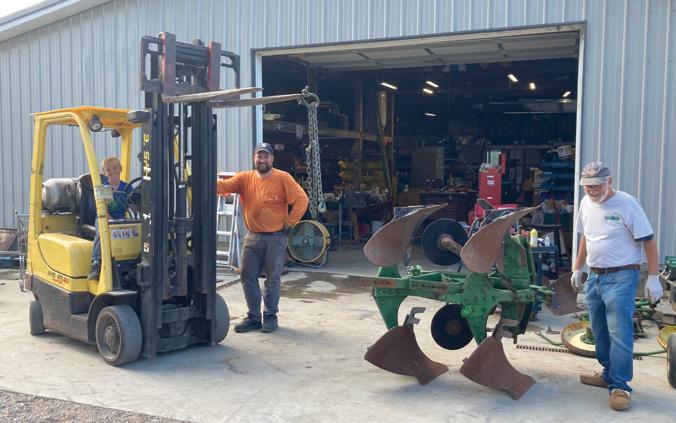
Zachary helped us with the process by being our forklift operator.
Below: Notice the third bottom frame/ standard assembly nested into the main two bottoms. This way, the plow would sit flatly on the crate supported by both first and second plow bottoms so it would be less likely to tip or fall over in the crate.
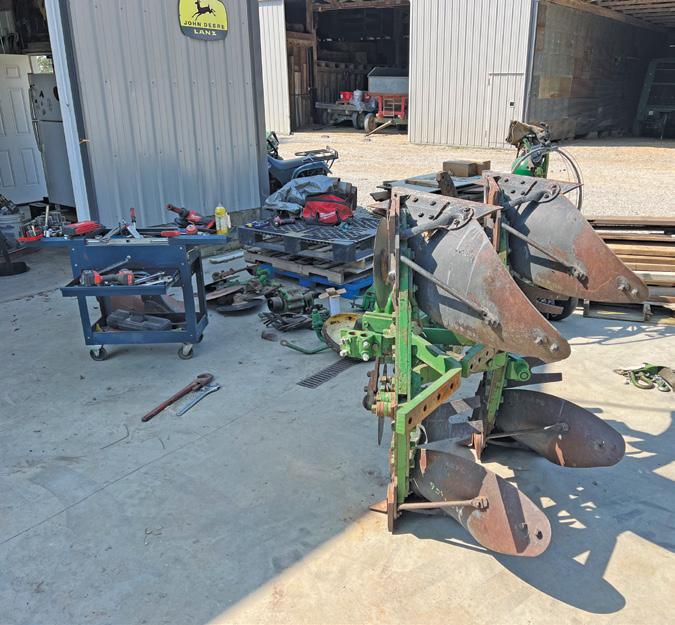
and second frame standards. This way everything would fit together, not only to be more compact but also to intertwine everything so that it would likely survive any rough handling which could be expected on the long journey.
I handled the planning and execution of the mechanical disassembly with help from Karl and Clyde and they handled the crate building. It turns out that Karl and Clyde learned a great deal about carpentry early on in their upbringing on a dairy farm in Wisconsin and have kept their skills sharp as the years passed. While I had estimated only four to five hours, it took a little longer before we had the plow crated up and ready for the trip overland and oversea. With plow crated and ready for the LTL company to come and pick it up, Clyde and Karl departed for Indiana.
A few days later, the freight company arrived and I loaded up the plow crate onto the back of the semi trailer to begin the first leg of the journey. Clyde kept me up to speed on the progress of the plow as it took

With everything tucked into the four foot by five foot footprint of the pallet, Clyde and Karl built a framework to fasten the sheeting.
Below: Clyde and Karl putting the last side sheet on the crate.
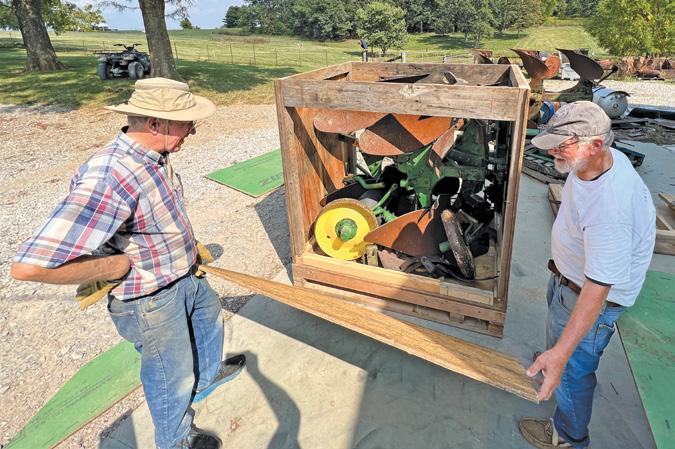
less than a week before it was out at the docks near Seattle. In less than two weeks after arriving in Seattle, the plow had arrived in Alaska and Clyde was headed home with it, he informed me. His plan is to assemble it when the weather is warmer (by the time you read this he should be up and plow ready).
The hydraulic problem on my 720 diesel row crop tractor is still a work in progress to which I will cover in a future article. I will mention that the rollover plow had nothing to do with causing the hydraulic failure but again wait a little while and read all about it right here in GM. By the way, Zachary and I are still working to wrap up the 1941 “H” repair project and keep you up to date as soon possible.
Contact Tyler Buchheit by email at tyler@mrbtractors.com. His website is www.mrbtractors.com
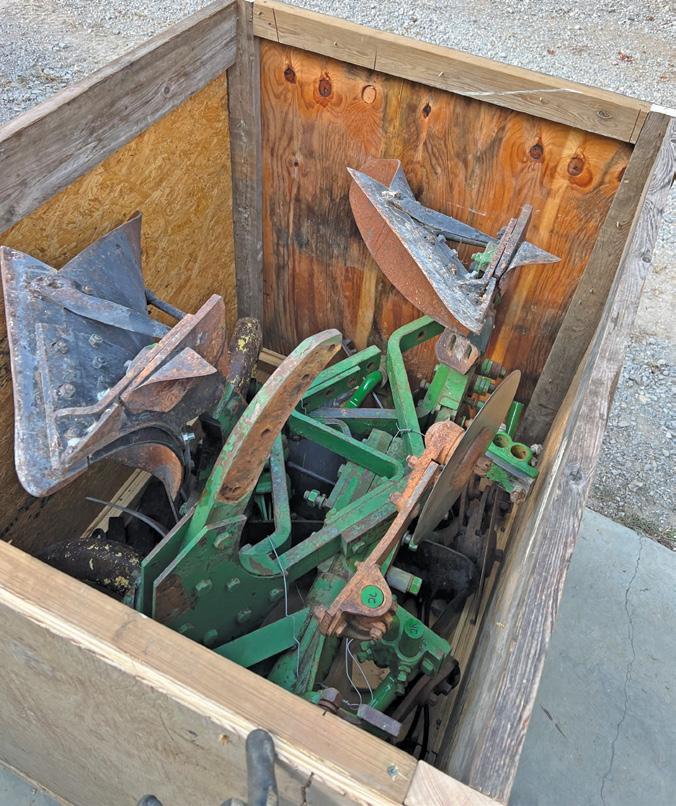
The last view of the plow before sealing it shut with the top.
Below: It only took 19 days for the 825 plow to make it to Alaska just as the first snow of the season was falling! It is likely one of the only JD 825 plows in that part of the world.

Page 16 May 2024 • Green Magazine
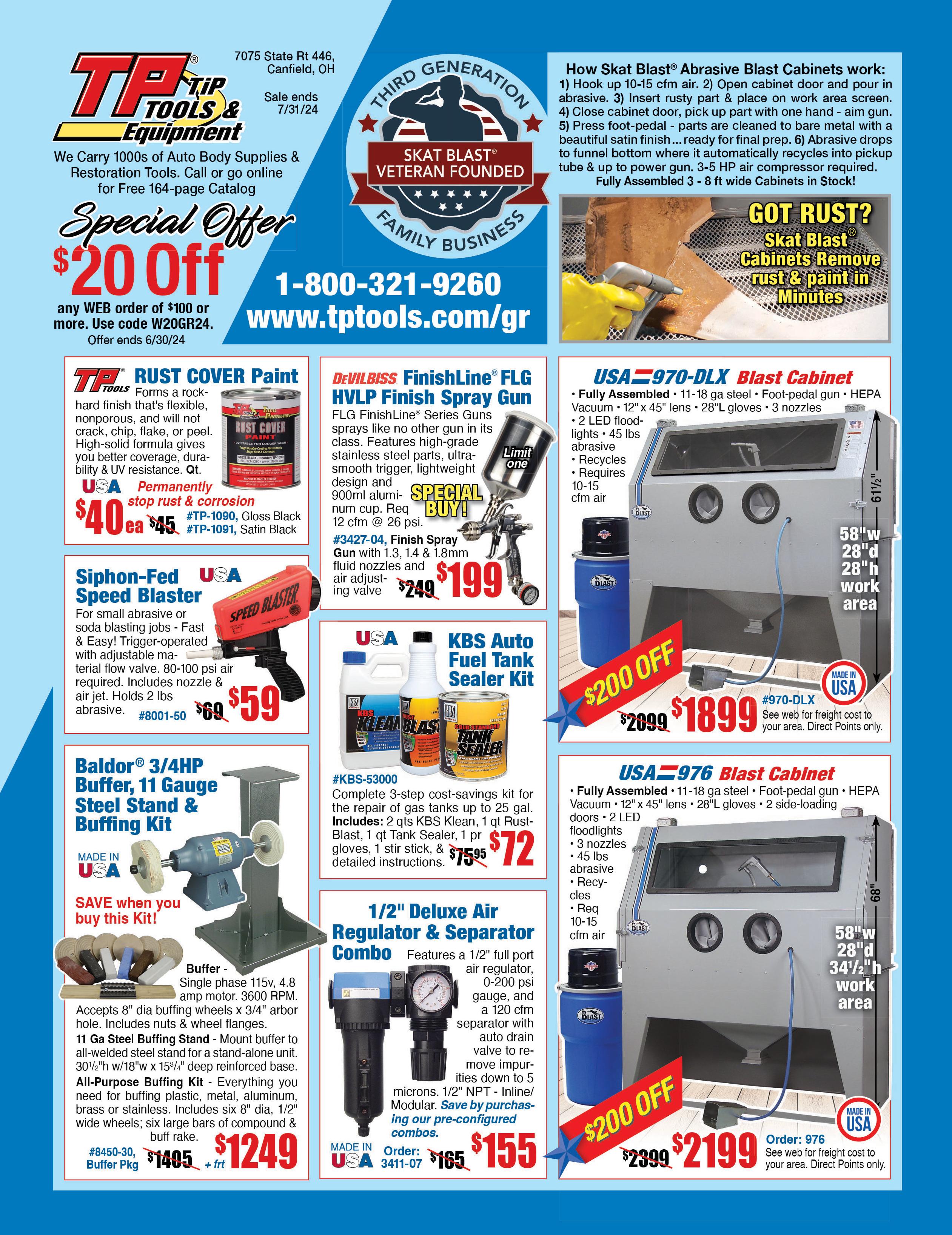


Deere and Company did not always spend many resources on industrial equipment. In their early days, they primarily left those clients to the firms that specialized in such things. Deere built a few specially modified tractors for industrial clients, but those orders were rare. When the economy tightened up, as during the Great Depression and World War II, Deere focused on their primary business and let the industrial sector wane or shut it down entirely. When World War II ended and the economy roared back to life, Deere began considering entering the industrial market again. Further encouraging the move was the slow dissolution of a deal between Deere and Caterpillar, which had previously kept Deere mostly out of industrial machines to avoid stepping on the other company’s toes.
Now, though, with the success of a couple of Deere’s “M” series tractors in industry, Deere began to look at the market once again.
Now, Deere looked at adapting their larger tractors for industrial custom-

ers. The model “R” was a beast in the field, as large and stout as any other on the market. Deere had its engineers explore what options and upgrades could be put into the tractor to make it fit for industrial use. In the end, Deere lost interest in that project. The main thing holding the
“R” back was its weak PTO gears. However, the heavy load transmission option for the “R” was born from these experiments, and lessons were learned along the way.
The successor to the “R,” the model 80, fixed a few of the previous tractor’s weak points and added a
John Craig stands next to his early style 840.
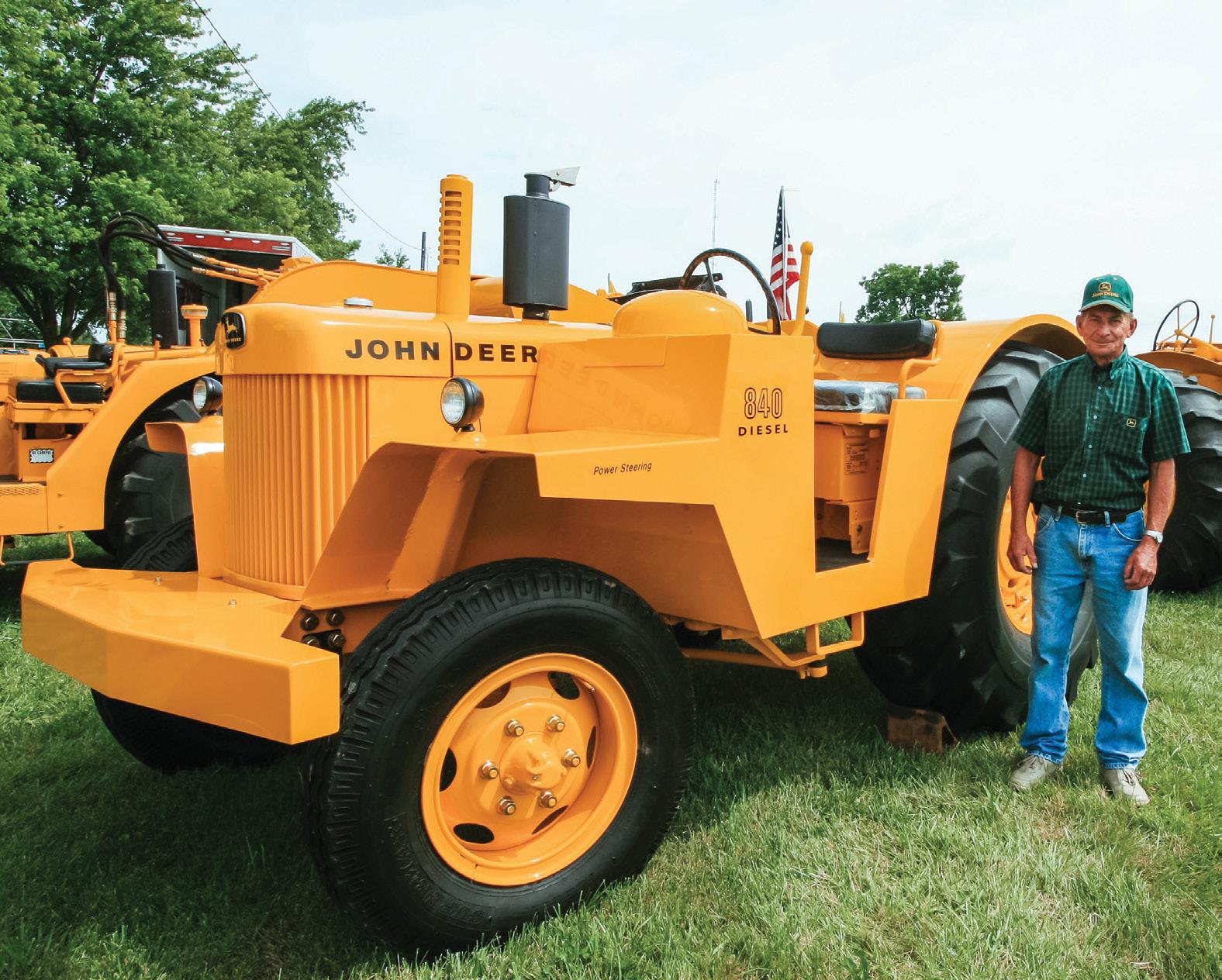
Page 18 May 2024 • Green Magazine


few updates to the machine, including custom Powr-Trol. The 80 was now an even more worthy tractor than the “R” for industrial service, and Deere revisited the idea, but model 80s that left Waterloo in industrial yellow still did so with the same hardware that the agricultural tractors had.
At about this same time, J.E. Hancock’s company in Lubbock, Texas was looking for a machine to power PTO-powered elevating scrapers. Hancock had been making land-moving machinery for some time but hoped that building a scraper that could be handled by heavy farm tractors would help to increase his sales since his selfpropelled units were costly singlepurpose machines.
Also during this time, a drought hit the Great Plains. With the prospect of crops failing, farmers looked at irrigation as a possible savior. However, irrigation could only be accomplished on very flat land, and little land is naturally flat enough to make it work. Center pivot irrigation was in its infancy, but those systems also required land with suitable contour. Farmers wanted to have earth moved to put their fields into shape for irrigation. Land-moving machinery suddenly came into higher demand, paving the way for a lucrative partnership between Deere and Hancock.
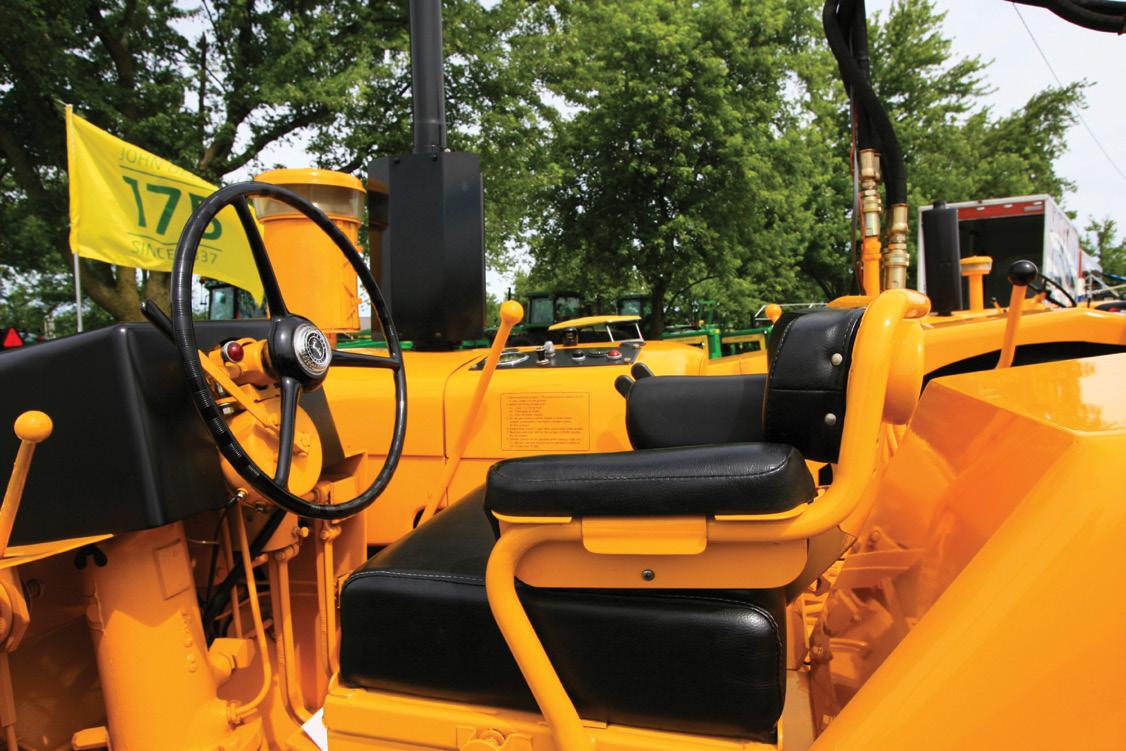
So, with the release of the model 80, Hancock searched for a heavy-duty tractor, and there was a greater demand for land-moving equipment. It was almost inevitable that Deere and Hancock would team up to build a great scraper. Exactly how the partnership began is unclear, but a model 80 with a Hancock scraper worked great. The tractor was one of the most fuel efficient on the market and had one of the best hydraulic systems available. Power steering made the work a lot less fatiguing for the operator. Rubber tires on both the tractor and the scraper made it so that the machine could be driven over the roads between jobs and made the ride more comfortable and agile at the work site.
Deere made the cooperative effort official in 1956. They approved five and eight yard model “N” scrapers, built by Hancock, for use with model 80 and 820 tractors. Deere formed their Industrial Division early the following year, and J.E. Hancock was offered an ownership share in a John Deere dealership.
The model “N” scraper was of the elevating type. Elevating scrapers required significantly less horsepower than fixed scrapers because the elevator did most of the work of cutting into the soil and loading the box. They also unloaded more easily because the elevator typically
broke up the soil as it was loaded. While they were more expensive to build and buy and required a PTO to run, the savings came in needing a smaller tractor and fewer passes required to level an area.
These first scrapers were on four wheels, with the front two on a dolly to attach to the tractor. The tractor’s PTO powered the elevator, and hydraulics raised and lowered the scraper. The combination worked well, was cost-effective, and got a lot of work done, but it suffered from one significant drawback. The tractor tended to lose traction as it pulled the scraper along, a problem that worsened as the machine filled with dirt. The dolly hitch put no weight on the tractor and did not provide any ballast; it was just dead weight. The chief engineer at Hancock, R.L. Rhinehart, believed that connecting the scraper to the tractor in a gooseneck configuration would make a big difference in its ability to create traction and move the pair through the soil.
The engineers at Hancock began to experiment with Rhinehart’s idea. They started with a model 820 tractor that they modified to accept a scraper with a gooseneck hitch. The front axle of the tractor was removed. Instead, the weight of the scraper at the back balanced the tractor, holding the front end off of the ground. The scraper body
Green Magazine® • May 2024 Page 19
Close up of the operator’s station on an early style tractor. Late style 840 operator station.
also had just one axle, turning the unit into a sort of articulated unit. This unit was much shorter than the eight-wheeled machines and was, accordingly, more maneuverable. The weight of the scraper was transferred to the scraper by design, and traction was improved as expected. However, the machine was hard to control when loaded and was unstable under many circumstances.
Hancock’s engineers concluded that the tractor’s instability had much to do with the location of the scraper’s connection point. It was too far rearward. Ideally, the gooseneck connection would be directly over the tractor’s rear axle. This should improve the tractor’s stability and traction and reduce the stress of the connection and weight on the frame. The problem was that this location was where the operator’s station was. Several significant modifications would have to be made to make the ideal scraper, but it was believed to be worth the effort.
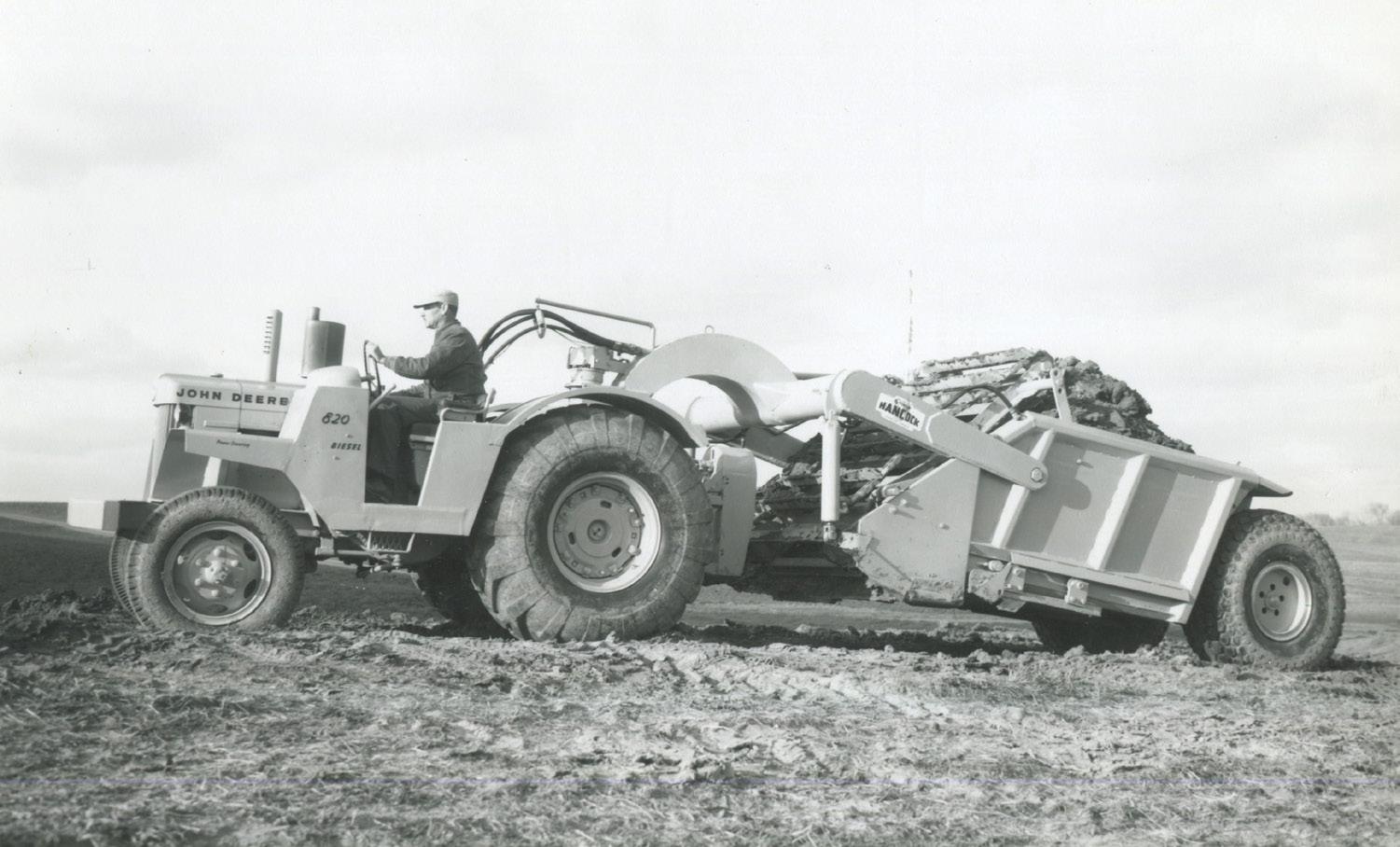
Though it is probably an 840 underneath, this early tractor is wearing 820 sheet metal and pulling a Hancock scraper.

In 1958, Deere added several options and improvements to the 820. They increased the engine’s power and added heft to make it more durable. New options included a foot-operated throttle, heavy-duty drawbar supports, and an auxiliary hydraulic reservoir. Each option was a significant benefit when the tractor was used with a Hancock scraper and was developed
specifically with that equipment in mind. The foot throttle, for instance, made it so that the operator could steer, run the hydraulics, and change speeds simultaneously—a common need in earth moving. There was no official industrial version of the 820, but adding these options outfitted the tractor into something very close to one, and since Deere was also willing to paint the tractor in industrial yellow, it was tantamount to an actual 820 industrial existing.
With Deere creating modifications that helped their tractors work better with Hancock, and Hancock committed themselves to Deere’s big tractors, the relationship between the two companies grew stronger. The two began working together
840 Production Numbers and Serial Number Breaks
Even though the serial number register shows that the last 840 was number 8400844, it is known that tractors as high as 8401154 exist. This makes it difficult to get a handle on the actual number produced, but it was most likely less than 1,200.
more closely. Deere handed an experimental 820 tractor to Hancock. Hancock pulled the tractor apart and found a way to move the operator’s station forward and to the left, between the front and rear wheels and left of the engine. There was now room at the back of the tractor for the gooseneck hitch, and visibility from the operator’s station was very good to the front and rear.
The new hitch tilted and rotated and put the weight of the scraper directly on the tractor’s rear axle. The hitch location also made it necessary to change how the PTO connected to the scraper. A set of belts and pulleys sent power up and behind the hitch. From there, a short shaft brought power into a gearbox, which tuned upward and then backward, sending power to the scraper via a driveshaft alongside the hitch. The hydraulics of the scraper were plumbed down the neck of the machine and connected to the tractor at outlets where the floor of the operator’s station used to be.
This concept machine was working well—a noticeable improvement over earlier machines. Deere was now completely behind Hancock’s work, providing the company with eight more model
Year Beginning/Ending SE EL Total 1959 8400000-8400505 137 538 675 1960 8400506-8400844 83 225 308 1961 8400845-? Total 220 763 983
Page 20 May 2024 • Green Magazine

820 tractors with a few parts left off of them. One more tractor was sent to Hancock, where they converted it to their side-saddle style and returned it to Deere. Deere did some of their own tests on the tractor. Various front axles were examined, and a few other modifications were considered. Heavy truck-type front wheels were installed on nearly all of these machines.
As far as the other eight experimental tractors go, Hancock kept two in Texas and the other six were sent to Montana and Minnesota. The tractors were tested, worked with, inspected, and tested again there. Those who worked with the tractors discovered them to be economical and effective in the field. Furthermore, the new scraper, the model “E,” was far more effective in the field than the older “N.” Both companies were happy with the setup and excited about the new union of the two companies. Deere accepted the new scraper into the lineup and added it to their lineup for the 1959 model year.
Deere decided to call the new scraper tractor model 840. The number was chosen because it matched Dubuque’s new 440 industrial

tractor. Deere and Hancock worked together on the new tractor. By this point, Deere had released the 830 tractor to replace the 820, so the tractors sent to Hancock in Texas were 830s. Basic 830 tractors were a heavy-duty front axle, machined front end support, heavy-duty rear axles and wheels, a power steering unit with steering parts, the hood, starting controls, and some other parts were sent to Lubbock, Texas. There, Hancock added fenders, the operator’s station, various linkages, and several pieces of sheet metal. Hancock then attached the tractor to a Hancock 7E2 elevating scraper and sent them out into the world to customers and dealerships.
Only 63 model 840 tractors were built before Deere had to stop production. The company was receiving so many complaints about the fit and finish of the machines— particularly the Hancock fenders and sheet metal—that they had to take a break. These parts did not fit the machines well or had to be modified to be used. It isn’t known how the conversation between companies went, but Deere seemed to believe that Hancock was not going to improve the work that
they were doing, so Deere brought all of the production back home. Deere was also displeased with the costs of sharing production with the Texas company. Shipping the tractors to Hancock and then on to their destination was expensive, especially since only one tractor/scraper combination could fit on a truck trailer. Having the scrapers sent to Deere, where the machines could be built and then sent out, would save money. It appears that those at Hancock were fine with this change. They were in the business of building scrapers, not tractors, so having Deere’s tractors stop arriving at the shop was not upsetting to them.
The first model 840 was given serial number 8400001. Production stopped at serial number 8400063 and then skipped ahead to number 8400200 for the beginning of the Deere-built machines. Deere incorporated the assistance of Henry Dreyfuss and Associates in building and finishing the 840 tractors, and the Deere-built machines were much more refined than the ones that were completed by Hancock. The new tractors got new fenders and updated sheet metal. They had improved lighting, linkages, and controls and better comfort for the operator. Changes were also made to make servicing the tractors easier. Given that the new 840s were being built just a month after Deere shut down production at Hancock, they likely had plans in the works for some time before it actually happened.
Not every 840 that Deere built was destined to pull a Hancock scraper. They were also purchased by companies that wanted one for pulling a sheepsfoot packer, a compactor, or for heavy-duty tillage. If you wanted to use one with a scraper one day and then for an-
Green Magazine® • May 2024 Page 21
Here we have a late style 840 with a John Deere 400 scraper.
other use the next, you could. Deere said that it took less than 25 minutes to disconnect the scraper from the tractor. While there were few options for the 840, a buyer could choose between an electric start or a gasoline-powered starting engine. The latter cost about $140 more than the base machine, which came in at $6,485.
The 840 became one of Deere’s most popular industrial tractors. Deere’s salesmen were more interested in selling it than they had been with the company’s prior industrial tractors. It sold pretty well and was relatively popular throughout the country.
The newer 840 tractors were such an improvement over the old ones that owners of the earlier machines soon began asking about updating their tractors to the newer style. Deere obliged, telling them that it would cost $500 to do so. For that price, plus freight, Deere would update the fenders and sheet metal, the linkages and controls, and everything else that was different between the first 63 machines
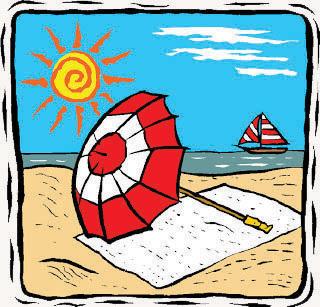

and the new ones, and they would get a new paint job to boot. Deere was even willing to update the first eight machines, which had been built from model 820 tractors. This program ran from August 1959 to March 1960, and Deere pushed the owners and branch houses to get the updates done. This means that few of the Hancock-built tractors remain today.
Deere made a few changes to the tractors at serial number 8400899, including modifications to the clutch assembly and a vertical drive 1000-RPM PTO. This PTO let the tractor run the new Deere-built 400 elevating scraper, which was released in 1961 for use with the upcoming model 5010 industrial tractor. This vertical setup created a more straightforward connection between the tractor and scraper, improving reliability.
Deere only built the 840 for about two years. They built and shipped the last one on September 27, 1960. However, Deere’s serial number register is somewhat messy regarding this tractor’s history.
First, it shows the final tractor built as serial number 8400848, but the above changes were made to the 840 at serial number 8400899. Furthermore, tractors with numbers as high as 8401154 have been found in the wild, and at least one Deere document written in 1962 states that the last tractor was numbered 8401200, so something odd has gone on here. This makes it hard to say how many 840 tractors were built, but something around 1,000 machines seems most likely.
An 840 won’t be a tractor for every collector. They’re big, heavy, uncommon, and built with parts that may be impossible to find replacements for. A complete tractor and scraper combination weighs over 12 tons and is 32 feet long, meaning that it would require a commercial driver’s license to haul to your home or a tractor show. But they’re rare, they’re unique, and they have that deep two-cylinder pop that is just so satisfying to hear. Plus, on an 840, you sit right next to that big engine, so your right ear will hear every beat!
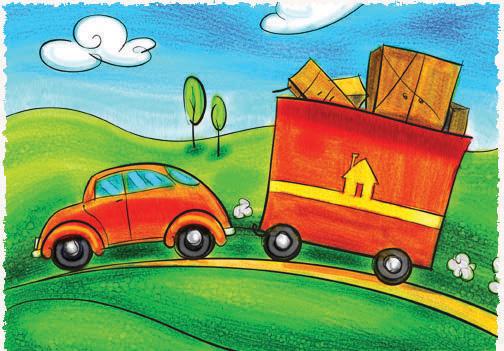
HEY, SNOWBIRDS and anyone else who is moving Whether you are heading south, going back home or moving to a new location, remember to call Green Magazine® with your address change FOUR WEEKS PRIOR to the move. Missed issues will NOT be resent free if your address has not been changed due to a seasonal move. NOTE: ANYONE moving should call or email Green Magazine® FOUR WEEKS PRIOR TO A MOVE to change the address on a subscription. Call or email Green Magazine® to change the address on your subscription Ph. 402-643-6269 info@greenmagazine.com Page 22 May 2024 • Green Magazine

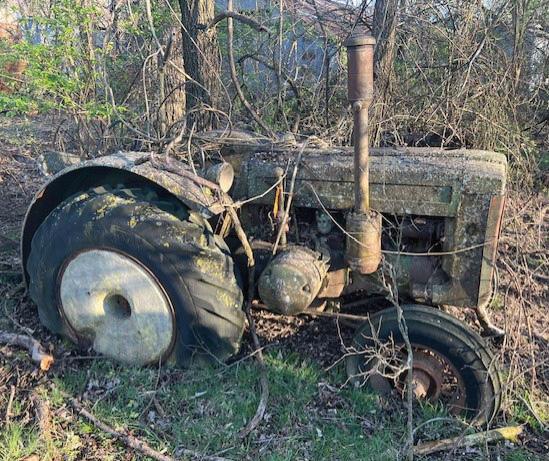
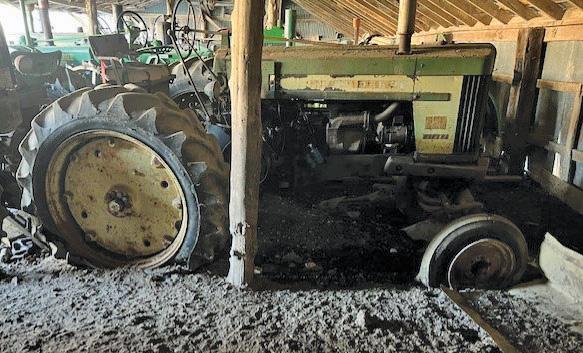
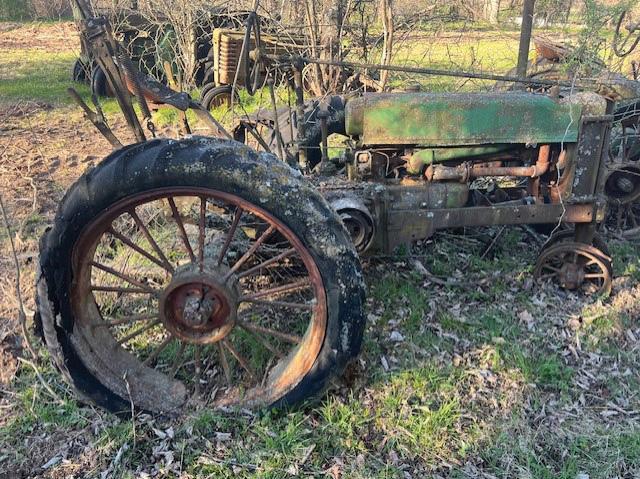
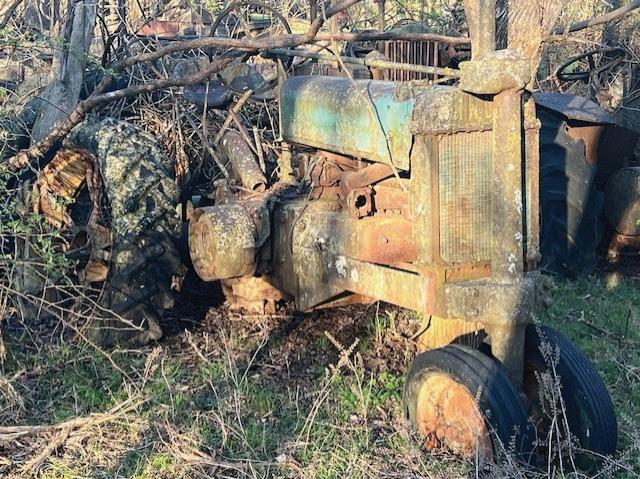
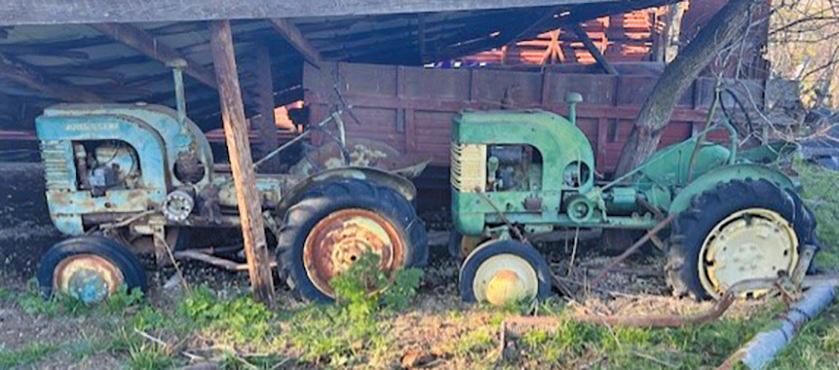
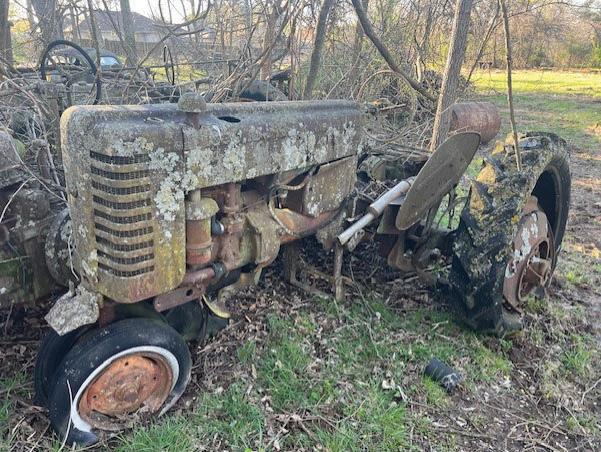


Auction: June 29, 2024 AUCTION JUNE 29, 2024 • 10 AM We will have 27 John Deere tractors • 15 hit and miss gas engines of various brands • 11 Dodge trucks • 8 Dodge and Plymouth cars • 28 implements of various brands Watch for updates at website: MeltonAuctionRealty.com SALE CONDUCTED BY: MELTON AUCTION & REALTY CO LLC ROGER MELTON, AUCTIONEER & REALTOR • NIXA, MO PHONE 417-830-0153 OR 417-725-1801 • EMAIL: roger@meltonauctionrealty.com ANNOUNCEMENTS MADE ON SALE DAY WILL TAKE PRECEDENCE OVER ANY OTHER PRINTED MATERIALS. NOT RESPONSIBLE FOR ACCIDENTS OR LOSS OF ARTICLES ON OR NEAR SALE SITE. Green Magazine® • May 2024 Page 23


In 1996, we moved into a new, larger office building and decided that the extra space would allow us to stock more items, enough that we could fill a small catalog. The impetus for this was a consistent request we were receiving for more Deere themed items. We contacted companies that were producing Deere licensed products and soon had 150 items. There was everything from afghans to windchimes including mailboxes, magnets and matchbox holders, wag-
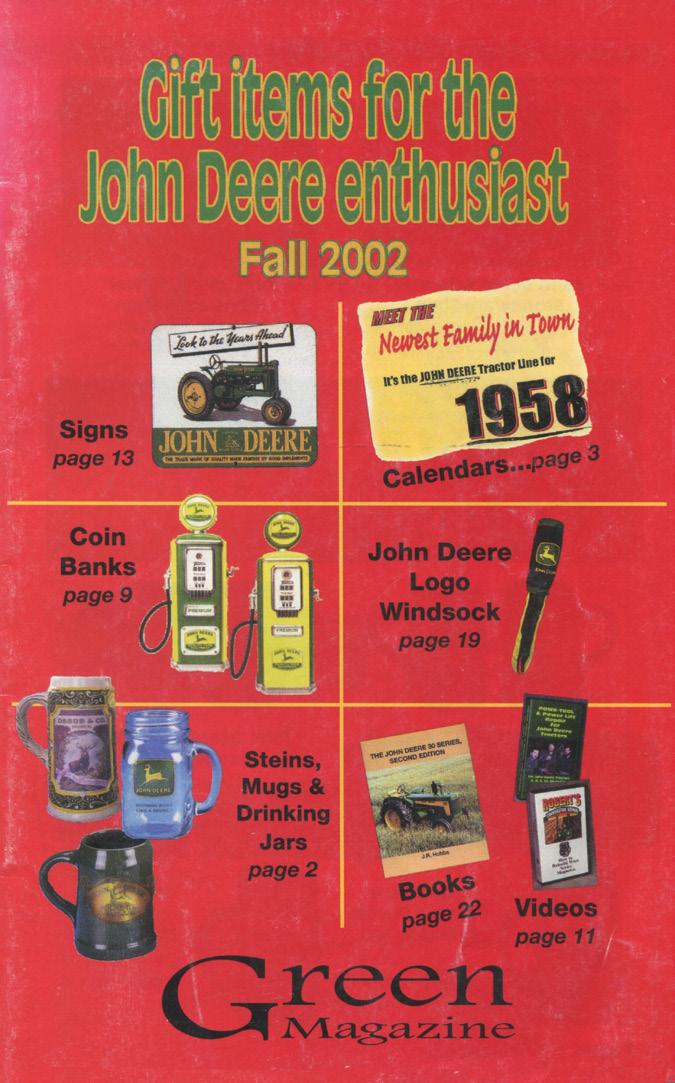
ons, wallpaper and weathervanes, pillows, paintings and plaques. We did this for about six years with a few items being dropped and a few new added each year. In those pre-internet days, phone and mail orders kept our office quite busy during the holiday season. An interesting side note is that we stopped selling one of our most popular items, what I would call a dealer clock produced by Yoder Clock Works of Indiana, because no matter how we packaged them
or how we shipped them, far too many were arriving damaged.
After about six years, we decided to end the catalog venture, for several reasons. First of all, with the cost of printing and mailing the catalogs, postage to send items out, paying the employees to do so and all the other associated costs, there just wasn’t enough profit left over at the end of the year to justify it. Secondly, somewhere around the turn of the century, Deere and Company seemed to have had a change of
Need a John Deere grill or coal shovel? We had them in our catalog; however, we no longer have any of these items.
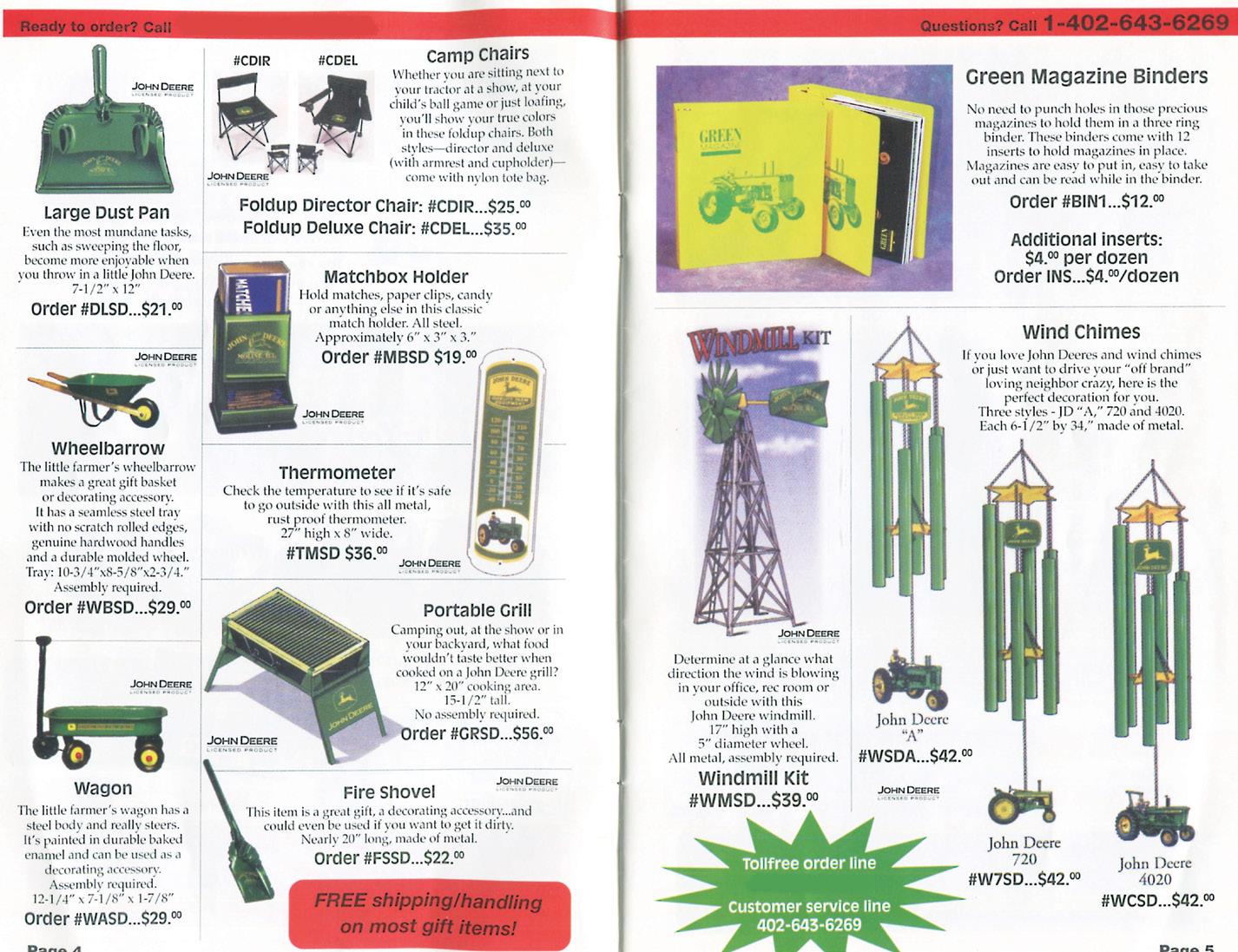 The front cover of one of our catalogs.
The front cover of one of our catalogs.
Page 24 May 2024 • Green Magazine
heart on what and how many items they would license. This meant that we were having an increasingly hard time finding items to include in the catalog. Another factor was that we were competing against some of our advertisers, who were selling the same items. With all of that in mind, we we stopped sending out catalogs and gradually sold off the remaining inventory through ads in the magazine.
Up until somewhere in the late 1990s, just about anyone could climb the stairs of the old Deere Spreader Works building where the archives were located and do some research. However, you now had to be either working on articles for a magazine or writing a book. The “average” hobbyist couldn’t just walk in and look up information on their tractors. The other was that the 8-1/2 by 11 inch glossy photos of tractors that we routinely run in articles went from being free, to costing $50 each. This was in the days before electronic files could be emailed to the customer, so Deere did have some expense in process-
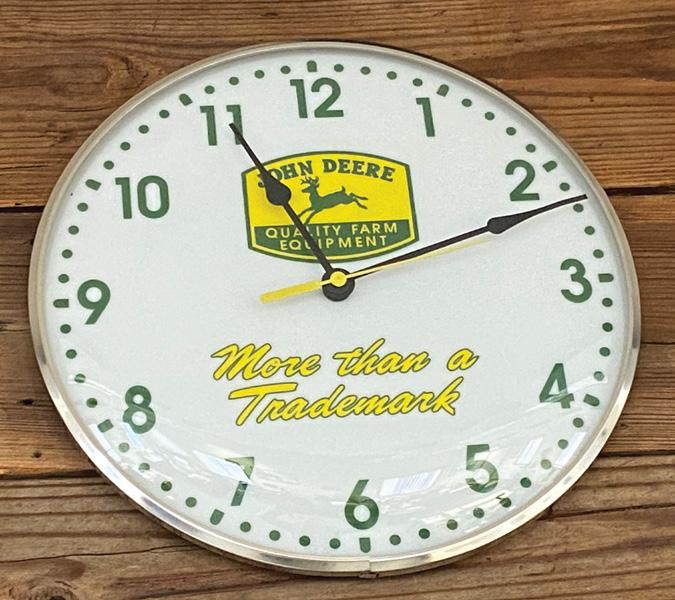
These clocks were a popular item and this one still hangs on the wall of the Green Magazine offices. No, it is not for sale.
ing and mailing the photos, so I can’t say that I thought the decision was unjust. However, everything that I have talked about in this article so far was perhaps an indication of the beginning of a new and different attitude by Deere toward the hobby.
In July of 1998, a show labeled as “Missouri’s First Worldwide Expo” was widely advertised and promoted and held near Conway,
Missouri. Called “Deere-Nado,” it had everything you could want in a show—besides displays, there were parades, tractor pulls, a tractor rodeo, vendors, an auction with some rare tractors consigned and many more activities. The facilities were nice and it was located not far from Branson, where there were hotel rooms and all manner of other things to do while in the area. Everything was in place for it to be a great annual event. However, for whatever the reasons might be, the tractors and spectators just didn’t show up in large numbers. The organizers gave it another try two years later, but it still didn’t attract enough people to keep the show going.
In April of 1998, we published Bill Proft’s first column on models/ toys then called Deeres On a Smaller Scale. He has been writing ever since without, as far as I can tell, missing a month. Along with Dan Brotzman, Greg Stephen, J.R. Hobbs, Ralph Hughes and others, we were providing a lot of new information to our readers.


MOVING? Whether your move is seasonal or permanent, contact Green Magazine® with your address change AT LEAST four weeks in advance of the move. Missed issues will NOT be resent free if your address has not been changed due to a move. Ph. 402-643-6269 • info@greenmagazine.com Green Magazine® • May 2024 Page 25
Detwiler Tractor Parts
ReRimming FactoRy Round & R
Flat Spoke WheelS F • Any brand tractor We can rebuild cutoffs back to steel
High quality

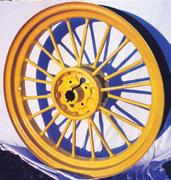
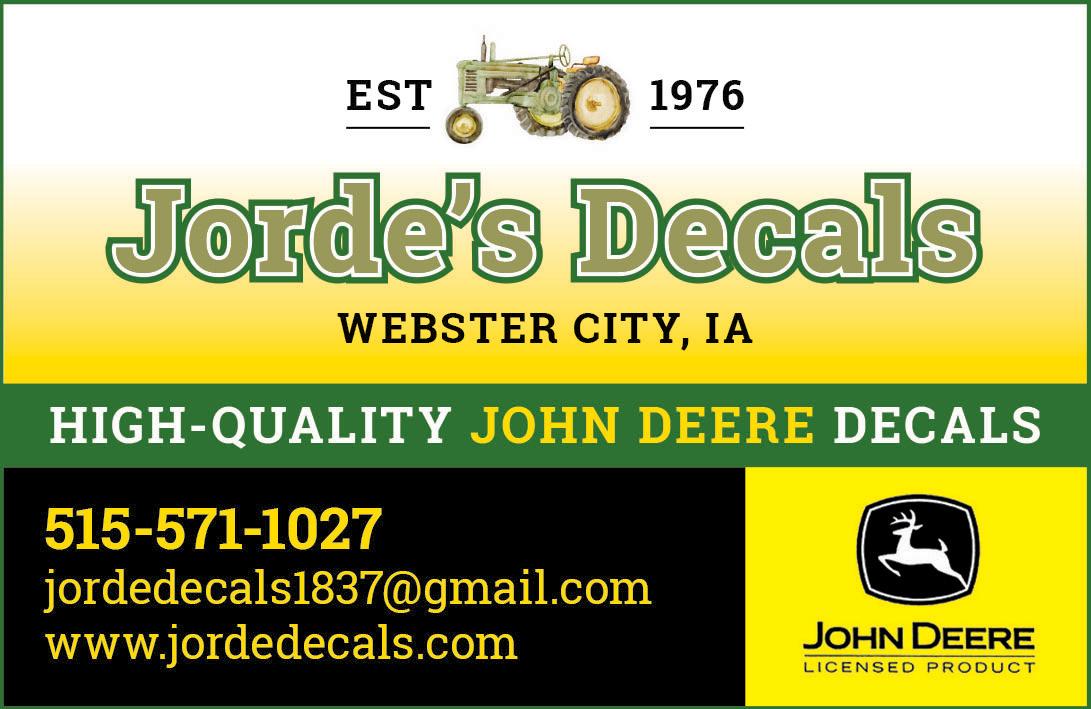

Wiring Harnesses - Cables - Switches
We build restoration quality wiring harnesses to fit these John Deere models and their variations:
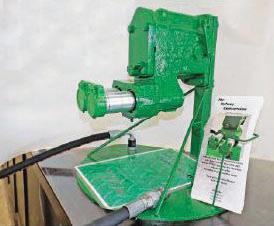
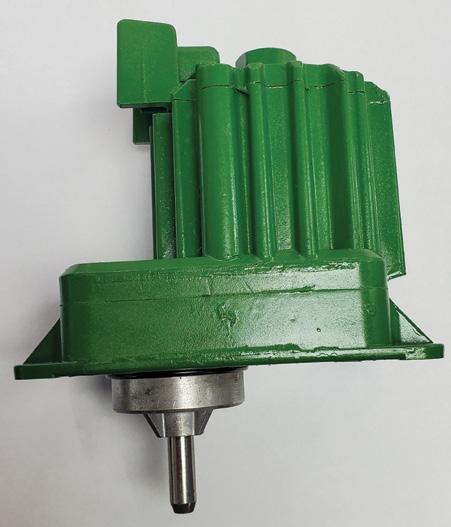

AG Models: A, B, D, G, GM, L, LA, M, R, 40, 50, 60, 70,80, 320, 420, 430, 435, 440, 520, 530, 620, 630, 720, 730, 820 2 cyl, 820 3 cyl, 830 2 cyl, 830 3 cyl, 920, 1010, 1020, 1520, 1830, 2010, 2020, 2030, 2040, 2040, 2130, 2240, 2350, 2355, 2440, 2520, 2550, 2555, 2630, 2640, 2840, 2855, 2950, 2955, 3010, 3020, 3150, 3255, 4000, 4010, 4020, 4030, 4040, 4050, 4250, 4230, 4240, 4430, 4440, 4455 Mexico, 4630, 4640, 4840, 5010, 5020, 6030, 7020, 7520, 8010, 8020, 8430, 8630, 8440, 8640, 8560, 8760, 8960, 8770
Harnesses available for other models & brands
See website for complete listing
Due to numerous variations, call to order Shipping/handling not included Visa, MC & Discover accepted
Prices subject to change without notice
Circuit protection kits for Diesel tractors
From $35 (2 cylinder)
From $60 (New Gen)
Industrial Models: Al, Bl, DI, 300, 301, 302, 302A, 310A, 350, 350B, 350C, 380, 400, 400 Scraper, 400B, 400C, 401, 410, 410C, 410D, 440I, 450, 4508, 450C, 450E, 455E, 480B, 500, 500A, 500C, 510D, 540E, 544A, 548E, 600, 7E Scraper, 700, 700A, 710D, 750, 755, 840, 1010C, 1010W, 2010C, 2010W, 3010I, 4010I AG Machinery: 45, 55, 4710, 5730, 5830
Lawn and Garden: Commercial mowers: 38”, 48”, 54”, GX1320, 727
Z-Trak, 60, 70, 110, 112, 120, 140, 200, 208, 210, 212, 216, 245, 300, 312, 314, 316, 318, 285, 320, 322, 330, 332, 420
Compact Tractor: 790, 850 Snowmobiles: 340 Cyclone
We also carry: Starters, Regulators, Generators, Alternators, Relays, Coils,
Lights, Alternator
We make alternator conversion harnesses Call for a FREE 100 PAGE CATALOG! CALL: 716-937-6618 • WORLDWIDE SHIPPING International phone: 001-716-937-6618 Email: agriserv@rochester.rr.com 13899 North Road, Alden, New York 14004 www.wiringharnesses.com
Brackets, Pulleys
/ very accurate reproductions We can also replace damaged spokes • The only source of original style rear rims Rear wheels can be custom sized for pullers • Will also rerim cutoffs front and rear ALSO: NEW JD FRONT AND REAR WHEELS CALL FOR DETAILS • DETWILER MACHINE Text 715-613-1520 • Email
or call numbers listed DETWILER TRACTOR PARTS 206191 State Hwy. 13 • Spencer, WI 54479 30 years in the same location • 9 AM - 5 PM CT Mon - Fri Ph. 715-659-4174 • 715-659-4252 QUALITY NEW & USED PARTS Exhaust Pipes • U.S. Made Radiator Cores • Front Weights Engine Parts • Manifolds • Mufflers • Airstacks Battery Boxes • Fenders & Hoods • PTO Shields Steering Wheels • Flywheels • Grill Screens Clutch Parts • Grill Guards for D & GP • Airstacks - D & GP We do carb, magneto and general tractor repair NEW ITEM: Airstacks for D and GP $315 DELUXE CONVERSION KIT NO MORE DRIPS! • An easy leak-free ISO conversion kit for John Deere tractors from 1964-1982 • Push-pull design eliminates levers • Breakaway action includes all seals and dust covers Remanufactured stepper motor Fits models: 6000 SRS tractors ‘00, ‘05, ‘10, ‘15 & ‘20 SRS OEM part #AL181805 $450.00 exchange $200.00 core value Ph. 315-536-3737 GreenLight Products LLC Rebuilt in our facility Page 26 May 2024 • Green Magazine
patdetwiler@gmail.com
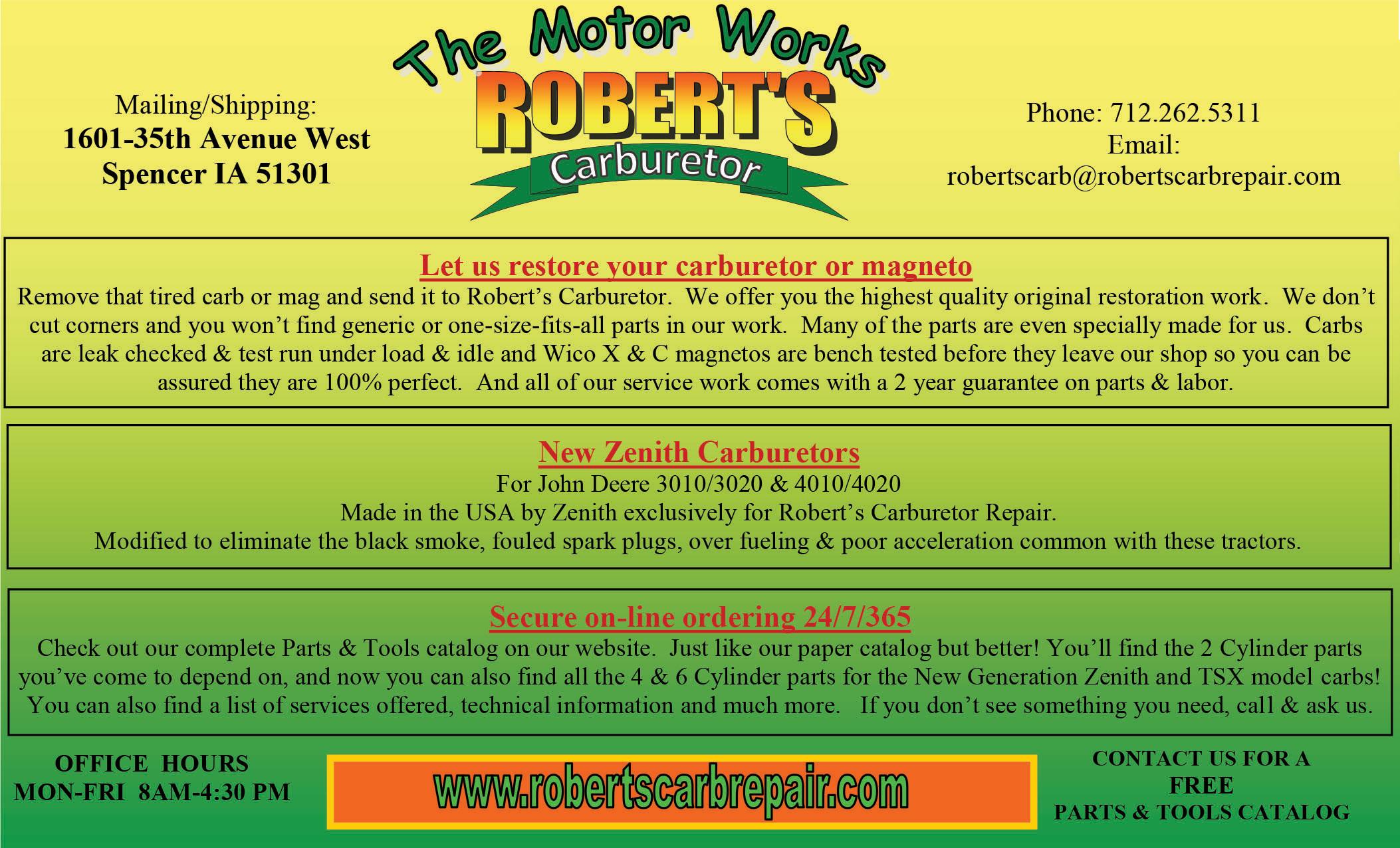
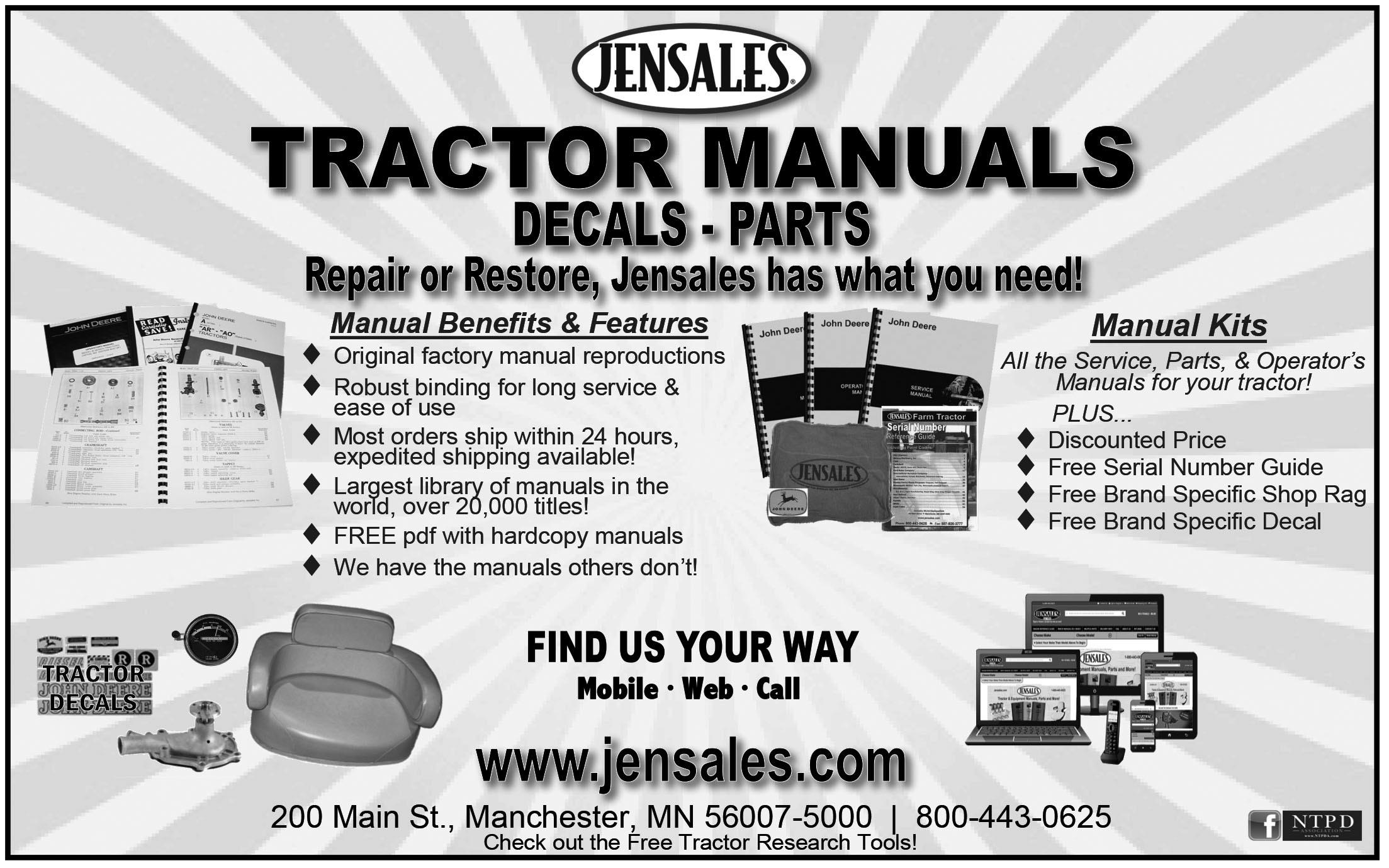
Green Magazine® • May 2024 Page 27



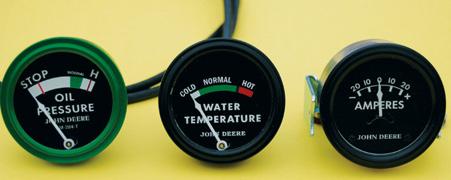
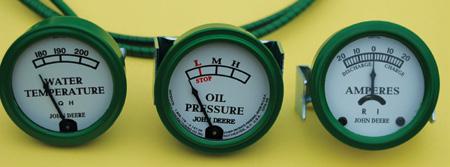


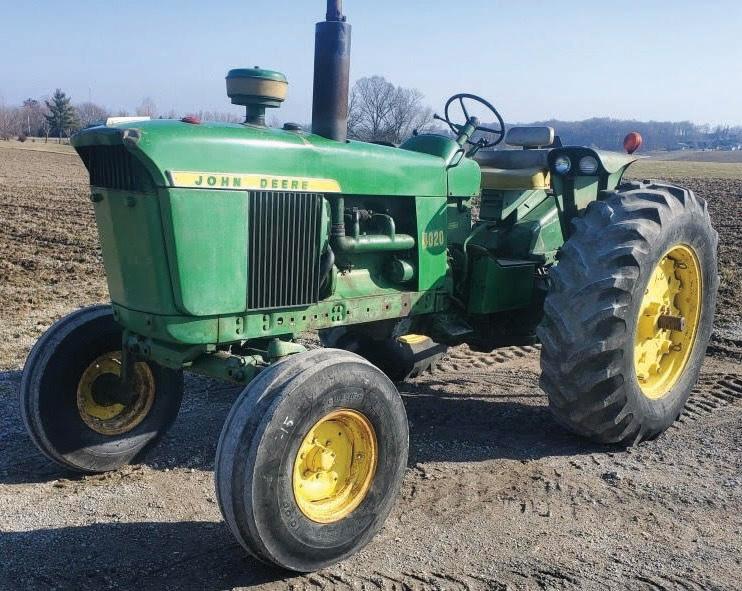
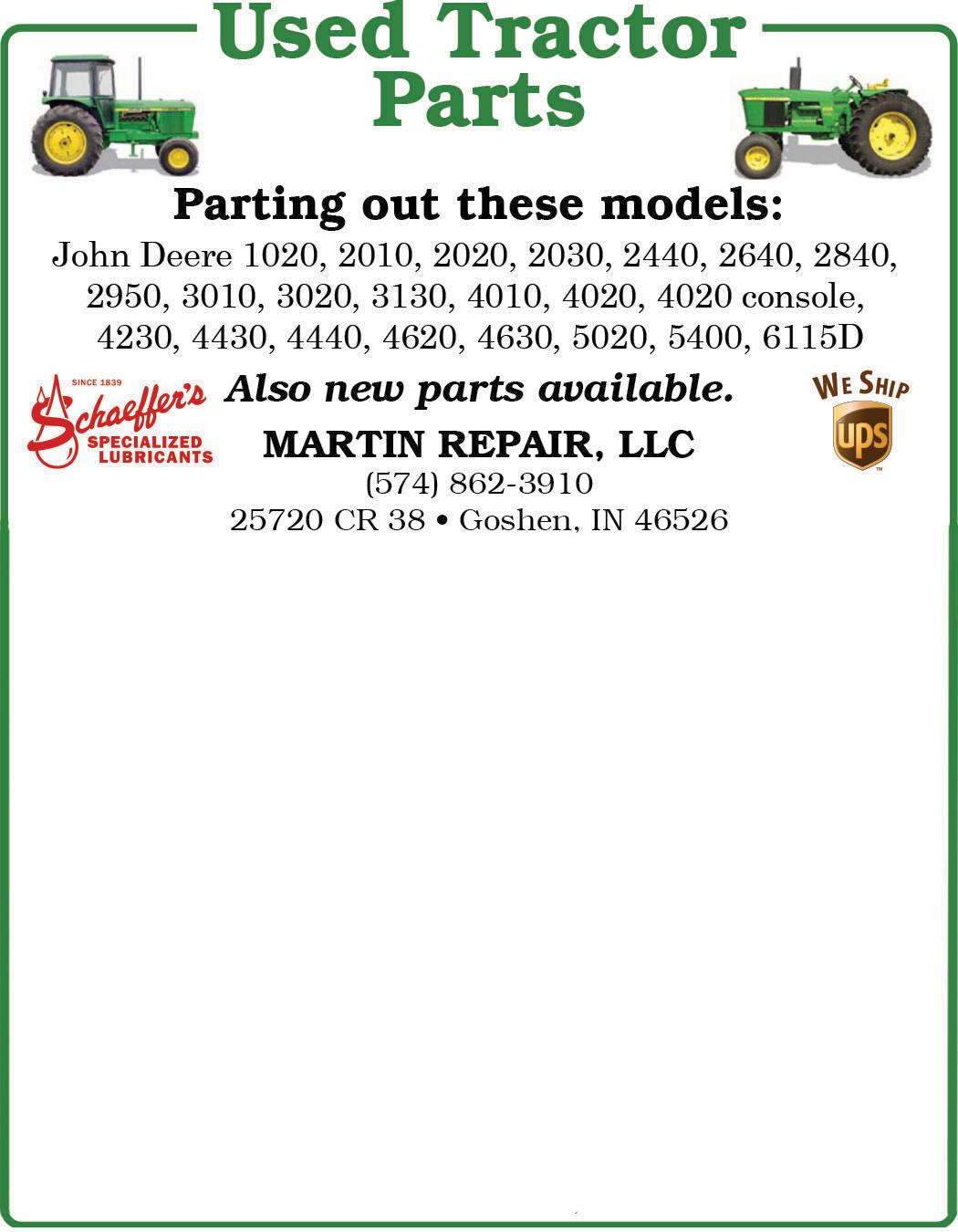
Featuring unstyled tractors Restored and original ‘24 “D” • Exhibit A model “D” and other rare and unusual For info: 503-320-8819 Jake Rens & Sons OPEN HOUSE July 4-5-6, 2024 9 AM - 5 PM CDT Location: 3452 510th Street Orange City, Iowa Call for more information on these tractors 4430 Syncro, running engine PARTING OUT! 4020D, dual remotes, running engine • PARTING OUT! EverGreen EverGreenRestoration Restoration Gauge prices: $65 for oil/amp $80 - $90 for temp, depending on length of the lead Oil, amp and temperature GAUGES with white or black faces for most 2-cylinder models for the unstyled to the 30 series, Waterloo and Dubuque built models Made in the USA • All gauges have real glass • On hand, ready for shipping • Painted, ready to install • Gauges come with mounting clamp and hardware • Faces made by Jorde Decals and have all details of the original gauges • All gauges are calibrated EverGreen Restoration Jerry Trcka W7619 Walnut Dr Spooner, WI 54801 Cell 715-520-7876 tractorgauges@yahoo.com www.evergreengauges.com NEW GENERATION GAUGES now available! RECOVERING ORIGINAL STEERING WHEELS - CALL! Oil, amp and temp gauges available for OTHER BRANDS of antique tractors Page 28 May 2024 • Green Magazine

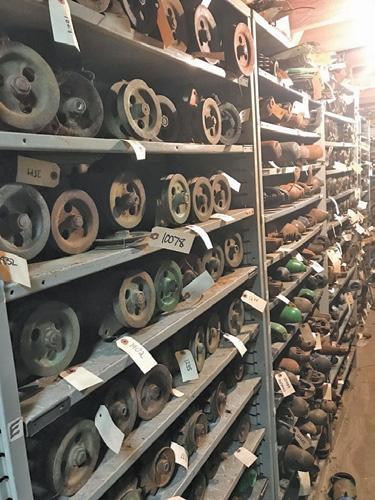
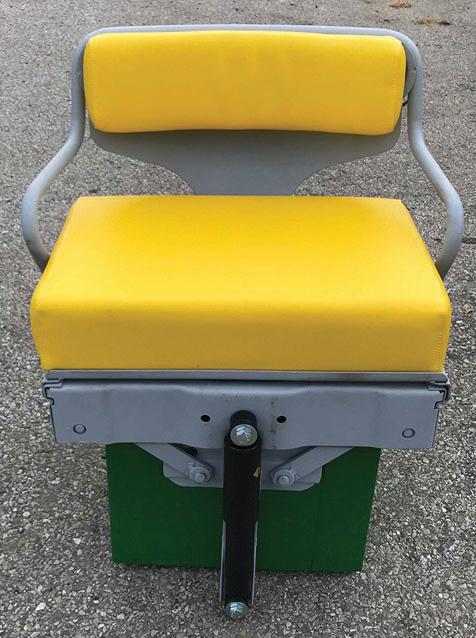
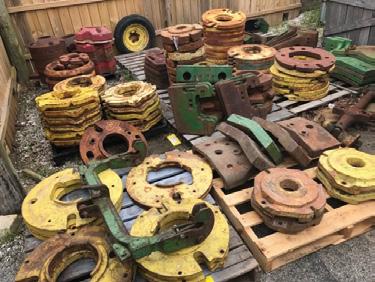

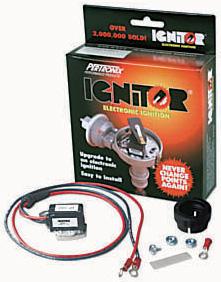
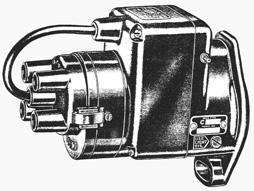
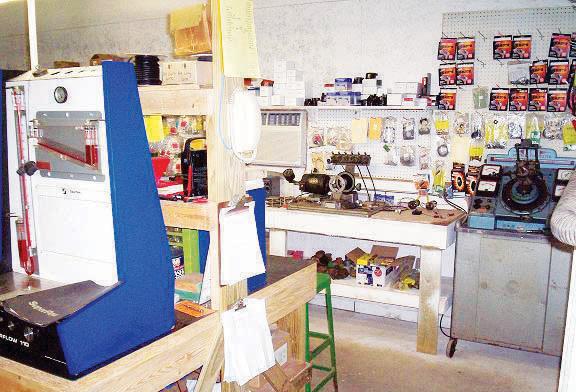
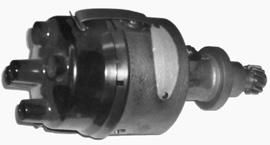
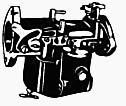

• Used parts include: weights, 3-pts., toplinks, dual hydraulics, float ride seats, clutch parts, hubs, transmission gears, sheet metal, tires and rims, 720-730 ES parts, all-fuel manifolds, brake parts, square and round tube WFEs, heads, blocks and PTO parts.
• New parts include: manifolds, battery boxes, carburetor kits, air stacks, mufflers, grill screens, radiator cores, lights and overhaul kits.
• Rebuilt parts include: Taper-Loc flywheels, electric start conversion kits, float ride seats, starters, carburetors, cleaned and lined gas tanks. Also have crack checked heads and blocks.

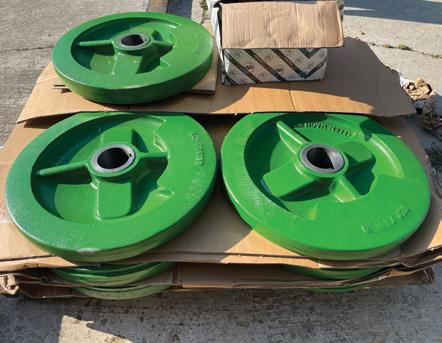
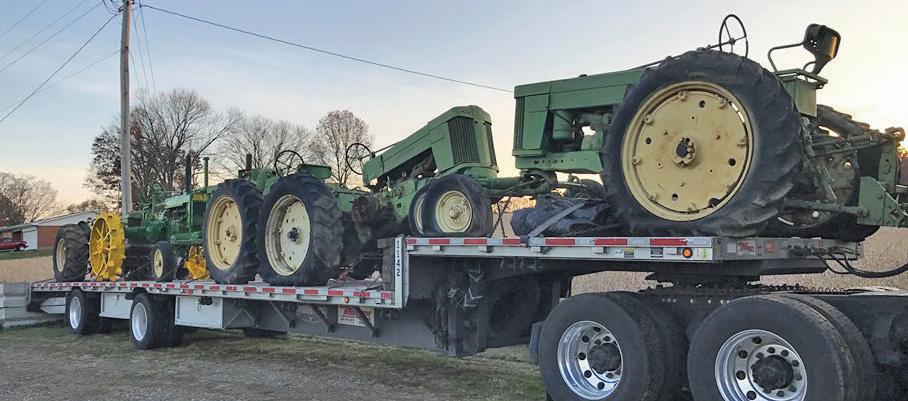
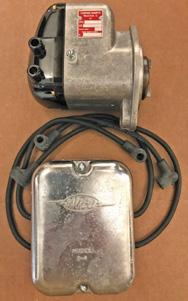


Lind Bros Tractor and Parts, LLC
G, H, M,
330, 40, 420, 430,
720, 730,
820, 830, 3010 3020, 4010, 4020.
• New aftermarket, rebuilt and used parts for JD A, B , D,
R, 320,
50, 520, 530, 60, 620, 630, 70,
80,
Lind Bros Tractors and Parts, LLC 830 Saint Peter’s Church Road SE • Corydon, IN 47112 sales@lindbros.com • www.lindbros.com 812-952-3010 • 833-952-3010 Call or email today! Orders can also be placed online. McDonald Carb & Ignition McDonald Carb & Ignition 1001 Commerce Rd. • Jefferson, GA 30549 Ph. 706-367-4179 info@mcdonaldcarb.com Guaranteed Quality Parts and Service Virtually All Makes and Models Stock or Modified Buy, Sell, Trade Check us out on the web for info and online ordering: www.mcdonaldcarb.com Green Magazine® • May 2024 Page 29

Jumpy clutches on two cylinders
Ever have a two cylinder clutch that wants to jump and grab when you try to engage the clutch smoothly? Ever try to back up to an implement slowly with a jumpy clutch? The cure is often easy, very inexpensive and not very time consuming. Imagine that— something in this hobby that doesn’t cost a ton of money to fix!
Often a clutch that grabs or jumps when engaging is caused by a dirty, sticky clutch. Many times, a good cleaning will cure the problem. There are a few places on a horizontal two cylinder clutch that seem more susceptible to problems than other parts. The horizontal two cylinder clutches are what is commonly called a “dry” clutch. These clutches are designed to operate without lubrication. John Deere designed its tractors to be simple to work on and easy for the average person to repair. The clutch on a horizontal two cylinder is not separated from the engine oil by an oil seal as we know them today. I’m not sure if John Deere engineers did this to keep the design simple or if they felt an oil slinger arrangement would outlast a lip type oil seal. Anyway, nearly every tractor we collect and restore today has been up and down the field more than a couple times, so most of the parts will show wear.
To begin fixing a jumpy, sticky clutch, remove the dust cover on the belt pulley. Next remove the cotter pins from the three adjusting nuts and remove the adjusting nuts. Pull the pressure plate off the three clutch bolts. Now remove the first clutch disc
and set it on the pressure plate in the same position as it was on the tractor. This practice is just good common sense and makes assembly a lot easier.
On some two cylinder tractors, there is another disc splined to the main drive disc with a second clutch disc behind it. This disc just slides off without a puller.
Now inspect the drive disc and crankshaft for timing marks. There should be a “V” on the drive disc and one on the crankshaft pointing at each other. It is strongly advised to find these timing marks before you pull the drive disc off. If you can’t find any timing marks, make your own. The drive disc is counter weighted for engine balance and must be timed correctly to prevent engine vibrations. Now you can pull the drive disc off. This will require a puller. I have made a puller out of scrap iron for several two cylinder tractors. They are nothing special. The drive disc and crankshaft are a tapered spline so once you get the drive disc to budge, it will come easily. With the main drive disc removed, remove the last clutch disc from inside the belt pulley.
Pull the pin that connects the hand clutch lever to the pulley brake. Then remove the clutch fork assembly by removing the four bolts that hold it to the reduction gear cover. Pull the clutch fork assembly forward to remove it from the tractor. Inspect the clutch fork for wear and replace if worn more than 25 percent.
With the clutch fork assembly removed, you can slide the belt pul-
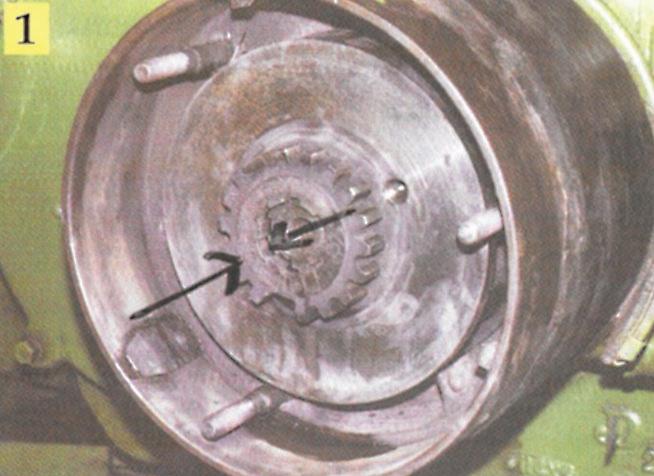
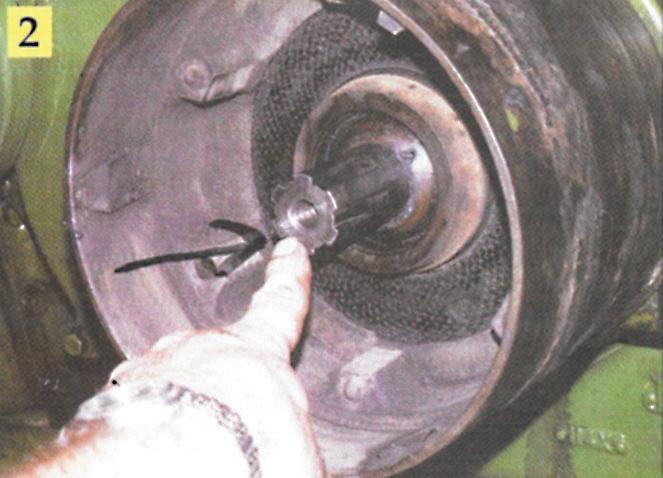
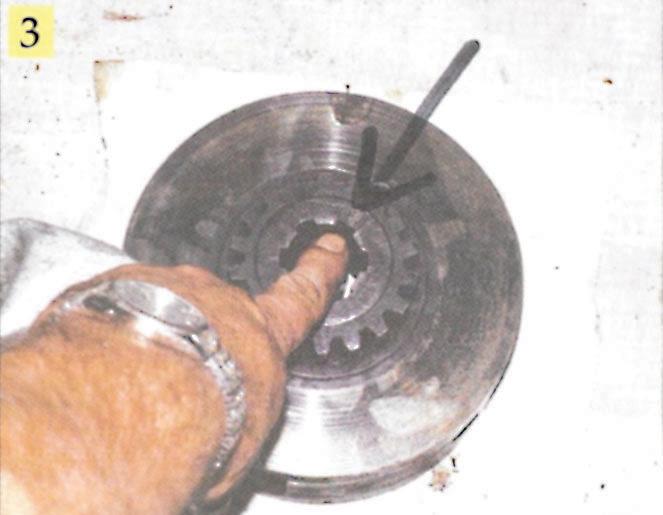
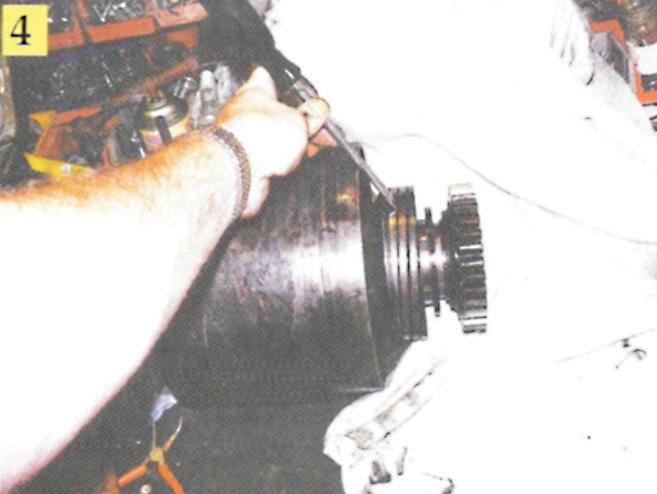
Page 30 May 2024 • Green Magazine
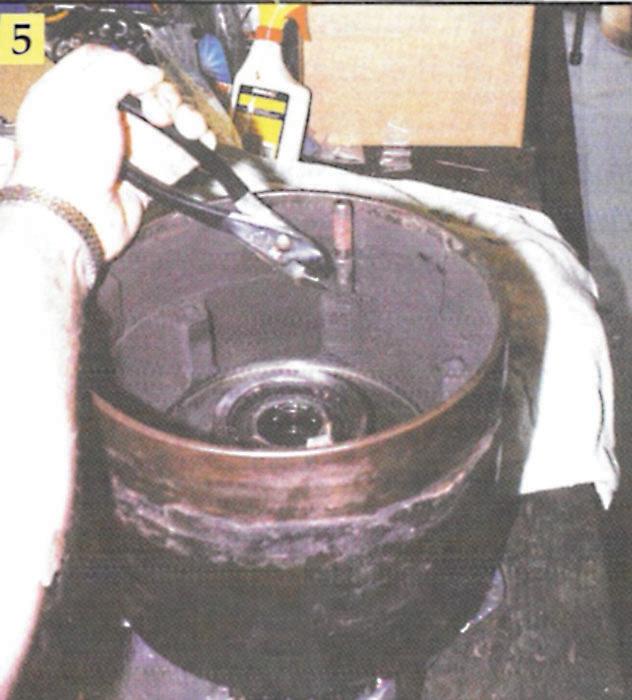

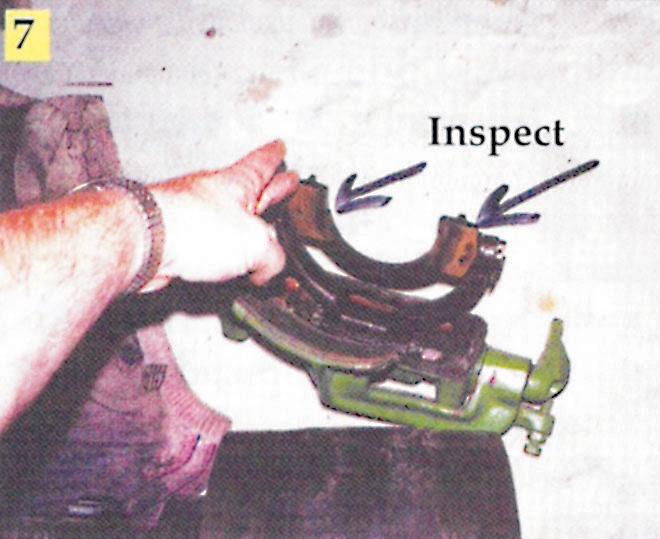
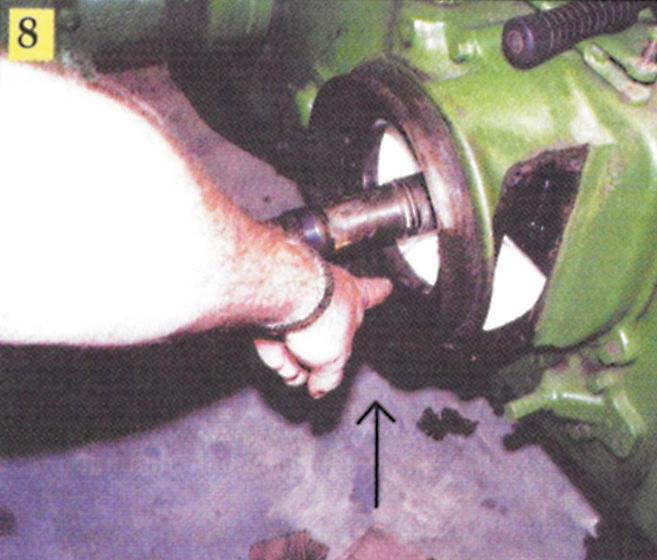
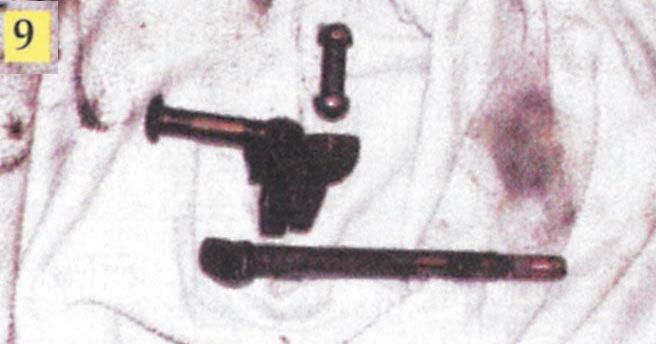
ley off the crankshaft. Belt pulleys are heavy little critters, so be careful if you have back problems like me. Place the belt pulley on a sturdy bench and remove the cotter pins from the three clutch bolts. Push the three clutch bolts out the back side of the pulley. If the bolts appear worn to the point the bolt diameter has been reduced at all, replace the bolts. This is one area of a two cylinder clutch that will receive a fair amount of wear. This is also one of the areas of the two cylinder clutch that can give you a jumpy clutch or one that grabs and, in a few cases, I have seen them sticky enough that the clutch will not release or disengage. Place a rag inside the center hole of the pulley to keep dirt from getting in the main clutch bearing. Thoroughly clean and buff these three bolts and the holes they came out of. Oil vapors and clutch dust tend to collect on these bolts and fill the holes they slide in. These three bolts must move freely in the holes they came out of. Coat these three bolts with a very light coating of Never Seize before reinstalling. If you want to inspect the “dog bones,” you can turn the pulley over and remove the cotter pins holding the bell crank levers and pivot pins in place. These parts do not wear as rapidly as other clutch parts and are often in good condition. Before reinstalling, put a light coating of Never Seize or good grease on these parts before reassembly.
Spray the inside area of the belt pulley with brake cleaner and wire brush the gummy areas. Oil vapors and clutch dust make a very sticky mess so expect to spend a little time cleaning up the inside of the belt pulley. Clutch dust may actually contain asbestos fibers so refrain from using compressed air to blow out the dust, but rather wash it out with brake cleaner.
Inspect the oil slinger area of the pulley to make sure none of the oil grooves are filled in. Next check the bottom oil drain hole in the reduction gear cover. In theory, if oil gets past the oil slinger, it is to exit this hole and drip on the ground (don’t mention this design to any “tree huggers”). Often
times, this area is caked with crud and needs a good cleaning.
Spray the clutch discs with brake cleaner and sometimes I will lightly sand them with 320 grit sand paper to remove glazing. There are wire strands in the clutch facing so sand with caution. Having dry clutch discs is critical to having a smooth clutch. The clutch disc located behind the main drive disc is the most susceptible to become oil soaked. If you get a real oily one, your best bet is to replace it. Clutch discs are not that expensive and would be a good investment.
Using a good quality solvent, flush and clean the roller bearing in the center of the belt pulley. This bearing and the brass bushing spin on the crankshaft when the engine is running with the clutch disengaged. For those who leave their tractor run with the clutch disengaged, you are putting unnecessary wear on these bearings. After cleaning and drying, pack the roller bearing with a high quality, high temperature grease and put a light coating of grease on the brass bushing.
Now you are ready to reassemble the belt pulley. Use new cotter pins when reassembling. The final step will be adjusting the clutch by tightening the nuts evenly that hold the pressure plate against the drive disc. Tighten the nuts evenly to assure the pressure plate contacts the drive disc evenly. When the clutch is adjusted correctly, you will hear a sharp “snap” when the clutch is engaged and disengaged. The manual says it should take about 80 pounds of force to engage and disengage the clutch. If you have young people drive your tractors, or people without a lot of physical strength, you do not need to adjust the clutch that tightly. It will work just fine if it is not adjusted to the 80 pounds stated in the manual.
This article first appeared in the January 2002 issue of Green Magazine.
Contact Dan Brotzman at W14729 Meisner Rd., Tigerton, WI 54486; phone 715-535-2595; email danb4230hc@yahoo.com.
Green Magazine® • May 2024 Page 31

John Deere 1929 “GP”
Serial number 202042
Warehouse date:
8 December 1928
Ship date:
8 December 1928
Branch: Lansing, Michigan
Destination: Hastings, Michigan
Purchased from Larry Darling in Hartford, Michigan on 2 October 2020 for $5,000
Hi, I’m Eric Sherman from Louisville, Kentucky and I’ve been a lifelong John Deere enthusiast. I have an “O” scale John Deere train layout, two ice cream makers (five gallon and two quart), 1973 Weekend Freedom Machine 70, 1955 70 diesel standard, and the reason I’m writing to Green Magazine, a 1929 “GP.”
To begin, I grew up in Eaton Rapids, Michigan, graduating from high school in 1990. Shortly after graduation, I joined the United States Air Force, serving 21 years as a jet engine mechanic and flight engineer. Side note: my son graduated Space Force Basic Training this past December 2023 and is currently learning how to be a geospatial intelligence analyst.
Onto the story:
So, this 1928/1929 JD “GP”

has been in my life since 1982 at the ripe ol’ age of 11. My dad and all his John Deere buddies used to attend tractor shows in Michigan (Buckley, Delton, Hastings, Mason, and Oakley). Starting in 1982, we would start the tractor show season at Charlton Park, located in Hastings. At that show, they would fill everyone’s gas tank and have a wonderful parade through all the old buildings (like a town square), located next to Thornapple River.
During the time of 1982 until 1990, I so looked forward to summer vacation from school and visiting all of those tractor shows again! I remember Sam Scobey bringing his beautifully restored electric start 830 diesel, Danny Crane and his son, Daniel, would bring a standard and wide tread “GP,” Larry Darling would bring his beautifully restored “H,” Gordy Bridleman would bring the standard “GP” that this whole story is about, and, lastly, my dad
My first words were, “Is it for sale?”
Next was the Michigan Steam Engine and Threshers Club in Mason. Back then, a big metal sled was used to flatten the roadway at the show by using one tractor to pull the sled, while the other tractor would drive onto it. The Mason show even had a big steam crane that ran on compressed air due to the boiler being too rusted out. I remember going to Prairieville Old Fashion Farm Days in Delton and watching tractor pulls and people trying to catch chickens and oiled down pigs. I don’t remember Buckley and Oakley too much since they were far away and we wouldn’t take any tractors.
and I would bring a 1935 “D” and a 1938 “L.”
Fast forward to August 2020— almost all my dad’s tractor buddies had long since passed, except for Larry Darling of Hartford, Michigan. One day, I wondered if I could find anything on the internet about Larry or to see if he was still alive and well. After some searching, sure enough, I found he still has his business selling used automobiles and that there was a phone number listed. At this point, I had no idea Larry had Gordy’s old “GP;” I just wanted to see how he was doing since it had been more than 30 years since the whole gang was together
Page 32 May 2024 • Green Magazine
at a tractor show and ask him if he remembered any history on the 1908 4-1/2 horsepower hit and miss Waterloo Boy he sold my dad back in the late 1980s.
After talking to Larry about the good old days and letting him know about my Air Force career and my own family, Gordy’s “GP” was brought up again and this time Larry said, “Eric, I have Gordy’s ‘GP’.”
My first words were, “Is it for sale?”
many old John Deeres, she came to life once again! We could not believe how well the “GP” was running, considering the amount of time she sat in the barn. Not knowing if my luck would run out, I quickly drove the standard “GP” up on the trailer and quickly learned the front tires are much narrower than the rear tires. So glad I kept the clutch engaged and just went for it. Once the “GP” was chained down, the check was written, goodbyes were said and I headed five hours south
amount of help you can get today when doing a John Deere restoration due to the internet. Growing up, you had to use Mother Deere, a tractor show, magazines, or word of mouth to find parts.
By July 2023, I had the opportunity to take Gordy’s “GP” back to the Charlton Park and Mason tractor shows to once again relive my childhood memories. I truly believe Gordy was smiling down from heaven! We also had the “GP” and my two ice cream makers at the Classic Green show in Lebanon, Tennessee (there is video of me in the parade).
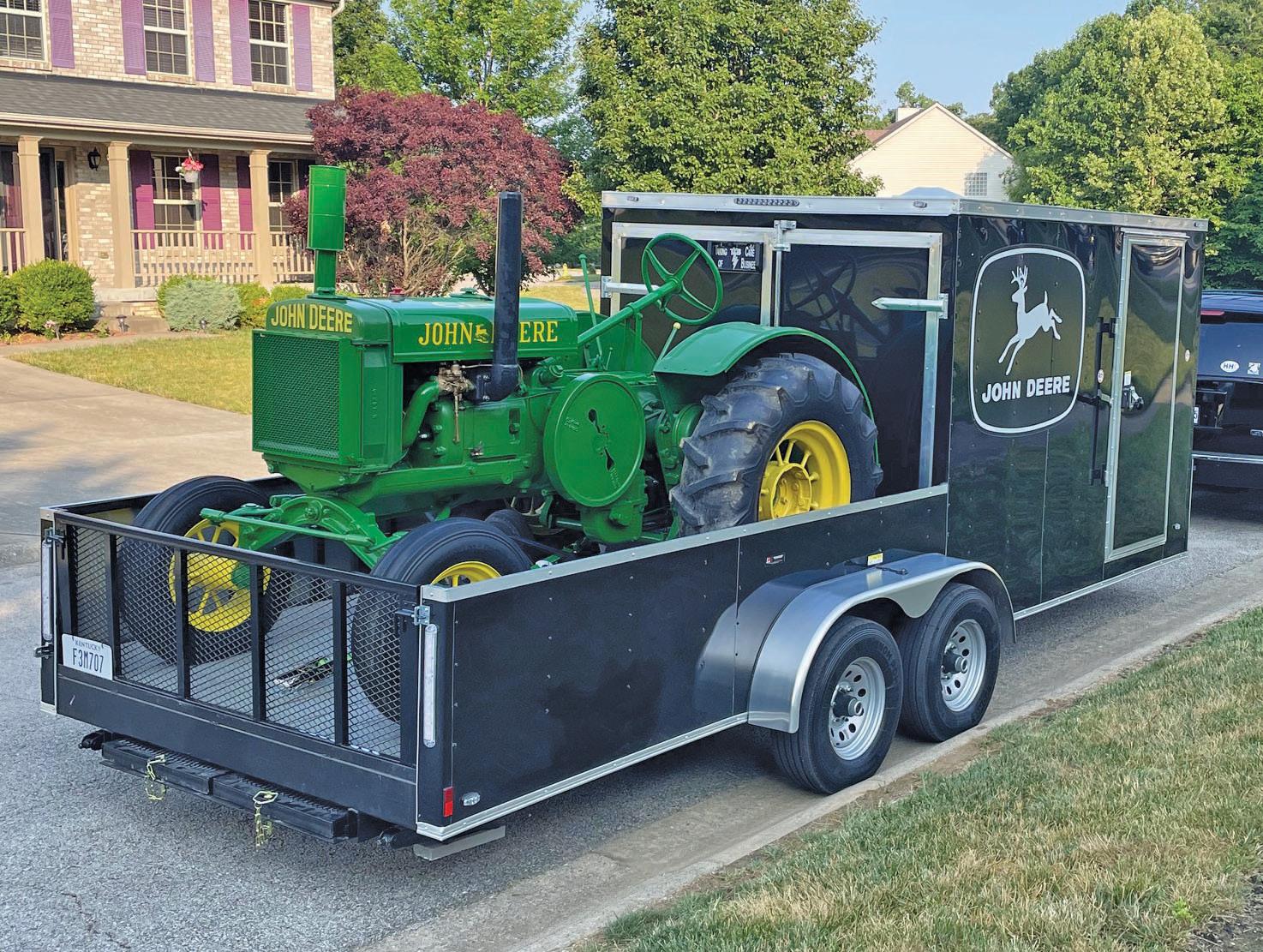
Larry and I agreed on a price and on October 2, 2020, I drove from Louisville, Kentucky to Hartford, Michigan and bought Gordy’s “GP”!
The “GP” had not run since the year after Gordy passed away in 1993. I had to file the points, run a new rubber fuel line from fuel tank to the Ensign carburetor and have Larry give me a tug and, like so

back to Louisville, Kentucky, arriving about 11:30 at night. What a long day that was!
I spent two years fixing so many worn/broken items on the old “GP.” Without the help of my tractor buddies, the “GP” Facebook page, Mother Deere and the Lind Brothers, I have no idea if the old girl would be running today. It is incredible the
A little background about Gordy Bridleman and the 1928 “GP” from Hastings, Michigan. Gordy passed away in 1993 of a heart issue at the age 55. We all loved Gordy; he was an architect by profession and would do drawings to make heavy duty tri-axle trailers for pulling all of our toys to the show back in the day. As a little guy, I would stay with Gordy in his canvas tent during the shows. I sure wished those days would have never ended. Being around Gordy and all my dad’s tractor buddies sure made some incredible childhood memories.
The “GP” was originally on steel wheels and restored in the early ‘80s. By 1984, Gordy had converted the “GP” over to rubber wheels using cut downs on the front and F&H on the rear. I remember riding on the “GP” when it was steel wheels and wondering why would Gordy not have rubber tires—this thing is rough!
Submitted by, Eric
Sherman
Louisville, KY
Green Magazine® • May 2024 Page 33
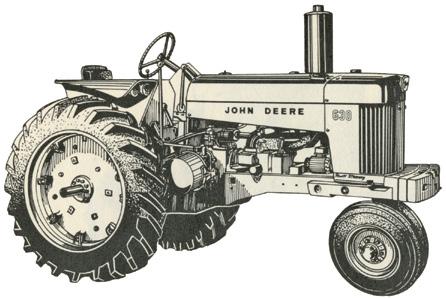
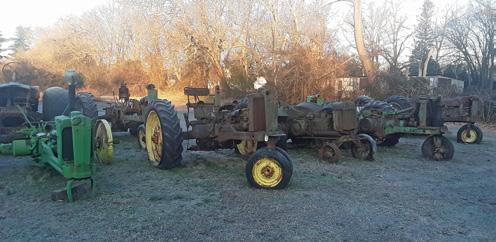
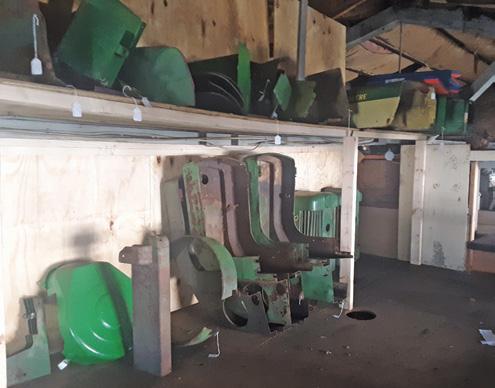
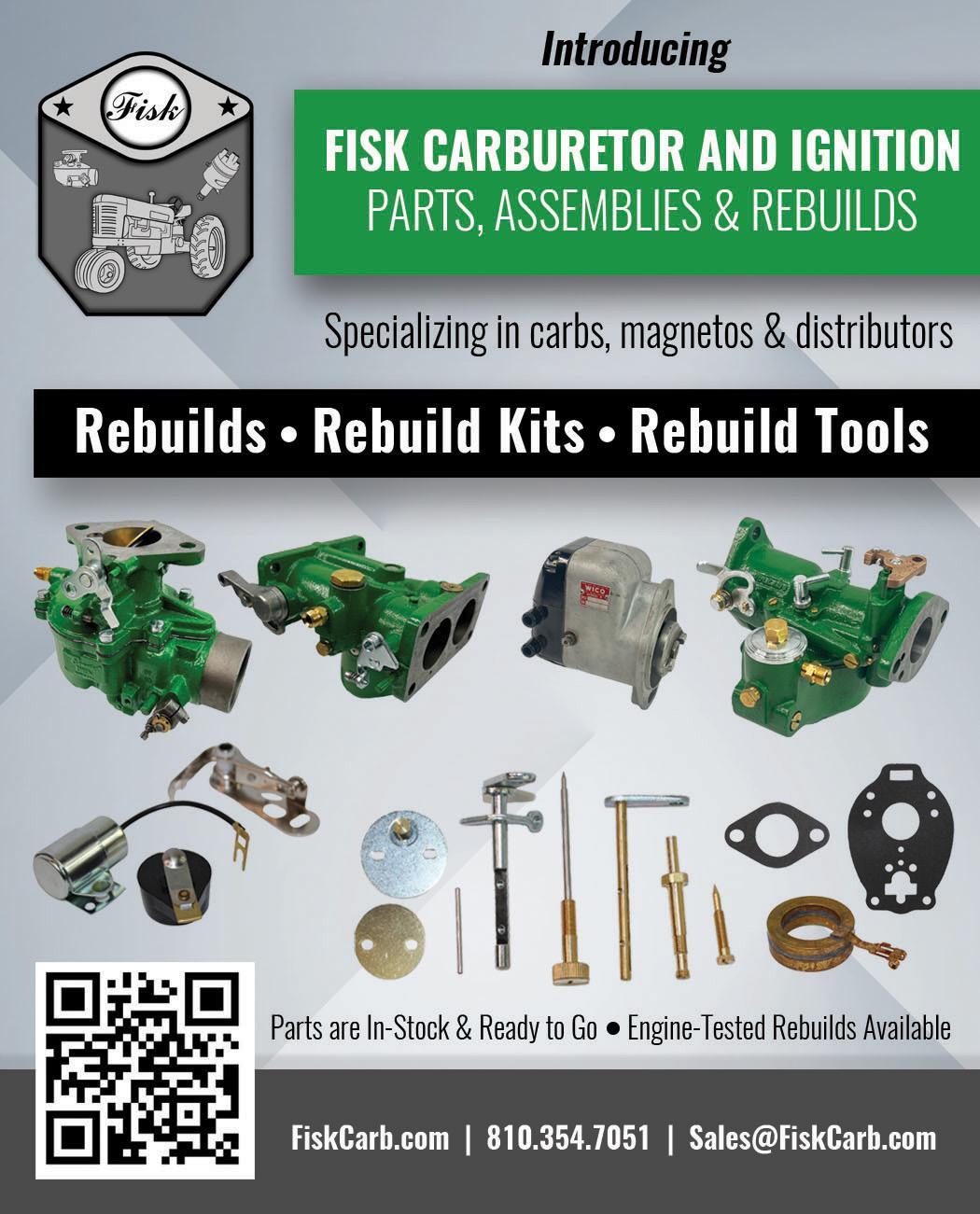
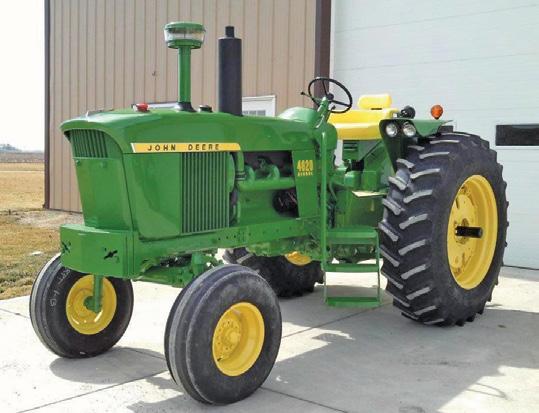
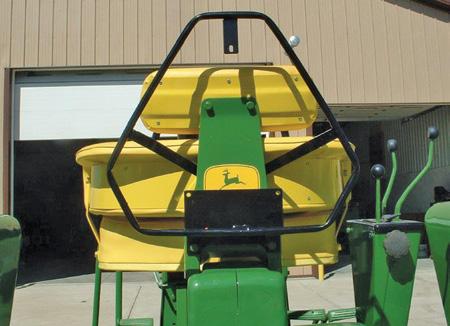
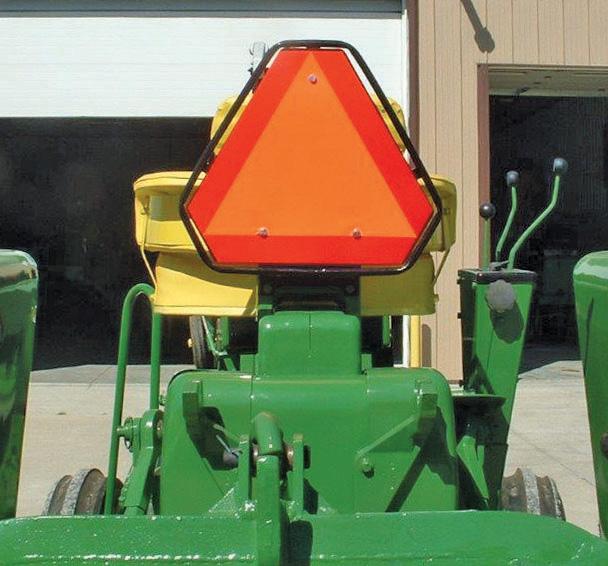
A&L Parts NEW, USED & REBUILT 2 CYLINDER PARTS Hundreds of tractors parted: Wide fronts, 3-point, carbs, starters, etc. • NOS parts MODELS A THROUGH 730 A&L PARTS 432 N. Flat Street • Penn Yan, NY 14527 Phone 315-536-0543 • We ship DAILY • Major credit cards accepted NEW PISTON KITS and RADIATOR CORES SMV emblem support bracket - K&K Antique Tractors K & K Antique Tractors Kent Kaster • 5995 N. 100 W, Shelbyville, IN 46176 Phone 317-398-9883 Website: www.kkantiquetractors.com • Email: info@kkantiquetractors.com A v A il A ble P A rts in s tock * Complete battery tray assembly Headlights Fenders * Step kit * Gauges Radiator core * Safety plate * Front & rear side panels Hydraulic outlet plugs * Raincap for late side console * Nameplates $245 per set * Decals Hood ornament Pre-cleaner bowl * 3-piece seat kit * Battery boxes * Rockshaft covers Fuel cap & radiator cap Steering wheels & centers * Side & front grille screens Order today! NEW ITEM * SMV Emblem Support * Original part number AR46282 * Selling bracket ONLY * Made in USA Lakeside Service & Supply Lakeside Service & Supply New and Used Parts for Vintage JD Two Cylinder Tractors We ship parts daily! 325 S. Main Street • Elmer, NJ 08318 856-358-2444 deereblaze@verizon.net Like us on Facebook! Visa/Mastercard/Paypal accepted Page 34 May 2024 • Green Magazine

Martin Parts & Repair
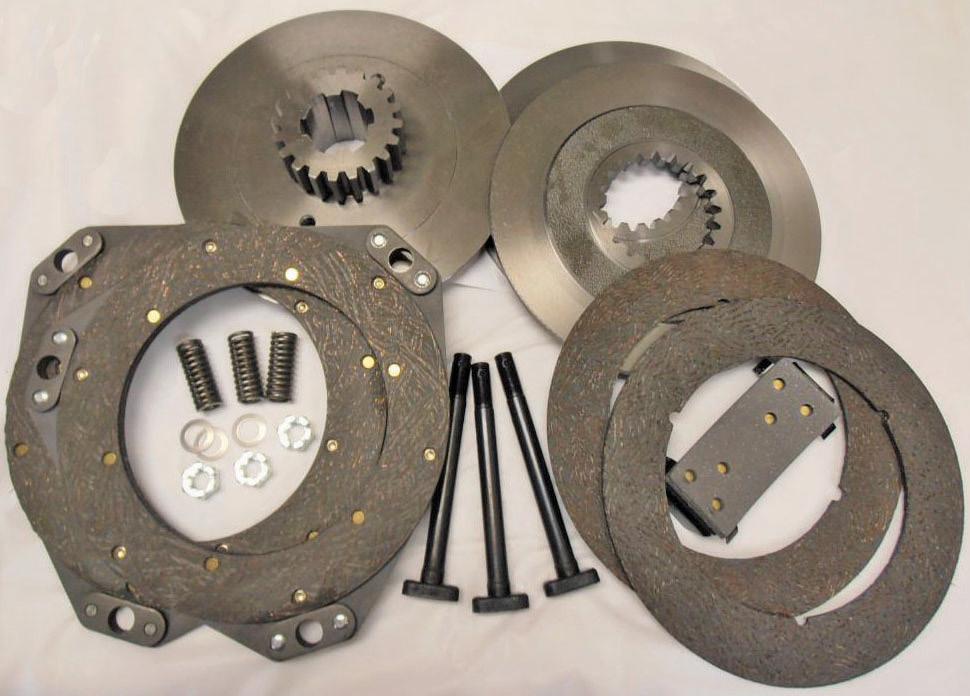
Complete clutch rebuild kits and clutch lining kits
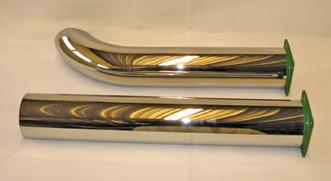
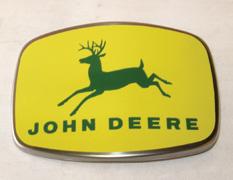
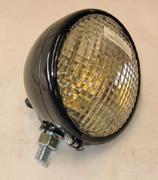
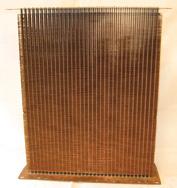
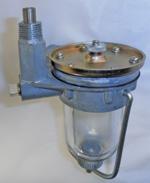


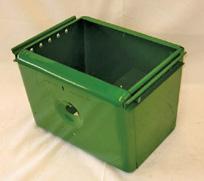
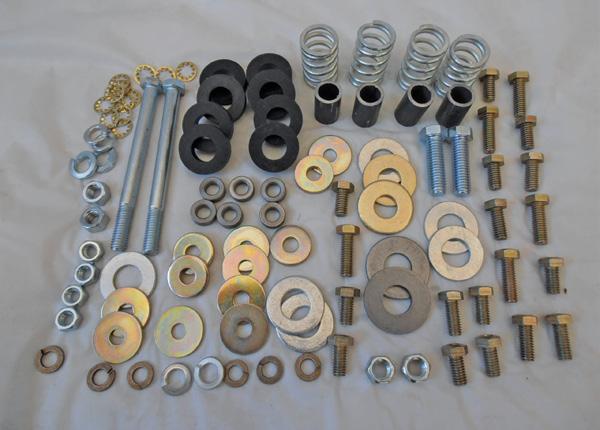
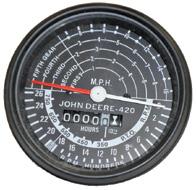
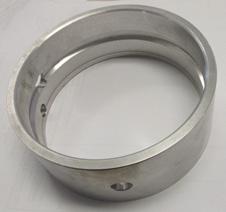
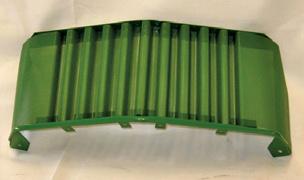
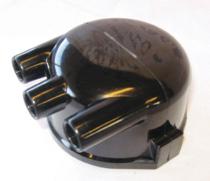

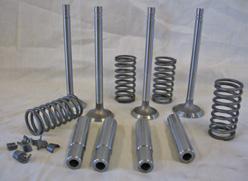

PARTS TRACTORS
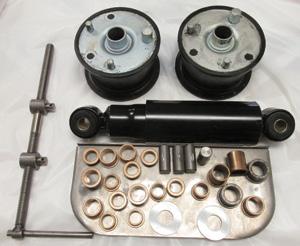
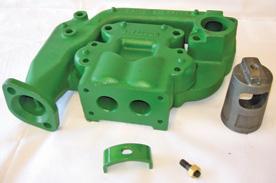
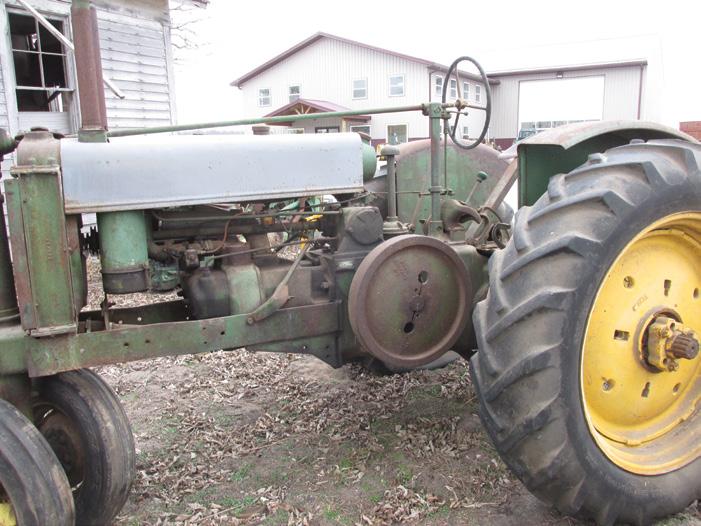
5020, Unstyled G, 430T, 2510 gas, 730 LP, 2010D, 530, Late 520, ’39 B, BN, 40U, ’53 AO, ’41 H, ‘46 A, late A’s, ‘46 B, late Bs, slant dash B, unstyled B, sty. D, G, unstyled L, M, MT, R, 40T, 40U, 40W, 70D std., 70G, 420U, 420W, 440 w/reverser and power steering, 440 gas, early & late 50s, early 60, 60 w/power block, 620, 620 LP, 630, 630 single front, 70G, 720G, 720 LP, 720D pony, 730D, 730G, 820, 1010, 2010, 2010D, 2010RU, 2020, 3010D, 3020, 4020D. Most of these tractors are parted out & on the shelf—ready for quick shipment!
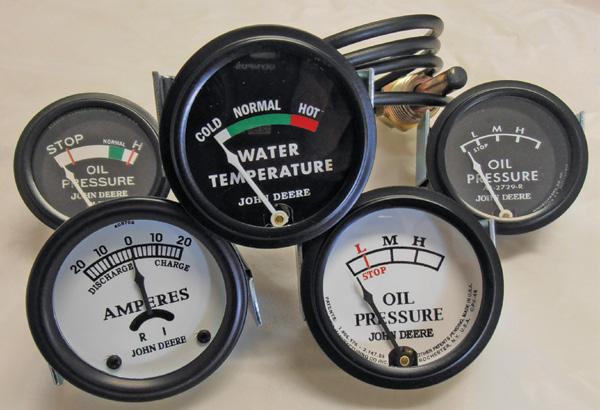
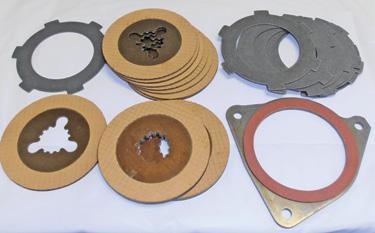

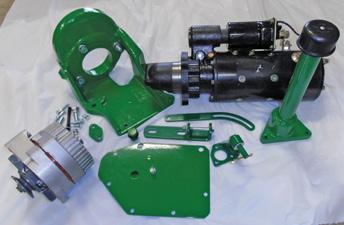
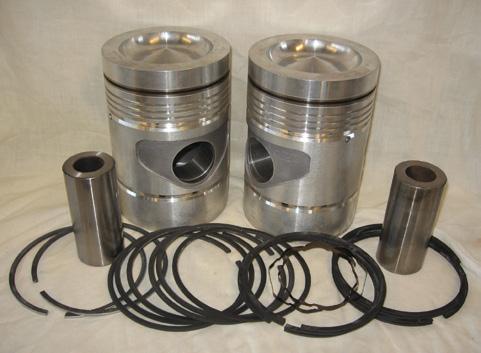
Oversize pistons available again for many two cylinder tractors

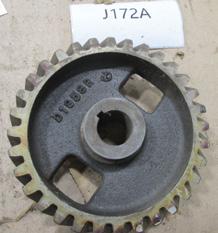
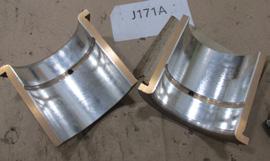
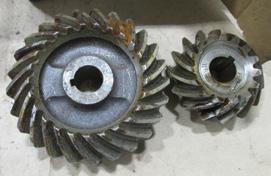




Radiator
water
kits Emblems Chrome stacks Ignition parts Lights & light parts Battery boxes Fuel sediment bowls Valve train parts & kits Manifolds & exhaust pipes
kits Seats and seat parts Grill screens
cores,
pumps, bolt
Gasket
Electric start kits
cables
Tachometers and
rebuild parts SUPPLYING PARTS for your CLASSIC JOHN DEERE NEW & USED • IN STOCK • READY TO SHIP
with all your parts & restoration needs or for a FREE CATALOG PTO clutch kits & parts Full round main bearings for 2 cylinder tractors Sheet metal bolt kits Wide front parts Complete carburetors, kits and parts 7487 E. 450 N. • Rochester, IN 46975 574-598-6083 • 844-720-2510 Email: sales@martinparts.net Now stocking USA MADE GAUGES LOTS OF NOS PARTS Email for a price list Unstyled G #6221 5020 serial 019483, hood available
Brake
Call or e-mail
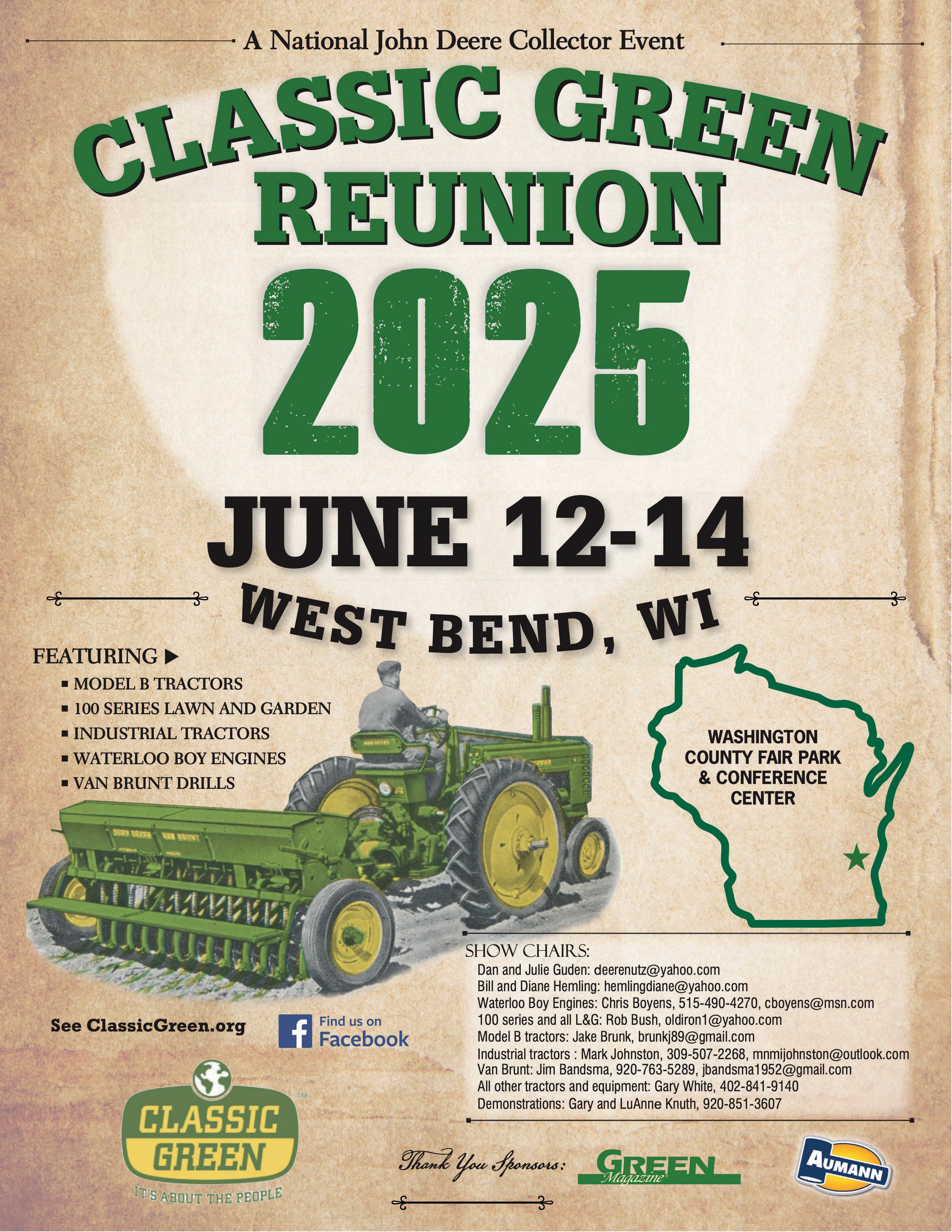
Green Magazine® • May 2024 Page 37

Right: Not sure how this guy could see where he was going, but he used the tanks to apply liquid nitrogen when plowing, insecticide when planting and 2,4-D when cultivating—from a 1955 Capper’s Farmer magazine.
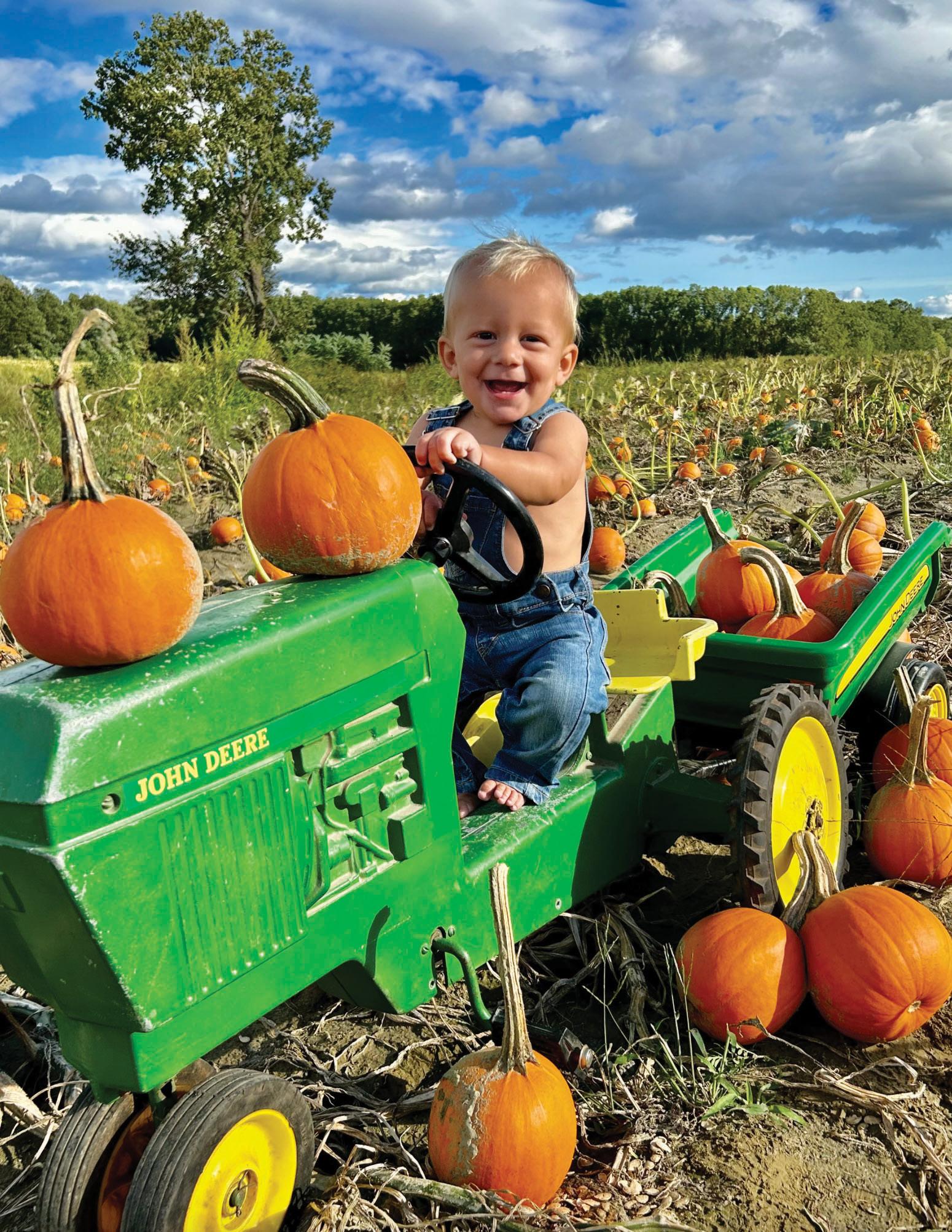


 Right: Edward Galenski, fourth generation farmer on Galenski Farm, helping to harvest sugar pumpkins.
Ben Kramer’s 1936 “B.”
Right: Edward Galenski, fourth generation farmer on Galenski Farm, helping to harvest sugar pumpkins.
Ben Kramer’s 1936 “B.”
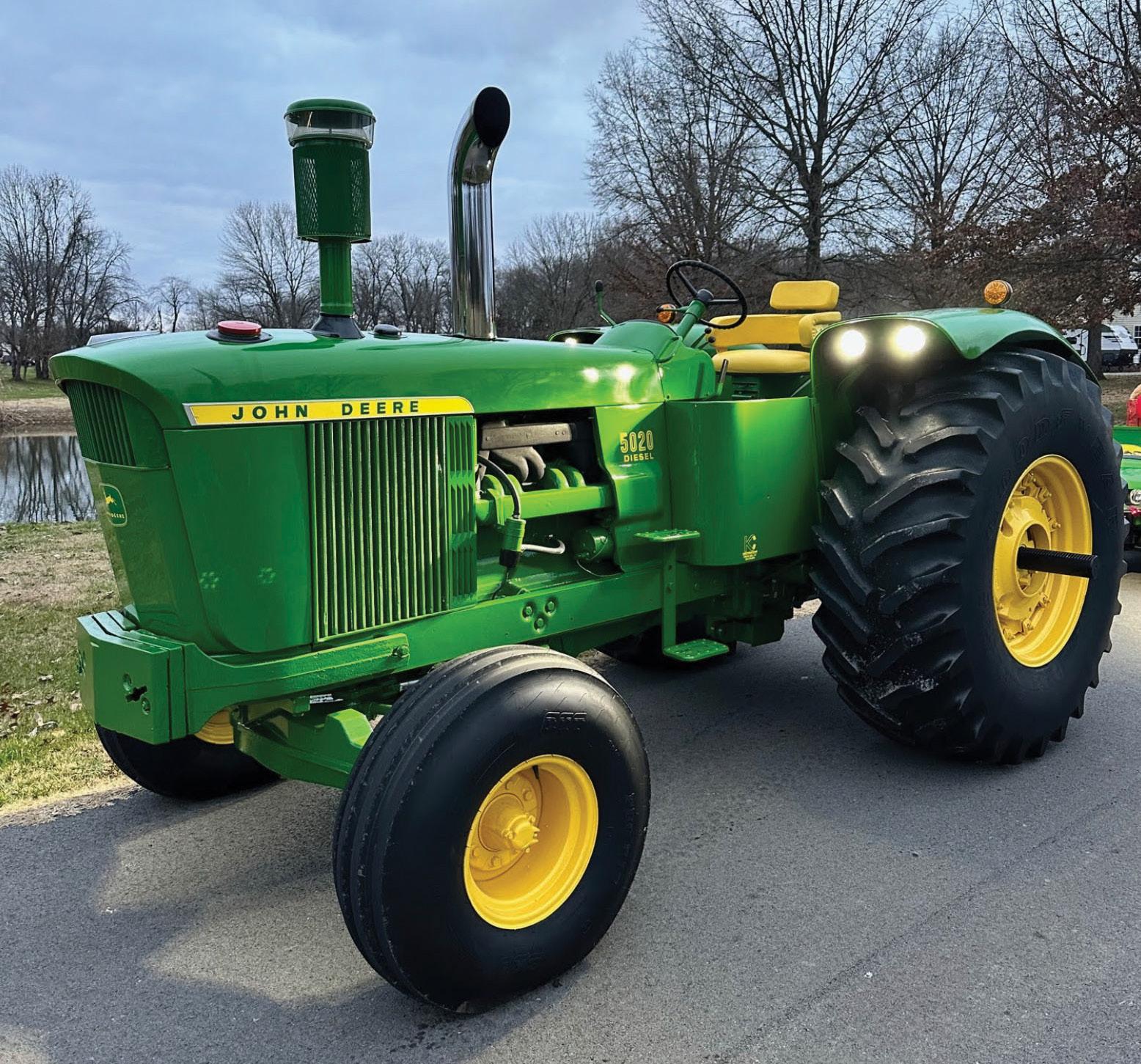

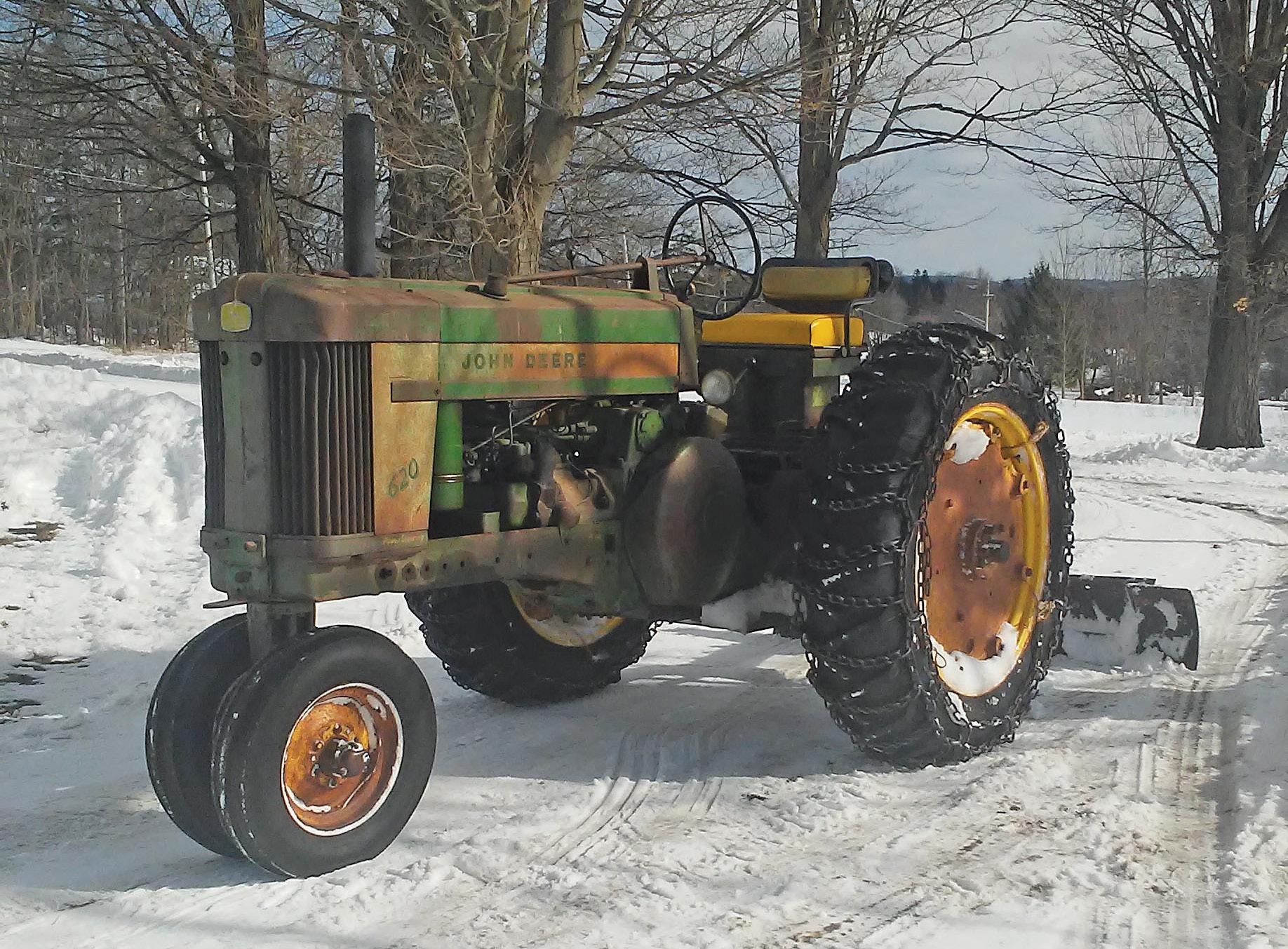
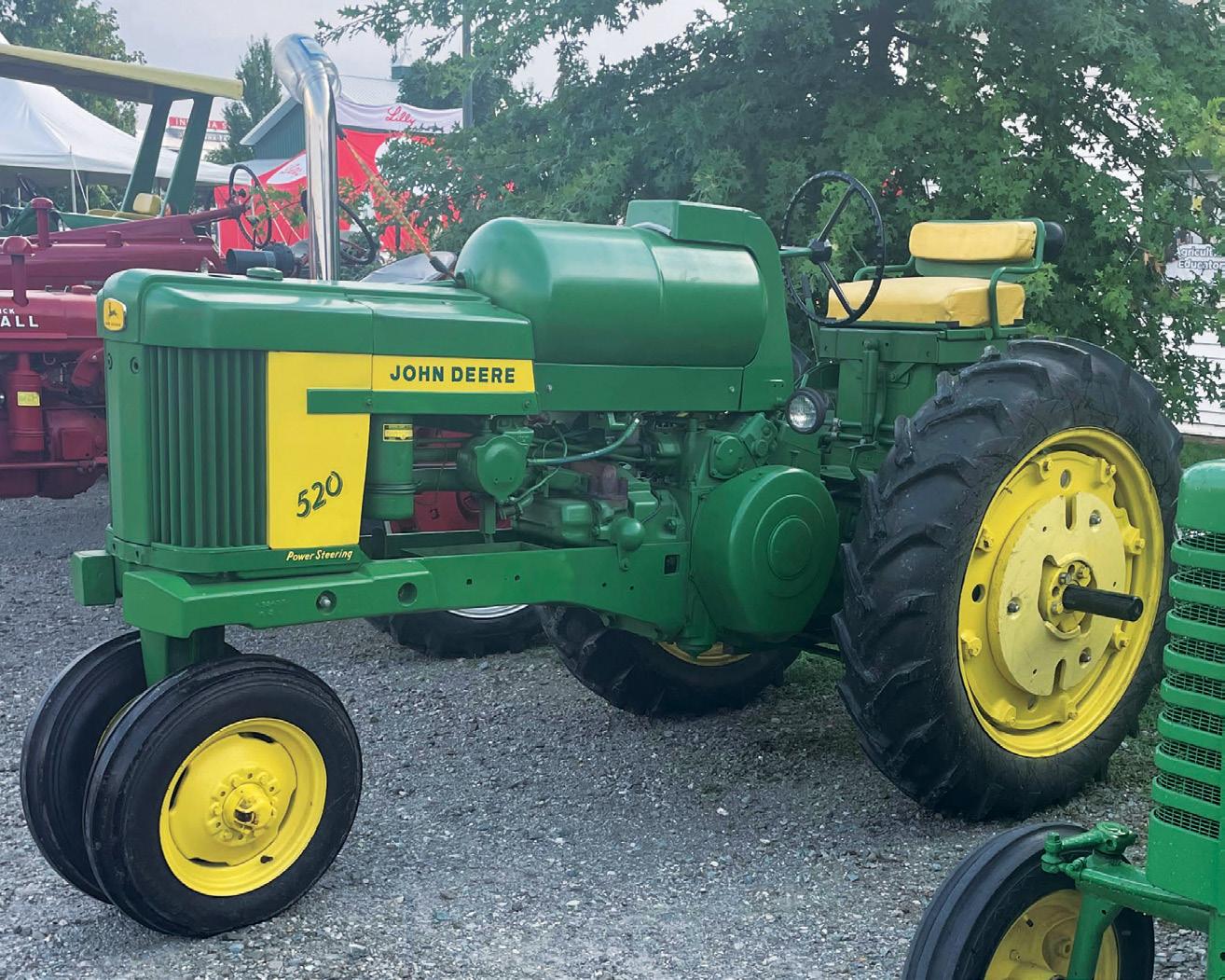

Left: Here is Joe Huey’s original 620 plowing snow in Skaneateles, New York. It joined the farm in 1967 and is very dependable starting in cold weather!
Left: Willis Jepson’s 5020.
Wayne Homsher shared this photo of his John Deere 520 LP.
Green Magazine® • May 2024 Page 39


This month we are going to talk about a neat little pamphlet that Deere issued in 1976. This is also the same year we bought our dealership. There used to be a few of these around the dealership, no doubt leftovers, until over the years, they disappeared. I had kept one somewhere but, as usual, had no idea where it was so when this one became available online, I picked it up. I think the equipment it covers is prime time Deere and is very interesting. We will also take a quick look at the value today of some of these items, you may be surprised. Let us take a look at it.
The logo in Photo 1 really stands out, doesn’t it? What is going on with all these pictures? The first item in the upper left hand corner is a pair of John Deere D cell batteries. Deere dealers today can still stock D cell batteries but there is an important difference. When this picture was taken, the batteries were Deere labeled. Deere stopped this quite a few years ago, no doubt it saved a fraction of a penny. What you would receive today if you were to buy one would be a battery with whoever made its logo and printing on it. Think Eveready, Duracell and the like. Deere just slaps a parts label on it and sells it. Deere no longer has many of their items privately labeled.
Chemicals, for example. Time was if you bought a tube of John Deere silicone sealer, the tube it came in carried John Deere labeling and a logo. I am certain once again it is an issue of cost, but a side effect of this
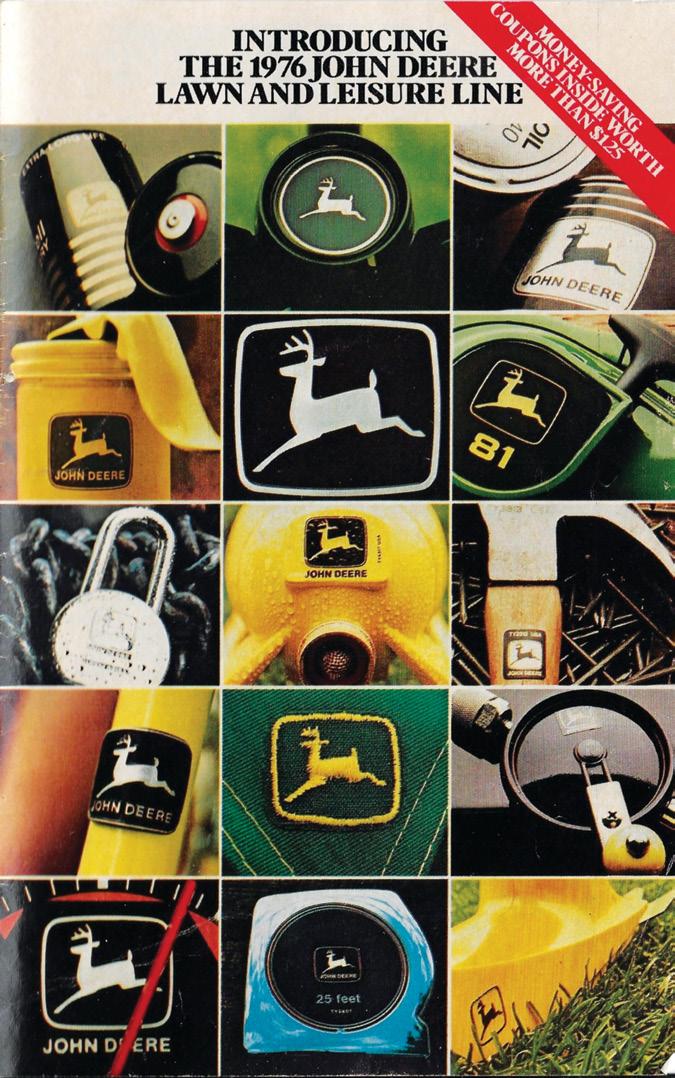
policy is that these items are no longer of interest to collectors. Who wants a tube of LocTite sealant with no Deere logo in their John Deere collection? For example, if you were to find a pair of these batteries today, they would be collectible as they are John Deere branded. Dead? Well, yes, they are but do not toss them out. It turns out these are very difficult to locate today, and I have only seen one or two come up over the years. The last one I saw sold for around $35. For one dead battery. But wait! There is more! There is an even earlier style of battery and
I have never seen one other than the one I have. Factor in also that, besides the D cell, there were AA, C, nine-volt batteries and even lantern batteries and you now have an impossible task ahead of you gathering them all up. I hope someone somewhere has already done this and I would love to see them if they have.
The second item is, I believe, a steering wheel emblem. The third is two cans of John Deere TorqGard engine oil. Now, these are different also. No plastic bottle! Yes, these are the older style cans of oil so you better be busting out your John Deere oil can spout and opener to get into these beauties. There are also many variations of oil in these cans, and I have seen them bring $8 to $20 each, depending on what the can is. The larger cans bring more usually and if it is a sought after can it will bring unreal amounts. The older cans are sought out by collectors so be forewarned. The fourth is a John Deere handheld oil can. At one time, we had three or four of these yellow cans in our shop. They have also become difficult to locate and are now collectible. There is also the same oil can in green paint with the old four legged deer logo on them and also a larger size of oil can. The really old oil cans—I am talking from the 1930s and 1940s—came in different colors with the dealer’s name on them. They are all highly collectible. Some of the colors have sold for $500 or more each.
Page 40 May 2024 • Green Magazine
Photo 1
The fifth one is a logo; I believe it is off the front grille of a lawn tractor. The sixth is the recoil starter housing of a John Deere green chainsaw. The seventh is the heavy duty chrome padlock Deere used to offer. It was a really nice heavy padlock and the chrome finish on it made it an instant collectible. The eighth is a John Deere lawn sprinkler. There were several versions of sprinklers, all tough to find today. One in its original box recently sold for $150. The ninth is a John Deere wood handled hammer, from the line of carpentry tools Deere offered at one time. The tenth is the head stock of a John Deere bicycle painted in the color Sunshine Yellow. Bicycles are gaining ground in the collector world and are now fairly collectible. They also have their own group on Facebook now with a growing list of members.
The eleventh is the logo of either a cap or better yet, a jacket. The twelfth is a John Deere hand drill, again from Deere’s carpentry tools. The thirteenth, I am not certain. I believe it is a gauge from a generator possibly. Sorry, this one eludes me. The fourteenth is a tape measure. This one is collectible already and if in good condition with minimal scratching, it can bring around $100. There are also other sizes of tape measures to seek out to collect. The fifteenth and final item is from a John Deere grass trimmer.
Picture 2 starts off “When you see the “Leaping Deer,’ think of John Deere and a reputation for quality that you can rely on.” “The ‘Leaping Deer’ is a registered trademark that symbolizes the name John Deere and a spirit
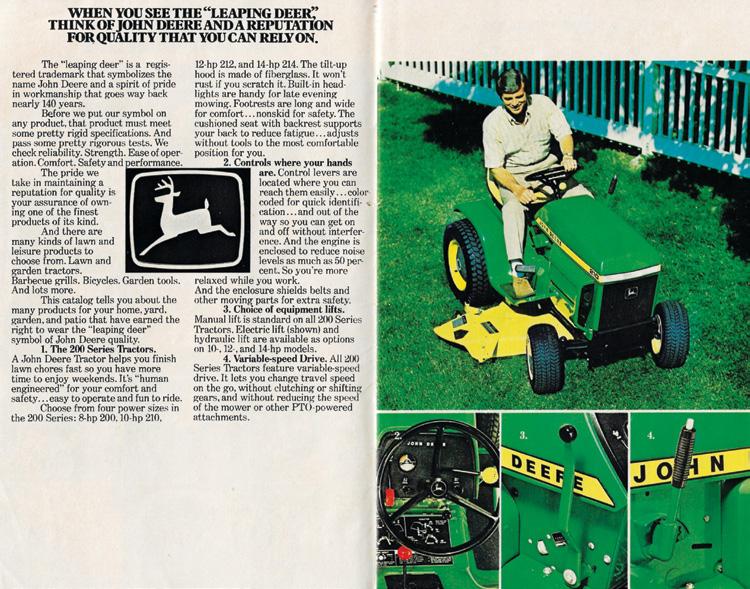
of pride in workmanship that goes way back nearly 140 years.” This was certainly true in 1976 when this booklet was printed. For me, this time period was one of the best in Deere’s history. Deere being who and what they were at this time made me proud to be a new dealer. I call the Deere company from this time period the Old Deere. Deere since around the time of the adoption of the new logo in the year 2000, I call the New Deere. It helps to keep them separate in my mind as Deere has made fundamental changes in the company, especially since the new logo arrived.
Anyway, in 1976, we had the 200 series of lawn tractors. They were gear shift transmission models and at this time, ranged in horsepower from model 208, which was eight horsepower, to the model 216, which was 16 horsepower. In our market, we sold primarily the larger sizes so the 214 and 216 were popular. For attachments, the mower was the most popular of course but you could also add a front blade, front snow thrower, rear rototiller and other pull behind attachments. They were heavily built, and a lot of people have described them as being built like a tank. I agree, which is why, 40 odd years later, there are thousands of these still on the job across the country.
One thing I do want to mention is where Deere says “The tilt-up hood is made of fiberglass. It will not rust if you scratch it.” True enough. What they do not tell you is that if you sit on it wrong, it cracks. If you drop a hammer or something heavy on it, it cracks. If you get too close to something and bump into it, it cracks. A lot of us can remember very well the feeling
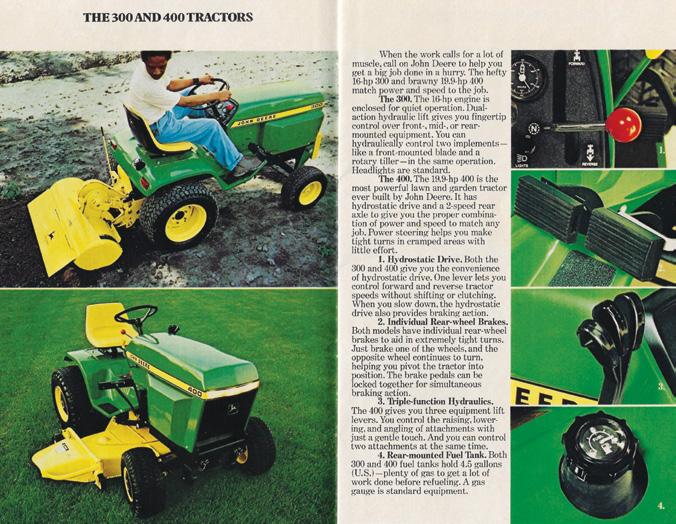
we got when we cracked our lawn tractor hood.
Photo 3 shows us the larger 300 and 400 series of lawn tractors. The 16 horsepower model 300 and 19.9 horsepower model 400 were not only larger, but they had hydrostatic transmissions. This meant you could change the forward or reverse motion of the tractor without shifting or clutching. It was all hydraulic. This also gave you on board hydraulic functions so you could lift or shift your implement hydraulically and not manually. The 300 had two functions while the top of the line, the 400, had three circuits.
The 300 and 400 series were the better sellers for our dealership. I guess it was due to the altitude—Franktown sits at 6,200 feet, has large acreages and rolling terrain with trees, brush and more. These sold well for us and our dealership even received an award for selling more 400 lawn tractors than any other dealer in the Kansas City branch. And, in fact, today these 40-year-old lawn tractors still enjoy a healthy resale value in the aftermarket. Lawn and garden collectors will have the 200, 300 and 400 series in their collections, many restored to new condition.
Photo 4 shows us the matched attachments Deere offered for these lawn tractors. The leaf sweeper had limited sales for us and today is worth little to nothing in the aftermarket. The snow throwers did an okay job moving snow but when the later dual stage snowblowers came out is when you could really move some snow. Hang on for this next one, the model 15 plow is a different story. We only sold a few
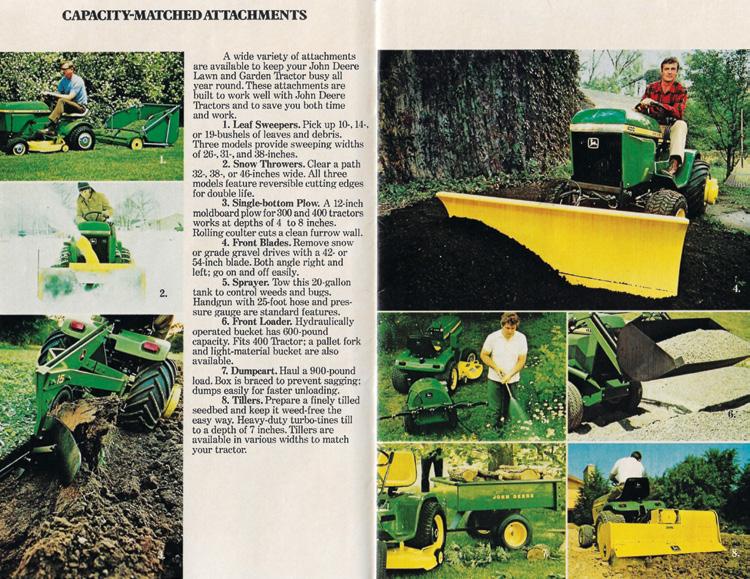 Photo 2
Photo 3
Photo 2
Photo 3
Green Magazine® • May 2024 Page 41
Photo 4
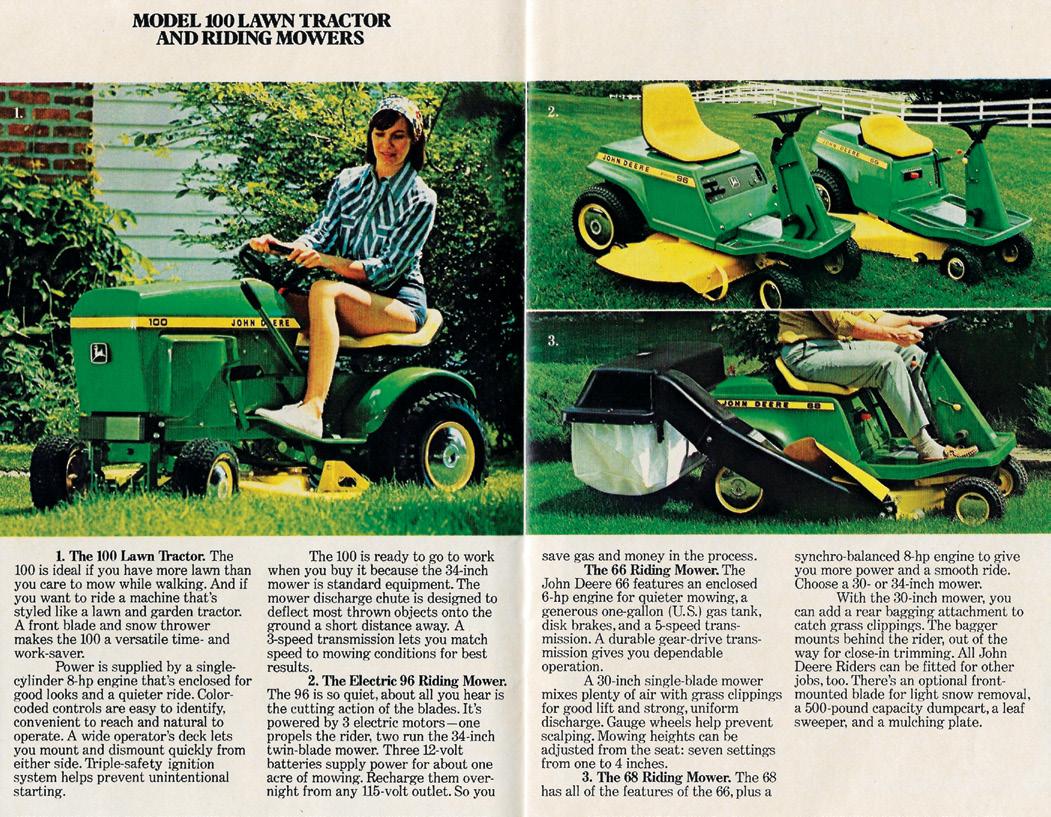
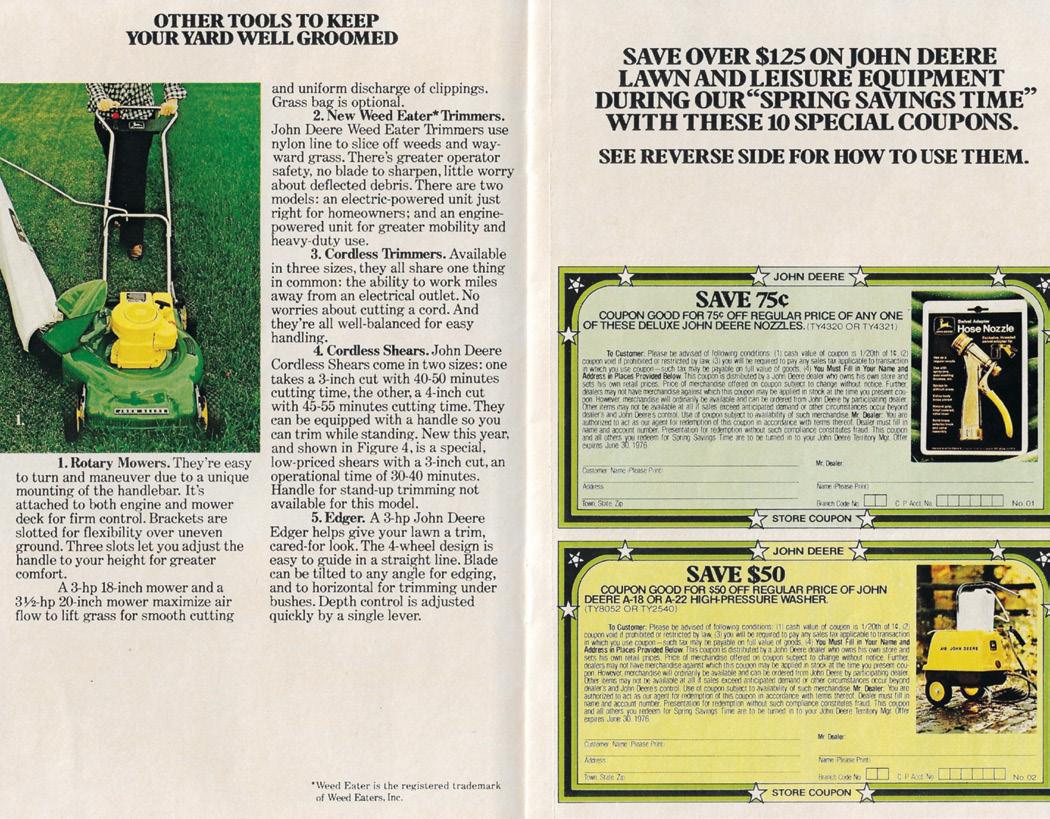
over the years and I suspect it was the same at most dealers. That makes these difficult to locate today and a plow in decent shape will routinely sell in the $300 to $500 range. I heard of one on an auction that brought $700 so that shows these are still great sellers. If you have one you are not using, it might be time to move it to a new home. The front blade is probably the most popular attachment, excluding mowers. The hydraulic versions for the 300 and 400 series allow you to not only lift the blade hydraulically but to also angle it as well. That makes it a tremendous tool for moving snow or dirt. Expect a hydraulic blade to sell in the $300 to $700 range in the aftermarket, even the 40-year-old versions.
One thing I can tell you is that if you have ever been a John Deere parts man in an area that sold these, then you are more than familiar with the cutting edge wear strip on the bottom of the blade. We sold tons of these as they can wear down pretty quickly and schools who used them on sidewalks and parking areas went through them like crazy. The tow behind sprayers are also popular with collectors and there are green and yellow versions and early ones have the four legged deer logo while later ones have the discontinued two legged deer logo. We had a yellow sprayer with a four legged deer logo come in on trade and it was pretty rough. It came with another one in even worse shape. We had two guys fighting
over them. It was kind of funny as they had sat on our lot for quite some time. The collecting side of the business had developed in the meantime and then two collectors happened upon them at the same time. One of them won and went home with both sprayers.
The dump cart is one thing Deere has offered pretty much continuously. Today they are plastic but the model 80 dump cart, like the one in the picture, was all steel and had cast iron corner reinforcements and a swing open tail gate. Early versions had brass serial number tags and different tires but all of them are collectible and today bring in the $200 to $500 range for exceptional examples. Rear rototillers have always been expensive and remain so today, except the older rear belt driven models are more reasonable.
But the king of all these attachments is, hands down, the loader. They are almost impossible to locate today and when one does come up, they bring good money. Deere was not the only company who offered front loaders for these lawn tractors but expect to pay anywhere from $2,000 to $5,000—$5,000 being the highest I ever heard about, and it was supposed to have been new and never installed. They have not been made in decades and were expensive when new, so few were sold. This is why they are so difficult to locate today. For many collectors, this is the ultimate accessory to have in your fleet. If you find
one reasonably priced, buy it. If you do not buy it at that moment, expect it to be gone when you call back. Just a word to the wise.
Photo 5 is the lower end of Deere’s mowers. The 100 was the smallest tractor and was basically meant to mow. A front blade and snow thrower were available, but we sold very few, if any, of these. The “turtle back” mowers (or the models 96, 66 and 68) occupy the bottom tier of Deere’s riding mowers. A front blade was offered but it was a disaster and the only one we ever sold did a very poor job. The small front wheels made it mow like a champ if you had a smooth suburban lawn. Try to mow a field, however, and you will be in for one bumpy ride. We had an elderly customer who mowed her lawn every day with her 68 rider. When she needed service on it, we had to be quick. Get it picked up, repaired and back to her as quickly as possible so we did not disrupt her mowing schedule. I often wondered how many hours were on that little 68. The 68 was eight horsepower and the 66 was six horsepower. The 66 was too small for our area so we sold mostly 68s. After time, the 68 would develop transmission problems but other than that gave us good service.
The 96 was an all-electric mower. We did sell a few of these and they did surprisingly well. The only service concerns that come to mind on these were the cost of replacing the batteries
Photo 6
Page 42 May 2024 • Green Magazine
Photo 5
when it was time and the motors that ran the mower blades seemed to me to not last as long as I thought they might. There are still a few 96s being used today, and they are somewhat collectible. The 66 and 68 riders have little to no interest from collectors.
Photo 6 is of Deere’s walk behind mower offered in 1976. They had an 18 inch and a 20 inch model. Also new for Deere were the “Weed Eater” grass trimmers. Deere licensed the Weed Eater trimmers for some years before discontinuing and offering others. Cordless trimmers and shears were also available. And finally, a new edger was now available. Next up in this booklet are money saving coupons— let us see what Deere was offering.
First up was a coupon worth 75 cents off a John Deere hose nozzle. Again, there are different versions of these. Value wise, I saw a new old stock hose nozzle still on the card bring $75 so I thought that was a pretty healthy price (Photo 7).
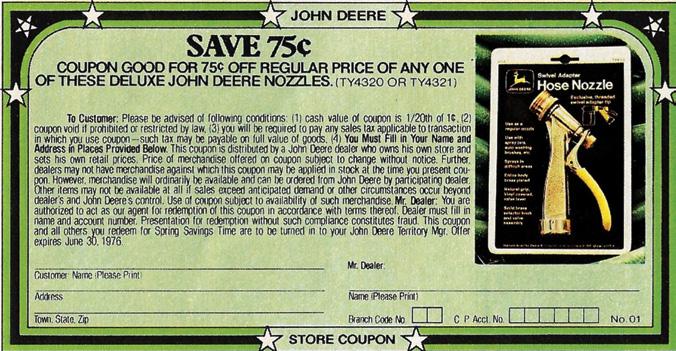
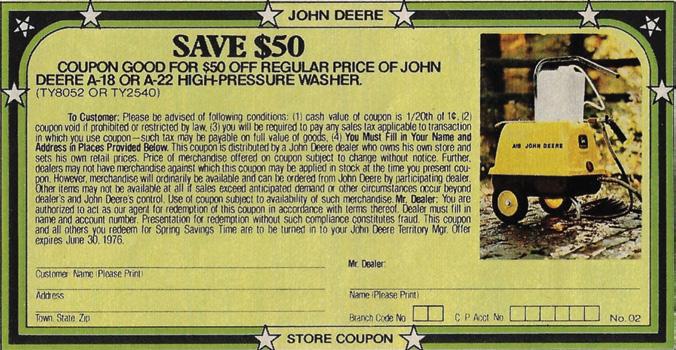
The coupon in Photo 8 is for $50 off on a Deere A18 or A20 power washer. We sold a few, mostly A18s. We had one in the shop and when we disassembled it to repair it, I was amazed at how little was inside the plastic shell. Basically, some plastic line, a valve or two and the pump. Ours also had trouble getting it to prime. I was glad when we got rid of it and went back to our Hotsy high pressure washer. A few collectors have some of these but there does not seem to be a great interest in them. There are lots of other
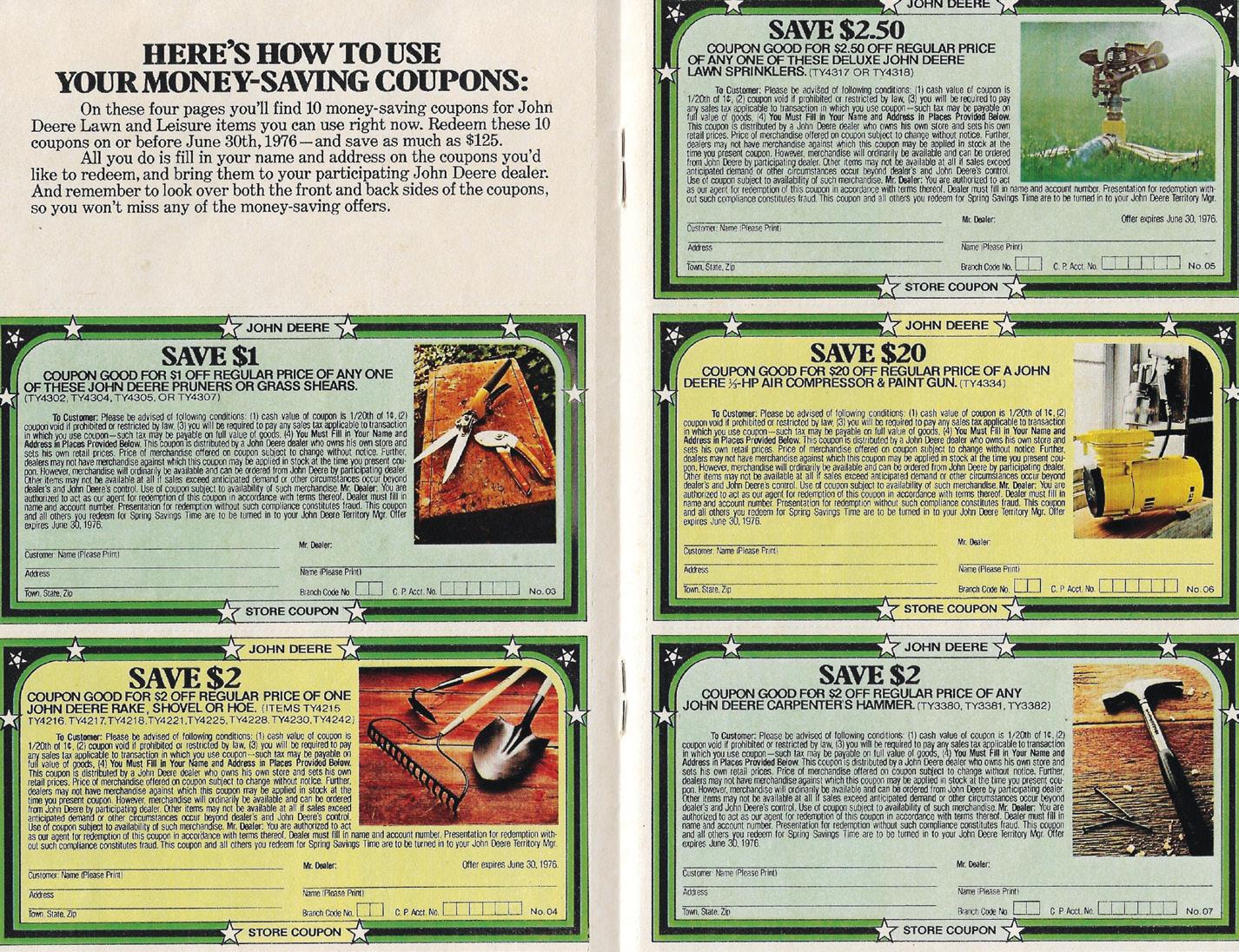
power washer models Deere offered over the years beyond just these. The next page is more coupons (Photo 9).
Photo 10 is $1 off on pruners or grass shears. We did sell a few of both of these. I saw a pair of still new pruners in their original vinyl case sell for $100 so that was a good price.
Photo 11 is $2 off a John Deere rake, shovel or hoe. Deere has offered shovels off and on over the years. These are the ones originally offered with the little “John Deere” in black and gold painted on the wood. They were good tools, and we sold a fair amount. Be aware if you have any of these in your shop, they are bringing a very good price. A year or two ago, a few of these brand new were auctioned off and prices ran into the $100s for certain ones. Most collectors were surprised; I know I was. I had an old used snow shovel from this series, name was flaking off like most of these do with age. It was decent but missing paint, a bit of rust and flaking finish. It still brought $85 and I sent it to Oklahoma.
Photo 12 is for $2.50 off on a John Deere sprinkler. There were several models of sprinklers, and all are tough
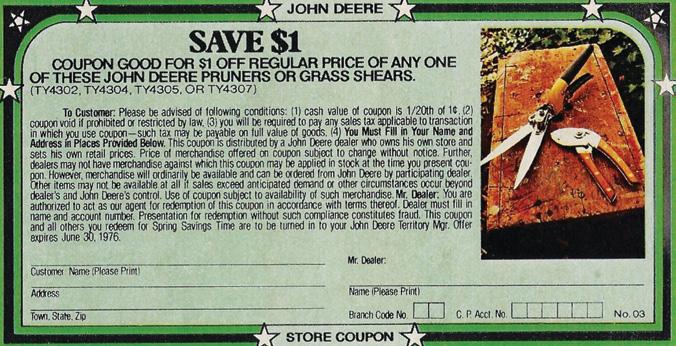

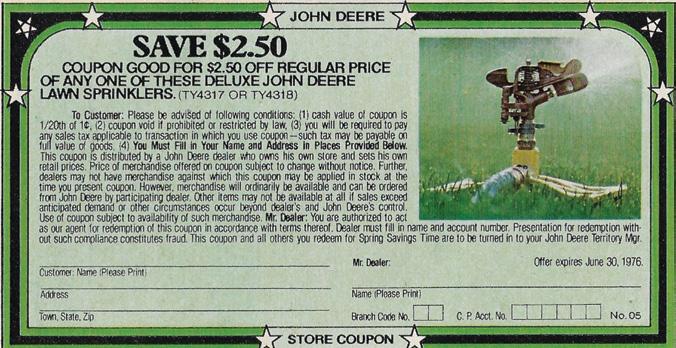
to locate today. A new sprinkler in the box sold for $100 recently.
TO BE CONTINUED
Write Greg Stephen at The Old Tractor Company, Box 89, Franktown, CO 80116; phone 231-846-8243 or email deeredr@hotmail.com
Photo 7 • Photo 8, below
Photo 9
Photo 10 • Photo 11, below
Green Magazine® • May 2024 Page 43
Photo 12

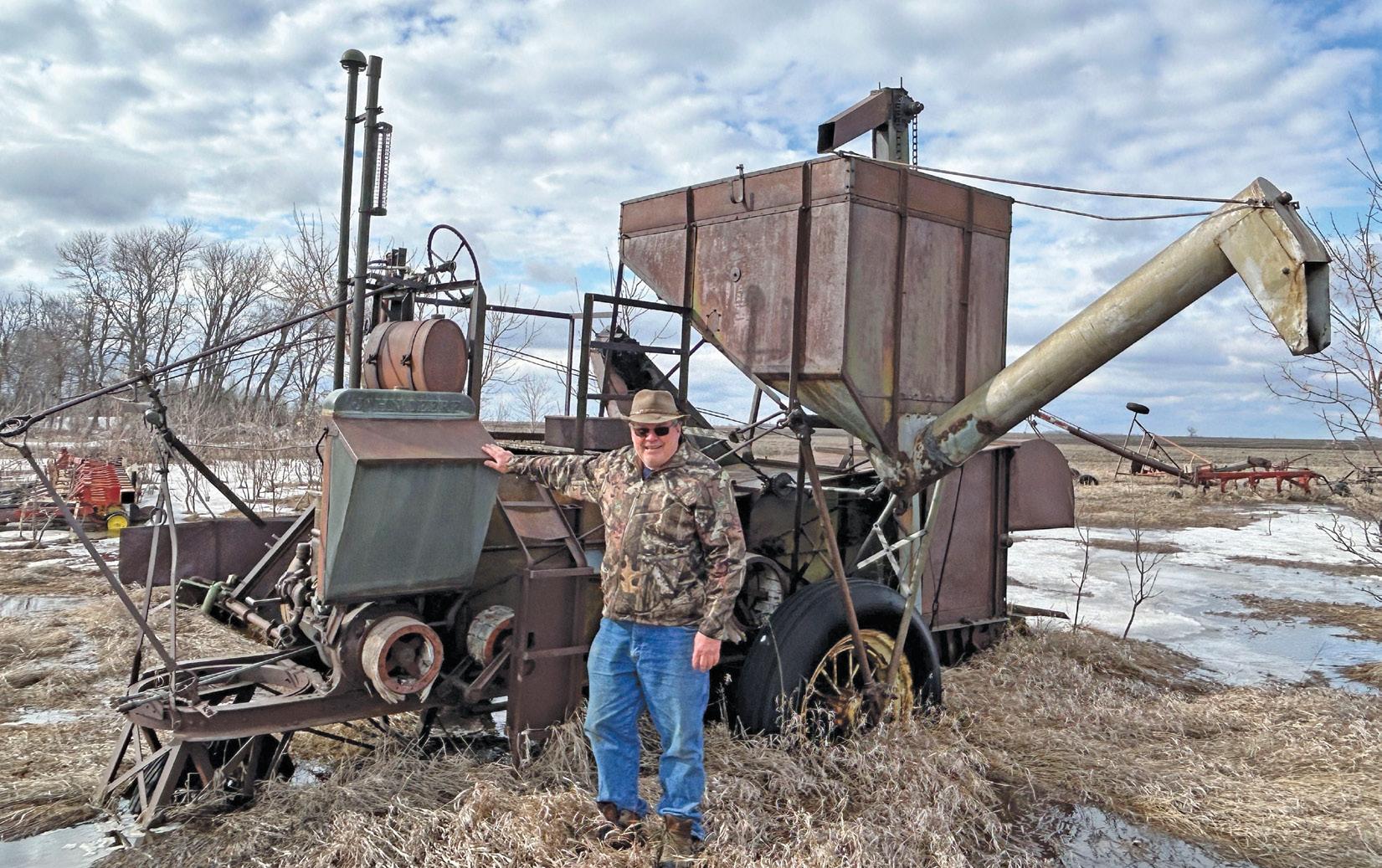
Ninety years ago, the No. 17 was Deere’s big combine. With its 36 inch cylinder, it was said to be capable of harvesting up to five acres an hour. And it looks like there are still a few around.
Peter Kappes sent us a photo of himself standing next to his father-in-law Walter Olson’s No. 17. He also included photos of the same combine at work near Halstad, Minnesota in the 1940s. One photo shows a good view of the

Page 44 May 2024 • Green Magazine
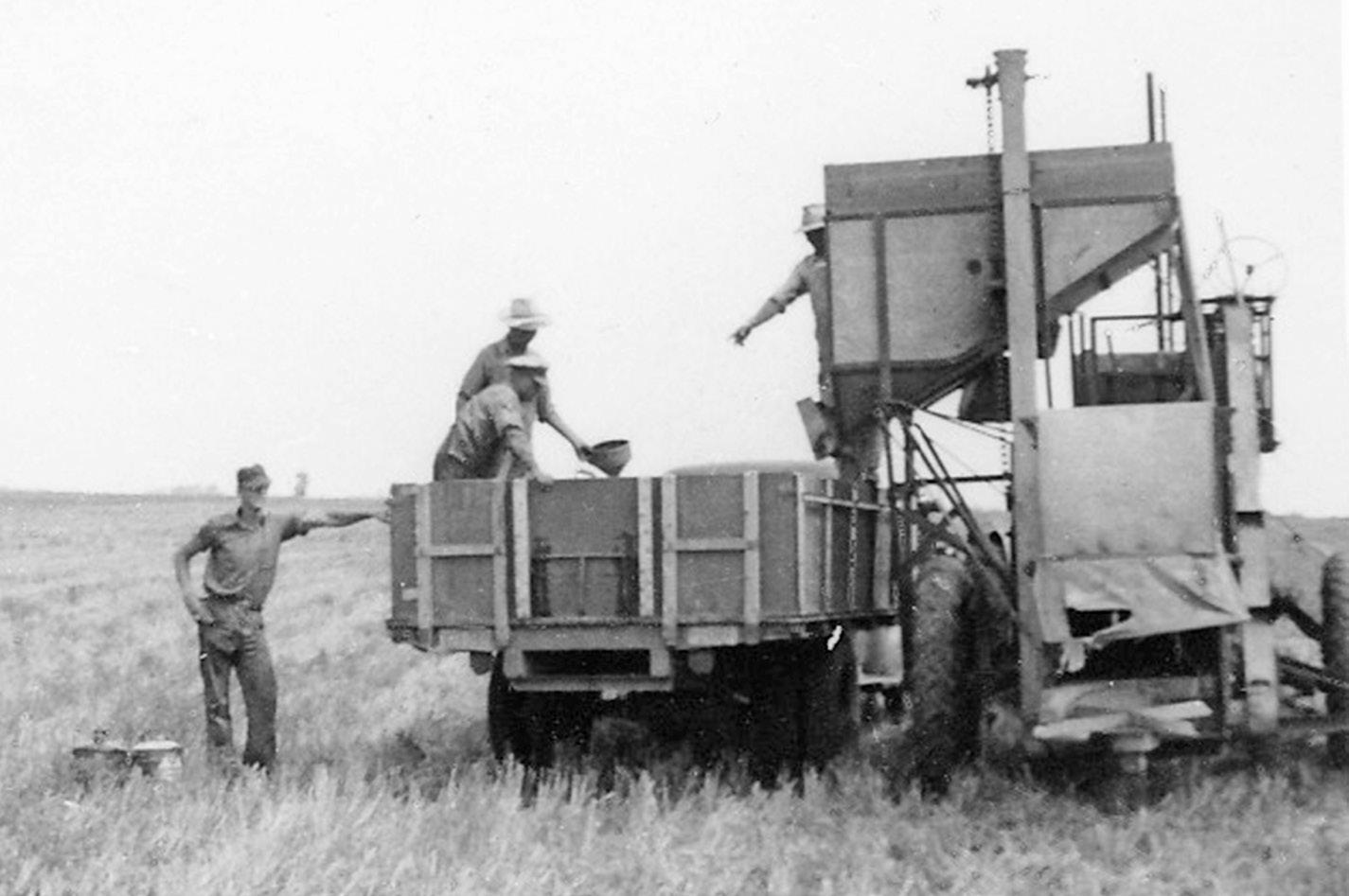
linkage to steer the tractor from the combine operator’s station, while in another we see the crew adding fuel. In the third photo, it looks like they were having problems with soft ground as a newer “D” is cabled to the older “D” to help it through low spots. For his efforts, Peter Kappes gets one year added to his subscription.
“Do you have one?”
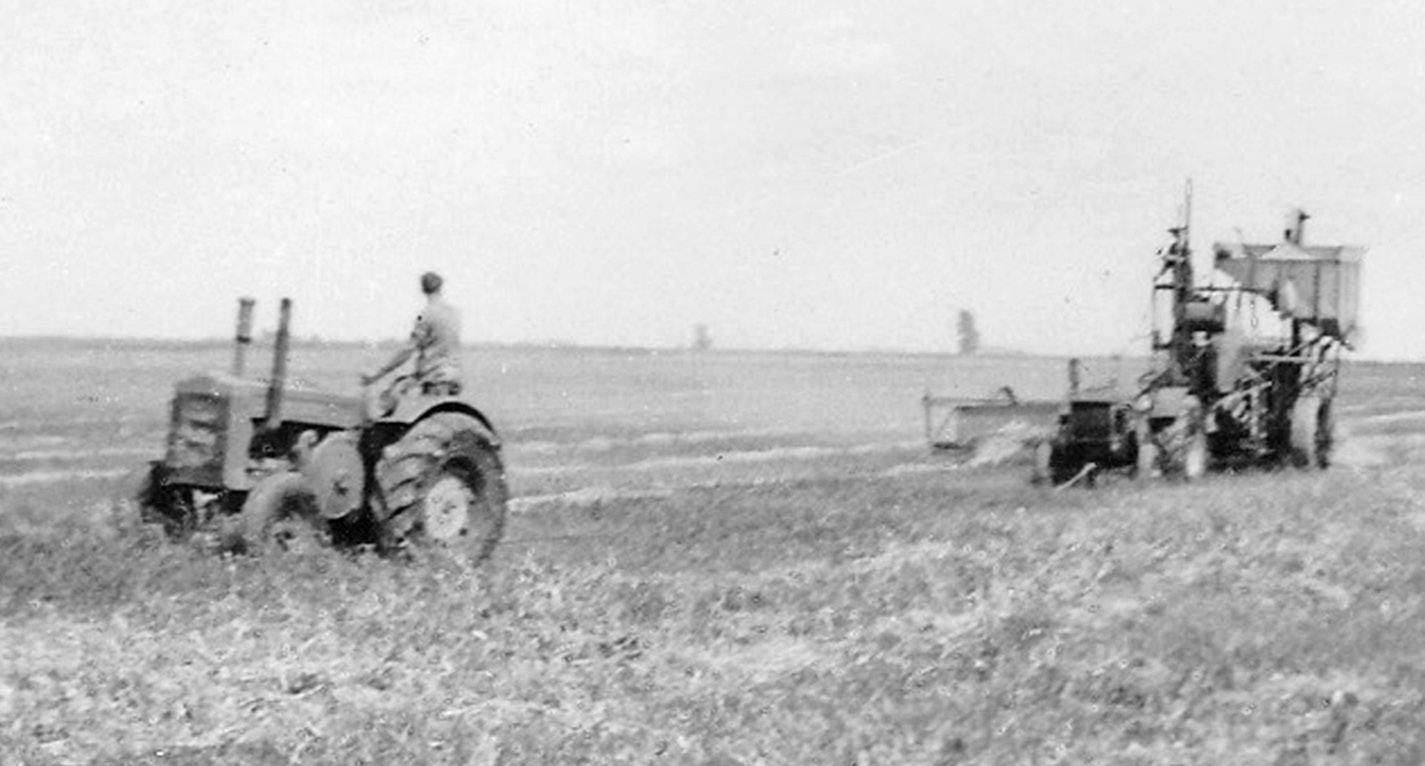
For our next search, let’s fast forward about 20 years to see how many people own a front rockshaft. The photos here show a closeup of the rockshaft itself and a one mounted on a 620 operating a cultivator. The advantage of these was that you could operate the cultivator completely independently of the rear gang, which was mounted on the three-point. If your tractor had dual hydraulics, you could get a dual front rockshaft that would make it possible to lift either side of the cultivator independently. This came in handy on oddly shaped or terraced fields that had a lot of point rows.
Do you have a two cylinder with a front rockshaft? If so, be the first to get a photo of it and yourself to us and we will add one year to your subscription.
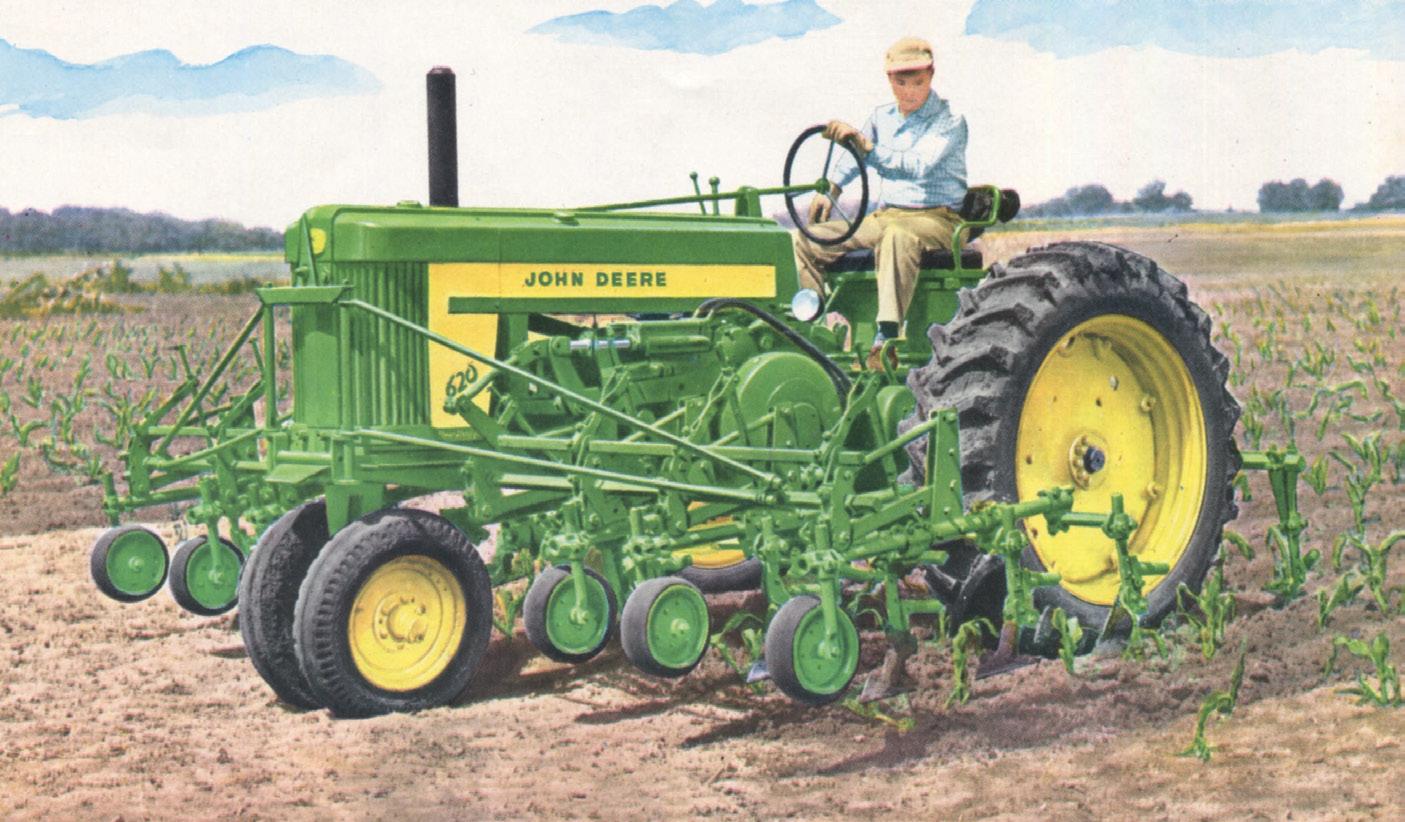
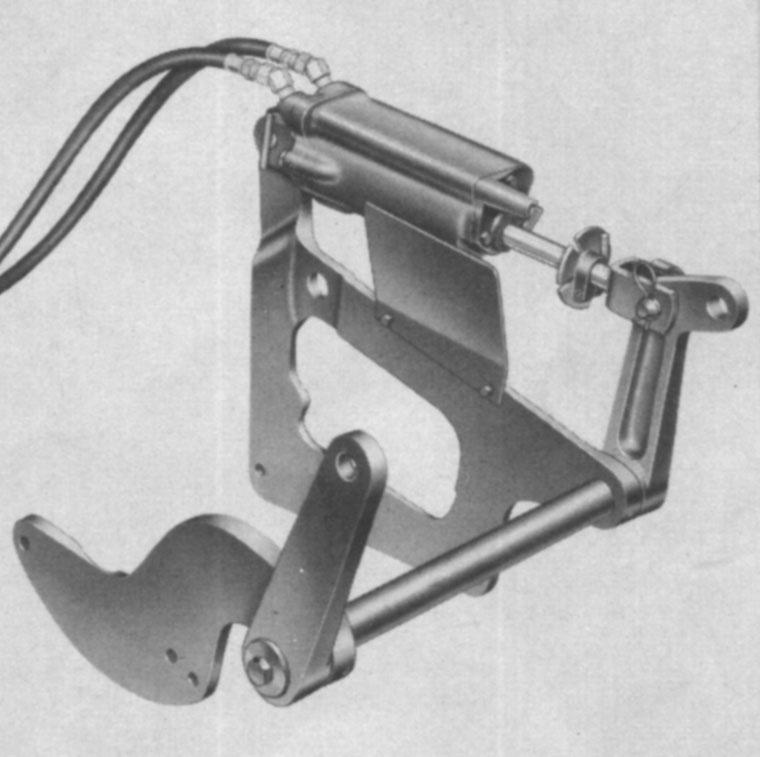
4 for Green Magazine’s postal
addresses
Green Magazine® • May 2024 Page 45
See page
and email
for entries in


Lots to talk about this month with shop activities, but first let’s take a peek at a new “tool” that will help out when sandblasting. I was recently cruising the aisles of my favorite
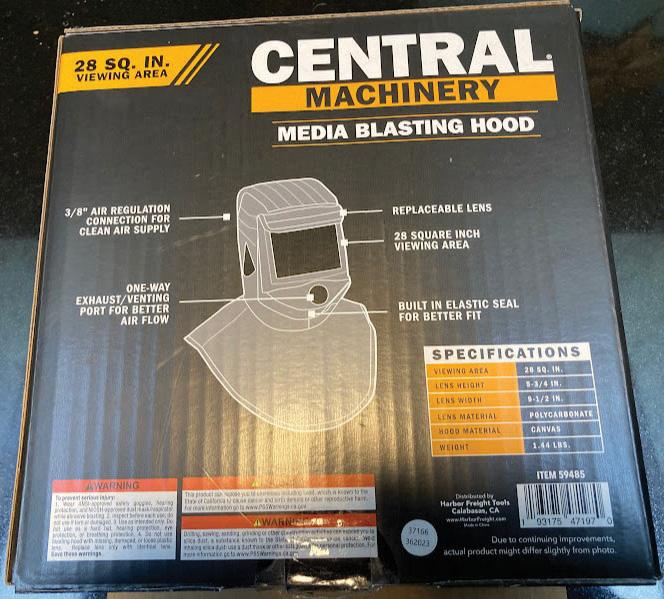
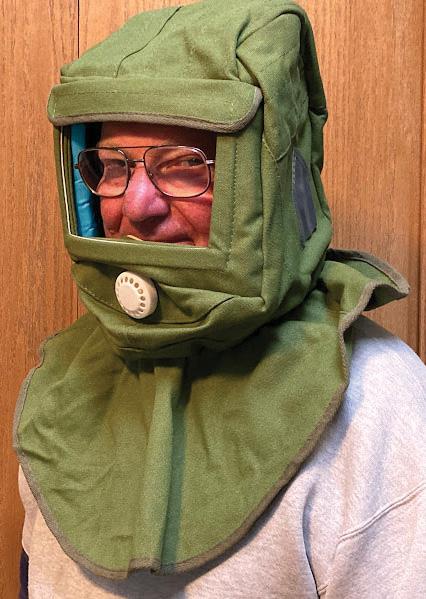
“toys for boys” kind of store (Harbor Freight), when there it was—just what I needed. I spied a new sandblast hood. The one that I currently have is all but useless as sand gets to me from below the neckline and the lookout window has also seen its better days. This new
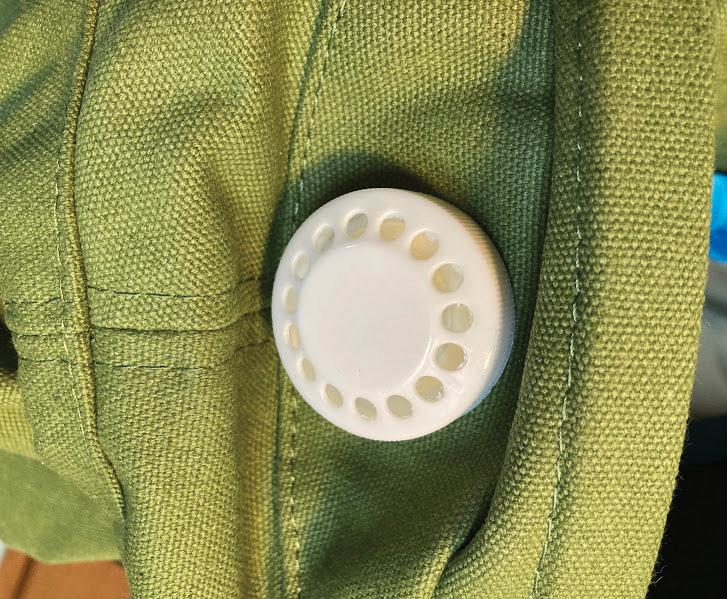
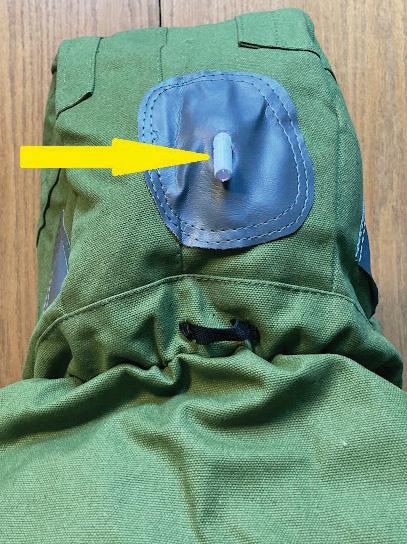
media blasting hood was of course located in the same aisle with lots of other things needed/helpful for the sandblasting task. The carton looked like this (Photo 1). My initial thought was that it can’t be much of a hood in a carton that small; the price was $24. It all seemed too good to be true. But I concluded that if it was even a little bit better than the hood that I currently use, I should check it out further.
To my delightful surprise, the hood is made of a canvas type of material and has an elastic band that fits snugly on the neckline to keep sand and debris out (Photo 2). The additional features include a one-way exhaust vent near your mouth and nose (Photo 3), and there’s even an air “regulator” connector on the back (Photo 4) of the hood that could direct incoming air above the eye “windshield” to prevent fogging up.
And that fresh air supply? Well, Jo Anne found a little rechargeable battery operated fresh air pump complete
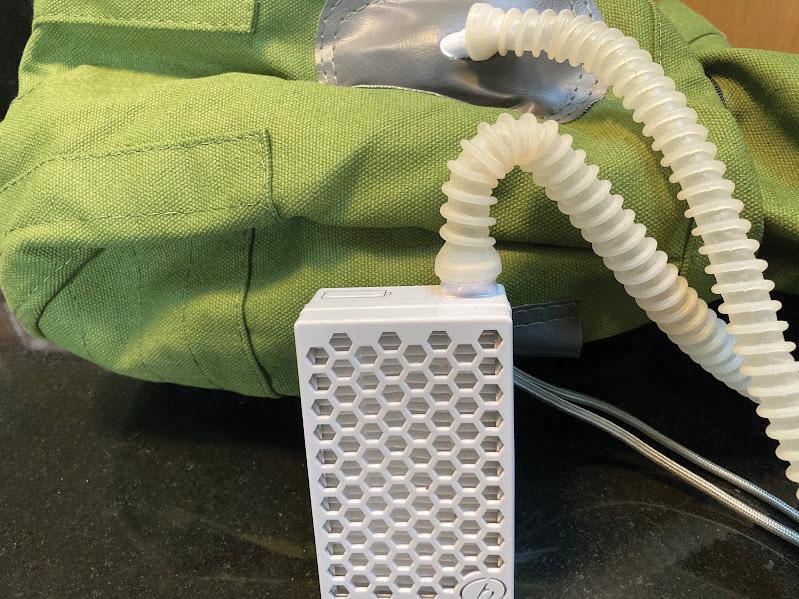 Photo 1 • Photo 2, below
Photo 3 • Photo 4, below
Photo 1 • Photo 2, below
Photo 3 • Photo 4, below
Page 46 May 2024 • Green Magazine
Photo 5

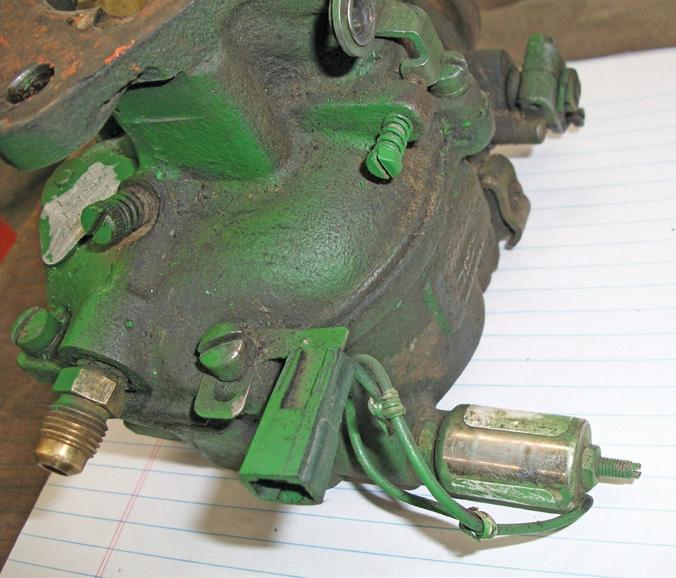
with a paper filter (Photo 5) on the internet. It was a really sought after item for healthcare workers during that covid “event.” The hood and this little AirPro pump work well together. I give it two thumbs up, and the price was right!
From the carburetor corner of the shop, the latest John Deere entry is this cast iron Zenith AR45161 model (Photo 6) off of a 3010. This model was common on John Deere 3010-3020s and on 4010 and 4020 models. This series of tractors also used an all-aluminum Marvel Schebler carburetor that featured a vacuum operated diaphragm for its fuel enrichment. Of these two carburetors, I much prefer the cast iron Zenith over the Marvel Schebler model. The Marvel model was affected by engine heat likely because of its aluminum casting and the vacuum diaphragm system was a source of trouble as it aged. Their main problem was a rich mixture and hard starting when the engine was hot. The Marvel aluminum carbs were also the culprit for the tractor’s engine to run on or “diesel” if the engine was shut off when hot or not idled down completely upon shutdown. The Zenith carbure-
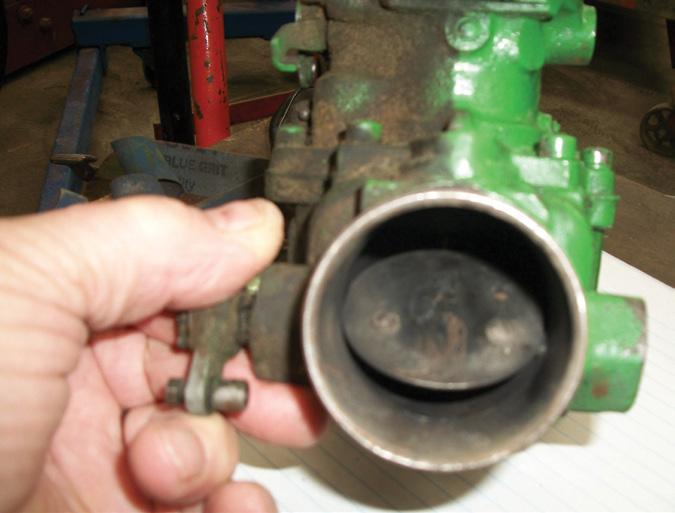

tor incorporated an electric solenoid (Photo 7) that controlled the fuel flow from the carburetor to the high-speed circuit. When the ignition key was turned on, the solenoid retracted and the carburetor’s main fuel jet was exposed. When the engine was shut off with the key switch, the solenoid’s spring-loaded plunger moved out and blocked the main jet’s orifice, stopping fuel from flowing and helping to stop the engine from the “run-on.”
I always ask the carb’s owner what the problem is with the carburetor when they drop them off. The complaint with this Zenith carb was that it always ran smoky rich at idle and slow speeds so much that spark plug fouling is a frequent thing on his 3010. Giving the carburetor a quick external look when he handed it to me, the first thing that I noticed was that the choke door wasn’t opening all the way (Photo 8). This cannot be and it could very well be what is causing the carburetor to run “rich” on the lower RPMs, causing the fouling spark plugs. For a time, I gave some thought to simply adjusting the choke control arm (Photo 9) to allow the door to open all the way and then give it back to the customer and say that I thought it would be fixed. But that would have
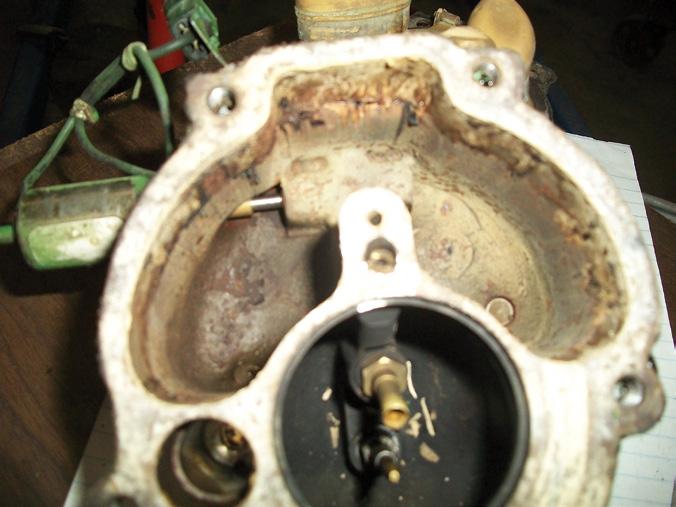
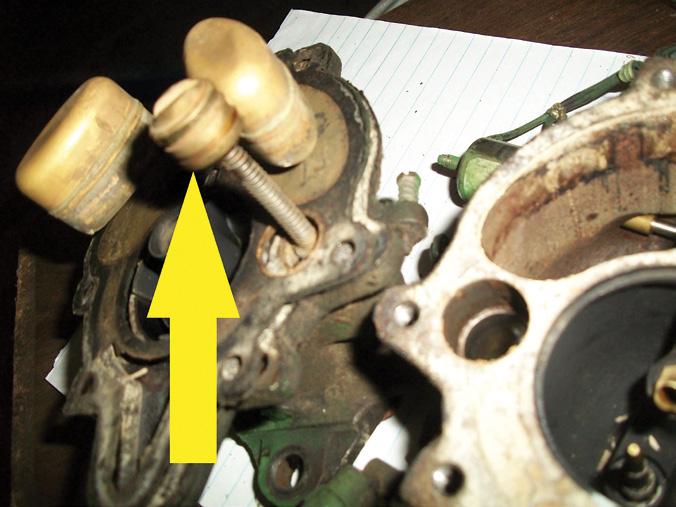
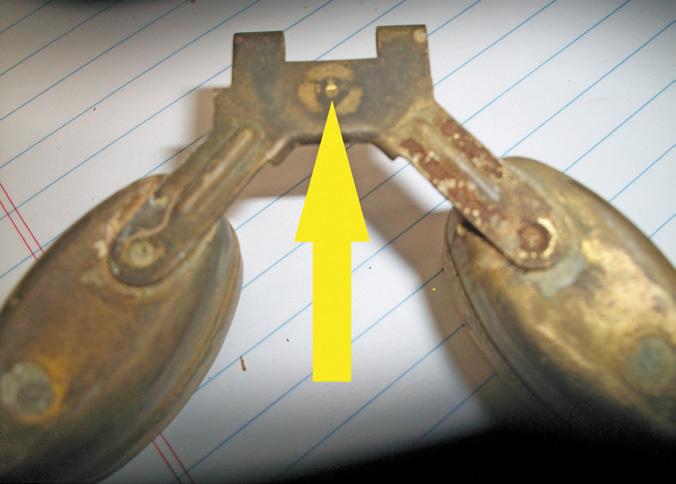

been like saying I don’t want to see what’s inside your carburetor and IF it WASN’T fixed, the customer would be gone for good!
So when splitting the carburetor open, there appears this mess of gummy stuff in the bottom of the bowl (Photo 10). This one needs a rebuild kit and a trip through old Doc’s carburetor beautification school. The brass plunger that is seen protruding from the upper half of the carb casting is actually a vacuum-operated accelerator pump (Photo 11). We can see that
Photo 10 • Photo 11, below
Photo 8 • Photo 9, below
Photo 6 • Photo 7, below
Green Magazine® • May 2024 Page 47
Photo 12 • Photo 13, below
its float assembly is in okay shape and can be used again, but the wear dimple (Photo 12) from the old needle valve will need to be sanded smooth. The needle valve shows its signs of wear on the Viton tip (Photo 13), and also on its three outer sides that guide it in the seat. This carburetor’s inlet fitting is equipped with a screen that is partially plugged with rust (Photo 14). At this point, I am convinced that it would have been a mistake to not take this carb apart and do a complete job.
This carb features a vacuum operated actuator pump whose upper portion is pressed into the top side of the casting (Photo 15) with no access from above to remove it. After giving the matter some thought regarding how to remove it and also having the gut feeling that this is a part that would be smart not to harm or you find yourself without a source of a new one. Using the gas plunger end of the pump as a small back hammer, I found that it came out of the upper casting exposing the vacuum plunger (Photo 16).
Now one has to wonder how in
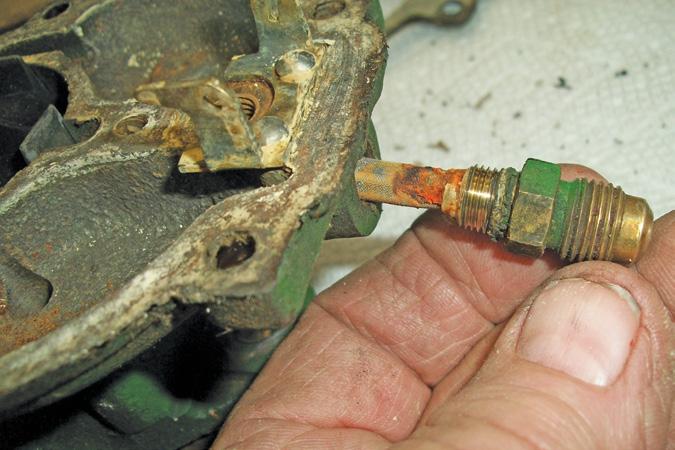

the dickens does this pump system all work, especially without any external linkage? Well, here goes—the manifold vacuum is ported into a port just above the throttle door (Photo 17). The vacuum is directed into the upper portion of the pump’s chamber. This action causes the vacuum to act on the upper piston in the same chamber, drawing in gas, and compressing the spring that connects the two pistons. At the bottom of the chamber is a small brass one-way check valve (hard to show). It allows gas to be drawn into the pump chamber as the lower piston is lifted and then closes when the piston is forced down from lack of
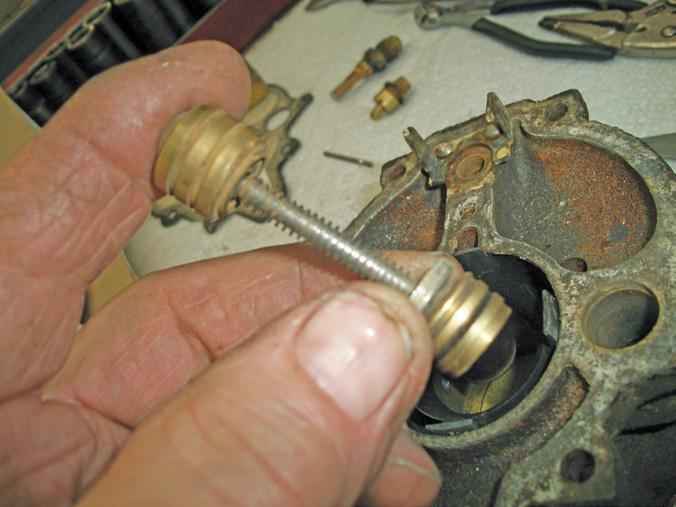

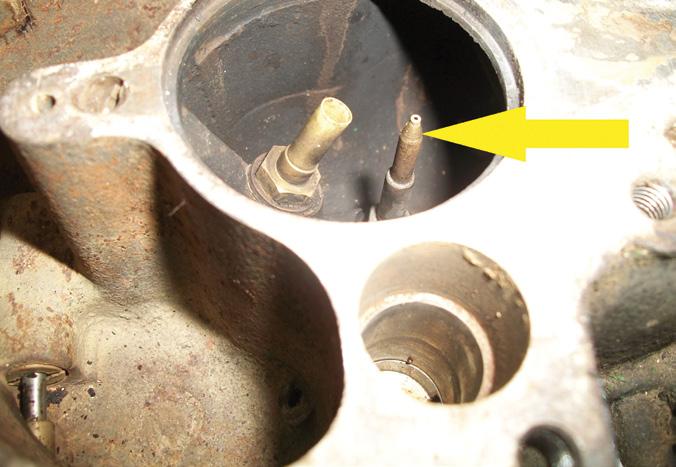
vacuum as the throttle plate opens up. Now the gas in the chamber is forced out to the discharge nozzle in the carburetor’s air intake throat (Photo 18). As you can see, it is a much smaller discharge tube than is the main nozzle that it is next to it. The system works by sensing manifold vacuum (or lack of) to squirt a small amount of extra gas into the engine’s intake air every time the throttle is opened to help it accelerate smoothly. The electric shutoff solenoid screws into the side of the lower casting (Photo 19) and opens or closes off the gas flow past the main jet. The main jet is threaded into the lower casting and is usually very difficult to unscrew. This one was barely finger tight; in fact, I would call it loose. From the jet, the gas then flows out of the main discharge nozzle into the incoming air. Along the way, to feed the main discharge nozzle with gas, some is bled off by the idle jet (Photo 20), and ported to the upper casting for discharge to idle the engine.
TO BE CONTINUED
This column is written by Ron and Jo Anne O’Neill.
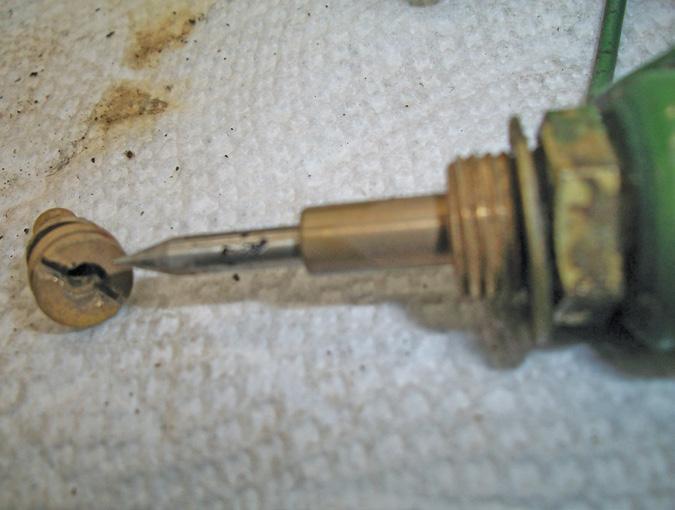
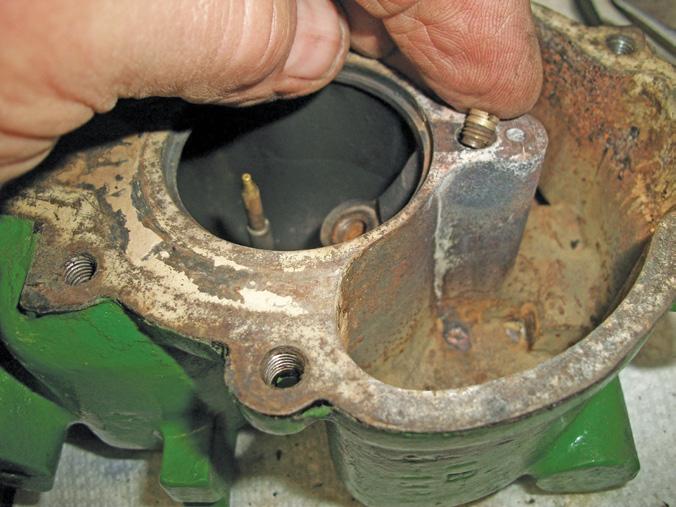
If you move, let us know your new address. Call 402-643-6269 or email info@greenmagazine.com
Photo 19 • Photo 20, below
Photo 16
Photo 14 • Photo 15, below
Page 48 May 2024 • Green Magazine
Photo 17 • Photo 18, below


The first numbered series of John Deere tractors doesn’t seem to have the same notoriety or general interest that the 20 series, and certainly 30 series, tractors do. Perhaps the large splashes of yellow on the sides of the 20 and 30 series machines create a natural “draw” to them. But, within the first numbered series, Deere introduced power steering, live PTO, and their first row crop tractor with a diesel engine. To commemorate the 70th anniversary of the introduction of the model 70 tractor, Ertl released a Prestige Collection 1/16th scale miniature late in 2023. It carries their stock number 458530TP and will be the subject of this article.
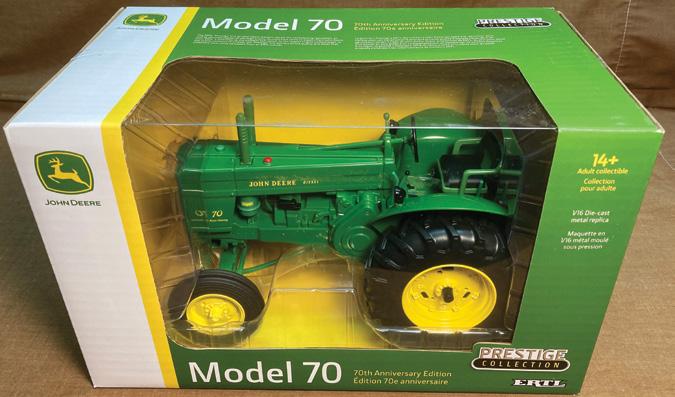
The tractor and carton are shown in Photo 1. The carton follows the current standards for Ertl John Deere Prestige miniatures with a fully enclosed cardboard box that has a clear plastic viewing window on the front and top. I think that the intent is to allow collectors to leave the toy in the carton for display purposes, if desired. While I think that is a good idea, it is impossible to see everything on the tractor without removing it from the box. The graphics feature green, yellow, and white background and lettering colors. Each end panel has a partial picture
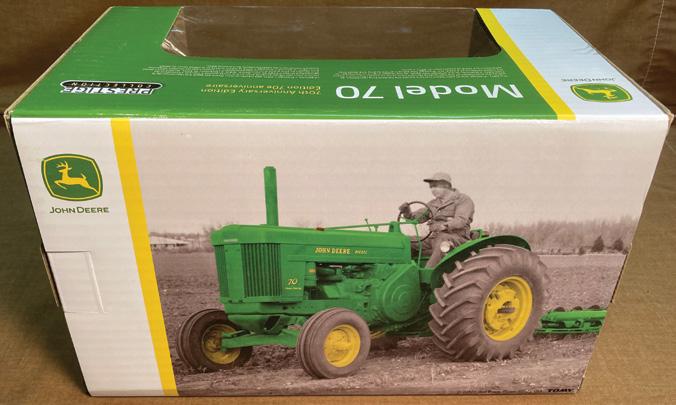
of a real model 70 tractor and the rear panel (Photo 2) has a retouched photo of a real tractor at work.
Inside the carton is the usual clear plastic cradle that Ertl uses on so many of their models. The tractor is secured to the cradle with paper ties that are twisted together under the cradle. What I really don’t like is all of the clear tape that is used to secure the cradle to the inner card stock material that forms the yellow backdrop inside the carton. Tape is all around the periphery and it takes some time to cut it loose if you care to save the packaging. In addition, the holes through which the paper ties are inserted are much too small. They don’t pull through easily and I ended up cutting mine so that I didn’t damage the tractor while removing it. It just seems to me that there should be a better way to package the toys that is simpler and easier to work with.
Left and right side views of the tractor are shown in Photos 3 and 4. This is a replica of the standard tread version of the model 70 with a diesel engine. Interestingly, while the model 70 was introduced in 1953, the diesel engine version and the standard tread

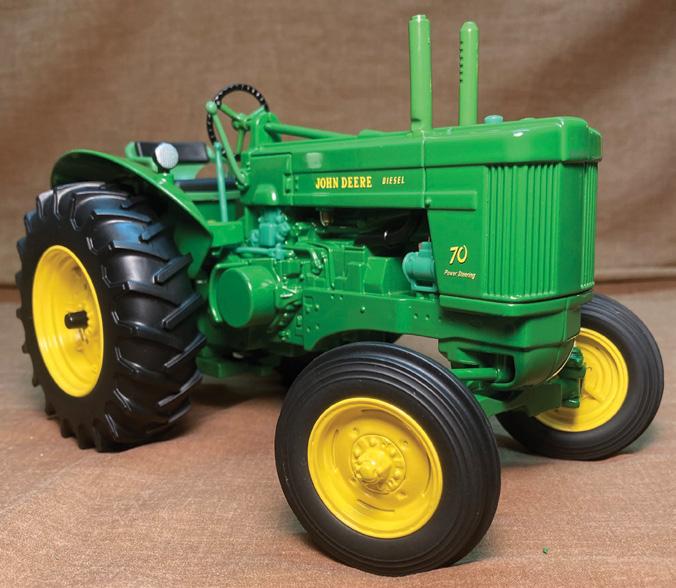
model were not introduced until late in 1954 for the 1955 model year. So, while 2023 would commemorate 70 years since the introduction of the model 70 row crop tractor, it does not mark the 70th anniversary of the diesel standard tread version. I am not really sure what drove the team at Ertl to this decision, and I suppose it really doesn’t matter. Let’s take a look at the details. On the top of the hood, there is a green radiator cap and a red fuel cap, both of which are tiny items that were glued in place rather than being cast in place. The muffler and air intake stack are also separate items that are made of a green, soft plastic material. However, the air intake stack is a bit of a question
Photo 1
Photo 3 • Photo 4, below
Green Magazine® • May 2024 Page 49
Photo 2
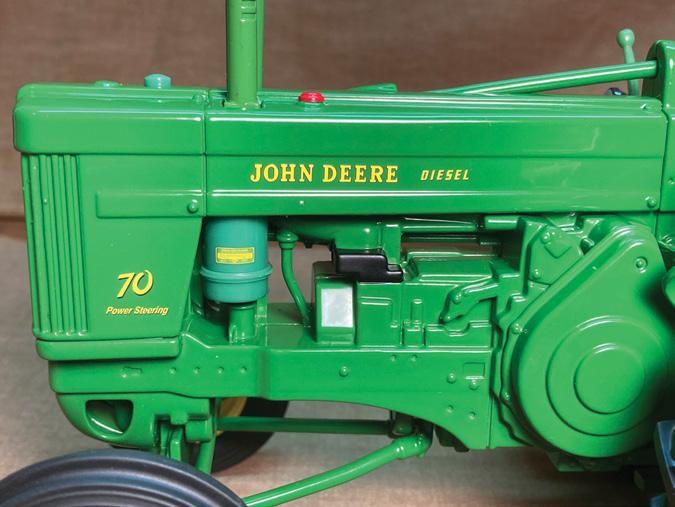
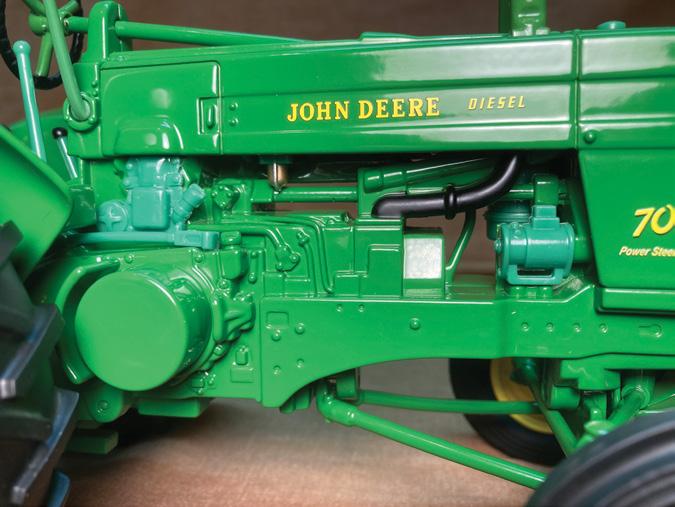
mark for me. I tried to find a picture of a model 70 tractor with one on it, but they are very few and far between. In addition, the style varies. I checked in the parts catalog and found that the stack was optional and required a special casting to draw air from above rather than from the side. The style of stack shown in the catalog resembled one like we see on unstyled model “A” or “B” tractors. On this toy, Ertl used one like was used on a model 80, 820, or styled “AR.” Frankly, I think it looks good but I’m just not certain that it is correct.
The engine details are shown in Photos 5 and 6. Since this is a Prestige model, several of the detail items are made of plastic. The air cleaner canister is one of those items that can be seen in Photo 5. In most of the photos, all of the plastic items show up as being a much lighter green color than John Deere green. That is simply the way the camera picks them up. In reality, they don’t actually appear that different on the toy. Other items in the engine area include the intake and exhaust manifolds, the starting engine, fuel sediment bowl, and generator. While the exhaust manifold is accented in black, the generator is not and should have been. The right side of the hood
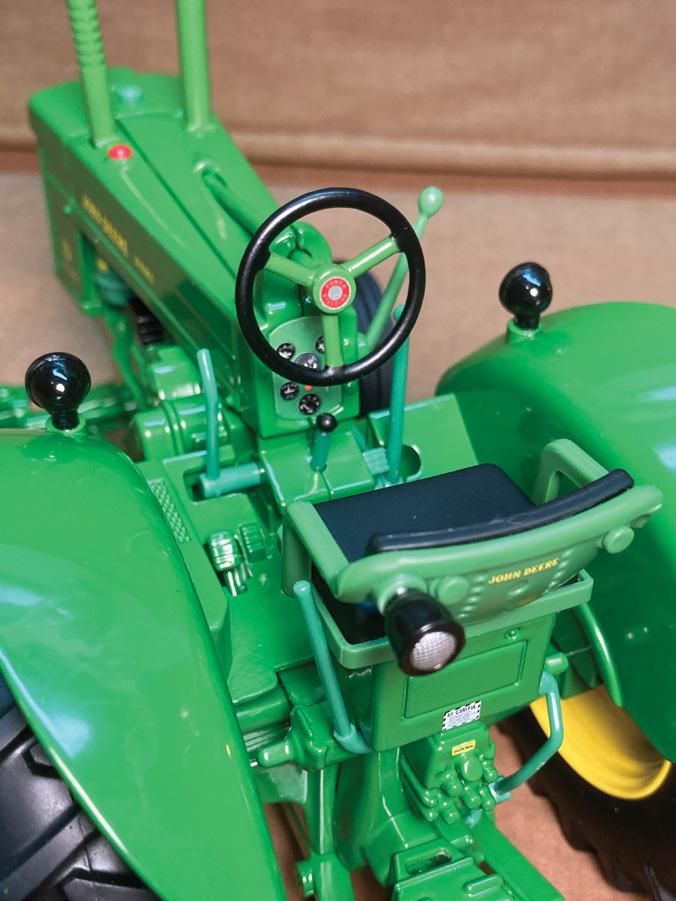

has the starting engine access door cast in place, complete with the latch and “blister” over the engine.
There is a nice complement of controls and overall details in the operator’s station. Photos 7 and 8 provide an overall view of this area on the tractor. Two forward-facing work lights are on the fenders and a rearward facing light is on the back of the seat. All of these items have black housings and silver lenses. The seat is a plastic item with a black “rubber” cushion and back rest. The steering wheel spokes are green and the grip is black. At the center is the red and silver “POWER STEERING” identifier.
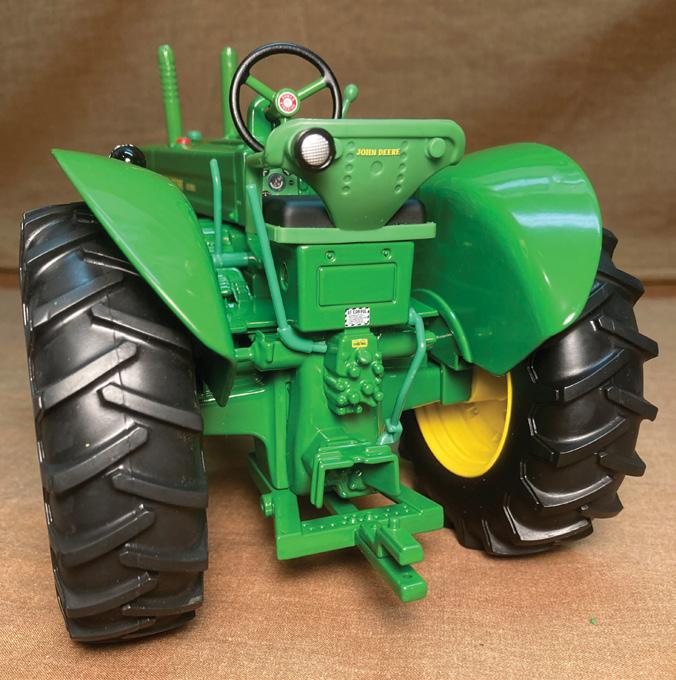

There is a lever for engaging and starting the diesel engine on the left side of the dash. The gear shift lever is directly below the dash and both the throttle and clutch lever are on the right side. Brake pedals and the controls for the PTO and Powr-Trol are also included. The dash area has a single decal that includes all of the gauges (oil pressure, ammeter, water temperature, and fuel) and the Speed-Hour meter, ignition indicator light, and ignition switch. There is even a small black circle with “Lighter” printed in it!
The rear of the tractor is shown in Photo 9. Note the heavy duty drawbar, PTO with shield, and PTO engagement linkage. The Powr-Trol housing (Photo 10) includes a tiny decal printed in yellow, green and black. Immediately above it is a black and white Be Careful decal printed in place. While only
Photo 5 • Photo 6, below
Photo 7 • Photo 8, below
Page 50 May 2024 • Green Magazine
Photo 9 • Photo 10, below
portions of these items can be read, I think it is great that Ertl included this level of detail.
All of the wheels are made of die-cast metal and have the appropriate types and quantities of “hardware” and cut-outs. The tires are a rubber material and seem to fit the machine well for size. However, the rear bar tread pattern is too modern, in my opinion. I would have preferred more of a 45 degree angle style. The front axle and steering components are very nicely detailed, but the assembly is too “sloppy” on my tractor. While turning the steering wheel causes a slight movement of the front wheels, they don’t move fully from side to side. If I grab the wheels and move them, they do swing the full distance. Individual parts were used for the axle, tie rod, and steering arms, but the riveted assembly has enough tolerance that it doesn’t work properly. In addition, Photos 11 and 12 show just how much “sloppiness” there is in the assembly. Take a close look at how far the front wheels can be moved from a normal “straight-ahead” position (Photo 11) to one in which they are wide at the front (Photo 12). The good news is that the front wheels can be positioned where they need to be when sitting on the display shelf. And since this miniature is not really intended to be


a toy, I suppose this is not a big issue. Other than the front axle, all of the other parts are assembled well and the paint and graphics are very good. All of the hood graphics are printed in place and feature yellow numbers and letters with a black outline. Included are the John Deere name, DIESEL identifier, the number 70, and the Power Steering label. The John Deere name is also printed on the back of the seat and the John Deere trademark is on the front of the seat pedestal. A green and yellow instruction decal is also on the air cleaner canister. The John Deere name is also printed on the front of the tractor in tiny silver letters. On the bottom of the tractor is a cast plate that reads “70th Anniversary 1953-2023.”
The prices for new farm toys continue to increase, just as with everything else. I have seen this particular toy advertised from $80 to $100. Perhaps I am still living in the past, but $100 seems very high for a 1/16th scale miniature of any two-cylinder tractor. I recommend shopping around before paying that amount of cash. The details are very nice despite a few of the “flaws” and, overall, this is a really nice model. I will probably paint the muffler and generator on mine black to make it a little bit more correct. As always, the decision to add any toy or miniature to your collection is yours alone. Enjoy. Contact Bill Proft at N1366 Woodland Dr., Greenville, WI 54942 or email billproft@sbcglobal.net

Send your question to Mr. Thinker Send questions to: Green Magazine PO Box 95 Bee, NE 68314-0095 Email: info@greenmagazine.com
Photo 12
Green Magazine® • May 2024 Page 51
Photo 11


Howdy to you all! I really had a lot of fun researching this month. I had a chance to visit with some family and friend…about John Deeres of course! My wife’s grandfather bought a new 1949 “B” John Deere at Sulgrove Implement in Bridgewater, Iowa. I recently acquired a couple of pocket ledgers from Bagley Implement in Bagley, Minnesota, where my grandfather and dad bought a new 1949 “B.” That led me to start thinking—if anyone has or sees a pocket ledger from Sulgrove Implement in Bridgewater, Iowa, I would sure be interested. If you see one at a sale, let me know. Now on to our tractors!
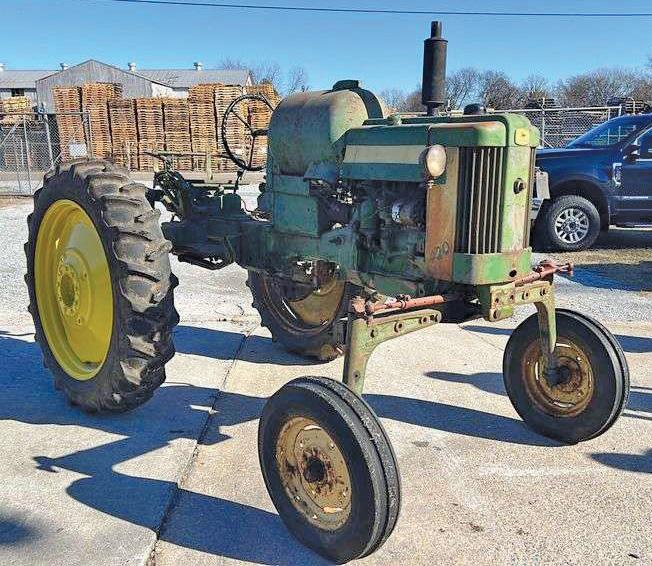
The first sale I found contained a couple interesting variations of the model 420. First let’s start with a John Deere 420 Hi-Crop LP gas tractor in running condition, serial number 127131. The tractor has 11.2 by 38 rears and 6.00 by 16 fronts. The “dash” has been welded but a replacement came with the tractor. It has a serial number tag stamped as being an LP standard version. It this is true, it would be one
of 23 made. The tractor appears to have been a 420 LP Hi-Crop all of its life which would make it one of five made! There seems to be no doubt the tractor is a true LP machine, making it unique and, at the least, quite a piece of tractor history. Price: $15,300.
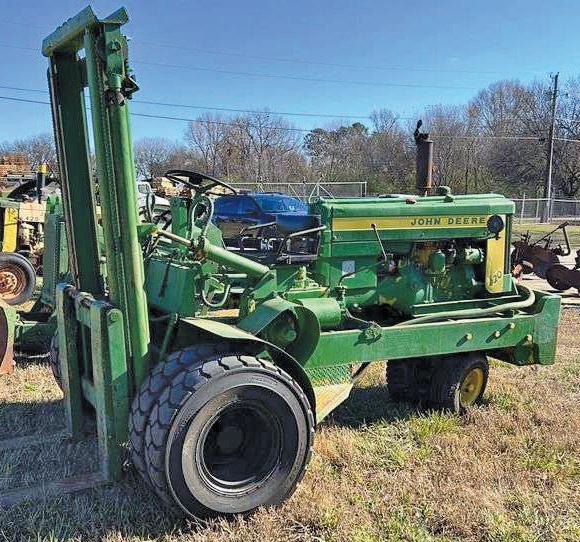
Next, a John Deere Holt 420 preproduction forklift! This is one of only three preproduction forklift tractors, serial number 131065. This machine features rear ballast weights, lights, and power steering. It has a HOLT stamp reading 58 01 3T, which is interpreted to mean that it is a model 1958 year, machine number one, and three ton capacity. Selling price on this one: $21,100!
How about we get just a little newer and talk about a 430 LP tractor with serial number 157172. One of my favorite features is often new tires, which this tractor has—13.6 by 28 rear tires and 6.00 by 16 front tires, like I said, brand new! Of course the little beauty has a five speed transmission, very nice paint job, fenders, live PTO,
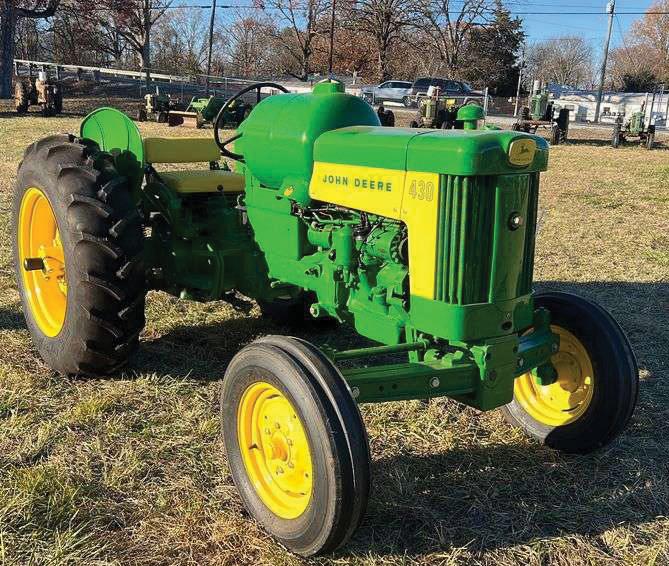
three-point hitch (missing center link), adjustable swept back front axle, and a tachometer that shows 679 hours. It is one of 68 produced. If you like 430s, you had to be in the range of the selling price of $8,600! These tractors were part of the Lee White Collector Auction conducted by Aumann Auctions.
As long as we are on the 30 series of tractors, let’s get a little bigger…a couple of 730s.
I may have seen a picture before seeing this one, but here is another unique machine! Here’s a John Deere 730 Argentina diesel in running condition. Serial number 316499, rear tires
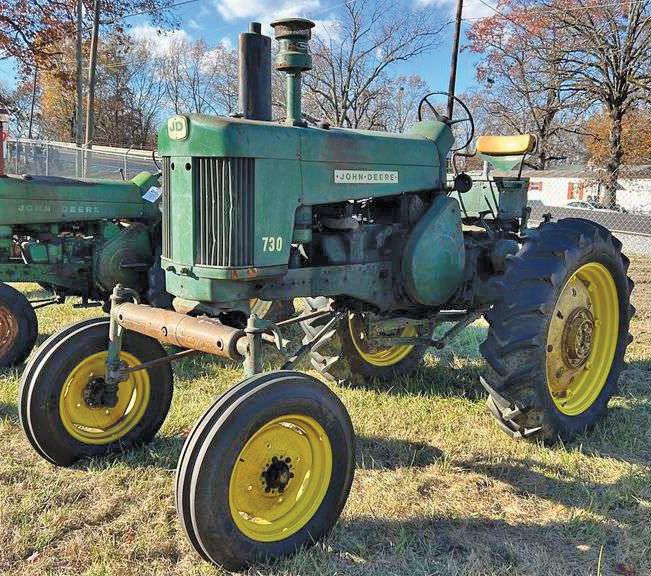
Page 52 May 2024 • Green Magazine
worn and 7.50 by 20 front in great shape! It has a three-point hitch missing center link, foot throttle, adjustable wide front. The tractor does have new rims all the way around. The high bidder on this one gave a bid of $13,000.

Moving right along, a 730 standard LP gas is next. Like the other 730, the rear tires are worn but the fronts are like new, 7.50 by 18. One of 220 produced, this one went home for a seemingly great deal of $5,200!
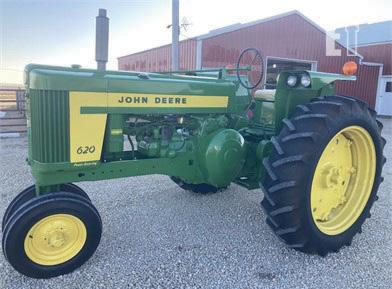
Next we have a very sharp 620 gas in great condition, working lights, with a complete overhaul. It was advertised as a parade ready machine! That’s why it fetched a price of $7,700. It was sold by Clemens Auction Company of Bernard, Iowa. We started with a couple little machines and now another, a 1954 John Deere 40, serial number 6778N. Featuring factory front weights, factory wide front, clam
shell fenders, nice paint, and working lights, this parade ready tractor sold for $5,500. Younger Auction Co. Inc. of Maryville, Missouri sold this one.
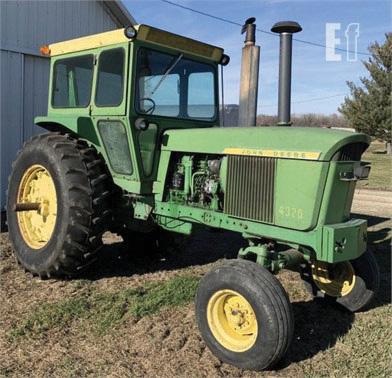
We can always look at a few new generation machines. Here is a 4320, serial number T613R018907R, with factory cab, Firestone 18.4-34 rears at 85 percent, two remotes, 540/1000 PTO, and 11L-15SL on the front. My favorite feature is it has only 1,740 hours since a full engine rebuild and nice original paint. What do you think about $20,750? I say someone is happy with their “new” 4320! Flesher Brothers Auctioneering & Real Estate, Inc. of Albany, Indiana was in charge of this one.
Now we will get a little newer and a tractor I have always wanted. It’s a 1977 4430 tractor. This one had a QuadRange transmission, two SCVs, three-point and looking nice. This one came from Bingham Farm Auction of North Vernon, Indiana. This one sold for $27,500. My wife is glad I wasn’t bidding at this sale!
came from Martin’s Auction Service in Shippensburg, Pennsylvania. The 1520 was made from 1968 to 1972 in Dubuque, Iowa or in Mannheim Baden Wurttenburg, Germany. In 1972, you could have bought a new 1520 for $5,300. The tach says 5,695 hours with the 2.7 liter three cylinder diesel engine, independent PTO, two post canopy. Someone got a good deal for a $7,100 bid!
Many years ago, in 1987, I was at an auction sale, looking for my first unstyled tractor. It was a 1937 “A” John Deere and, thanks to my dad, I brought it home for $450! It is one of my favorite tractors! Also on that sale
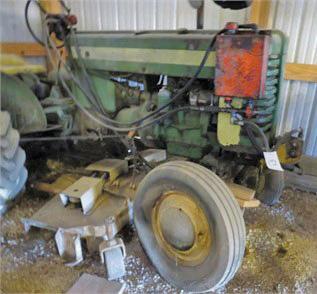
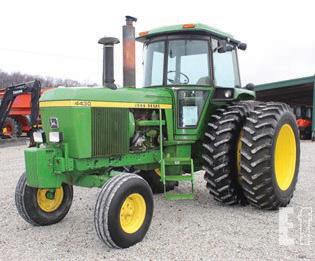
Let’s finish up with a couple of other little Deeres. First, a 1520 that
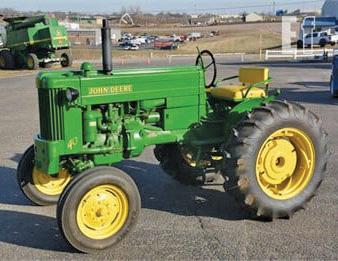
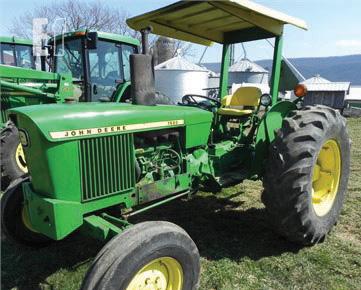
was a good running, cute little “M” John Deere. I kind of wished I had the money for that one, too. It sold for just over $2,000! Our last tractor is one of the little model “Ms.” I know it is getting late for a winter project but this would make a good one. It is not a runner but had a belly mower under it and would look good on your farm, in your backyard, or mowing on your acreage. Just a little elbow grease needed and maybe some time and money. Sale Barn Realty and Auctions in Pocahontas, Iowa sold this “fixer upper” for $1,000!
Thanks for a the emails! I have a couple of sales to watch, thanks to all of you. If you hear of anything, let me know at mickelsonauctions@gmail. com. Happy auctioning!
Email Eric W. Mickelson at mickelsonauctions@gmail.com
If you see interesting auction results for JD items, submit that information for possible publication. Email: mickelsonauctions@gmail.com or info@greenmagazine.com Mail: Green Magazine/Auction Highlight • PO Box 95 • Bee, NE 68314-0095 Green Magazine® • May 2024 Page 53


G’day, mates.
As we head into April, we are into the second month of autumn here in Australia. The rain has eased from what we were getting in my area, which has allowed the farmers to get back out on their fields. April is the time when winter crops are planted— wheat, barley, and chickpeas. Cotton harvest has also started in some areas, and with the abundance of moisture, it is sure to be a great crop!
After I arrived home from my Canadian working holiday, the bags were all unpacked and sorted. One item I brought home has so much meaning to me. When I was a child, I remember a toy tractor that I played with. It was my father’s toy tractor from when he was a boy in the 1930s. Since I am sure money was tight as it was the depression years, plus the fact that there were very few toy tractors to buy, my grandfather built a toy tractor for my dad. The tractor was made from wood pieces for the main body and axles, and steel wheels from possibly a piece of furniture or a door track. When cleaning out the shed in Ontario and going through items to bring, I spotted the toy tractor in the shed! It was sitting in a wall post brace of the shed. I checked it over and it was still in the same condition as when I played with it last in the 1970s. The front axle is designed to turn on a single nail driven through the wooden axle into the main body. The tractor’s appearance makes me think that the design was adapted from the unstyled
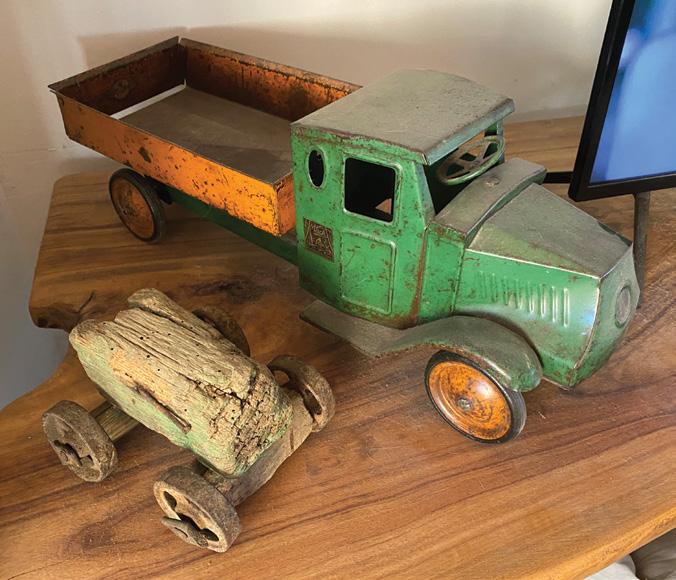
Dad’s toy tractor with the Mack truck.
John Deere “D” produced during that period. I decided that this toy tractor had to come with me. It was wrapped in bubble wrap and put in my suitcase. It arrived without any damage. The toy tractor is now on display here beside the Mack toy dump truck that my father-in-law had as a toy.
The week after I arrived back in Australia, I went right back to work as a training instructor. I got hit hard with jetlag and the time difference adjustment back to Australian time. Traveling from Ontario to eastern Australia, there was a 15 hour time difference forward. That means that when I was waking up at 6 a.m. at home in Australia, it was still 3 p.m. the previous afternoon in Ontario. I have been told that it takes one day per every hour of time difference to get your body clock back to normal. I will have to agree with that statement. A week into being back in Australia, I was exhibiting covid symptoms and
guess what? Yes, I tested positive for the first time since the pandemic mess started. That really did not hit me too hard, but it took another week to test negative and be good to go!
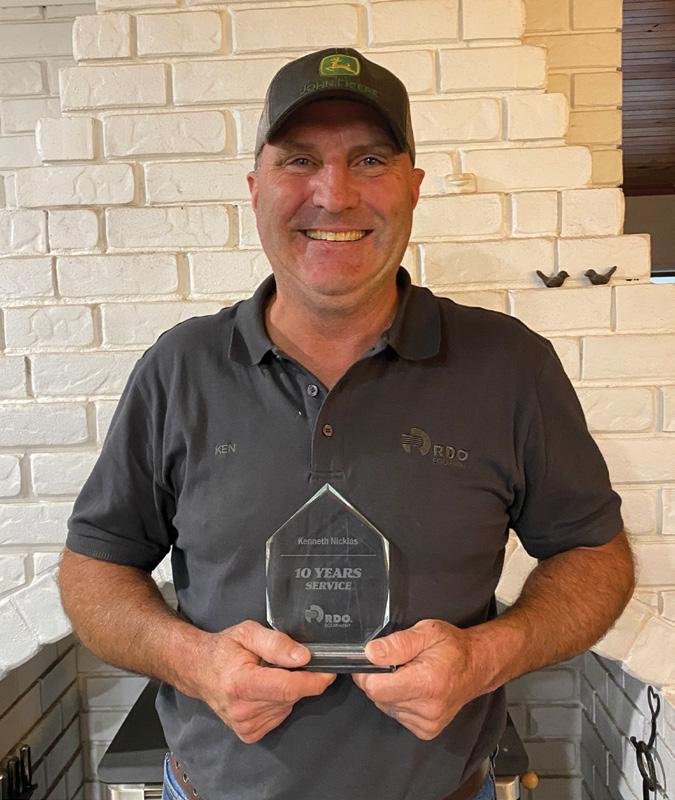
10 year award.
While I was in Canada, I passed a milestone at work. I started working at Chesterfield Australia John Deere in September 2013. This past September marked 10 years of employment with the company. Now, we are no longer Chesterfield, but all employees from Chesterfield and Vanderfield, the two dealer groups that were purchased and are now operated as RDO Equipment Australia had their employment time extended with RDO. I received a nice plaque to display.
Our daughter, Maris, arrived from Canada on November 4 to attend Griffith University for the bachelor of dental hygiene program. It was great
Page 54 May 2024 • Green Magazine
to have her move here for at least the next three years while attending university. She has also been hired at the local dental office in Beaudesert, where Janis has her dental work done. It is wonderful to have both of our kids here in Australia with us!
I was involved with getting ready for an upcoming testing competition for my company. The upcoming testing competition I was part of developing for the training department was for the inaugural RDO Awards. The best service technicians were chosen from our 29 branches of John Deere Agriculture, Construction, Forestry as well as Vermeer, which RDO in Australia is the distributor/dealer for. My job was to develop testing material and tractor problems for the testing of the agricultural service technicians. The testing material included questions and activities where the answers were researched and found in the John Deere online/computer program called “Dealer Path.” This online program covers all the technical resources for all John Deere equipment. Operators, diagnostics, repair and parts manuals, engine specifications, warranty information, and technical assistance plus more are all part of Dealer Path. The testing competition went over four days. The online research testing mentioned above was also combined with hands on diagnostic testing. The training department had the use of new John Deere tractors and a 348 small square baler for the testing. All tractors were given some “issues” by my co-trainer Ryan and me. These issues varied from electrical, causing the tractor to not start, to operational, so that the tractor would not operate correctly. The 348 baler components were marked with numbered stickers and a testing activity was for the technicians to look at the specific component and either write the name from memory or look up the parts from the parts or operator’s manual. When the competition finished, the total marks were calculated, and the winners were announced at the RDO Awards gala dinner in Brisbane. The winner of the agricultural testing was Dann from our
Toowoomba, Queensland store. When Dann received the award, he told the audience of 350 RDO staff member from all departments that the testing that Ryan and I developed was the most challenging and best training/ testing he had been involved with. It sure made me feel good that all our efforts were worth it.
When the sea container full of our vintage tractors and personal items left our former farm in Ontario, I was nervous that the items might not make it to Australia. I had seen too many videos and pictures of sea containers falling off ships into the ocean. My importer had emailed me the arrival date for the container in Brisbane was November 18. The specific “Maersk” sea container number was on all four

sides of the container. I was able to locate the container on the Maersk system website and follow its journey to Australia. The container left the farm by truck and was delivered to a yard in Toronto, Ontario. There the container was loaded on a train and transported south to Philadelphia. The container was loaded on a ship there and sailed towards Australia.
There was a delay for the ship at the Panama Canal. I was told by Facebook experts the delay was due to several factors, including low water levels in the canal and the Panama government, holding shipping companies ransom for crossing through their country. The ship was docked/ anchored for several days, and then it continued through the canal. I was able to track the ship which stopped in New Zealand, followed by a journey into the port in Sydney. The manifest I was given said that the container was to be unloaded in Sydney, and then
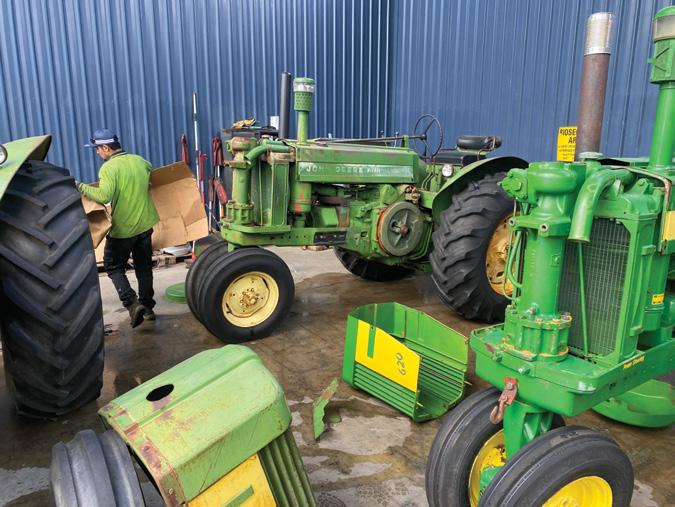
Nose/grille sections removed for rewashing.
reloaded onto a smaller ship to travel north to Brisbane. The date that the ship was to arrive in Sydney came and went. A couple days later, my importer emailed that due to labor issues at the port in Sydney, the ship was rerouted south to the port in Melbourne and unloaded there. My importer told me they had the same port labor issues in Melbourne. The container had to be transferred to another yard where there were no labor issues so that the container could be reloaded. The container then sat in a Melbourne dock yard for several days. Finally, the container was reloaded and sailed north to Brisbane with a new estimated time of arrival of December 1.
I was able to follow the ship’s progress north to Brisbane. A check of the sea container number in their system showed that it was listed as discharged from the ship in Brisbane on December 3. On December 4, I received a phone call that I was not expecting. I mentioned in a previous article that my right hip joint was in poor condition and in need of a replacement joint. The phone call was from the surgeon I was working with for the replacement operation. I was informed that an opening was available to have my hip joint surgery on December 24 and wanted to know if I wished to proceed! Of course, I agreed to this, as I had been on the waiting list for three years with another facility. I informed Brett, the importer, about my upcoming surgery and asked if the contents of the container would be cleared by customs for pickup by December 22. I did not want to be doing the transporting the day before my surgery. Brett informed me that it
110s waiting to be rewashed.
Green Magazine® • May 2024 Page 55
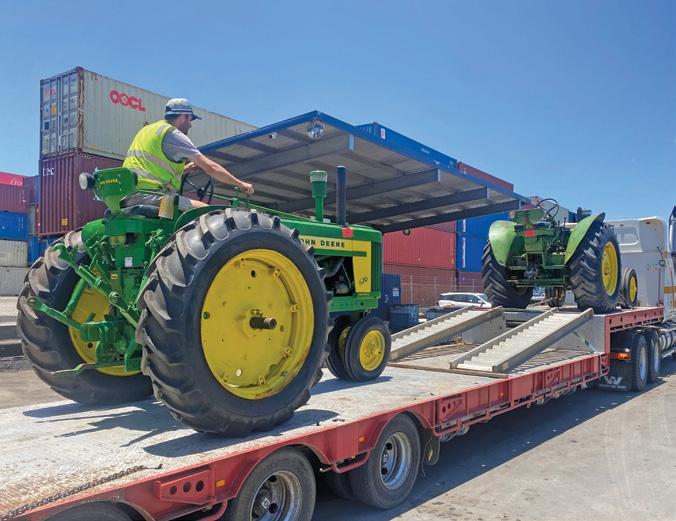
should be ready well before December 22. I contacted a local farmer, James, who had a truck and float suitable for picking up all three tractors. He agreed to do the work and we kept our dates open.
As the week went by, Brett kept me up to date on the container status. He informed me that he had called customs several times, and had been told by customs we just have to wait. It was on “customs hold,” so that usually means that the container would be put through an xray machine to check the contents. Finally, at 3 p.m. on December 11, customs released the container so we could proceed. On December 12, I had a consultation appointment with my surgeon and the surgery date was moved forward to December 21. Brett informed me that we should still be cleared to get everything home by December 20. He also sent pictures of the tractors and all the spots of dirt we missed when washing them in Canada. I understood that this was a necessity for inspecting and a secondary washing would need to be done. At 1 p.m. on Friday, December 15, I received a call that the personal items could be picked up that day, but the warehouse where the items were unloaded and inspected closed for business in two hours, so it was not possible to pick up the items that day. The plan was set to pick up what was cleared on Monday, December 18.
I arranged for several helpers and their vehicles to assist, and we all arrived at the warehouse site at 9 a.m. on the 18th. The personal belongings were all arranged neatly on top of pallets under cover in a warehouse. A quick check over and everything appeared to be in good condition. We
loaded everything that was cleared on the trailers. The tractors and parts that I had packed that were not cleared were in “secondary inspection,” which was in the next building. The tractors and parts all looked like they arrived damage free. The tractors were parked on a wash pad so that they could be quarantine inspected and then rewashed by the warehouse staff. The warehouse employee in charge of washing asked for my phone number in case there were any issues. We left and got back to our place and unloaded all the items. On the 19th, the warehouse employee texted me; the inspectors had canceled their inspection for the 20th and was unsure when the tractors would be cleared. Brett also contacted and said that clearance might not happen until after Christmas at this point.
December 21st came, and I had my hip joint replacement surgery. After I came out of recovery, all joint pain was gone. I received an email and a
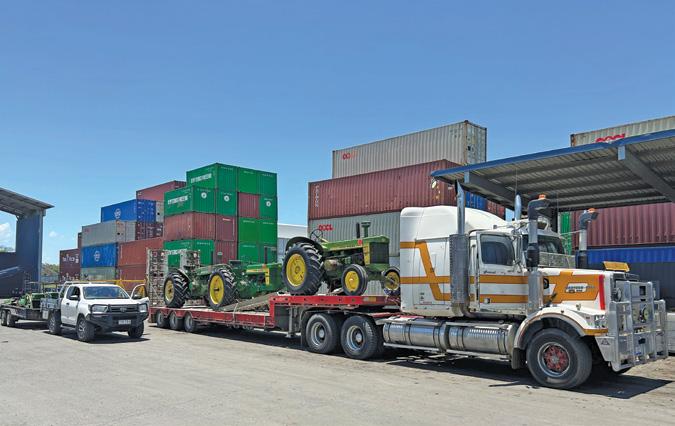
All loaded and ready to leave warehouse.
text while in my hospital bed that the tractors and parts had been cleared for pickup that day at 3 p.m. It was terrible timing as I was out of commission to do the work myself, but I had help arranged. The following day in the hospital, with the assistance of a walking device, I was up walking on my new joint! I did so well that they sent me home from the hospital on December 23!
Christmas was a great time for us all. Maris was here to join us, my hip was repaired, and soon the tractors would be home. December 28th was the big tractor moving day. Our son, Kyle, jumped in the truck with our friend, James, our friend, Frenchie, drove my Ute with me as a passenger,
hooked onto Kyle’s work trailer and away we went. We met my coworker Ryan with his Ute and trailer at the warehouse and got the parts and 110 lawn tractors loaded on the trailers and Utes. I was only able to be there as a supervisor and morale support, making my way around with a wheelie walker.
We had a little challenge getting the tractors started. The 620 fired right up, stopped and would not restart. I took the plug out of the carburettor bowl and no fuel came out. We removed the automatic fuel shut off assembly and found the intake port plugged with fine debris. Once it was cleaned out, the 620 fired right up. The cranking engines on the 720 and 820 offered some resistance due to battery and fuel issues, but they did start and then started the big engines. Kyle did a great job starting and driving all the tractors onto the truck float. Once everything was loaded, we headed for home and arrived shortly after 1 p.m. Kyle and James unloaded all the tractors and Kyle parked them in the yard behind the house. Ryan, Kyle, and Frenchie got the Utes and trailers unloaded. At the end of the day, I was tremendously grateful for all the assistance and very relieved that all the shipped items were home!
That’s all for this month. Stay tuned for more tractor stories and adventures in upcoming issues. I hope the readers in the northern hemisphere are experiencing a warm and successfully crop planting season.
Until next time—cheers, mates!
Contact Ken Nicklas by email at kenanicklas@gmail.com
Kyle parking the 820 in the back yard.
 Kyle loading the 620.
Kyle loading the 620.
Page 56 May 2024 • Green Magazine

Does cardboard box beat bicycle button?
What Brought More? this month—the cardboard box from a John Deere roller chain extractor tool from the 1950s or a single John Deere bicycle button from the 1890s? The seller says they purchased the chain extractor in the 1950s to use on all of the chains on their corn dryer. The tool is long gone, but the box remained in a bucket in their attic. The box looks quite good and has a nice image of the tool on it, as well as green and yellow text and the Deere trademark.
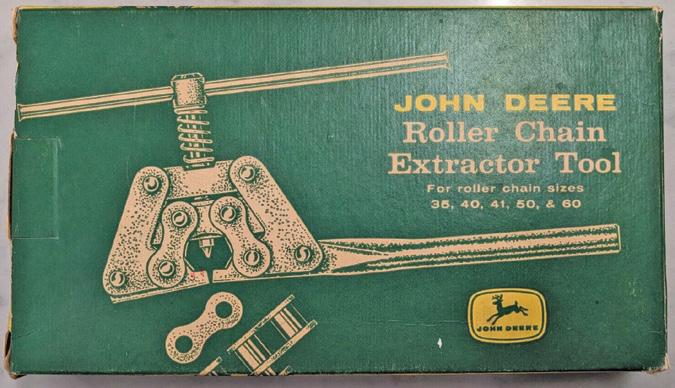
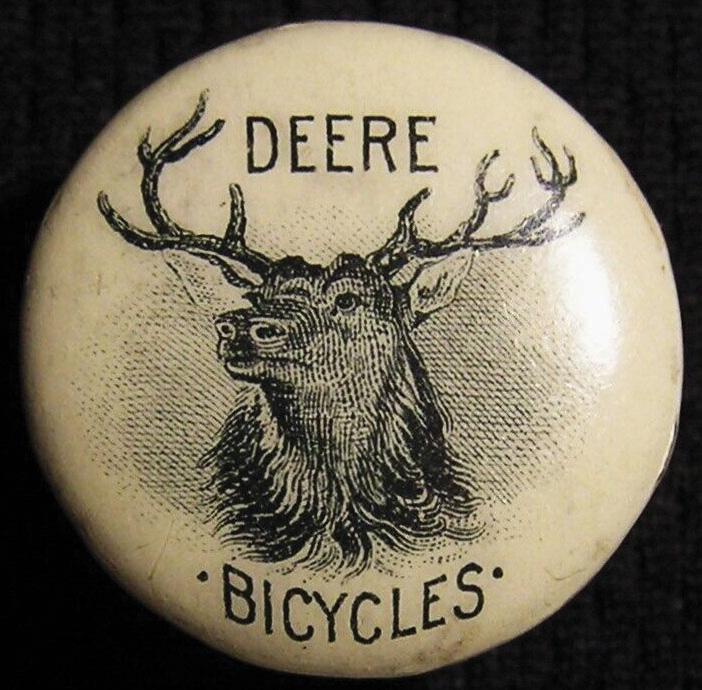
The button is a small jacket button about the size of a nickel. On the front is a detailed drawing of a deer with the words “Deere Bicycles.” The quality of the little button is quite good,
with the only damage appearing to be a few small splits on the edge on the back side of the button. Deere bicycle collectibles from the 19th century are quite rare and a little, easily lost or thrown away item like this must be scarce these days. Do you think it brought more than the cardboard box? Find out at the end of the article.
Tired of having to burnish your fingernails on the warp and weft of your jeans? Carry this nail file from a Deere dealership and you won’t have to any more. For the centennial of the small town of Secor, Illinois, a nearby dealership handed out these gold nail files. It looks great and basically like new. It brought $32.
Another small town, Hooper, Nebraska, held a dealership that gave a little something away in about 1940. This small book of very fancy matches has survived, like new, to today. The matches have the image of a tractor printed across them, and the match book looks nice with an old trademark on it, as well. They don’t make them like this any more, and surely most of the ones that they have made have literally been burned up. That explains why this matchbook would be worth $49.95.
A small, 5-1/2 by 3 inch clipboard sold on eBay this month. This clipboard was probably a gift item from Thiessen Implement of Fairbury, Nebraska. The

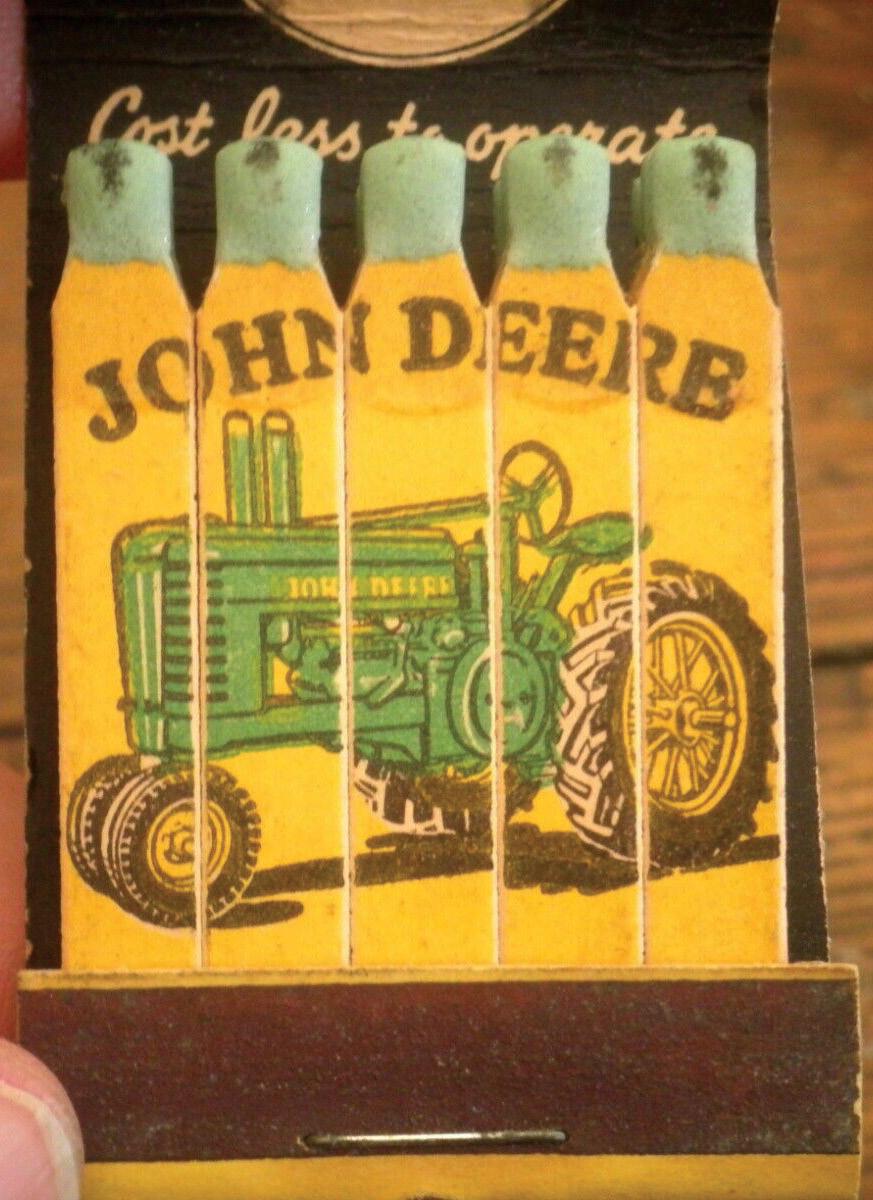
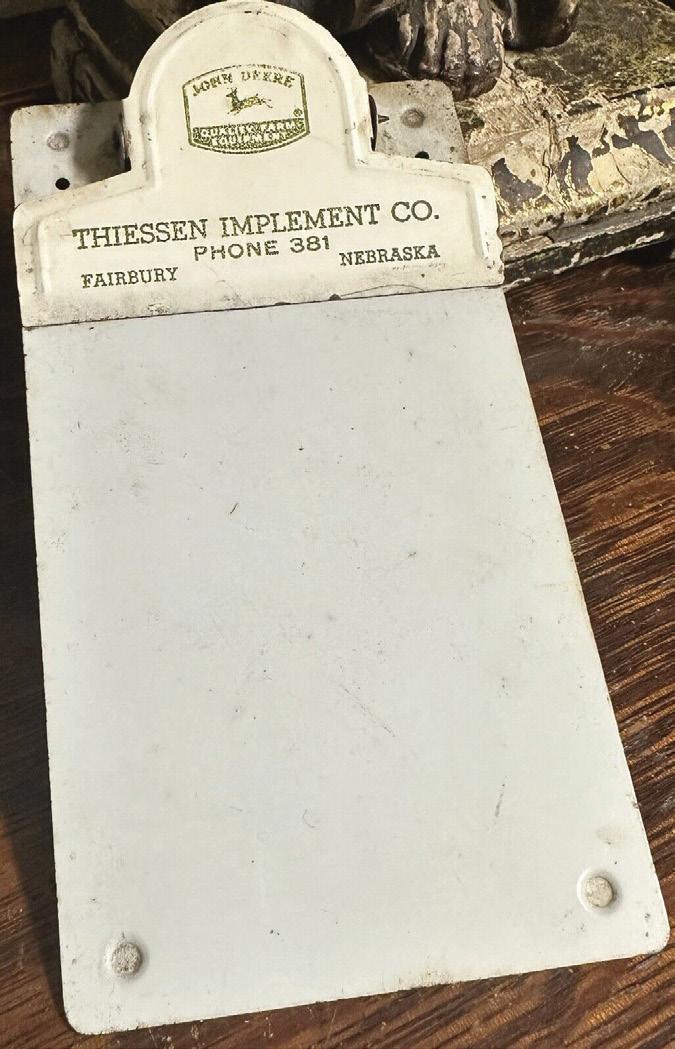
clipboard is white with green printing on it, including the Quality Farm Equipment trademark. The whole thing is a bit faded and worn, but it’s not too far gone to display or even use. It might make a good place to hang reminders or a shopping list, for instance. The seller got $125 out of this.
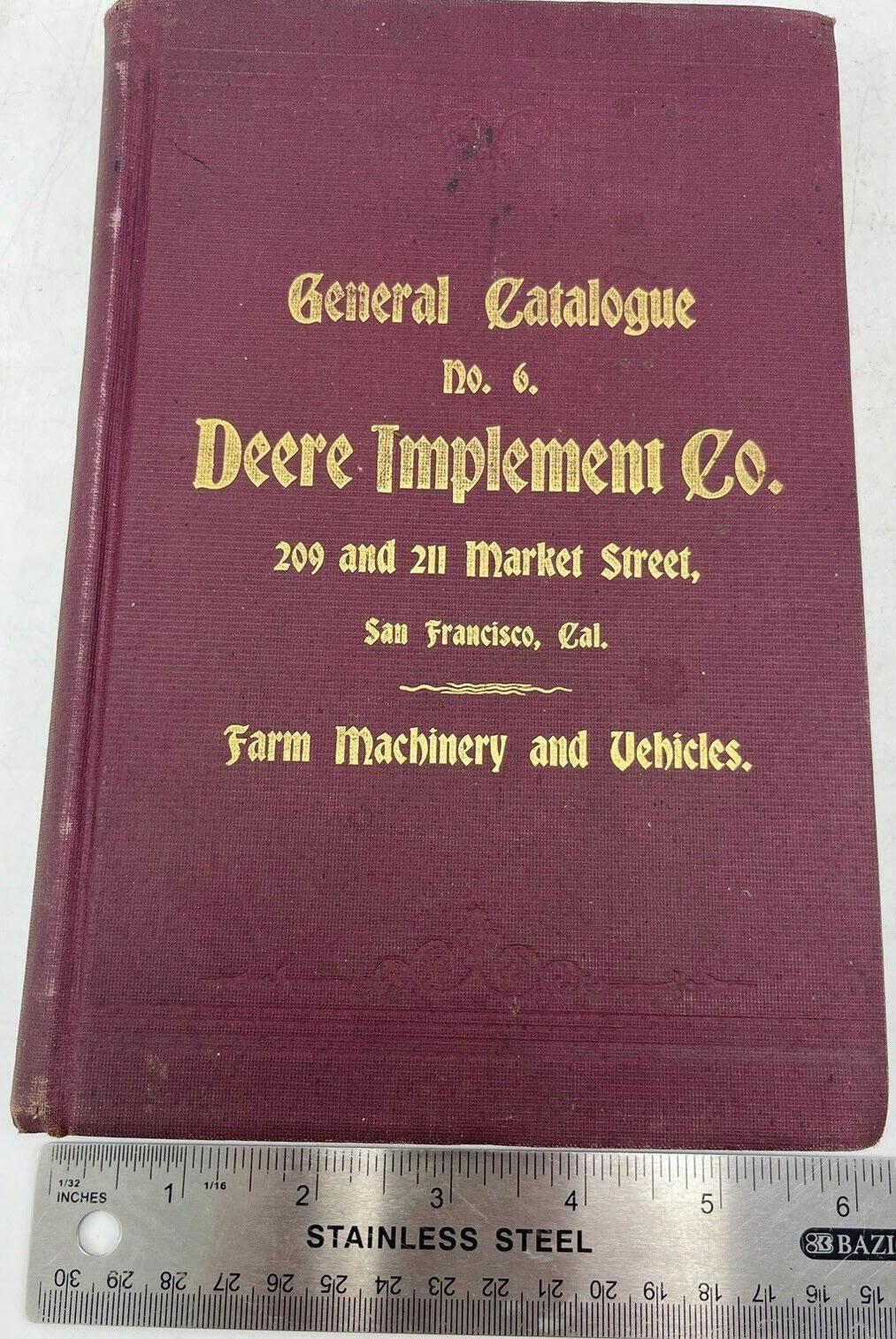
General Catalogue Number 6, from around 1900, is filled with Deere’s farm machinery and vehicles. The book includes great hand-drawn renders of Deere’s products along with selling points and prices. The book is in very good condition, particularly for the age. It is a neat old book, full of tools and equipment that are rarely seen today, even by collectors or at shows, largely because of its age and long obsolescence. This is a book that shows a glimpse into a bygone era, and the $909.99 sale price is explained by that.
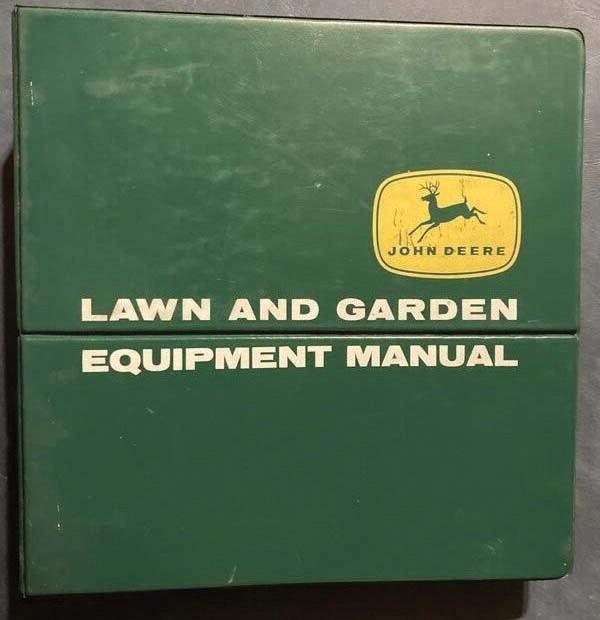
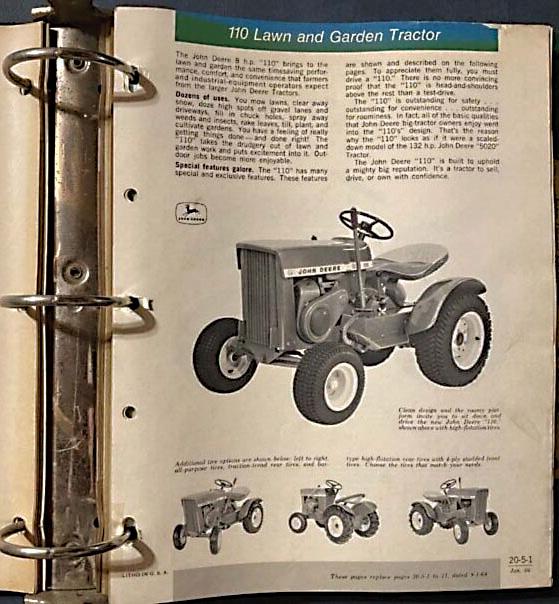
Want to know all about the 1964 lawn and garden tractors? This equipment manual has all the information you need. This book was the bible for dealers that year. It outlined the features and benefits of the 110 tractor and the tools and equipment that were made to go along with it. The seller did not state just how many pages were in the book. It is a three-ring binder in form, and is in good condition. There is a bit of wear and staining on the front and some of the pages, but none so much as to obscure any part of it. It sold for $611.98.
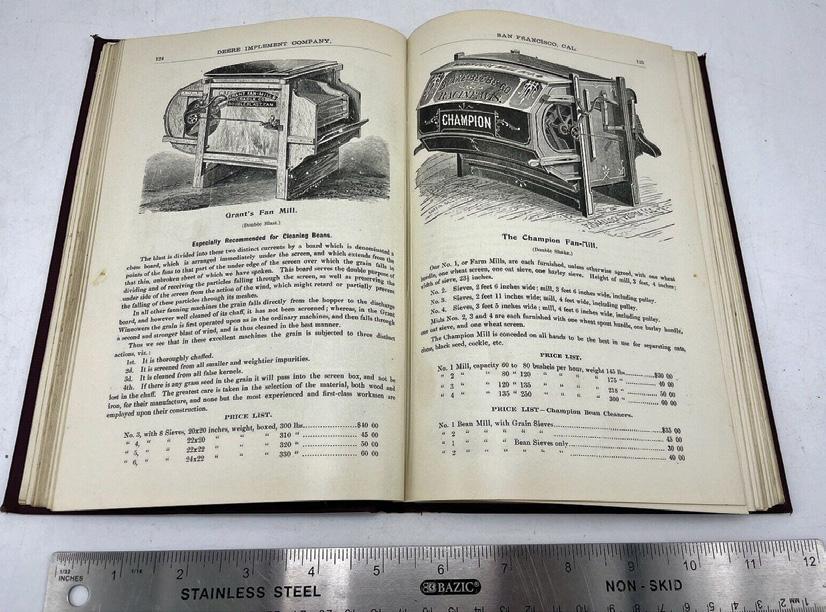

This book was for public use, as compared to the previous one, which focused on information for dealers. This book also displays the 110 and the tools and equipment manufactured for it. The condition was good. It brought $36.99. Moving forward a couple more years brings us to this 1967 model 20 pedal tractor. The seller says that his grandfather bought it for him. The seller
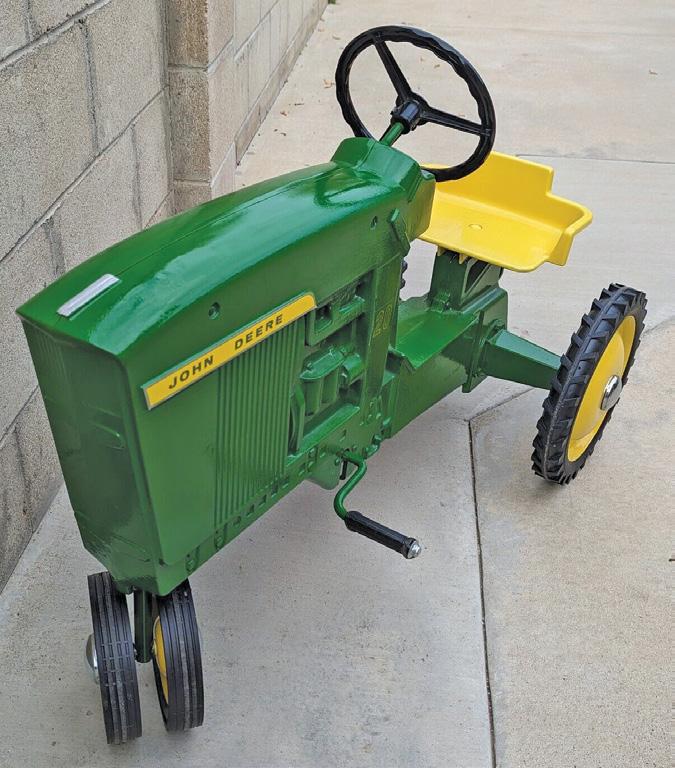
played with it, as did his children and grandchildren, and now it has been restored and is for sale. The tractor looks great. It looks like the restoration was carefully done. It took a few attempts to sell this for a price that the seller was happy with, which is understandable, given the history that he has with it. It finally left the family for $570.
A smaller, simpler lawn and garden brochure for 1965 also sold on eBay this month.
A complete Behlen overdrive kit for a four-speed model “A” was put up for sale this month. This set was apparently removed from a tractor, but the parts all look to be in very good

Page 58 May 2024 • Green Magazine

condition with little wear. Anyone who wants to take an old machine to a tractor drive might want one of these sets, which adds two gears to the top end of a four-speed transmission for higher road gears. They were a fairly popular aftermarket kit back in their day, and are still desired by collectors. It sold for $711.51.
A very nice 1938 John Deere “G” showed up on eBay this month. This tractor has been rebuilt and restored and, the seller says, runs very well. The tractor sports French and Hecht rear wheels and Electric Wheel Company
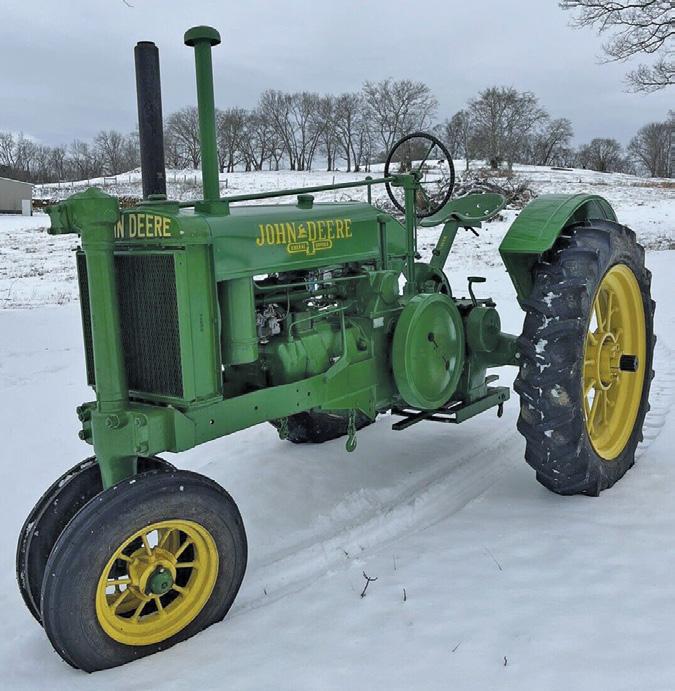
front wheels, putting round spokes on all four corners. The seller says it just needs to be shined up and will be ready for a parade. The tractor was located in Tennessee, but the seller was willing to help to get it shipped somewhere as needed. The photos did make it look quite nice. It brought $7,800.
Now, back to What Brought More? to find out…umm…what brought more. The box for the train extractor looked quite good but was a bit lonely without the tool. Still, it is not a common tool and the box is even rarer, particularly when in good condition. Could that be why it brought $510? The button was absolutely tiny, but it also benefited from its rarity and the fact that it is over 125 years old. I would also argue that it had a bit more practical use, but on the other hand, would have been more difficult to show off. The button brought $495. In the end, it lost to the chain tool box, but both items brought very high final values, don’t you think?
See something interesting on eBay? Forward it to sawitonebay@ yahoo.com

Green Magazine® • May 2024 Page 59
New, used & reproduction
Crawler parts: Lavoy Wilcox
JD CRAWLER PARTS
Steering clutch parts, brake bands, bearings, final drive gears, engine kits, carb kits, radiators, fans, water pumps, battery sheet metal, seat cushions, gauges, light switches and more www.jdcrawlers.com
Lavoy Wilcox • Horace, ND Phone 701-361-1006 • 8-5 CST No Sunday Calls
For Sale
F486R unstyled G head (7100-12000 SNs), $800. C1701R big bore GP head, tested, $1200. F&H 32" round spoke rear wheels for 6 spline D with new tires and tubes, ultrarare, $4000. Two pair F&H 28" round spoke wheels for 6-spline D, $1500/pair. Two old wooden JD manure spreaders on steel wheels, $800 for both. Also, several early JD grain drills. Several two and three bottom plows, $750 each. Ph. 303-877-7641. CO

Rates: 50¢ per word, minimum charge $5 classifieds limited to 200 words ($100)
Photos: $40 per photo 2-1/4 inches wide or $20 per photo 1-1/4 inches wide
Discounts: 10% off for any ad running in three issues. No material changes allowed; payment must accompany ad
claSSiFied & diSplay ad inFo
•Green Magazine is mailed about the first of each month.
•Only John Deere items will be advertised.
•Positioning of ads is at publisher’s discretion.
•Green Magazine will not print any ads which it considers to be:
•offensive or proven to be dishonest;
•from competing publications or organizations
Phone 402-643-6269
Email: info@greenmagazine.com
Website: www.greenmagazine.com
Mailing address: Green Magazine, PO Box 95, Bee, NE 68314-0095
973 Corley Rd. • Manns Choice, PA 15550 814-733-4397
www.dillnerstractors.com
1952 John Deere A. Restored. $3000. Ph. 608-468-2236. WI
1928 GP. GPO. GP Beaner. AOS. W-111 engine. Brass tag BO. Unstyled BN. M. MI. L (orange). LA. 40-U. 40-S. 420-S. 430-S. Ph. 269-461-3449. MI D3X
John Deere 1972 4020 Hi-Crop Syncro. 4030 gas. Ph. 563-580-5321. IA
MT, repainted, good tires, overhauled, starts and runs good. $2900. Ph. 616-8365837. MI

diSplay ad RateS
Full page: 7-1/4” x 9-1/2” ........... $800
Includes full color • Limit 800 words
Half page: 7-1/4” x 4-1/2” $450
Includes full color • Limit 400 words
Quarter page: 3-1/2” x 4-1/2” ... $250
Includes full color • Limit 200 words
Business card: 2” x 3-1/2” $125
Includes full color • Limit 100 words
2 column inch: 1/12th pg. $85
Includes full color • Limit 40 words
Bordered ads: per column inch .... $30
Full color, add $25 per photo
Limit 20 words per column inch
1976 John Deere 4430 in excellent shape. All original. Quad transmission, 3-point. Good cab interior with air ride seat. $22,500. Ph. 605-228-6230. SD
John Deere 4440 and 4050 Hi-Crops from California, excellent condition. John Deere gas standards, originals: 730, 720, 630, 70. John Deere 620 gas, Hi-Crop, restored. Ph. 763-434-6547. MN
1936 JD A, on rubber, $3000. Set of dual steel wheels for the '36 A, $1500. JD 80, $12,500. Ph. 320-905-2536. MN
Payment
• All ads are to be paid in advance. Ads sent without payment and needing to be billed will be assessed a $4.00 service charge.
• Classified ads will be taken over the phone, if accompanied by a credit card payment. We are not responsible for errors in ads taken over the phone or for illegible ads received in mail. Display ads will not be taken over the phone.
• We do not send checking copies or tearsheets. Send $6.00 extra for a copy of the issue in which your ad appears.
Discounts
1) 10% discount - for any ad running in three consecutive issues. No material changes allowed. Payment for entire ad run should accompany ad.
2) 5% discount for camera ready - ad must be typeset, clear and at the proper size.
3) 5% cash discount - payment in full by check, without being billed.
Word limits
When preparing display ads, please take note of the word limits. We can place only so many words into a given area and still make a readable ad. If ads exceed word limits, advertiser will be billed for extra space.
Paul's Rod & Bearing Since 1952 PAUL’S ROD & BEARING Specializing in JD babbitt bearings Let
816-587-4747 6212
Bell Road Parkville,
64152 Dillner's Tractors Excellent reproduction TOOL BOXES ALSO: New Generation tool boxes • GP, D & LA brake linings • Carburetor rebuilding • H773R dust shields • Clutch brake pads • Governor springs
DILLNER
us repour your rod & mains for models A, B, D, G, H, L & LA Ph.
N.W.
MO
BOB
CALL or see website for more info A thru 730D
Page 60 May 2024 • Green Magazine
• Two Cylinder diesels—our speCialTy
• CompleTe Two Cylinder diesel
• Fuel injeCTion repair and CalibraTion
• Cylinder bloCk boring up To 8”


We also have good sources for aftermarket products for two cylinder John Deeres including Taper-Lock flywheels, engine parts, grilles, battery boxes, manifolds, mufflers, pony motor ignition parts, etc.
• 2 cyl. & later JD air cleaner conversions, Lindeman through 430C trunion bushings • 70-830 diesel piston kits in stock, STD, .045, .090, .125 os
Renaissance Tractor

1959 JD 830 2 cyl. Recently professionally refinished with urethane automotive paint. Has dual remotes and factory foot throttle. Custom made rear rims stepped up to 38 inches, has 18.4 by 38 radial tires. Comes with front weights and two sets of rear wheel weights. Pulls as well as it shows, trophy winner doing both. This tractor is in excellent condition. $22,500. Ph. 717552-1772. PA

1959 730 diesel, has 3-pt., narrow front, electric start, fenders, new tires, looks like new, $15,000. 1957 720 diesel, wide front, gas starting engine, new tires, fenders, $12,000. Ph. 815-383-7563. IL

Two 3/4 RD yellow spoked wheels off of a model G, $1750, David. Ph. 507649-0392. MN

Fender grommets – part #R44619 and #R44621, left and right side for JD 4520, 4620, 5020, 6030 with roll bar and fenders. $149.95 per set plus freight. Ph. 712252-0423. IA C3X
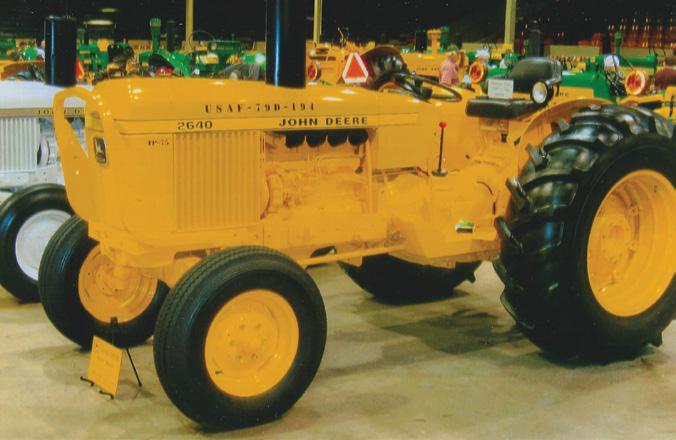
1979 John Deere USAF 2640 diesel, SN 2640A331374T, one of only 44 built for USAF, have 8 pages of government documents on this tractor, fully restored, has won many awards at shows all over the Midwest and featured in many magazines. Ph. 402-269-5059. NE
Danbury Mint John Deere doll collection. Set of 9 dolls complete with boxes, certificates, and all tractors/accessories. Mint condition. Pictures by request. $500 for entire set. Ph. 231-328-4246. Northern MI.
1938 JD A, complete tractor including shutters and grill screen, runs, older paint, great restoration project, located near Burnsville, MS, $3000. Call Jim after 5 PM, ph. 865-607-1190. MS
Dealer signs. Men's green bicycle. Arcade and Ertl toys. Operation, Care and Repair farm machinery books. Sales literature. Memorabilia. Ph. 269-461-3449. MI D3X

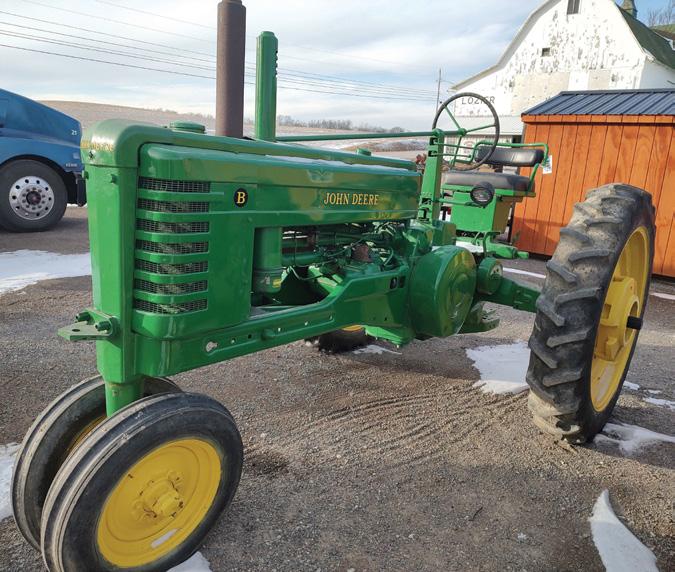
John Deere B, one remote, like new 38” tires, excellent sheet metal and paint. $2850. Call 330-806-0145. OH
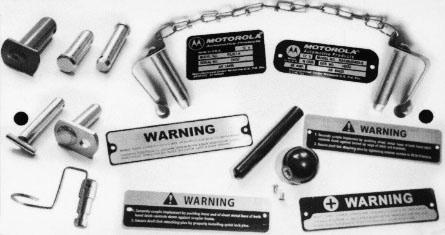
Reproduced aluminum WARNING PLATES for 3-pt. Quick Hitches. Motorola alternator and amp regulator plates, 35-55-72 amp. Hydraulic cylinder stop pins with chains, spring steel clip, like original, three sizes – 3/8,” 7/16” and ½.” Ph. 712660-8447 cell. IA E3X

530, runs great, fresh paint, and decals, $7500. Ph. 616-836-5837. MI
Crenlo cab for sale. Came off John Deere 5020. Condition is good, back window is missing but everything else is there, $500. Call or text for pictures, 413-774-0348. MA
120 Cabe Road • Chehalis, WA 98532 800-784-0026 • 360-748-0026
Green Magazine® • May 2024 Page 61
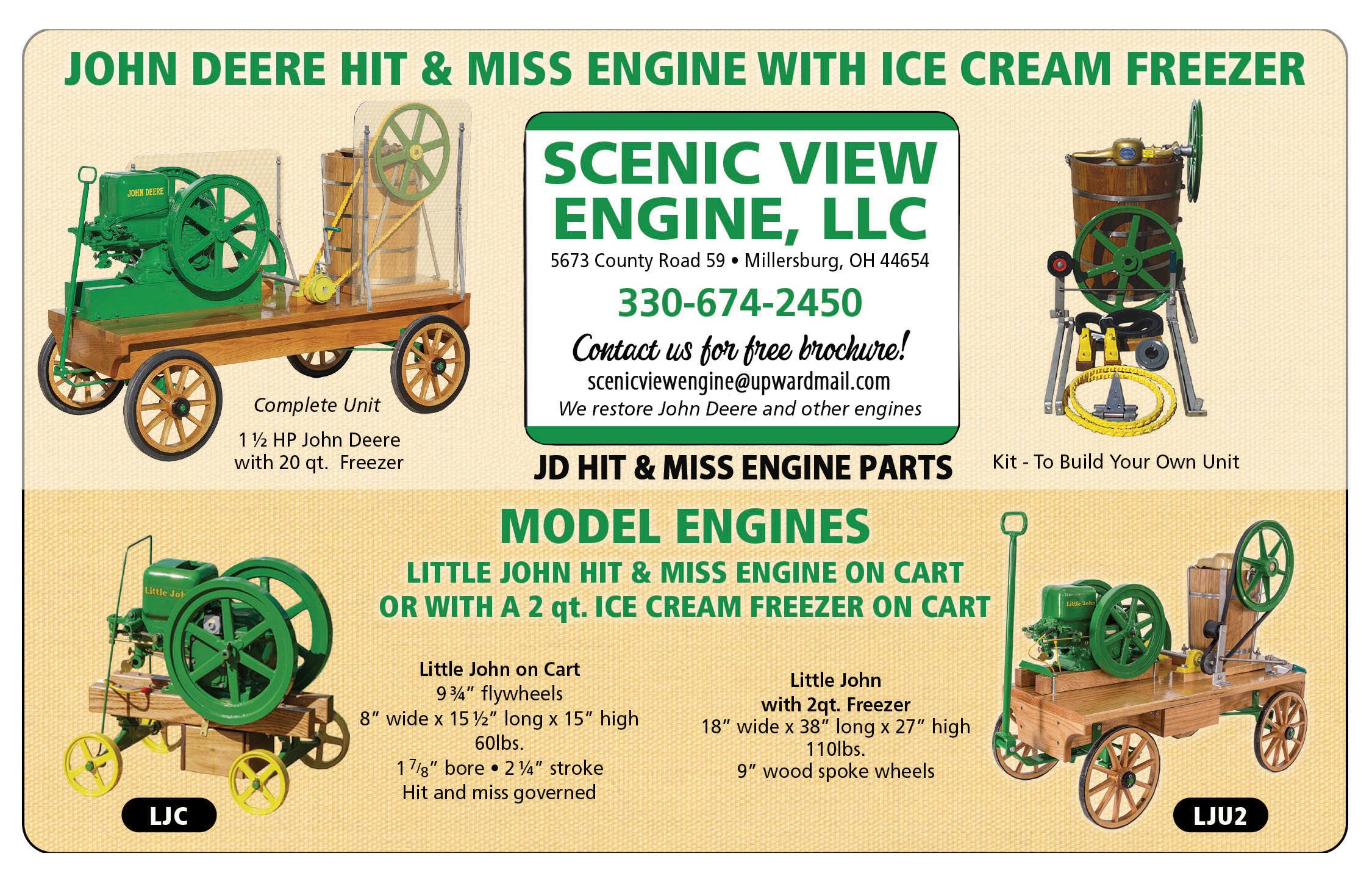
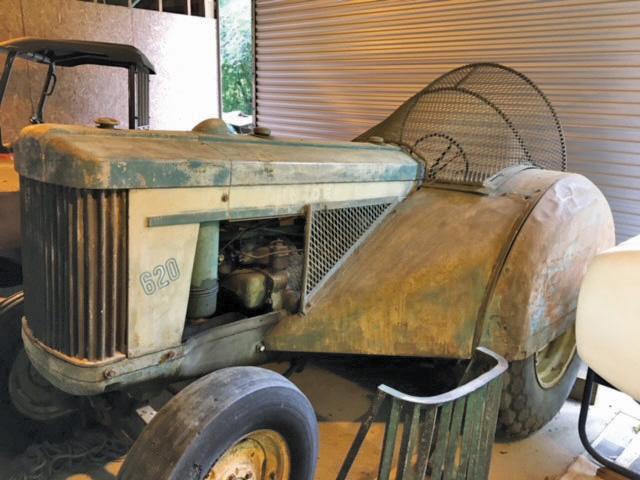
Five John Deere orchard tractors (2 currently run) with various original misc. parts and rear rims. All tractors (except 1) include the original serial numbers, $15,000. Ph. 813-545-6160. FL
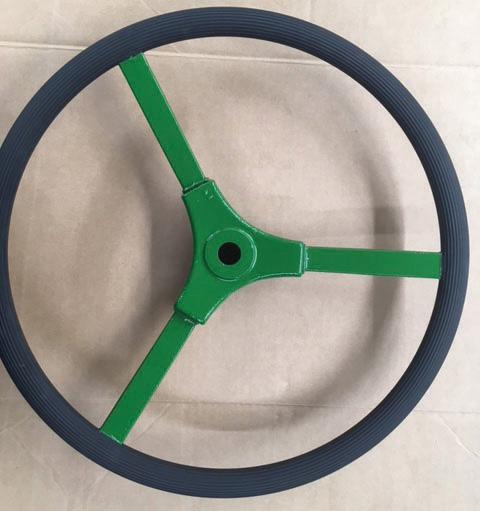
Recovering original tractor steering wheels for 14, 15 and 17” three spoke flat or round wheels, $95; 19” four spoke wheels, $110. Please send your core or call for information. EverGreen Restoration, W7619 Walnut Dr., Spooner, WI 54801. Ph. 715520-7876. Made in USA. WI C3X
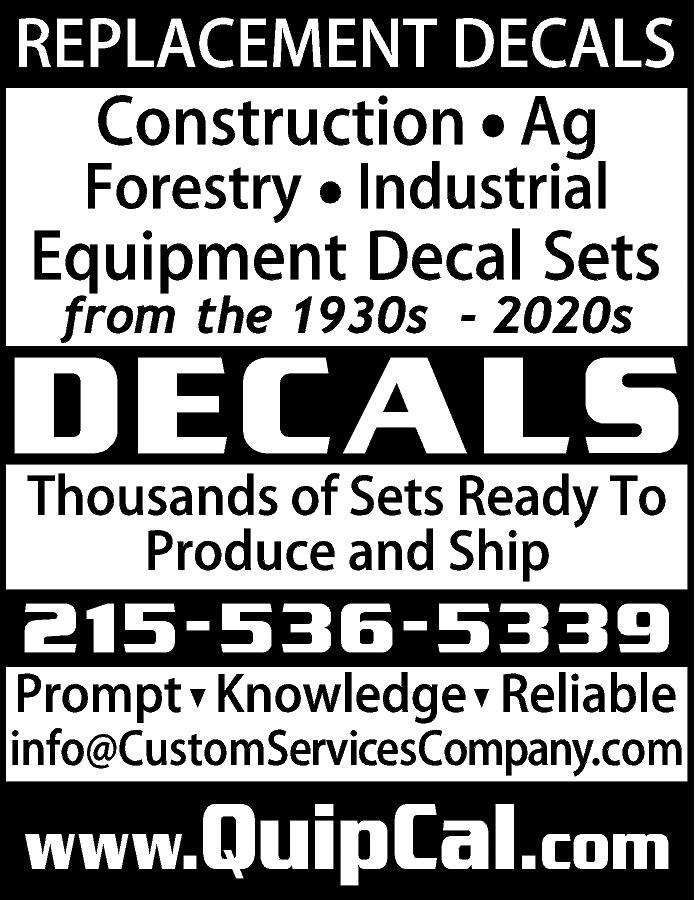
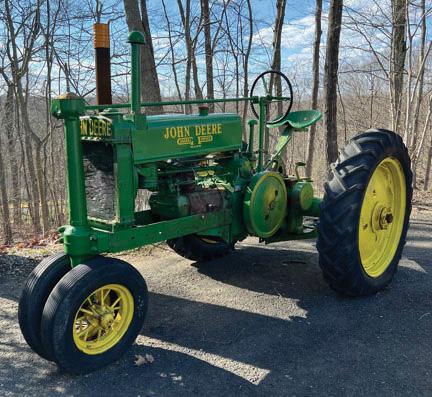
1937 JD A, nicely restored years ago, runs well, needs a new front tire, $3200. Ph. 203-522-7352. CT
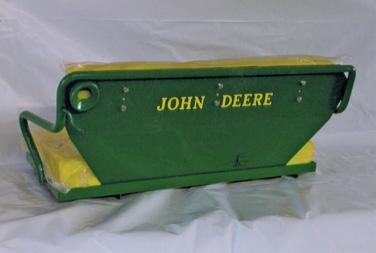
Buddy seat! For 20 and 30 series two cylinders. Will fit float ride seat or bat box. Looks like the original buddy seat! $475 plus S/H, includes cushions. Ph. 260-901-3076. Callaway Restorations, IN. E3X
JD #46 loader with forks off of a 3020, $1500. Ph. 303-877-7641. CO
1010 orchard. 1020 orchard. 1020 vineyard. 2020 vineyard. 1020-V w/sidewalk snowplow. 2030 orchard. 2255 orchard. 2240 orchard. 3010 utility. 300 turf. 301 turf. 401-C Pipeliner. 4230 open station. Ph. 269-461-3449. MI D3X
1929 GP, SN 209327, factory round spokes, newer front tires, drove it in the barn after plowing years ago, older restoration, with research document. $1800. Ph. 262-2523187. WI
JD X720 mower deck, 50" A1. Ph. 217-3475429. IL
1949 JD AR, WF, SN 271195, new tires, 12 volt, many new parts, runs, painted, $1000. Call 507-896-8826. MN
Parting out JD M-MT-40-420-430 and A-B50-60-70 tractors. Call us for new, used and reproduction/replacement 2 cylinder parts. John Shepard, 715-265-4988. WI
720 gas, NF, repainted. 3020 gas, PS, utility, original. 1020 row crop utility, gas. 4520 PS, original, good condition. 4320 w/cab and air, very good condition, two owner tractor. Two 4010s. Two 4020s. 4320 open station. For pictures and prices call, phone 712-269-1700. IA
1936 JD B, starts and runs good, like new tires, new paint, very good shape, $2100 OBO. Ph. 712-209-1916. IA
JD 2510 parts tractor. Schwartz wide front, $550. Late model 3020 hood. Ph. 419-8951183. OH
1959 530, tricycle front, restored 3 yrs. ago, new tires, paint, engine rebuilt, lights, wiring. 2 Cyl. Club expo quality certified, runs and looks great, pics available, $8900. Ph. 301-305-4770. MD
JD 630, repainted, runs great, new Firestone tires, $6500. Ph. 616-836-5837. MI
JD A, Hi-Crop, old paint, runs nice, $12,000. Two JD 730s, gas, NF. One with old paint, $7500, one with new paint, $9500. Both run nice. Ph. 717-284-0480. PA
Page 62 May 2024 • Green Magazine

Fuel gauges for John Deere 2 cylinders with original face. Six or 12 volt positive and negative ground comes with new fuel tank sending unit. $135 for the set. See our ¼ page display ad for other gauges. EverGreen Restoration, 715-520-7876; www.evergreengauges.com WI D3X
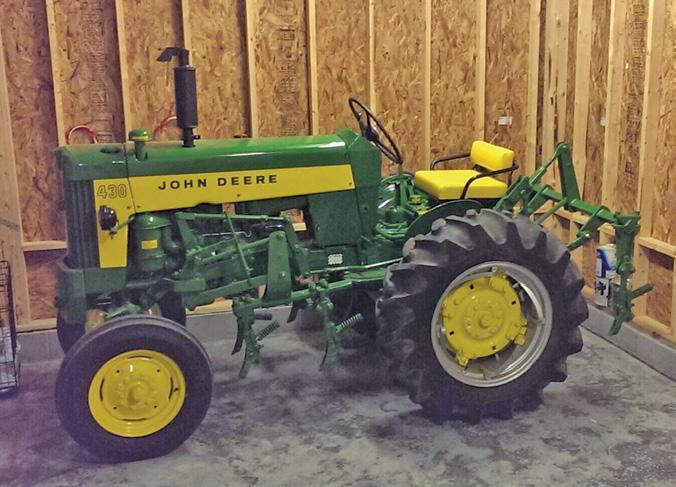
1959 JD 430 standard, SN 148430, fully restored PTO, 5-speed transmission, 4110 cultivator, spin out rear wheels, full lighting and tachometer, speed hour meter. Also have an extra seat and two hoppers, $10,000 OBO. Call or text 919-818-7816. Lillington, NC.

Fresh in from Mexico: 4455, 4435, 4235, 4025. Ph. 308-991-3101 cell, 308-263-4641 phone. NE
1972 JD 2520 PS, $35,000, one of 74 produced. 1971 JD 2520 PS, $18,500, one of 22 produced. Both are very nice tractors, must see! Call for information and pictures, phone 715-645-0795. WI

620 repainted, with 3 pt., starts and runs great, like new tires, $6500. Ph. 616836-5837. MI
John Reed antique J tRactoR paRtS
Phone 580-651-5646 • 806-733-5646
14475 FM 1262 • Gruver, TX 79040
johnreedtractorparts@yahoo.com www.johnreedtractorparts.com www. parts4tractors.com Pistons, radiators, magnetos & manifolds “H” GOV BEARINGS
Fits H, R, 80, 820/830: $35.00 plus S/H
SHEET METAL BOLT SETS
Early styled tractors (pan seated models) A, B hand start • A, B long hood • G, GM & H $35.00 plus S/H
John Reed Antique Tractor Parts
RADIATOR BOLT SETS
Unstyled tractors: $45.00
Styled A, B, G and H + 50, 60 & 70: $40.00 520-up: $30.00 • plus S/H
We specialize in JD model H tractor parts— new, used and reproduction THOUSANDS of model H parts!
1987 JD garden tractor, model 430 w/ mower deck and rear tiller. Ph. 712-2300060. LeMars, IA.
Used John Deere two-cylinder tractor parts. Wide variety. Also, some New Generation parts. 30 years’ experience. Call or text Darwin Gingerich, 620-386-0071. KS
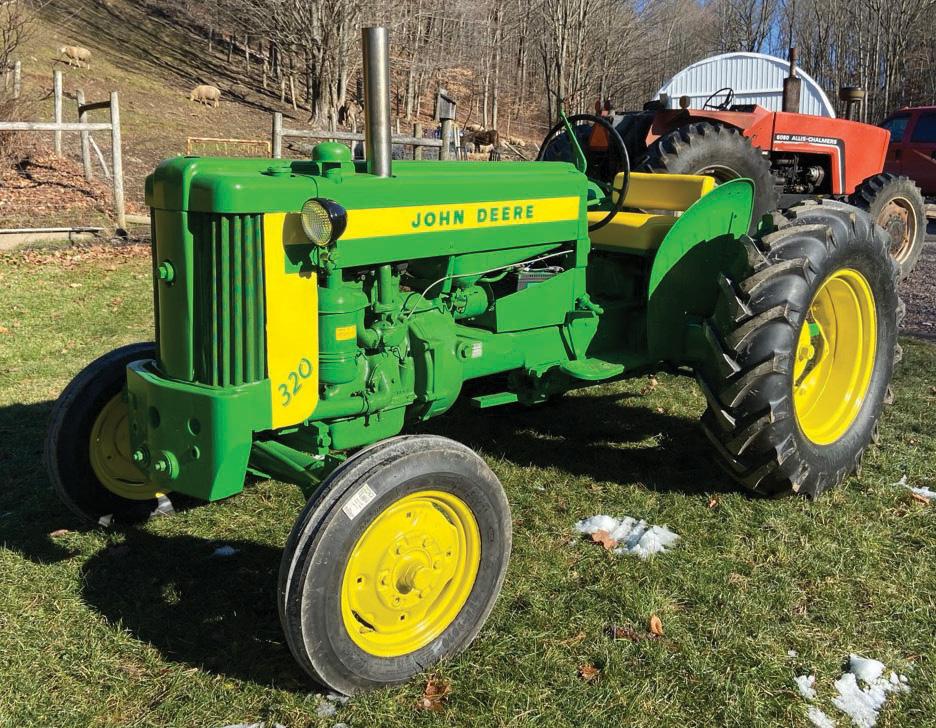
1957 John Deere 320U. Nice collector’s tractor, rare, hard to find, one of 917 made. Fresh paint. New tires, alternator, seat, pistons. Rebuilt carb. Many new parts, runs good, starts right up. $11,000 OBO. Call 814-634-0346 with questions. MD
LGT tractors: early 110; 112; 400; 430 diesel. 120/140 front 540 PTO. 316/318 front 540 PTO. 120/140 front wheel weights. 400 rear wheel weights. 430-D front blade extension bracket. Ph. Ph. 269-461-3449. MI D3X
1600 pound rear wheel weights off of 5020, part number R36990R, $3000. Stolper roll guard cab off a 5020 std., very good condition, all glass is good, all mounting hardware and bolts, $1250. Ph. 765-5944002. IN E3X
Large inventory of good used two cylinder parts. Call for parts needed - casting numbers and/or parts numbers appreciated when you call. Detwiler Tractor Parts, Spencer, WI. Ph. 715-659-4174 or 715-6594252 weekdays 9-5. C6X
Lots of model D and R parts - call for a good deal. Ph. 785-821-2600. KS C3X
1941 AR, electric start, completely restored. Ph. 636-296-3112. MO C3X
Parting out: Unstyled L, L, LA, LI, M, GP, GPO, GPWT, AOS, BO Lindeman, BO/ BR, AO/AR, 40-U, 420-U, 330-S, 430-U, 60 orchard, 1010, 2010, 1020 orchard, 2020, 3020 utility. Ph. 269-461-3449. MI D3X
Yellow zinc wheel bolts for Waterloo or Dubuque 1/2” NF and 9/16” NF. Square head also for cast wheels. Ph. 217-5024504. G6X
Canopies for JD 3020, 4020, etc. Powder coated yellow. $1135. Quantity discounts. Ships truck freight. Nelson Horning, 585526-6705. NY C12X
1956 John Deere 320S. Completely restored. Have cultivator, not restored. Way too much to list. Call for details. $12,500. Ph. 716-735-3848. NY D3X
We have parts for your 45 combine! www.45combineparts.com. Ph. 417-2592520. MO A6X
Parting out 1953 John Deere 70 gas. Ph. 402-485-2887. NE C3X
L-4100T motor. Depression D air cleaner. AI/BI/DI seat. AI front end casting. K-W, Remy and gas lighting parts. GPO air cleaner. GP Beaner front axle. Big bore GP gas tank. 1010/2010 side panels. 2020 grove hood and PTO shield. New Gen orchard manifolds and exhaust pipes. Ph. 269-461-3449. MI D3X
14T baler. Good shape, shedded, $1100 OBO. Some other John Deere equipment. Ph. 319-560-2756. IA E3X
1929 and 1930 model Ds, both on steel wheels, $2500 or both for $4000. Ph. 303877-7641. CO
Green Magazine® • May 2024 Page 63
LUNDELL TRACTOR
6583 310th Street • Kiron, iA 51448
Daytime: 712-675-4341
Evenings: 712-675-4339
Fax: 712-675-4301
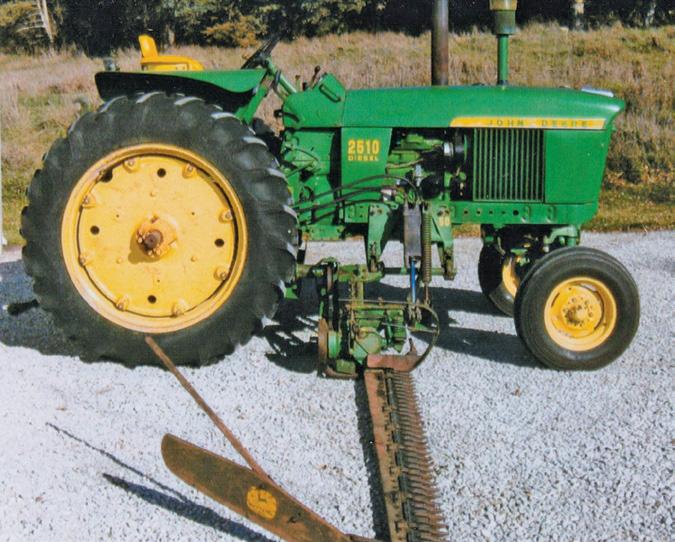
1968 JD 2510 diesel, SN T713R 015773R, with #50 side mount mower, Syncro -Range, single hyd., 7997.6 hrs., new rubber, both tractor and mower are all original and both are “Two-Cylinder certified expo original, too good to restore” with consecutive award numbers, tractor award #24 and mower award #25. One of the best originals you’ll ever find. Ph. 402-269-5059. NE
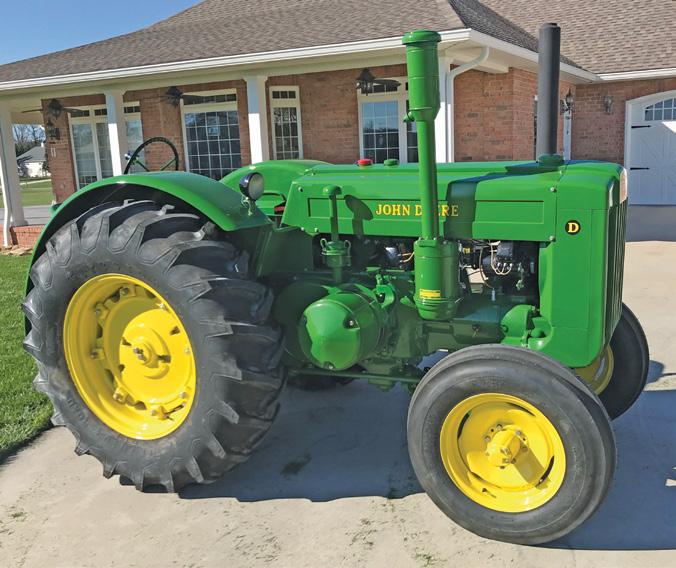
1950 D, runs as good as it looks, $14,000 OBO. Ph. 704-600-8101. TN D3X
1960 JD 530 tractor, single front wheel, 2787 hours, has older restoration, sells with radio, 3-point hitch, remote cylinder, runs and drives perfect, $6850. Ph. 402764-3190. NE
Restoration Services Restoration Services, in association with Paul’s Paint & Glass Supply of Seguin, Texas, will do:
refurbishment & excellent body & paint work We can also repair individual components on all two cylinder and New Generation Deeres
2495 Hwy. 46 North • Seguin, TX 78155 Ph. 800-933-6380
830-372-2195 • 830-401-1365 cell paulspaint78155@yahoo.com www.restorationservicestexas.com
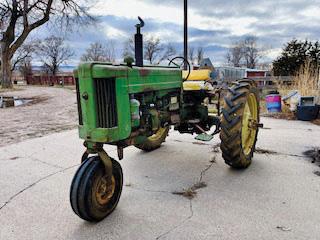
1953 JD 40T, SN 63255, Owned by one family since new. Single front, original 3-pt., paint, tires. Rebuilt carb, new battery, everything works. Missing left headlight, runs very well, new seat and back rest. Includes original starting crank, belt pulley attachment, with JD 3-pt. One bottom 2-way plow, also 8’ JD pull type disc. Asking $5000 for all. Video available to hear and see it run. Call 308-641-3748, calls only. NE E3X
ELECTRIC STARTER KIT for R, includes 12 volt starter, bracket with battery box, breather, water manifold, water pipe. Alternator with top and bottom brackets, mounting hardware and battery cables. $1595. Free shipping. Ph. 717-445-9465. PA D3X
New and used parts for JD two cylinder tractors and crawlers and some NOS parts. Models A, B, D, G, H, LA, M, 40, 50, 60, 70, 70D, 440, 520, 620, 720D, 530, 630, 730, etc. A&L Parts, 315-536-0543. NY C12X
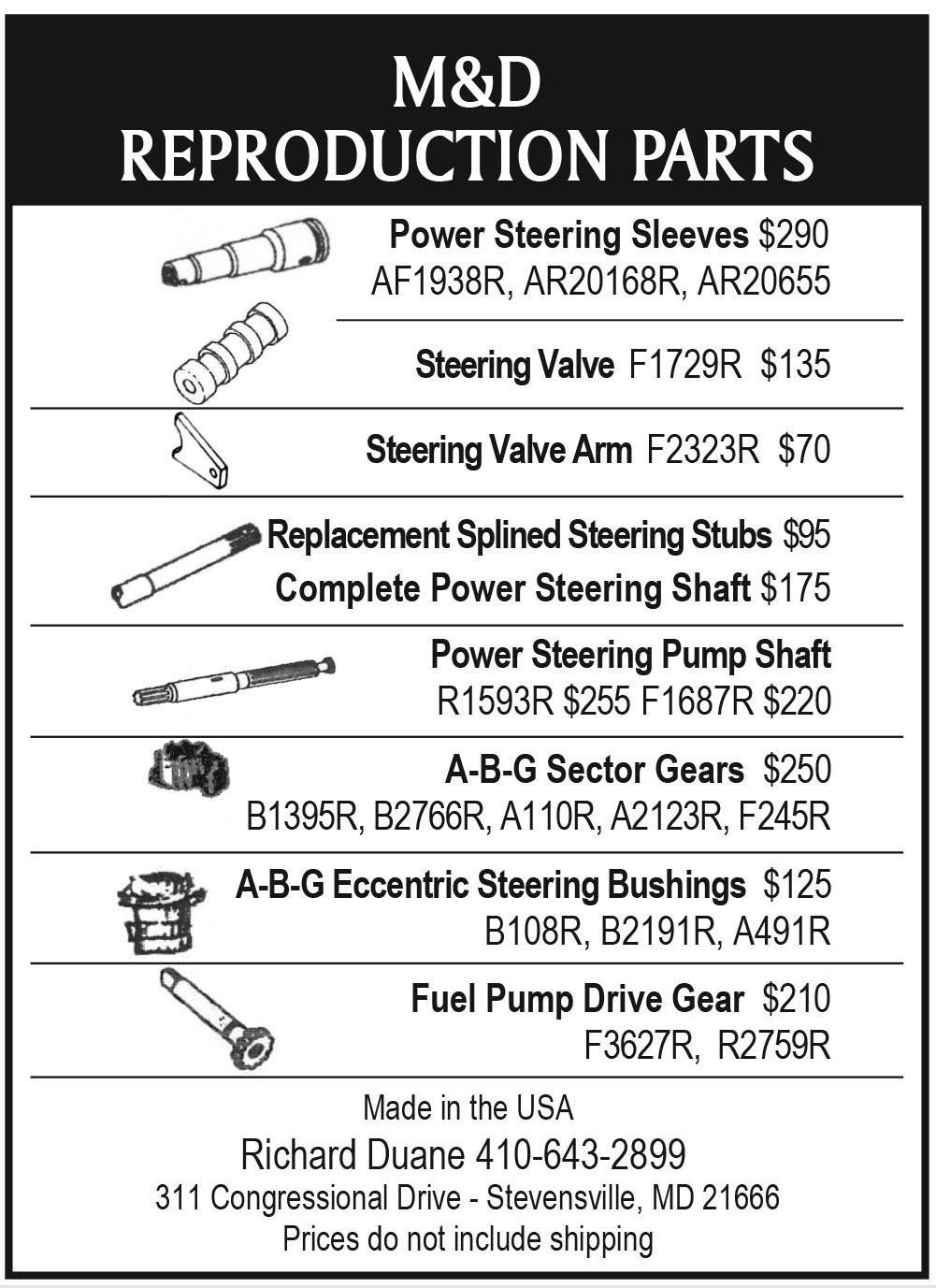
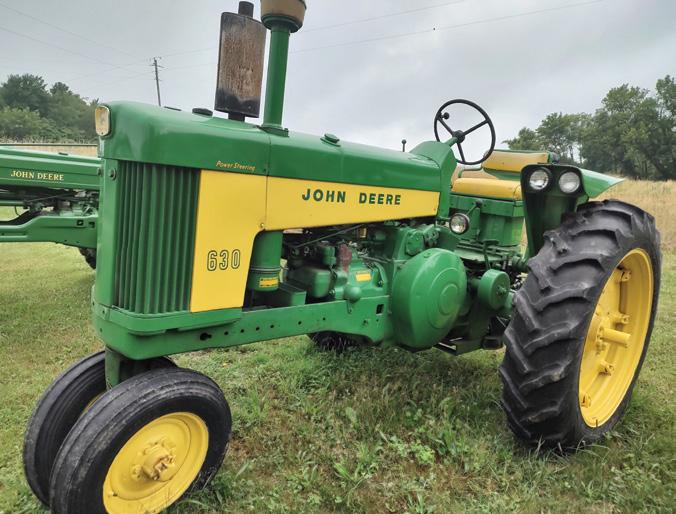
John Deere 630, row crop, 3-pt., LPTO, remote, flat fenders, air stack, PS, cushion ride seat, show condition. Call 330-8060145. OH
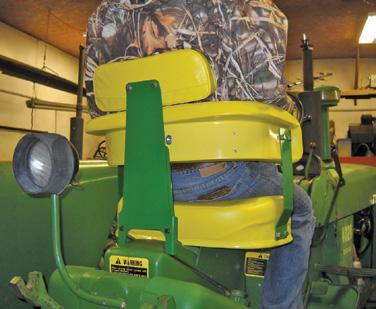
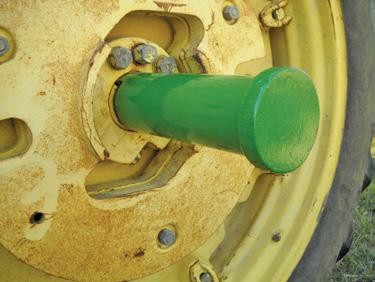
New Generation seat extended brackets, 4 inches longer than stock, not painted, 4 piece set, $120. ALSO: Axle wedge removal tool, 530-4620, three sizes, $260 each. Brett, 402429-5311. NE C3X
1965 3020 diesel, Power Shift, wide front, dual hydraulics and PTO, 7046 hours. Recent engine overhaul. New rims, new paint, lots of new parts, $18,500 or best offer. Ph. 641-228-8046. IA C3X
Quality restoration,
fine
J d
uSed paRtS & TRACTORS
Lundell Tractor
l aW n & g a R den
Page 64 May 2024 • Green Magazine
Two Cylinder Diesel Fuel Systems - Stock & Modified
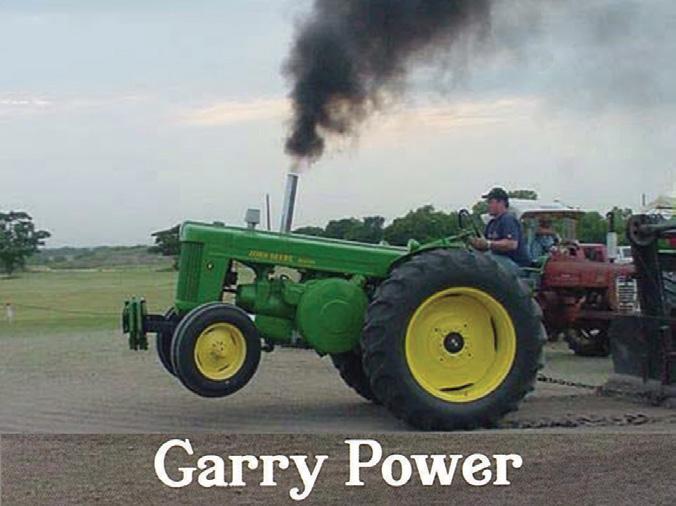
•• Transfer Pump Gears ••
Also: Bosch 14mm Barrels & Plungers
• Bendix 13.5mm Barrels & Plungers • Bosch & Bendix Injector Tips • New with Increased Flow
• Injector Springs
• Needle & Guides
• Many Obsolete Parts 970-554-2108
hendrichfarmtractors.com
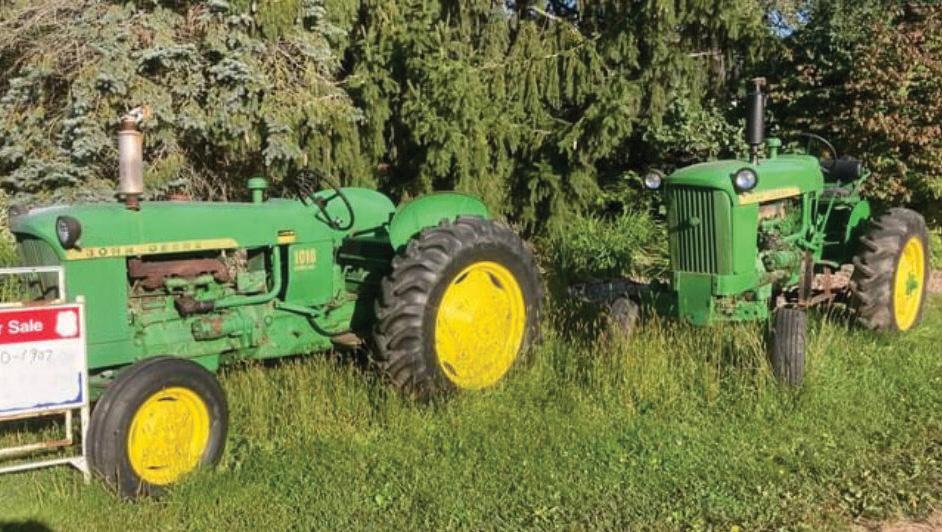
John Deere 1010 RUS and a John Deere 1010S for sale. Both tractors run and drive well. $4900 each OBO. Ph. 616-520-1907. MI

New Generation fuel gauges for 10 and early 20 series tractors, negative or positive ground, comes with new fuel tank sending unit, $160 for set. All our New Generation gauges fit in dash without modifications to the clamp bracket. Also have temperature and pressure gauges for same tractors. EverGreen Restoration, 715-520-7876; www. evergreengauges.com. WI C3X
Automatic release brake locks for two cylinders. Haben 4’ sickle mower for 140 garden tractor. Parts: 420W, 50 and 630 RC; 520-630 LP and A-730: air stacks, 3-points. Hose and breakaway kits for dual hydraulics 520-730; split pedestals for A and B: also Behlen overdrives, round spokes and lugs. 800/801 hitches and parts. Aftermarket parts. Rollover plows and plow parts: 820, 825. Marlin Smith, Pine Valley Farm Equipment. Ph. 712-579-9922. IA C3X
for upcoming issues of Green Magazine®
June 2024 issue:
May 1, 2024 - display ads due May 5, 2024 - classified ads due
July 2024 issue: June 1, 2024 - display ads due June 5, 2024 - classified ads due
FOR MORE INFO:
See page 60 of this issue Call 402-643-6269
Email: info@greenmagazine.com
WIRING HARNESSES, battery cables and spark plug wires made to order for restoration or repair. Covering models from the 1930s to the 1980s. Electrical parts including: switches, regulators, lights, relays, alternators. Wiring harness repair/ rebuild service. Worldwide shipping. See our display ad in this issue. Call or email for a free catalog. Agri-Services, 13899 North Road, Alden, NY 14004. Ph. Website: www. wiringharnesses.com. Email: agriserv@ rochester.rr.com. D3X
Gear reduction starter built for 3010 JD through xx60 series. Adaptable to some 8000 series JD tractors and some JD loaders. Starts easier. About $100 cheaper than OEM. No core charge. Call 218-234-6500. NE C3X
Dubuque parts: Top links, utility anchor yoke assembly, M3434T steering arm, Float Ride seat; PTO shafts, orchard manifolds, PTO belt pulleys, sway bars and brackets, PTO shields, 40-W drawbar, 330/430 standard drawbars. AO/60/620 orchard sheet metal support bracket. Ph. 269-4613449. MI D3X
We have clutch covers, grill screens, manifolds, battery boxes, water pumps, steering wheels and more, plus a yard full of used 2 cylinder parts tractors. Over 25 years of experience. We also have battery boxes, grills, steering wheels and other parts for New Generation tractors. Call Shepard’s Tractor Parts, 715-265-4988. WI
Ridenours - L parts John Deere L, LA, LI and Unstyled L Parts
SOME NEW AND USED
New parts include battery box, seat, metal belly pans, light brackets and more The Ridenours Trenton, OH Ph. 513-988-0390
Visit our website: www.antiquejohndeere.com
Wheels: A-1106-R cast 24”, L/LA deep-dish fronts, styled L rears, 9.5x24” 1010 turf duals, GP round spokes, GPO front steel, GP lister fronts, GPWT rear spokes, BO/BR front spokes, BO/BR rear steel extensions, BO/AO 24” rims, D/DI front spokes. Ph. 269-461-3449. MI D3X
Dubuque tractor HOOD BOLTS: Airlock 160 threaded hood bolts, looks like original Airlock ¼ turn fastener. Has same face, but allows you to snug up metal without harming paint. Set includes 11 Airlock bolts, unuts and nylon washers. For all M, 420 and 430 series. $60. Battery box winged Airlock bolt also now available, $15. Both for $70, includes shipping. Ph. 217-502-4504. IL L6X
Carburetors: DLTX-5, DLTX-10, DLTX18, DLTX-46, DLTX-51, DLTX-53, TCX-12 replacement, TSX-13, TSX-60, TSX-245, TSX-514, TSX-530, TSX-641, TSX-688, Ensign BJ, GP water valve. Ph. 269-4613449. MI D3X
PARTS AND DECKS for older Deeres. 110, 140, 200s, 300s, 400s and over 150 lawn tractors for sale. Ph. 219-942-2242, website: tractorsalesandparts.com. IN B6X
Carr’s Repair: We’ve got you covered! D and R overbore piston kits for sale - D overbore .125-.250, R overbore .045-.125, SPECIAL $595! 720-830 JD diesel .125 overbore piston kits. Restore those JD tractors to original! Ph. 807-487-2548. International Falls, MN. No Sunday calls. Website: www.carrsrepairvintageparts. com (A12X)
Carburetor, water pump, distributor rebuilding. Farmers Service Incorporated. Ph. 330-482-4180, www.farmersserviceinc. com OH L6X
ADVERTISING DEADLINES
Green Magazine® • May 2024 Page 65
Weights: suitcase, BO/AO front spoke wheel weights, L/LA, M/MT, M-1168-T, 320/330 fronts, 420W/430W front, 40/420/430 S/U rear spinout weights, 1010 front, 1020/2020 fronts, 1530/2440 suitcase bracket. Ph. 269-461-3449. MI D3X
60” drive over deck for a 3520 w/mounting brackets. JD 140 w/3 valves, 3-pt. hitch, 42” deck, snow blower, hard cab, tiller w/ two extensions, sickle mower, front PTO, bottom blade. Ph. 904-755-1763. WI C3X
Berry Cam Service: For your 2, 4 and 6 cylinder camshafts, stock or antique pullers. Ph. 320-395-2377. Location: 1948 175th Street, Lester Prairie, MN 55354. D6X
John Deere 350, 6 way blade, 3-pt., PTO, one SCV, reverser, new chains and sprockets, $15,200. JD 350, side boom with winch, 80% bottom, original, open to offers. Call for photos. Ph. 716-801-6658. NY E2X
Many rebuilt machine and tested mags and carbs for two cylinder JD tractors and for other makes as well. Also have parts for old Splitdorf mags. Over 30 years’ experience. Call EZ Tractor Shop, ask for Eldon, 785-332-5482. KS C3X
Implements: Plows - model 835 rollover, F-45 3-pt, 2x16”, #51, #411, #412, #415. Disks - KBL, KBA, RWA, model E, #31 offset, model Y. 246-247 planter. F-1150 harrow. Boom crane. Hi-Crop lister. #20 scoop. TP-16 subsoiler. #22 subsoiler. #80 blade. TP-26 forklift. #12/#14 rotary hoe. 3-pt toolbar rippers. 953 wagon. HD-2240 harrow. Ph. 269-461-3449. MI D3X
Scott’s Tractor Restoration, 14025 Haumesser Road, Shabbona, IL 60550. We offer complete restoration and mechanical repair on all makes and models of tractors. Showroom quality. Ph. 815-762-0851, website: www.scottstractorrestoration.com or email: twocylindersh@aol.com. A12X
High-speed road gears for John Deere tractors A, B, D, H, 50, 60, 620, 630, 730 models for tractor rides. Ph. 701-942-3102. ND C3X
THREE PIECE FRONT WEIGHTS for JD 520-730. Good reproduction. U.S. made. $1000. Also numbers 4, 5 and 6 are available, $350 each. Detwiler Tractor Parts, Spencer, WI. Call 715-659-4174, 715-6594252 or 715-659-4525 (office) 9-5 M-F. H6X
Mounted implements: H-3 two-way plow; L/LA planter; L/LA belt pulley; L/LA plow; LA-113 harrow; M-10 cultivator; M-111 planter w/ fertilizer attachment; M/ MT disc; M/MT plow; M-404 offset disc hanger; M disc hanger. Triumph wagon. Horse drawn buggy. Ph. 269-461-3449. MI D3X
Electric starter kit for 70/720/730. Includes 12 volt starter, bracket, alternator and brackets, engine cover, breather standpipe, plug and caps for water ports, $1250. Kit for 80/820/830, $1350. Battery box now available. Free shipping. Also battery cable kit now available. Ph. 717-445-9465. PA D3X
Currently parting out styled and unstyled A, AR, styled and unstyled B, styled and unstyled D, H, R, 40, 50, 60, 70 gas, 80, 420, 720, 820, 840, 1010, 2010, 3010, 4010, 3020, 4020 and 2030. Countryside Tractor, 618-731-6625. IL E3X
1964 3020 gas, WF, nice. 1953 JD 60. 1944 B, nice. 1965 1010, RUS. All tractors run. Also, 1950 B for parts. Pictures available. Call or text, 217-808-2628. IL E3X
Hoods, grills: Styled L, LA, 40, 420, 430, 435-D, 650 compact, 4100 compact, 1010, 2010, 1020 orchard, 2020 grove, 1530, 2030, 2640 orchard, 2940, 2150, 2350, 2950, and others. Ph. 269-461-3449. MI D3X
NEW manufactured parts for John Deere L, LI and LA. Forty-two years of experience making these parts! Grilles, bases, propeller shaft guards and shield assemblies. Ron Brungart, cell 570-660-4573. PA D3X
Parting out 3010D, 70D and 620. Ph. 641228-4282. IA I12X
New and used JD two cylinder parts. Specializing in H, M, MT, 40, 420, 430, GP, 800 and 801 3-points and parts. Also: See my eBay store for specials and NOS parts. Some NOS parts, many reproduction parts. Dave Cook Tractor Parts, 715-373-2092. Morning calls are BEST. WI E3X
John Deere tractor repairs and restorations – all two cylinders and New Generation tractors. Pickup and delivery available. 4177 White Oak Road, Paradise, PA 17562. Ph. 717-687-3761. E6X
Piston ring sets: A, B, D, G, GP, H. D 6-1/2” std., .045, .090: $192. D 6-3/4” std., .045, .090: $204. G 6-1/8” std., .045, .090, .125: $198. Piston kits 720-730D .125 oversize $650. ALSO AVAILABLE: Two cylinder tractor parts; valves, guides and valve springs; 2 and 4 cylinder pony motor parts; injector tubes OEM, AF3190R, $280; brass push rod tubes, $28; oversized wrist pins. H&J Machining, 701-652-3289 (ND-E3X alt), www.handjmachining.com or email: racinghenry@hotmail.com
Pedal tractors: small 60, large 60, 130 restored, dealer pedal car, LGT, three hole 10, 4020 (D-63), early 4430. 1977 Liquifire 340 snowmobile. Koiritz 440 L/C motor. Various snowmobile hoods. Ph. 269-4613449. MI D3X
New and used John Deere small square baler parts. Knotter rebuilding service. Our free catalog makes it easy to figure out what your baler needs. Call Finger Lakes Equipment, 585-526-6705. NY C12X
1950 styled AR, many unstyled G parts. 70 diesel just fresh in! Parting out: 70 gas burner, 630, good tin; styled G, also H. Parts for unstyled A, B, GP, D. Styled A, B, D, G, 50, 60, 520 and 620. Some R parts. Call Larry Frederick, 308-520-7416. NE E6X
Green Magazine announces its spring/summer hours, in effect now through Labor Day : Monday through Thursday 8:30 AM - 4 PM • Friday: CLOSED Those who want to call to place orders for magazine subscriptions or renewals, gift items or ads, please note this schedule. Our website, www.greenmagazine.com, is always open for orders and ads. Email info@greenmagazine.com with questions, if needed. Thank you! Page 66 May 2024 • Green Magazine
Toys, Books, Manuals & Videos
The Corn Picker book: 804 pages/over 1500 pictures, all brands. Corn Cribs book: 330 pages/over 1200 illustrations. NOW ALSO in hardcover! COMING SOON: Corn Choppers: Field Corn Forage Harvesters. www.CornPickerBook.com or call Corn Picker Bob at 815-761-3709. Email: mrcornpicker@aol.com IL E8X
TRACTOR MANUALS AND LITERATURE, large selection, ag, industrial, L&G. Jim Robinett, 5141 Kimball Road, Ontario, OR 97914. Ph. 206-713-3441, send email: tractrmnul@aol.com. OR C12X
Wanted & Announcements
Wanted: 1975 JD 600 snowmobile engine, 440 ccw, Kioritz air cooled with carburetor, recoiled start or electric start, in good shape, also muffler. Ph. 574-642-4320 ext 1. IN
Wanted: JD 4430, or 4440, open station, in good condition. Ph. 309-256-1100. IL E7X
Wanted: Two row corn head for JD 55 round back combine. Ph. 701-824-4210. ND D2X
Wanted: John Deere deer weather vane (TY1582 or limited edition). Ph. 260-5731512. IN E3X
Wanted: Unrestored ‘26, ‘27, ‘28 D, on full steel. Ph. 717-738-4157. PA
Wanted: Hercules four-cylinder engine or parts model OOB used on John Deere No. 5 combine. Ph. 308-380-0500. NE C3X
Wanted: Adapter plate or drawings for installing Detroit 8v71 engine in John Deere 5020. Calls only. Ph. 319-239-5527. IA E2X
Wanted: 1972 4020 Power Shift, can have bad engine, but prefer lower hours, must be original and straight, can be a 1970 or 1971. Ph. 519-291-3954. Ontario, Canada. E3X
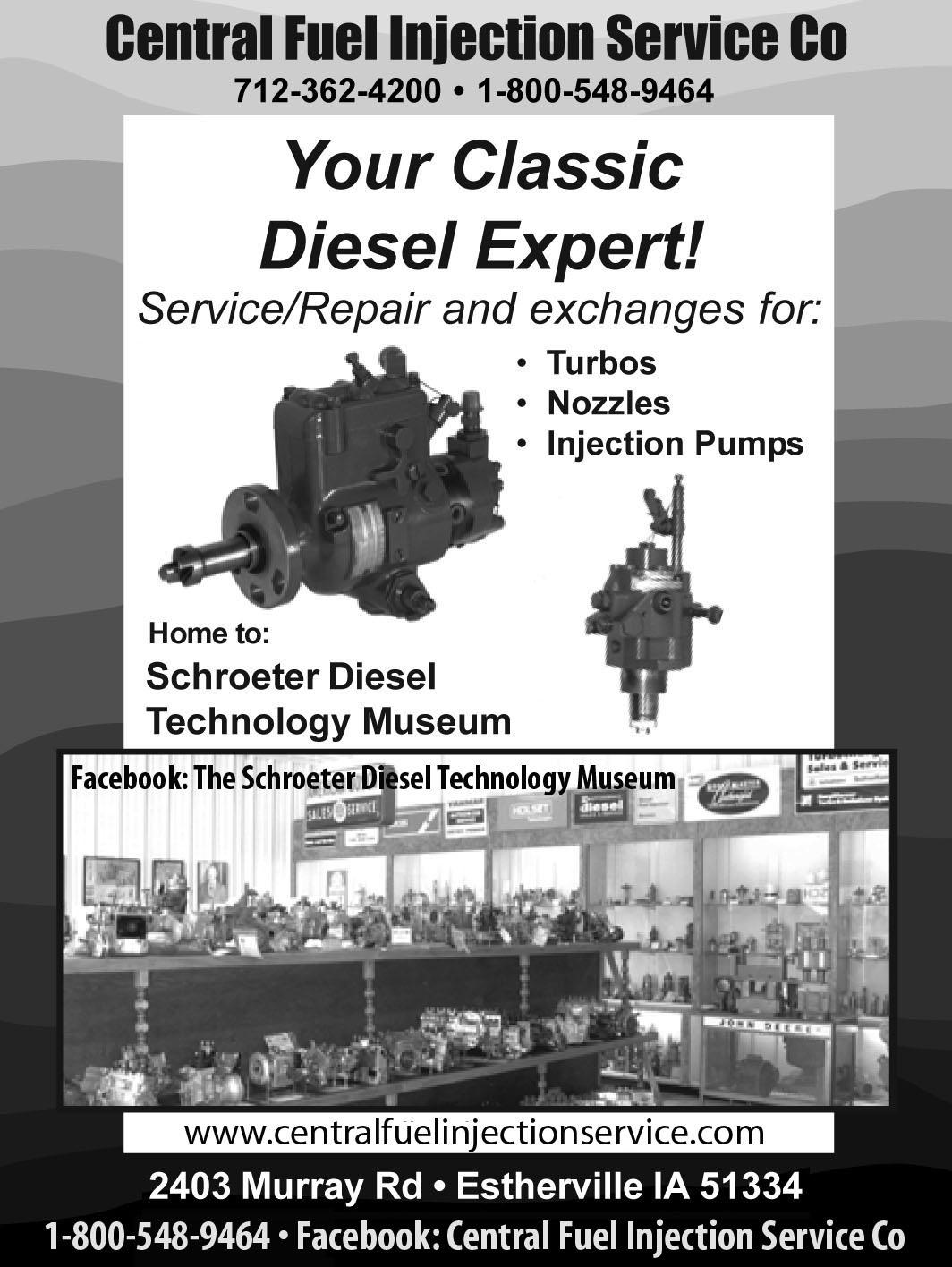
Tractor Parts We Fabricate
Weight Bracket
5010, 5020, 6030: AR58358, Pr $460
Rear Engine Panels
4620 Right, AR43290, $155
4620 Left, AR51804, $255
2510 Right, AR38206, $300
2510 Left, AR38207, $220
2520 Right, AR38838, AR38202, $300
2520 Left, AR38839, AR38203, $220
5010, 5020 R, AR35023, $300 L, AR35024 OR AR36796 $300
6030 Right, AR53645, $350
6030 Left, AR53646, $350
Dust Shields
5010 Right, AR35334, $320
5010 Left, AR35335, $320
5020, 6030 RC Right, AR40930, $350
5020, 6030 RC Left, AR40931, $350
5020, 6030 Whd R, AR36772, $350
5020, 6030 Whd L, AR36773, $350
Rock Shaft Cover
5010, 5020 Right, R36420, $295
5010,5020 Left, R36422, $160
5010, 5020, 6030 Center, AR55756, $70
6030 Right, AR55755, $295
6030 Left, R51485, $160
Toolbox Cover
5010, 5020, 6030 - AR35050, $65
Hood Air Cleaner Cover
4050, 4520, 7020 - AR43256, $165
Hydraulic Dipstick Cover
5010, 5020, 6030 - R36421, $80
Step w/Pads
5010, 5020, 6030 - AR40914, $165
Step U Bolts
$18
Seat Base Cover for Tractor w/o Rock Shaft - AR26846, $295
4000 & 4020 Std SN 201,000 & Above
AR40773 LH Rear Eng Panel = $80
AR40774 RH Rear Eng Panel = $80
AR40871 Platform (can modify AR48727) = $155
AR41097 Platform Support = $84
AR41098 Platform Support = $84
AR41137 Dust Shield RH = $315
AR41138 Dust Shield LH = $315
AR41174 Support To Dust Shield=$27
R41253 Ext Front Right = $156
AR41451 Ext. (RH) = $74
AR42594
AR45207
Want to place an ad in Green Magazine? For more info, see page 60, email: info@greenmagazine.com or call 402-643-6269
Step Bracket w/2 pads = $215 F3195R Step Pad = $30
AR42989 Cover Battery Box = $80
AR45129 Battery Box Support = $75 AR45130 Battery Box Support = $75 AR45131 Ext L Ft AR48964 = $184
Battery Box = $340 AR46289 Weight Bracket = $102 AR48964 Ext L Ft AR45131 = $176 3020 Standard Tractor R34944 Floor Panel 3020 Std PS R34943 Floor Panel 3020 Std PS AR34801L Dust Shield = $325 AR34801R Dust Shield = $325 R42893 Fastener Pin for Battery Box = $36 Dave Haala: dave@haala.com or 507-920-9181
Green Magazine® • May 2024 Page 67
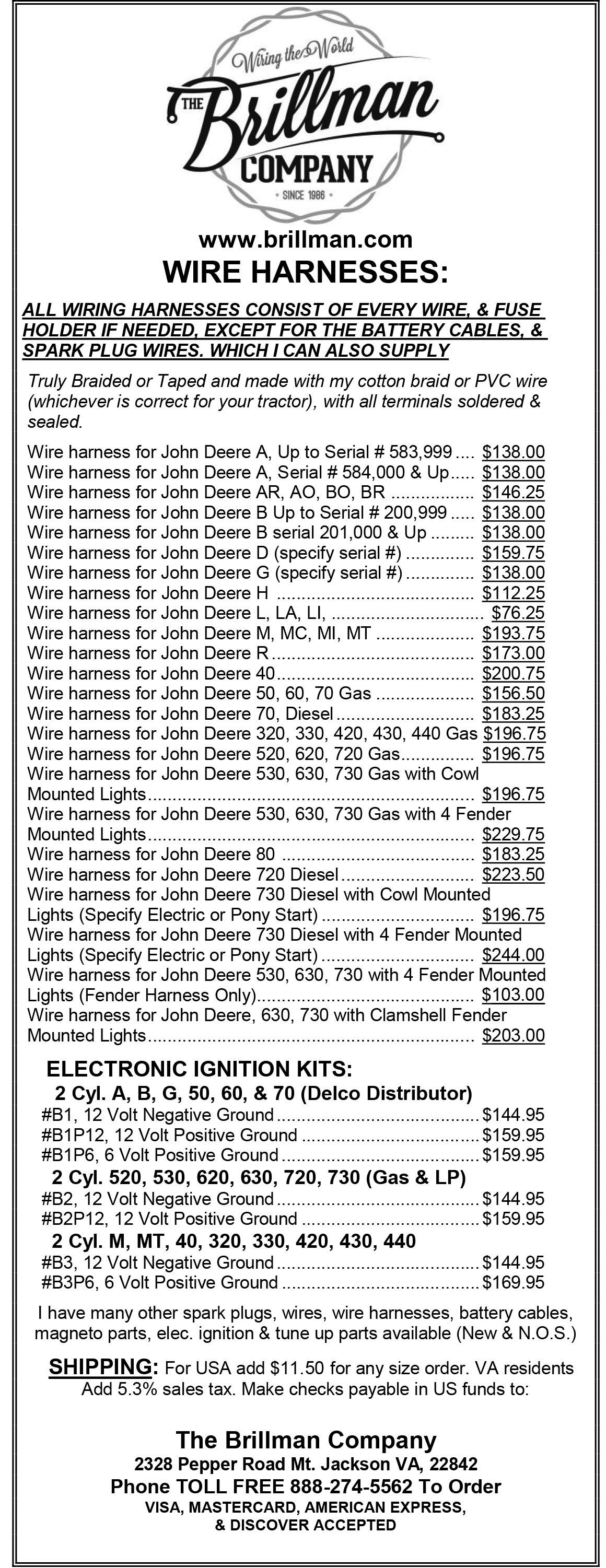
See our website for links to museum information, old dealership photos online advertising, articles and more www. GreenMagazine.com Page 68 May 2024 • Green Magazine

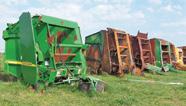

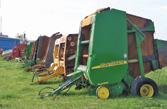
2-Cylinder Plus Tractor Salvage, 69
Agri-Services, 26
A&L Parts, 34
Auction: Dennis Wildasin/others, 3
Auction: Frank Reed, 13
Auction: June 29, 2024, 23
Auction: Lake Erie Equipment, 8
Auction: May 18, 2024, 8
Auction: Melvin Weers, 9
Book bundle deal, 2 Brillman Company, 68
Central Fuel Injection Service, 67
Countryside Tractor, 69
Crawler parts: Lavoy Wilcox, 60
Decals: QuipCal.com, 62
Detwiler Tractor Parts, 26
Dillner's Tractors, 60
DVDs - Green Magazine, 74
EverGreen Restoration, 28
Fabricated parts - Dave Haala, 67
Fisk Carburetor and Ignition, 34
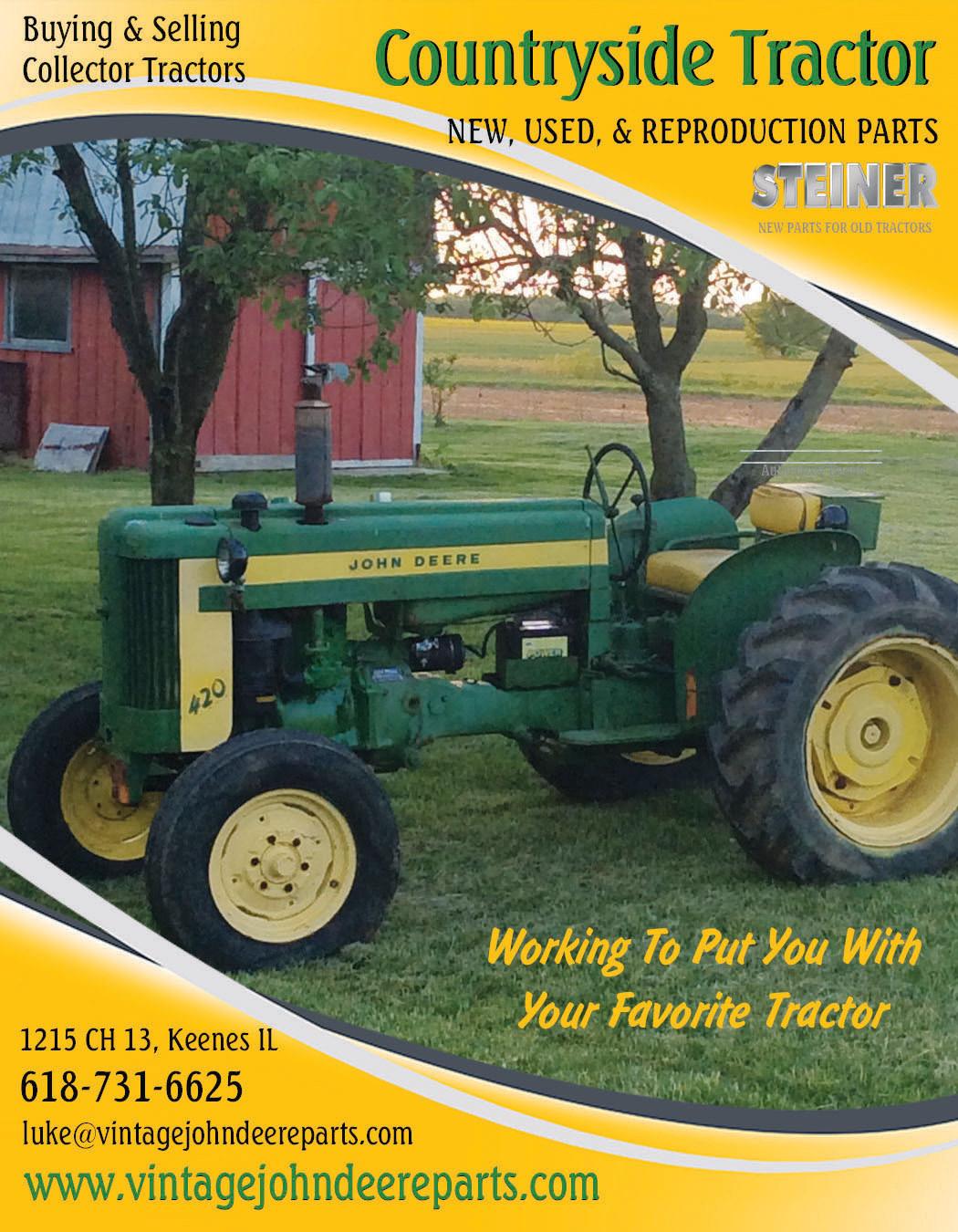
Garry Power, 65
GreenLight Products, 26
Green Magazine back issues, 71
Green Magazine binders, 71
Green Magazine Bookstore, 70
GreenMagazine.com, 68
Iron Bull Mfg., 29
Jensales, 27
John Reed Antique Tractor Parts, 63
Jorde’s Decals, 26
K&K Antique Tractor Parts, 12 & 34
L and LA parts - Ron Brungart, 66
Lakeside Service & Supply, 34
Lind Bros Tractor and Parts, 29
Little Green, The Tractor Magazine for Kids, 12
Lundell Tractor, 64
Martin Parts & Repair, 36
Martin Repair, 28
McDonald Carb & Ignition, 29
M&D Reproduction Parts, 64
Medallion AR77663K&K Antique Tractors, 12
Obsolete parts - The Old Tractor Company, 69
Open house-Jake Rens & Sons, 28
Paul's Rod & Bearing, 60
Renaissance Tractor, 61 Restoration Services, 64
Ridenours - L parts, 65
Robert’s Carburetor, 27
Scenic View Engine, 62
Show: 8th Annual Antique Tractor and Equipment Show, 8 Show: Classic Green Reunion, 37
Show: Eastern National Expo, 23 Show: Threshermen and Collectors Show, 35
SMV emblem support bracketK&K Antique Tractors, 34
Steiner Tractor, 75
TP Tools & Equipment, 17
Wapsi Innovations, 12
MAY 2024 Green Magazine
DISPLAY ADVERTISER INDEX
CONTACT US to be included on this list of Green Magazine display advertisers 402-643-6269 info@greenmagazine.com
2-Cylinder Plus Tractor Salvage 2-Cylinder Plus Tractor Salvage
420s, 430 thru 4010, Hs & Ms
Disk
Hay Bines
Robin Marlin 417-589-2634 • 417-589-3337 322
• Conway, MO 65632
of Branson, Missouri Obsolete parts - The Old Tractor Company OBSOLETE PARTS CHECK YOUR PART NUMBERS against one of the largest inventories of obsolete and reproduction John Deere parts in the world www.theoldtractorcompany.com The Old Tractor Company • Box 89 • Franktown, CO 80116 TEXT: 303-594-3074 (texting preferred) Ph. 231-846-8243 Green Magazine® • May 2024 Page 69
A’s, Bs,
Hay Equipment, Balers,
Binders &
David and
Marlin Prairie Dr
Only 70 miles northeast
Bookstore
The place to go for accurate and informative books

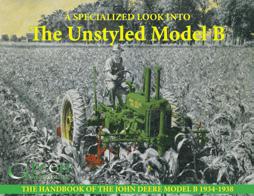
A Specialized Look Into The Unstyled Model B: The Handbook of the John Deere Model B 1934-1938 This book should be on the “must read” list of any unstyled “B” owner. Offers the same type of info as the unstyled “A” book (at right). Written by experts who have collected and restored the unstyled version of Deere’s most popular tractor, 84 pages, 11x8-1/2,” soft cover. GM8B - $39.95 US, $47.95 C, $52.95 F
The John Deere 20 Series New Generation Tractors This book is packed with info on the JD 820, 1020, 1520, 2020, 2520, 3020, 4000, 4020, 4320, 4520, 4620, 5020, 6030, 7020, 7520, 8020, WA-14 and WA-17. History and development, specs, production numbers and horsepower ratings. 8-1/2x11,” soft cover, 128 pages. NG20: $28.00 US, $35.00 C/F
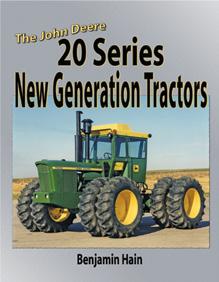
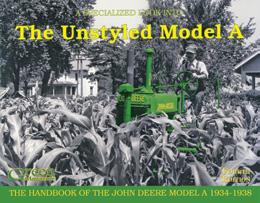
A Specialized Look Into The Unstyled Model A: The Handbook of the John Deere A 1934-1938 Now in its fourth printing, no other book goes into so much detail on a single model of tractor. Shows illustrations of nearly every change made in the parts that make up the unstyled “A.” Written by Wes Malcolm, 95 pages, 11x8-1/2,” soft cover. GM7A - $39.95 US, $47.95 C, $52.95 F
THE GREEN EXPERIENCE
Articles first seen in Green Magazine 1984-2000
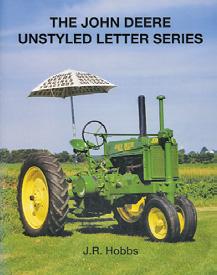
The John Deere Unstyled Letter Series Covers the JD unstyled GP, D, B, A, L, G, AR, AO, AI, BO, BR, BI, BO Lindeman, DI, 62, Y, W, AOS, Waterloo Boys and predecessors. Production numbers, year/SN breaks, original prices, matched working equipment, magnetos, carbs, wheels, history. 8-1/2 x 11,” soft cover, 160 pages. GM10: $24.00 US/C, $31.00 F NOW ON SALE! $18.00 US, $30.00 C/F

Approximately 96 pages of the best articles taken from Green Magazine’s first 15 years. Every member of the family will enjoy this book of restorations gone awry, trips that didn’t go as planned, cherished memories and sometimes profound situations. Not a technical or historical book, but a book about the lives and experiences of those who enjoy John Deere tractors. 11”x8-1/2,” about 96 pages, soft cover. GREX - $20.00 US, $30.00 Canada, $40.00 Foreign
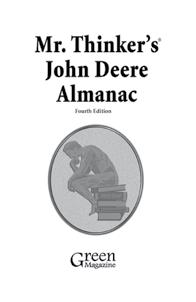
Mr. Thinker’s John Deere Almanac, Fourth Edition All the same info found in earlier editions plus now Dan Brotzman’s New Gen and Gen II SN guide. For all models built from 1918 to 1972: history, SN/year breaks, accurate production numbers (no 820 three cylinder, 1020, 1520, 2020), notes on some significant changes, charts on tractor fluid capacities, cubic inches, compression ratios, torque specs, list of plow beam numbers. Info on proper colors of mufflers, axles, horse drawn equipment, fuels/lubricants, E/W stationary engines, L&G tractors. Chart on heights, weights and top speeds; SN/year charts for models 45 through 105 combines; tractor/loader application chart; SN/year charts for all tractors built from 1973 to 1990; and production numbers for models 4030 and 4230. 8-1/2”x51/2,” soft cover, black/white. MRT4 - $17.95 US, $28.00 C, $36.00 F US = United States • C = Canada price • F = Foreign price





The John Deere Hi-Crop Book This book provides serial number lists for JD models A, G, 60, 70, 620, 720, 430, 630, 730, 2010, 2510, 4010, 2520, 3020 and 4020. Verify Hi-Crop serial numbers, build dates and shipping locations in a pocket-sized book that’s easy to carry anywhere. Production summaries of two cylinder HiCrop tractors provided, as well as Hi-Crop totals by state and more. 72 pages, 5.5 x 8.5,” paperback, limited quantity. Order GMHC - $19.95 US, $26.95 C/F
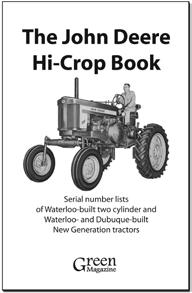
A Tractor Goes Farming Author Roy Harrington (co-author of John Deere Tractors & Equipment, Vol. 2) has put together a book that places the child in the driver's seat of a variety of tractor makes and models. Short sentences that kids will be able to read alone or with help and full color photos to please everyone. 32 pages, 7 x 8-1/2, hardbound. AS6T - $10.95 US, $16.95 C/F
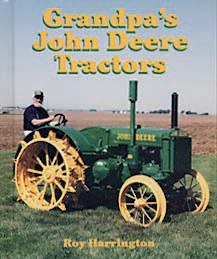
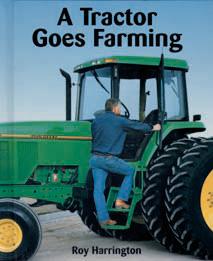
Grandpa’s John Deere Tractors This book for kids tells the history of Deere and Company starting with John Deere and his steel plow. Then in 48 pages with 50 color photos, it talks about how farming and JD tractors have changed. Best for kids 5 to 10 years. 7 x 8-1/2, hardbound, written by Roy Harrington. AS8K - $13.95 US, $19.95 C/F
How John Deere Tractors and Implements
Work Kids are always asking questions, especially about big machines. This book will give kids the answers they crave as they step into the field with impressive John Deere tractors and implements. Ages 8 to adult. 8-1/2 x 11, hardbound, 48 pages.
AS9H - $14.95 US, $21.95 C/F
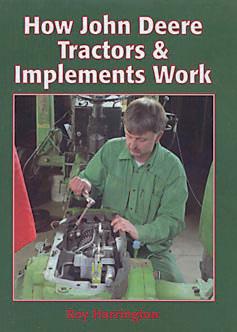
A book is a great gift — for yourself or someone else! Orders can be called in or placed online with a credit card or by mail with a check. For more information, see yellow box in opposite column.
Please use stock numbers when ordering books To place an order, give us a call, send by mail or go online Shipping UPS & First Class Mail daily • ALL PRICES INCLUDE SHIPPING Green Magazine • PO Box 95 • Bee, NE 68314-0095 Phone 402-643-6269 info@greenmagazine.com • www.GreenMagazine.com Please send all remittances in U.S. funds • Nebraska residents add 5.5% sales tax Visa, Mastercard, Discover & American Express accepted
Page 70 May 2024 • Green Magazine

Green Magazine back issues
COST FOR BACK ISSUE S, NOW AVAILABLE PER SET
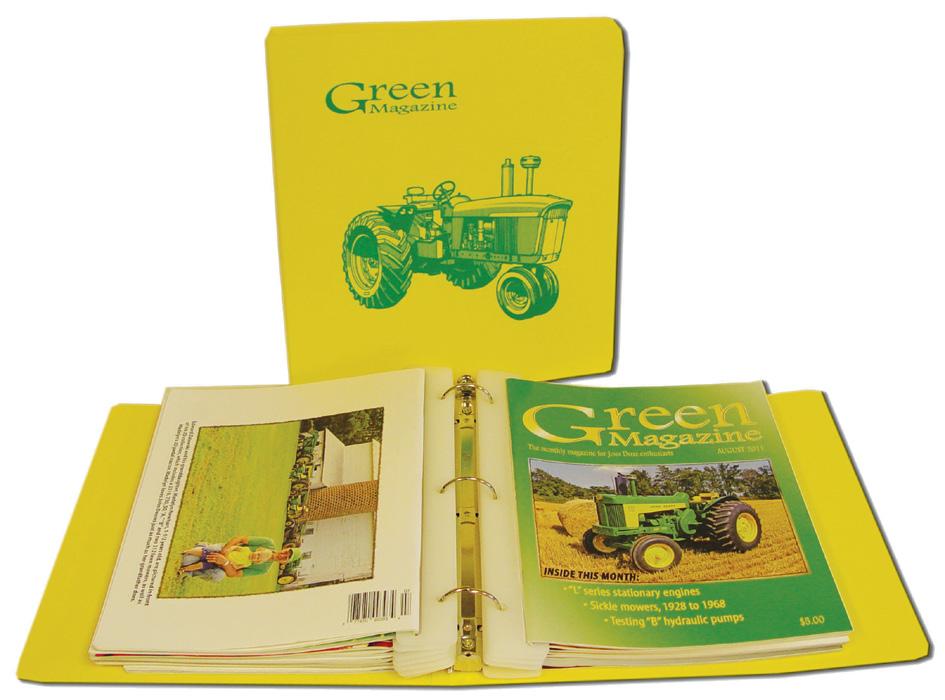

Order BIN1
No need to punch holes in those precious magazines to hold them in a three ring binder. These binders have inserts to hold your magazines in place. Magazines are easy to put in, easy to take out and can be read while in the binder.
Order BIN1 • Binders are now available in sets of 2 Each binder comes with 12 inserts • Additional inserts can be ordered—prices listed below
U.S. $48 for set of two binders w/12 inserts each or $88 for set of four binders w/ inserts Additional inserts are $14 per dozen or $34 for three dozen
CANADA $68 for set of two binders w/12 inserts each or $128 for set of four binders w/inserts • Additional inserts are $24/dozen or $54 for three dozen ALL OTHER COUNTRIES $88 for set of two binders w/12 inserts each or $168 for set of four binders w/inserts • Additional inserts: $34/dozen or $64 for three dozen




Magazine binders PO Box 95 Bee, NE 68314-0095 Ph. 402-643-6269 info@greenmagazine.com www.greenmagazine.com
Keepers!
Green
Binders
Visa, MC, Discover, AmExp accepted
Nebraska residents,
sales tax
funds only All prices include shipping/postage
•
add 5.5%
• U.S.
: U.S., PER SET: $29.00 • Nebraska residents, add 5.5 percent sales tax CANADA, PER SET: $70.00 U.S. funds • OTHER FOREIGN COUNTRIES, PER SET: $100.00 U.S. funds For more information or to place an order, call 402-643-6269 Green Magazine • PO Box 95 • Bee, NE 68314-0095 www.GreenMagazine.com • info@greenmagazine.com SET 1: 2014 and older (feature article listed after each issue) Apr 2011 Lost models • Oct 2011 7520 • Aug 2012 4030 Nov 2012 520 • April 2013 US B May 2013 4230 • June 2013 40 • July 2013 6600 combine Aug 2013 R • Nov 2013 8010 • Feb 2014 420 March 2014 Waterloo Boy, 1 • April 2014 Waterloo Boy, 2 May 2014 4620 • June 2014 720 July 2014 530 • Aug 2014 1020 Sept 2014 Unsty G • Nov 2014 Pre-D SET 2: 2015-2018 (feature article listed after each issue) April 2015 1010 • May 2015 330 • June 2015 BR/BO July 2015 3020 • Feb 2016 4010 • March 2016 Uns L April 2016 2010 • May 2016 440 • July 2016 H • Aug 2016 820 Nov 2016 40 combine • Dec 2016 E engines • Jan 2017 3010 March 2017 2520 • April 2017 R • May 2017 4630 • July 2017 2030 Sept 2017 G • Oct 2017 W power units • Nov 2017 4430 Dec 2017 840 • Jan 2018 7020 SET 3: 2019 and newer (feature article listed after each issue) Feb 2022 H • April 2022 830 • June 2022 1010 • July 2022 60 August 2022 1520 • Sept 2022 Unstyled B • Oct 2022 330 Nov 2022 Unstyled L • April 2023 GP • June 2023 3010 series July 2023 Late styled A • Aug 2023 820 • Sept 2023 4040 Oct 2023 GP specialties • Nov 2023 R • Dec 2023 440 • Jan 2024 WA 14-17 Feb 2024 4010 • March 2024 Early styled B • April 2024 620 Cost for single back issues of Green Magazine: $7.00 each U.S. (Nebraska residents add 5.5% sales tax) $9.00 each Canada (U.S. funds) • $11.00 each other foreign countries (U.S. funds) Number of magazines in each set will vary as inventory changes Visa, Mastercard, Discover, AmExp accepted Green Magazine® • May 2024 Page 71
Mr. Thinker,
We recently lost our local resident expert on two-cylinder John Deeres so I am appealing to your expertise. I went through the carburetor on my 1959 630 using an overhaul kit. I set the float at 3/4 inch, the metering screw at two turns and the slow idle screws at 1-1/4 turns. When reinstalled, the engine runs wide open regardless of the throttle setting, even with the throttle unhooked. I have rechecked the carburetor and the governor to no avail. What am I doing wrong?
H.L., Tennessee
With the governor to carburetor rod unhooked, see if the tractor will idle then. If not, odds are the throttle disks were not installed correctly or are worn beyond service. Odds are it’s the former. You have to be careful about getting the disks indexed to the port and shaft. Also, you only want to tighten the disks snug until you turn the shaft to full idle. THEN do the final tightening. MT
Dear Mr. Thinker,
Answers to Mr. Thinker are provided by a variety of “experts.”
Mail a question to Mr. Thinker/Green Magazine PO Box 95 • Bee, NE 68314 Email: info@greenmagazine.com

I rebuilt a John Deere 1957 model 520 gas. Since then it has been nearly impossible to start, once started, it runs great. I had the carburetor rebuilt by a John Deere dealer. Fuel filter has new parts. The problem as I see it is lack of fuel in the combustion chamber. Is it possible that the float has been set incorrectly? What should the float setting be and, if it is not perfect, would it make any difference?
D.M., Michigan
From what you have described with hard starting, but runs great once it’s started, sounds more like the oil pressure shut off that is part of your sediment bowl. Mr. Thinker is going to assume the choke plates are closing completely in the carburetor since you mentioned the carburetor has been rebuilt. However, maybe we shouldn’t assume the choke plates are closing completely for starting and you should verify that they are closing completely. Since you say the tractor runs great once it’s started, we can assume the float is set correctly. Also, since the engine runs great once it’s started, we can also rule out any vacuum leaks between the carburetor and cylinder head. Going back to the oil pressure shutoff, which you said has new parts in it. You can reach between the bottom of the gas tank and the top of the oil pressure shutoff
housing with your fingers. You should feel a round knob there that you can manually push down to fill the sediment bowl and fill the carburetor bowl with gas before attempting to start the engine—part number 1 in the parts view. This should allow the engine to fire right up, provided the choke is closing completely. If holding the shutoff knob down for about 45 seconds improves the starting of your tractor, that’s a good indicator that your shutoff diaphragm is not working correctly.
Have you verified there is oil pressure at the shutoff diaphragm when cranking the engine? MT
Mr. Thinker, I have noticed two 4010 diesel row crop tractors with add on turbos mounted above the hood line. Who made that set up? They were not pulling tractors. My other question is—did some M&W turbo kits require the hood exhaust to be moved while others did not?
L.F., Iowa
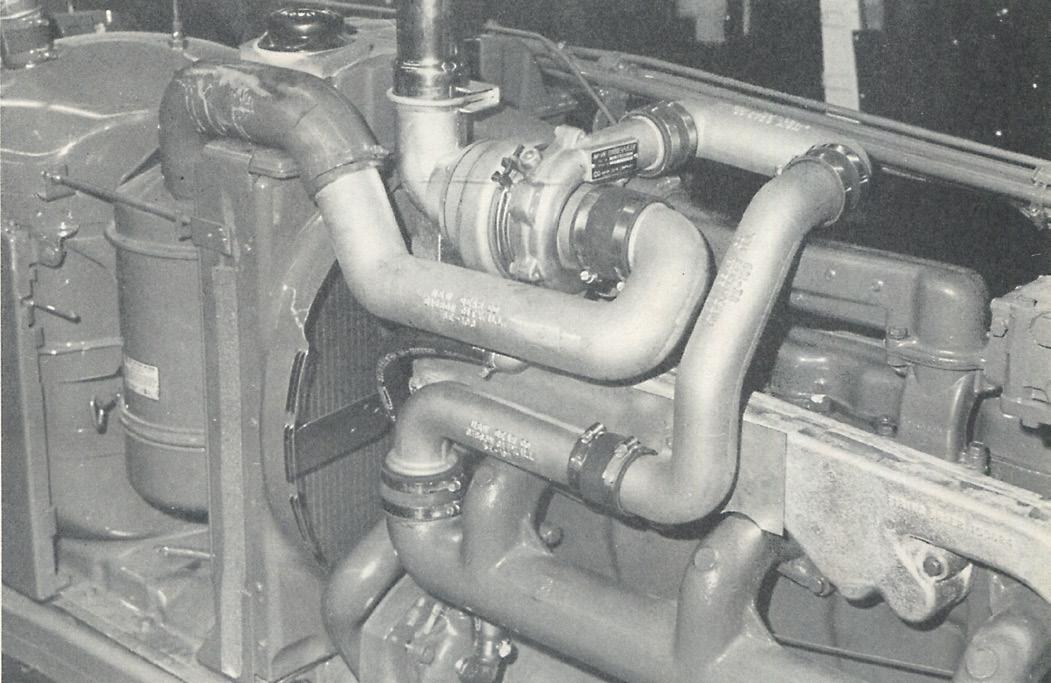
Responding to your second question first, as far as Mr. Thinker knows, all M&W turbos required you to move the exhaust on 4010 and 4020 tractors. As you can see in the photo, with some even more creative tube bending, one might have been able to move the turbo back and keep the exhaust where it was. Mr. Thinker has seen photos of tractors with the turbo above the hood, but can’t come up with a maker. Perhaps one of our sharp minded readers can help out Mr. Thinker. MT
Page 72 May 2024 • Green Magazine
Mr. Thinker,
I have a 1944 “B” that I have had for many years and I am having problems with the Power Lift. It has always worked very well until recently. It will only go part way up and it starts making a loud noise and will not continue up. I have to shut off the PTO to get it to come down. The oil is where it should be.
J.R., Nebraska
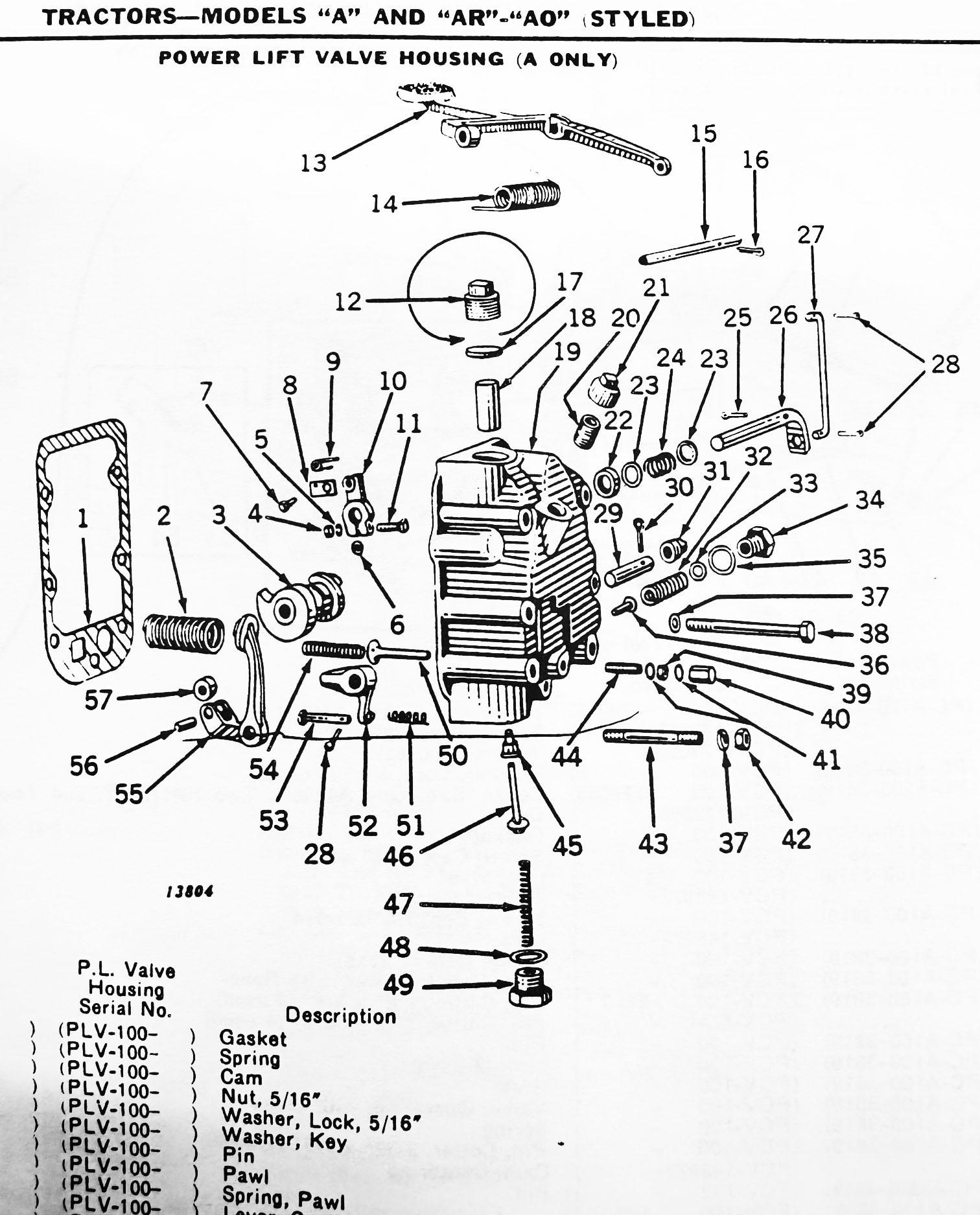
Thank you for specifying a Power Lift and not a Powr-Trol. Unlike the Powr-Trol, the Power Lift is either up, or down without any modulation in between. From your description, Mr. Thinker is quite sure you are not going to be able to fix your problem without removing the Power Lift unit from the tractor and disassemble the unit. Mr. Thinker is going to reference a Power Lift from a late model “A” even though you have a model “B” because the Power Lift unit is interchangeable for the “A,” “B” and “G.” If you are going to need parts, keep in mind your Power Lift should have a serial number tag attached to it because Deere did made changes throughout the production of Power Lifts and Powr-Trols.
Referring to the parts view, Mr. Thinker is going to suspect you will find an issue with one of the springs inside the unit, or one of the valves, item numbers 54, 56, 46, 47, 36, 32.
Without hearing the “loud noise,” Mr. Thinker is going to suspect you are hearing the pressure relief valve (46) open, possibly caused by spring (47) being weak or
broken. Another possibility causing the pressure relief valve to open is one of the other valves leaking internally, putting oil pressure on both the lift circuit and return circuit, causing the oil pump to try and pressurize both circuits, or fight against itself. This would explain why you need to shut the PTO. MT
Mr. Thinker,
I bought this disc tiller at an auction and wish to restore it. However, I’m having trouble identifying its model number so that I can get the correct owner’s manual for it. It needs new bearings and races for the rear disc. I believe that it is either a P75A or P175. Neither picture I found has a tail disc like mine. Any help you can give me will be appreciated.
P.V., Texas

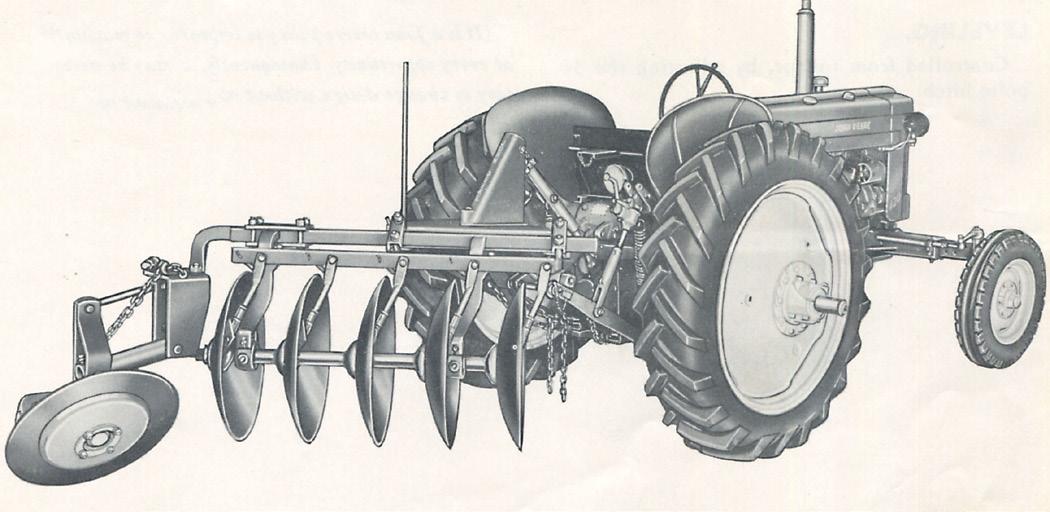
Definitely looks like a P75A to Mr. Thinker. Other than blades, parts are going to be hard to find. If any readers have information on a source, let Mr. Thinker know and he will pass it along. MT
Mr. Thinker,
I have a 1952 “B” with serial number 309035. It has a Wico “X” magneto. Could the late “Bs” be ordered with choice of mag or distributor?
M.C., Missouri
The Wico “C” magneto was replaced by the “X” at serial number 217799. Distributor ignition, using the Wico “XD” distributor, was made standard equipment at 268820, though magneto ignition was still available at the same price. MT
Green Magazine® • May 2024 Page 73
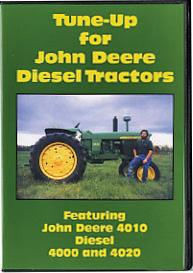

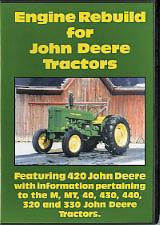
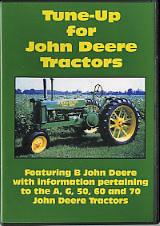
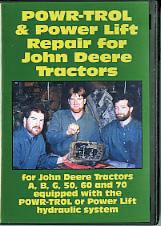
VJT4: Tune-Up Video for John Deere Tractors. 4010, 4020 and 4000 diesel JD tractors. 42 min.
VJE4: Engine Rebuild for John Deere Tractors. 4010, 4020 & 4000 diesel JD tractors. 2 hrs.
VJTQ: Tune-Up Video for John Deere Dubuque-Built Tractors. Featuring 420 JD with information pertaining to the M, MT, 40, 430, 440, 320 and 330 JD tractors. 64 min.
VJEQ: Engine Rebuild for John Deere Dubuque-Built Tractors. Featuring 420 with information pertaining to the M, MT, 40, 430, 440, 320 and 330 JD tractors. 90 min.
VJDE: John Deere A, B, G, 50, 60, 70 Engine Rebuild From tear down to starting it back up. A must for the beginner. 85 min.
VJDT: John Deere A, B, G, 50, 60, 70 Tune-up. Don’t need an overhaul, just a tune-up? This video is for you. 60 min.
VJDR: John Deere Powr-Trol and Power Lift
Repair Keep those hydraulics and rockshaft running right. 51 min.
VJDP: How to Paint a Tractor. Give that old tractor a finish better than original. 56 min.
VB2C: How to Rebuild DLTX Carbs: The Rest of the Story. Tells how to get those stubborn screws loose, how to correct common running problems and other secrets. 111 min.

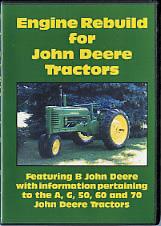
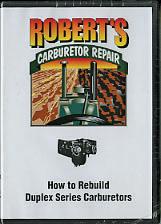
VBBM: How to Rebuild Wico Magnetos. Disassembly, repair and reassembly of one of a tractor’s most important parts. 103 min.

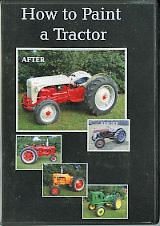
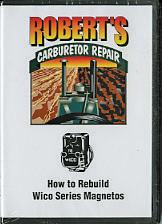
VBBG: How to Rebuild Governors Keep that JD running smooth. 121 min.
VBBS: The How-To’s of Sheet Metal. Repair dents, cracks and rust. 118 min.
VB3D: How to Rebuild Duplex Series Carburetors. Tractor pull but not idle? Start hard and runs only by working the choke? Run for short periods and then quit? This video will help trouble shoot such problems and go through a complete overhaul of the Duplex carburetor. Designed for the home mechanic with a basic tool box. 111 min.
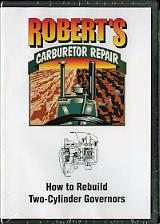
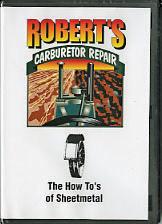

VTNG: New Generation Engine Restoration. Two disk set! Learn everything you need to know to confidently restore JD New Gen engines. Watch as Harvey Hamilton of Tired Iron Restoration guides you through a complete engine rebuild of a JD 3010 diesel. Filmed in HD, over 7 hours of content. Perfect visual companion to the technical manual. Includes engine diagnosis, inspection and repair of every component and step by step disassembly and reassembly. Advanced principles apply to other tractors including the 3020, 4010 and 4020. Follow behind the scenes to Barry’s Quality Machine to see the machining process and to Diesel Fuel Injection Service to see a pump calibrated. VTNG: U.S. Price $59.95 • Canada $65.95 • Foreign $70.00





DVDs - Green Magazine PO Box 95 • Bee, NE 68314-0095 402-643-6269 info@greenmagazine.com www.greenmagazine.com Nebraska residents add 5.5% sales tax Visa, Mastercard, Discover, and American Express accepted
GreenMagazine.com Check out
for books, museum links, advertising and more!
the website
Prices
shown ABOVE: U.S.
Foreign
Page 74 May 2024 • Green Magazine
for DVDs
$26.00 • Canada $32.00 •
$37.00
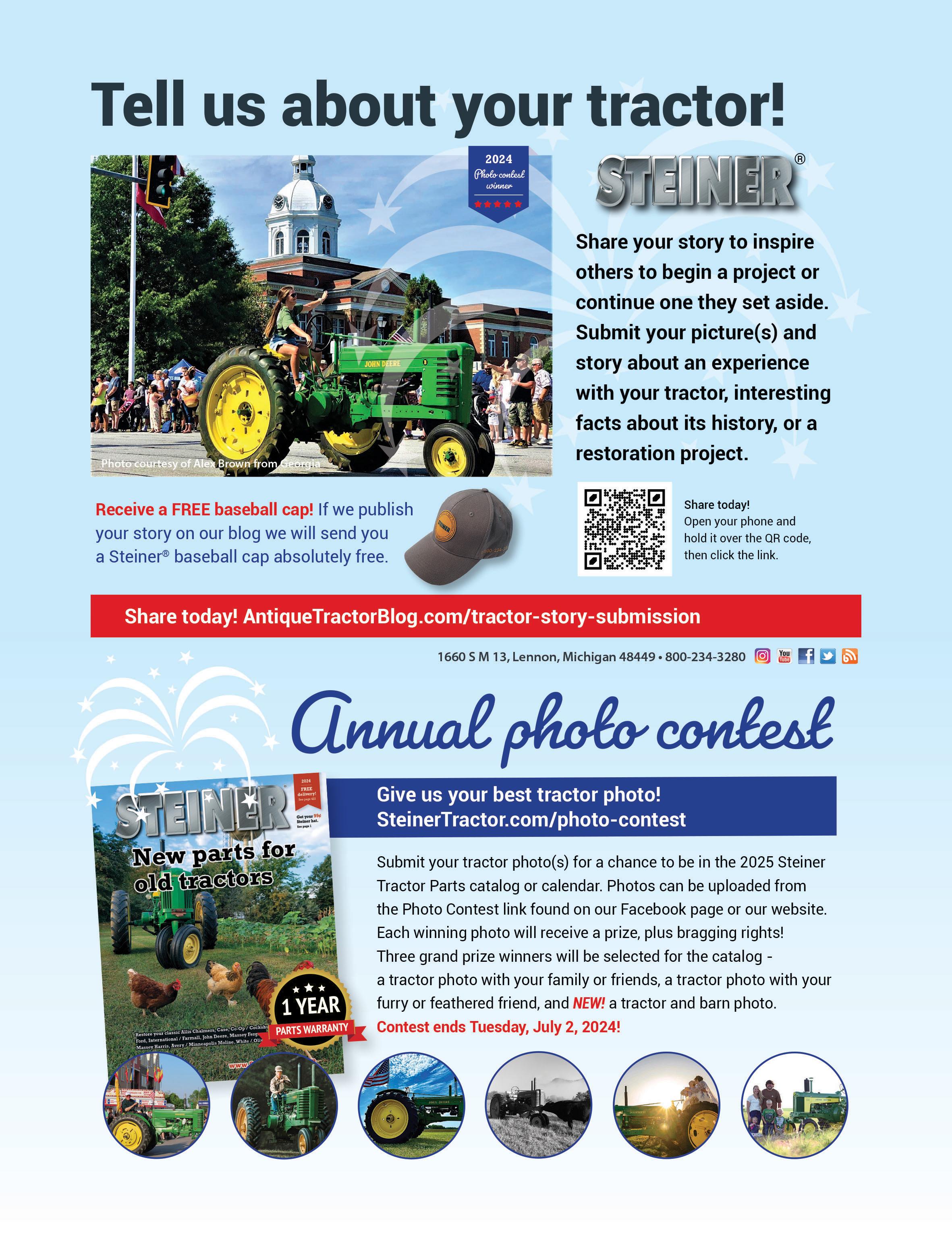
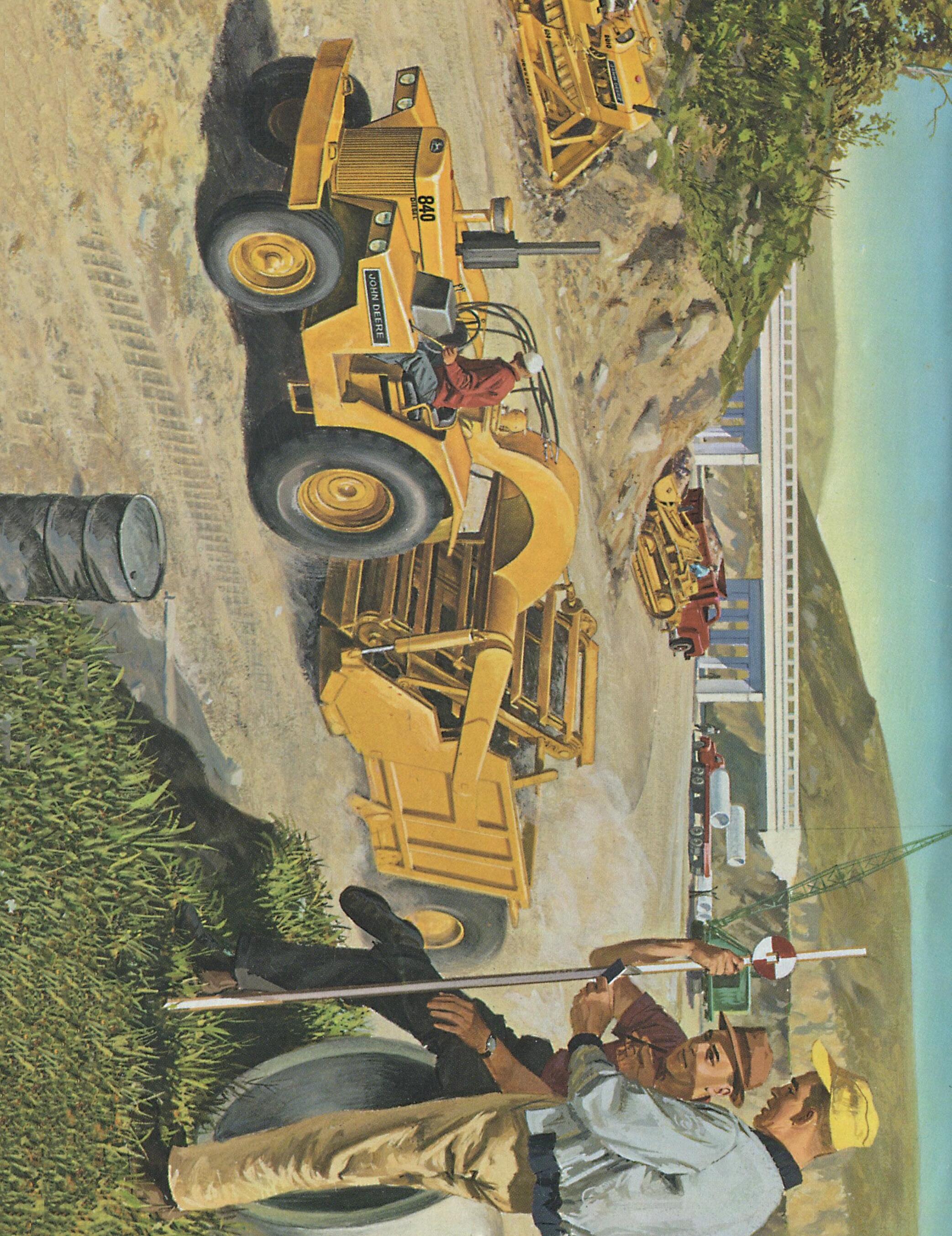
Life was nothing but sunshine and good times when you owned an 840, or so this illustration from a Deere ad would have you believe. If you look closely, you will see that the crawlers in the background are New Generation.

































 Kenny Read with his 100 year old tractor.
Kenny Read with his 100 year old tractor.













































 The front cover of one of our catalogs.
The front cover of one of our catalogs.































































































 Right: Edward Galenski, fourth generation farmer on Galenski Farm, helping to harvest sugar pumpkins.
Ben Kramer’s 1936 “B.”
Right: Edward Galenski, fourth generation farmer on Galenski Farm, helping to harvest sugar pumpkins.
Ben Kramer’s 1936 “B.”










 Photo 2
Photo 3
Photo 2
Photo 3





















 Photo 1 • Photo 2, below
Photo 3 • Photo 4, below
Photo 1 • Photo 2, below
Photo 3 • Photo 4, below



















































 Kyle loading the 620.
Kyle loading the 620.





























































































